See what's happening here at Neighborhood Pet Shoppe!

- Shop Promos

Now Hiring Groomers!
We’re looking for a full-time groomer to join our team.
Neighborhood Pet Shoppe
Helping pet owners like you take the best care of their furry, feathered, and scaly friends.

We’re So Much More Than Just a Pet Shoppe
People and their pets are at the heart of everything we do! With over two decades in the business and an expert team, there isn’t a pet problem that we can’t help you solve.
We carry a wide variety of pet supplies and stock only the top pet brands. The products we sell are more than just pet-friendly – they’ve been carefully hand-selected by our team to meet your pet’s needs and help them stay happy, healthy, and well.
Flea & Tick Season is Here. Are Your Pets Protected?
Ticks and fleas can cause all kinds of trouble for our furry friends. These parasites can lead to severe skin irritations and allergic reactions and transmit serious illnesses like Lyme disease, Rocky Mountain spotted fever, and even tapeworms.
Keep your pets safe and comfortable this summer with K9 Advantix topical repellent or Seresto anti-flea and tick collars. Visit us in-store today!
- Dog Supplies
- Cat Supplies
- Reptile Supplies
- Birds & Supplies
- Fish & Supplies
- Small Animals & Supplies
Treat Your Pets Like Family

Cat Adoption
It’s time to add to your family.
We partner with local rescues to find the perfect homes for our furry friends in need. Learn more about adoptable pets today!

Save Big on Top Brands!

inception | Buy 2, Get 1 FREE on Dog Cans
Buy 2, get 1 free on all formulas of inception dog cans. mix and match permitted..

inception | Buy 1, Get 1 FREE on Soft Moist Treats
Buy 1, get 1 free on all formulas of inception soft moist treats. mix and match permitted..

Zignature | Buy 1, Get 1 FREE on 4lb Bags of Select Cuts
Buy 1, get 1 free on 4lb bags of zignature select cuts for dogs. mix and match permitted., find your nearest neighborhood pet shoppe or safari pets.

- 805 Harkrider Street, Conway, AR, 72032
- (501) 450-6531
- 1540 E Race Ave, Searcy, AR 72143
- (501) 236-0057

Safari Pets | Cabot
- 808 W Main St, Cabot, AR 72023
- (501) 628-0067
Our Upcoming Events!

Hop into Easter Fun at Neighborhood Pet Shoppe!
- March 30, 11 am
What Our Customers Have To Say
Quick links.
- Safari Pets
- Fish Supplies
- Small Animal Supplies
- 805 Harkrider St, Conway, AR 72032
FREE u.s shipping over $250
- Our Mission
- Our Blankets
Your Cart is Empty
- $0.00 Subtotal
FREE U.S Shipping over $49 Taxes and shipping calculated at checkout
🔥 FREE Shipping 🔥
On all U.S. orders over $49 + Easy Returns & Exchanges
NEW ARRIVALS
- Animal Print
- Striped & Plaid
- Merino Wool
- SHOP BY FABRIC
- Cotton Blend
- Super Soft Microfiber
- SHOP BY SIZE
- 51 x 71 - Couch throw
- 55 x 71 - Couch throw
- 61 x 65 Heritage
- 60 x 79 - Twin Kids
- 60 x 80 - Twin
- 80 x 90 ➟ 95 Bed Blanket
- 91 x 108 Large Bed Blanket
BLANKET SPOTLIGHT

40 Incredible African Safari Animals with Photos and Tips from Locals
10 min read
Did you know: The animal kingdom in Africa is an amazing place. The continent houses over one million species, including some of the tallest (The girraffe) and heaviest land animals (the Elephant) on earth! There's no telling how many more undiscovered creatures exist untouched by civilization yet.

The Safari Animal bucket list you wont regret filling
If you believe safari animals should live free and wild in nature, you truly love nature, and experiencing its full beauty should not be left as a bucket list dream.]
Africa is home to many wild animals and bird species unique to the continent. Nature has provided the optimum habitat for Africa's wildlife by shaping the land into different biospheres and making them more conducive to the survival of certain animals.
There are swelteringly hot and humid valleys, green coastal areas, water scare plains, deserts, thorny bushland, tropical rain forests, cold and foggy highlands, lush green plains dotted with amazingly tall trees, and in between, there are crossover biospheres like the Pilanesberg National Park in South Africa.
Your ultimate African safari depends on you, and you can plan your dream safari around the African wildlife you'd like to experience in the wild.
Almost everything you've ever dreamt about, an African safari is possible. You can opt for a self-drive safari, rough it in "Out of Africa" style tents, or choose affordable luxury accommodation, including houseboats.
The list of wild animals and birds below is a tiny sample of what is to see, but it will help you create a clearer picture of your ultimate African safari.
There are over 1 100 mammal species and over 2 600 bird species. The list is compiled in no specific order as preferred animal sightings will differ among those who safari in Africa.

The Big Five and the Little Five complete a safari on their own.
Everyone should be familiar with africa's big five safari animals, and to make things a bit more interesting, we've added africa's little 5 , the namesake of the big 5, to spice things up a little..
Africa's top carnivore and known as the king of the beasts. Female lions do most hunting, and each Lion's pride will have one or two males for security and procreation. Lions typically hunt at dust and dawn when temperatures are more bearable.
#2 ANT LION
Ant lions whirl conical sand traps to catch ants and termites. Their predator-like behavior helps these lion-like larvae develop into a winged insect resembling a dragonfly.

Leopards are solitary cats and are primarily nocturnal hunters. They are very territorial and only get together to mate. The rest lie in tall trees for security and a vantage point to view the terrain around them. Leopards are also fond of mountainous regions, caves, and rocky outcrops.

#4 LEOPARD TORTOISE
The markings of the leopard tortoise shell resemble the spotted leopard pattern of these big cats.

#5 CAPE BUFFALO
The Cape buffalo is considered the most dangerous of the big five due to its unpredictable temper and enormous strength. A large herd of buffalo is a sight to behold. Buffalo is fearless and very protective. Interestingly, the herd only moves as fast as the slowest buffalo.

Image: Tim Tee
#6 BUFFALO WEAVER
A dark little bird with a bright red beak. They are poor at nest making and art, among other weaver species. These sloppy housekeepers congregate in flocks of up to 30 birds.

#7 ELEPHANT
A single elephant in the bush or a herd of elephants at a water hole remains an incredible sighting. These gentle giants are intelligent and express emotions much like humans do, making them truly majestic. Elephants move very quietly through the bush and communicate in low rumbling sounds.

Image: Joey-Makalintal-from-Pennsylvania, USA
#8 ELEPHANT SHREW

The black rhino is a highly endangered species due to poaching, while the white rhino is more common. To see a rhino in the wild, you will need time or will have to visit a rhino sanctuary with 24/7 active anti-poaching units.

Image: Len Worthington Trichogomphus-mongol 60 mm Rhinoceros Beetle male
#10 RHINO BEETLE
Unusual safari animals and birds of africa you must see in the wild., our safari continues with some of the more unusual safari animals you may encounter on your safari..

Photo - Yathin-S-Krishnappa
#1 Bat Eared Fox
The Bat-eared fox is f ound in the African savanna, the bat-eared fox uses its ears to thermoregulate, so overheating is hardly ever a problem.

Photo - David Brossard ground pangolin
#2 Pangolin
These scaly anteaters live in sub-Saharan Africa and are sadly the most trafficked safari animals globally because of mythical beliefs that the

Photo: Hans-Hillewaert shoe billed stork
#3 Shoebill Stork
The Shoebill stork is A large grey bird with an unusually large beak resembling the shape of a shoe. They have large eyes and can stand between 3 and 5 feet tall with a wingspan of 7 feet.

#4 Okapi Forest Giraffe
Known as the forest giraffe, Congolese giraffe, or Zebra Giraffe, is native to the northeast of the Democratic Republic of Congo. It looks like a zebra but is more closely related to a giraffe.

#5 The Greater Kudu
The Kudu is one of the larger antelope species found in the woodlands of eastern and southern Africa. Numbers are in decline due to deforestation.

Photo: a galago or bushbaby near the Kruger National park Ph - Wegmann
#7 African Civit
Similar to a raccoon and is nocturnal. It looks like a cat and is a carnivore but also feeds on toxic termites and millipedes.

Photo: Sarah H. Olson , Gerard Bounga, Alain Ondzie, Trent Bushmaker, Stephanie N. Seifert, Eeva Kuisma, Dylan W. Taylor, Vincent J. Munster, Chris Walzer, CC0, via Wikimedia Commons
#8 Hammer Headed Fruit Bat
Native to West and Central Africa, this bat is massive with a three-foot wingspan and feeds mainly on fruit.

Ltshears, CC BY-SA 3.0, via Wikimedia Commons
#9 Pygmy Hippopotamus:
These little hippos are nocturnal forest creatures of West Africa, and there are only about 3 000 that still exist in the wild.

#10 The Gerenuk
The Gerenuk is Known as the giraffe gazelle for its long thin neck and is found in the horn of Africa and drier parts of east Africa.
Safari Animals that influence human behavior, and you can find out why
Here are a few unique safari animals and birds that have influenced human societies across the globe.

Part of the cat family, the cheetah is the fastest land safari animal, capable of up to 120km/h in short 500-meter bursts. The cheetah accelerates from 0 to 100 km/h in 3 seconds but overheats relatively fast. They love sitting on anthills to watch for prey and predators alike. Lions avoid cheetah cubs because their coat markings resemble the dreaded and fearless badger. Superfast athletes are often associated with the cheetah.

Widespread over sub-Saharan Africa, these gentle giants feed off the succulent leaves of tall trees and spread their legs awkwardly when drinking water. The giraffe is considered a gracious and docile safari animal, yet they fight viciously with their long necks. What makes the giraffe so unique is the print of its hind, which in the wild are like human fingerprints. We have used Giraffe print to create unique garments in our fashion houses.

Found in many of Africa's rivers, dams, and lakeshores, these large animals mostly emerge from the water at night to graze. The hippo needs to surface to breathe, so they tend to avoid deep water. They are territorial and can be very aggressive. Hippos are responsible for the highest number of human attacks of all the safari animals. Oddly enough, the hippo is used in many ads with size and how wide hippos can open their mouth.

These are the black and white striped horses of the wild. Zebra graze on the top grass and leave the lower grass for other grass grazers. Their stripes fend off tsetse flies and mosquitoes and cause a visual illusion when running in a herd that confuses predators. The zebra pattern is used in fashion and is one of Thula Tula's safari animal print blanket print designs .

Meerkats are sociable safari animals who work together to burrow dens and protect each other from predators by posting sentries at lookout points. They live in communities of up to 50 and are part of the mongoose family. They are omnivores and feed on eggs, insects, and small reptiles. The Meercat also has excellent eyesight and can spot predators up to 300m away. Their sentry posting ability and taking care of your neighbor are part of military training.

#6 Honey Badger
These black and white creatures are relatively small with short legs but are the most ferocious safari animals in Africa. They have been known to attack buffalo, lions, and even humans when threatened. They feed on almost anything, but their favorite treat is honey. The badger is primarily nocturnal and somewhat difficult to spot on daytime game viewing safaris. Many companies use the badger as a company crest that signifies determination.

#7 Springboks
The springbok belongs to the antelope family and is known for agility and gracious pronk. They inhabit open plains, grasslands, and semi-desert regions. The South African national rugby team is the Springboks.

#8 Fish Eagle
There are seven species of Fish Eagle, and the African fish eagle is the national symbol of 4 African countries, Zambia, Zimbabwe, Namibia, and South Sudan. The most significant populations can be found in Eastern and Southern Africa. Fish eagles mate for life and sing with hippos, mainly in the late afternoon, which personified the sound of Africa

#9 Wildebeest
The great migration from the Serengeti in Tanzania to the Maasai Mara in Kenya and back again is an unbelievable spectacle that must be seen to be appreciated. Companies use this great migration to emphasize strength in numbers

#10 Nile Crocodile
One of Africa's deadliest predators, the Nile crocodile can grow up to 6 meters long and is responsible for about 200 human deaths annually. From the time of ancient Egypt, the Nile crocodile has been a part of human mythology, and today the crocodile is an example of stealth and cunning victories.
Many more wild safari animals have influenced us humans and our behavior. You will come back from a safari in Africa and recall how the animals you saw at close range in the wild impacted your existence.
Safari animals - animals to make your close encounter safari a once-in-a-lifetime experience., there are so many different safari animals and birds that you will encounter on your safari, but your sighting list will not be fully complete without close encounters with these creatures of wild africa:.

#1 Silver back Gorilla
Only a very few people get to see these majestic creatures on safari as their habitat has been constantly under threat for a long time. There are currently fewer than 1000 mountain gorillas left, and they all share the same small habitat on the borders of Rwanda, Uganda, and the Democratic Republic of Congo. Like humans, gorillas communicate with gestures and vocalizations, including barks, roars, and hoots. Their primary diet is leaves, but they also insects on occasion.

#2 Chimpanzee
Limited to Central, East, and West Africa. The best place to see chimpanzees is in selected national parks in Uganda and Tanzania due to their efficiently functional tourism industry. These primates are a treat to see in the wild and will leave you questioning humanity.

There are three species of hyena , spotted, striped, and brown hyena. The spotted hyena is the most common and can be seen across sub-Saharan Africa. The females are larger than the males, and contrary to public belief, hyenas hunt in packs for their food but will not let up on the opportunity to scavenge food from other predators. Hyenas are intelligent and adaptable, which has kept their numbers up. They will eat everything from a kill, including bones and skin. Their tackle is haunting and may give you restless nights while on safari.

The jackal is a distant relative of the wolf and is most active at dust and dawn. The Jackal can be spotted around waterholes looking for an opportunity to feed. Their evening call adds to the choir sounds of the African bush.

Photo: Charles James Sharp
#4 Sabel Antelope
Sable can grow to 140 cm, and their horns can grow to about 110 cm. They typically drop to their knees and use their horns to fight. This is like old-style fencing, nature's way. They inhabit parts of East Africa from Kenya right down to Southern Africa, including a separate species in Angola.

#4 African Wild Dog
Known as one of the most successful hunters on the plains of Africa. They are highly intelligent animals and coordinate their hunts to run down their prey for many miles. African Wild Dogs are also very sociable and have the most beautiful painted coats. They can be found in sub-Saharan Africa but are on the endangered species list.

#4 Lechwe Antelope
There are two species, the Kafue lechwe and the Black lechwe, and both are vulnerable due to poaching. Both species are only found in specific parts of Zambia. They thrive in swamplands and are good swimmers making them more agile in the water than other antelope.

Photo : Charles J. Sharp
#4 Roan Antelope
The Roan antelope is another rare and stunning gem of Africa. Roan Antelope are large in structure with a light brown coat and ringed horns. They are common in the Luangwa valley but rare elsewhere in Zambia.

#4 Black Panther
The Black Panther is very elusive and only found in the forests of Mount Kenya, situated in this east corner of Africa.

Sadly, Oryx are hunted for their meat, hides, and horns. The horns are used as charms, and back in medieval England, oryx horns were marketed as unicorn horns which are magnificent straight horns. They thrive well in desert regions and make for a picturesque sighting.
An interesting fact about herd antelope is that they have glands in their hooves that give off a scent that allows them to track the herd if they get separated.
We certainly hope this shortlist of some of Africa's wild animals inspires you to start planning for a safari that will undoubtedly move your soul and leave you with fond and lasting memories.
Also in Community Stories
The science behind sleeping on your stomach: is it really bad for you, how to fall asleep in 10 seconds: a step-by-step guide mastering the art of falling asleep quickly, unlocking the secrets to a restful night's sleep: how to stop tossing and turning at night.
- Skip to main content
- Skip to primary sidebar
- Skip to footer

African Safari Animals Ultimate Photography Guide: 33 Photos, Tips & Facts
Please note: This post contains affiliate links.

Looking to immerse your friends and family in the fascinating interactions you will witness while on safari? Use my African safari animals photography tips from six safaris in five countries to create captivating imagery . By understanding wildlife behaviors and experimenting, you’ll come away with touching photographs that tell the story of your amazing experiences.
Maneuvering along sandy, unpaved tracks, keep your eyes peeled and listen for warning calls. Your skin will tingle as you search for elusive African wildlife. Your astute and eagle-eyed guides will optimally position you for unforgettable experiences . Relish locating stealthy, well-camouflaged cheetahs skulking through the grass. And, marvel at elephant herds tossing mud on themselves at watering holes.
Embrace backlighting with African safari animals

Setting out early in the morning and late in the afternoon for safari coincides with wildlife’s most active times and soft golden light. While dust bombards your cameras and infiltrates every crevice in your open-air vehicle, it also leads to intoxicating sunsets . The light in Africa lends an ethereal quality to your photography.
PHOTOGRAPHY TIP : Embrace backlighting and shoot into the sun to capture rim light around African safari animals’ silhouettes. While I previously avoided this approach, it’s now led to some of my favorite images.
Shoot high speed continuous to capture action packed safari pictures
Whether you embark on safari in East Africa (Kenya,Tanzania, Rwanda ) or Southern Africa ( Botswana , South Africa, Zimbabwe), heart-stopping interactions await in these national parks.

Encountering Cindy, a female cheetah, devouring an impala as her cub diligently chased away brazen jackals made for a quintessential National Geographic scene . Sneaking up behind her, the bold risk takers would race forward to snatch the coveted delicacy. Outnumbering Cindy three to one, they strategically distracted her cub, which feverishly pursued them, banking around corners with incredible precision.

Resting after the chase, the inexperienced cub found itself in the path of wildebeests, a vulnerable position. Worried about a potential stampede, mum stopped savoring her hard-won kill and relocated next to the cub. This provided the perfect opportunity for the defiant interlopers to move in. Shortly after, eagles and vultures surrounded the kill from above. Once Cindy moved the cub out of harm’s way, they snuggled and groomed one another.
PHOTOGRAPHY TIPS : To make sure you don’t miss pivotal, frenzied moments, set your camera to high speed continuous.
Use a fast shutter speed to freeze the action.
To be prepared for a chase, shoot manual or aperture priority and expose for the scene in advance. Catching the action is key to transporting your viewers .
An odd number of subjects – one, three, or five adds more visual interest .
Seek out alternative perspectives for African safari animals pictures

After seeing a picture isolating an elephant trunk with falling water droplets framed by elephant toenails, I wondered aloud to my Zimbabwe tour leader, Lauren Bath , where I could photograph a similar scene. Grinning ear to ear, she excitedly whispered to me, “It’s one of the surprises I have in store for you!”
Although I’d seen this perspective from a few famous wildlife photographers, I never thought it accessible to anyone other than National Geographic.

Staying at Imvelo Safari’s Camelthorn Lodge in Hwange National Park provides private access to a unique vantage point. They’ve constructed an underground elephant hide from an old shipping container and camouflaged it beneath dead trees.
Attracted by the watering hole, massive bull elephants quench their thirst right in front of you! Imagine examining their toenails as the largest land mammals daintily cross their feet. Gleefully suctioning water, they cool themselves by flapping their enormous ears.
FUN AFRICAN SAFARI ANIMALS FACTS : Did you know elephants’ dexterous trunks have 40,000 muscles as compared to only 650 in the human body?

PHOTOGRAPHY TIPS : Shoot low speed continuous to capture them slurping water.
To vary your point of view, bring two camera set ups – a wide angle (16-35) + zoom (200-500) .
Get creative and shoot tight shots to capture the details – water droplets, the trunk finger, and elephant eyelashes.
Elephants’ textures are perfect for black and white treatment too.
Don’t be afraid to “ break the rules ” and isolate the aspects you find most compelling. Although I purposefully cut off the tusks and trunk, the image above still tells the story of the elephant drinking.
Since you typically spend a couple of hours stationary in the hide, it’s ideal for iPhone or GoPro time-lapse videos . Just don’t accidentally knock yours out of the hide like I did (oopsie).
Light and interactions enliven African safari photos

With only 7,500 cheetahs remaining in the wild , they are one of the rarest African safari animals.
Not only are their coats gorgeous, but they also allow them to easily camouflage and surprise potential prey. Imagine encountering a mum and 12 month-old cub lounging in soft, early morning light as the long grass whispers in the wind.

Keenly attuned to sounds around them, their ears twitch as they listen for animals in the vicinity. Between yawning and stretching, they chase one another through the grass. Leaping onto a tree provides an elevated vantage point for mum to scan the horizon, scouting their next meal. Whenever the cub moves out of her line of sight, she chirps, signaling it to return.

FUN AFRICAN ANIMALS FACTS: Did you know the dark teardrops under cheetahs’ eyes decrease glare like eye black used by football and baseball players? And, the white at the end of their tails helps cubs follow mum in tall grass.
PHOTOGRAPHY TIPS : Wait for the light to illuminate their eyes , facial markings, and whiskers . Doing this will separate them from the background.
Also, if your subject is sitting amongst grass, use manual focus to ensure crisp images. Otherwise, your sensor’s auto focus will be tricked by the blowing grass and constantly searching for its target.
Watch African wild dogs’ extraordinary teamwork
While watching predators stalk their prey is riveting, witnessing an actual kill can be heart wrenching. After receiving a call that wild dogs were in the area, our Botswana guide turned to us with a huge smile. Given that fewer than 7000 of this stunning species remain in Africa, guides are giddy to see them too.

Maneuvering at break-neck speed, he encouraged us to duck as he plowed through branches in pursuit. Shortly after arriving, the dogs repositioned into a fighter jet formation and began aggressively chasing a steenbok (small antelope).
Literally eating it alive as it ran, the poor steenbok was nothing but dust in fewer than two minutes. While evading these precision hunters is daunting for prey, the thrilling chase highlights the admirable teamwork these clever safari animals exhibit as they expertly conspire and flank their target as it races through the tall grass.
FUN AFRICAN ANIMALS FACTS : Alpha females lead these formidable packs. To learn more about them, check out Painted Dog Conservation .
PHOTOGRAPHY TIPS : Since their legs have exquisite patterns , make sure to photograph those details.
I also enjoyed making portraits of them when their huge ears pivoted forward to listen for prey.
I recently learned you can photograph wild dogs from a ground level perspective in Mana Pools, Zimbabwe. So, this location has now moved to the top of my bucket list!
Cherish sentient elephants

Elephants are incredibly tactile , constantly caressing and comforting one another with their trunks. Experienced and enormous matriarchs lead the herds. Aunties protect from behind, assisting the little ones if they stumble.
Upon detecting a threat, the herd forms a protective barricade around the calves. Flaring their ears, raising their trunks and bellowing signals a potential charge towards a predator. Matriarchs don’t tolerate vehicles getting too close to babies.

FUN AFRICAN ANIMALS FACTS : Did you know that baby elephants are small enough to fit beneath their mothers’ bellies until they are six months old? This provides protection from the sun and potential predators
PRO TIP : To learn more about their social structures and intelligence, read Love Life and Elephants , The Elephant Whisperer or its sequel, the Elephant in My Kitchen .
To see how two organizations nurse orphaned elephants back to health, visit Wild is Life in Harare, Zimbabwe, or Sheldrick Wildlife Trust in Nairobi, Kenya.
Read more about my touching experiences at Wild is Life. I cherished witnessing the love the handlers had for the elephants in their care.
A hippo out of water is a rare African safari moment

Did you know that hippos are considered one of Africa’s most dangerous animals ? 500 people die from hippos each year in Africa . Despite appearing slow and lumbering, they can be lightning quick, especially if protecting calves.
Since they spend most of the time wallowing and submerged in water to stay cool, they usually only emerge at dusk to forage. While in Bumi Hills, Zimbabwe, we were fortunate to witness one running back into the lake after munching on grass.
The setting sun reflecting on the water provided an idyllic backdrop.

PHOTOGRAPHY TIPS : To convey motion, photograph wildlife with one leg forward .
If a hippo is yawning or running, setting your camera to high speed continuous will provide a great series from which to choose.
Accentuate giraffe’s beauty against the clouds

Giraffes are most vulnerable when bending down for a drink. Therefore, they check their surroundings carefully before satiating their thirst.
PHOTOGRAPHY TIP : Use fluffy marshmallow cloud to accentuate their beauty, height and majestic necks.

FUN AFRICAN ANIMALS FACTS : Giraffes’ blue/purple tongues are due to high concentrations of melanin, which people believe protects them from getting sunburned.
Kudus’ elegant horns are a work of art

Watching light and shadows interplay on kudu horns is mesmerizing. Acutely aware of potential predators, their ears are sensitized to the slightest sounds.
PHOTOGRAPHY TIP : Since herds tend to turn their heads in a synchronized fashion, wait for them to pivot to capture the delicate pink inside their towering rabbit-like ears.

Pay respects to Cecil the Lion
Although I had never traveled to Hwange National Park in Zimbabwe and seen Cecil the Lion prior to him being heartlessly hunted, learning of his death impacted me greatly.
Hearing that this beloved, radio-collared lion was lured from the game reserve, shot with a bow and arrow by a trophy hunter US dentist in July 2015, and left to suffer overnight infuriated me. Having the opportunity to pay respect to him at his tree on the Elephant Express enroute to Hwange meant a lot.
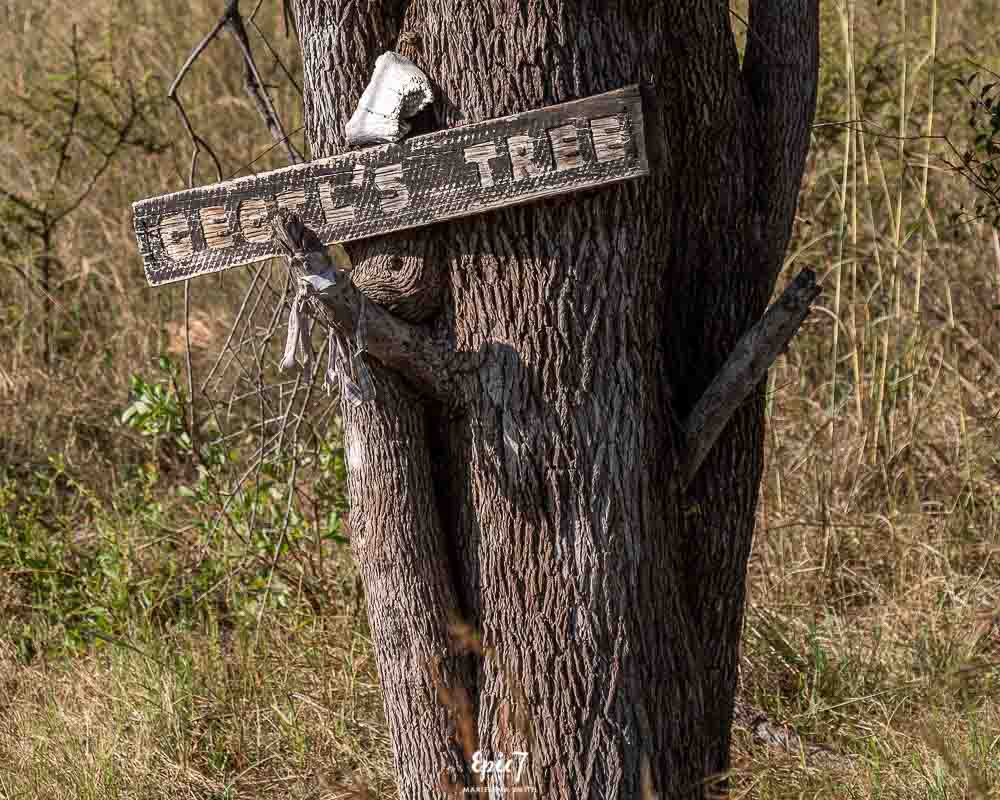
PRO TIP : To learn more about Cecil, read Lion Hearted: The Life and Death of Cecil & the Future of Africa’s Iconic Cats .

Since I’d never seen a radio-collared lion before, I found it fascinating and fortuitous that I encountered one on my second day in Hwange. Watching him and his brother lounging in the late afternoon light, startling a young elephant and then snuggling and yawning was the perfect way to end our first full Zimbabwe safari day. Appearing lethargic and well fed the next morning, we assumed they killed a young buffalo from the herd they’d been tailing the night before.
PHOTOGRAPHY TIP : Since lions yawn frequently, wait for them to yawn to photograph their impressive canines.
Leopards are one of the most elusive African safari animals

Spotting the shy and elusive leopard is a rare treat. While in the Okavango Delta in Botswana , one sashayed past our vehicle. She then leapt on to a dead tree to survey the landscape, providing the perfect angle for this photogenic beauty.

During a night drive in Zimbabwe, our guide spotted a leopard’s eyes as he panned across the horizon with his red spotlight. Elated at this coveted discovery , he hushed us. Having last seen one six months before, his excitement mirrored ours.
Despite watching it skulk through gulleys in pursuit of impala for 45 minutes, we didn’t see it make a kill, which secretly pleased me.
PHOTOGRAPHY TIP : Make sure to scan high tree branches as you are driving as leopards are often found lounging in them. If you are lucky, they might have a kill in the tree with them to protect it from other predators.
Admire lilac breasted rollers’ striking colors

Vibrant and iridescent colors make the lilac breasted roller one of the most popular safari birds in Africa. Constantly pruning their feathers and flitting from tree to tree can make them challenging to photograph.
PHOTOGRAPHY TIP : After you get your “safety shots” of it perched, crank up your shutter speed to 1/2500 and wait for it to fly. Although capturing them in flight is challenging, it’s a fun way to experiment. Shooting high speed continuous and AI Servo to track them maximizes the chances you might get a few shots in focus.
Beware of buffalos
We’ve had more than one guide indicate they find buffalos the most fearsome of the Big Five .
FUN AFRICAN ANIMALS FACTS : Did you know the Big Five classification originally denoted the most dangerous animals for hunters to pursue on foot ?

Stampeding buffalo are dangerous for young safari animals, proving fatal for cubs lurking in the grass. Therefore, female lions tend to steer clear of provoking them, especially if they don’t have others in the pride to help them with a kill. While buffalos often give no warning and just begin charging, snorting can indicate displeasure.
PHOTOGRAPHY TIP : Since buffalo have a symbiotic relationship with oxpeckers, wait for them to land on their horns to photograph them.
Seek out crocodile reflections

During the Great Migration from the Serengeti National Park in Tanzania to the Masai Mara National Reserve in Kenya, wildebeest and zebra must navigate across rivers, teeming with crocodiles. Witnessing crocodiles erupting from the water as the wildebeests hopscotch across tops many people’s bucket lists.
PHOTOGRAPHY TIPS: To add more visual interest, wait for them to run into the water or open their mouths.
If they are lounging next to calm water, seek out reflections.
Zebra stripes make for interesting abstract shots

Zebra’s striped patterns are as unique as a human fingerprint . Experts theorize their stripes also deter pesky biting flies, prevalent throughout the African savannah.
FUN AFRICAN ANIMALS FACTS : Did you know that their skin provides cooling benefits since the black and white stripes absorb and reflect light differently? And, a group of them is referred to as a dazzle.
PHOTOGRAPHY TIP : Experiment with converting your zebra images to black and white during post processing.
And, zoom in for some tight abstract shots to accentuate their stunning lines.
Hyena pups are endearing

While many safari goers are not huge fans of hyena adults, the pups are endearing. The strongest female in the group leads these matriarchal clans. Unlike the team-oriented wild dogs, the older hyenas are very possessive about kills, snarling and squealing to chase younger ones away until they have their fill.
PRO TIP : Check out Serengeti on Discovery for some great stories about a hyena clan.
Immerse in mountain gorillas’ human similarities

Observing one of the 1000 mountain gorillas remaining in Rwanda, Uganda and the Congo will remind you how much human DNA they share. Watching Silverbacks beating their chests to assert their dominance, babies cuddling with mums or rambunctious juveniles swinging amongst the branches will entrance you. While an hour will fly by, it will be one of the most memorable and heartwarming experiences of your life. Use my detailed guide to help you plan your Rwanda trip .
PHOTOGRAPHY TIP : Since it’s dark in the rainforest and no flash is allowed, make sure you bring a fast telephoto lens . I captured most of my images with a 70-200 2.8 Canon lens.
Epic 7 Travel is a for-profit blog. The post contains Affiliate links for which I receive a small commission at no additional cost to you. I only feature products that I own or would recommend regardless of an affiliate relationship. Read more in our Terms of Use . Thank you for your support of Epic 7 Travel!
Pin and read later

Marielena Smith
Marielena founded Epic 7 Travel to inspire you to Live the Unforgettable by sharing stories and photography from around the world. She aims to transport you to extraordinary places on, above and beneath all 7 continents and drive you to start your own adventures.
If you are looking for more inspiration to Live the Unforgettable , join the Epic 7 Travel Community
Reader Interactions
September 12, 2019 at 9:38 pm
Wonderful photos!! I had seen many of these on your Instagram feed and was already in love with all these majestic animals, but seeing them on my computer screen is even more impressive! Ooh and I could *feel* the warmth of the sun coming from behind your backlit elephant family! Africa would be amazing to see one day…
September 19, 2019 at 4:51 pm
That makes me so happy to hear, Deb. The backlight in Africa adds more drama to an already magical scene. I hope you make it there one day. Perhaps on one of my future tours 🙂
September 27, 2019 at 7:49 pm
Loved this blog post! The pictures and storytelling were perfect to share with my kids. They loved the stories and factoids you shared throughout the blog. Their favorite parts were the action-packed moments like the cheetah chase and the wild dogs! Reading this post was the next best thing to experiencing a safari firsthand. Thank you for sharing.
October 12, 2019 at 10:09 am
Kavita, I’m delighted that you and your kids enjoyed the facts and stories. I’ll definitely keep that in mind for future posts that the chase scenes resonate. Safari is a special and unforgettable experience – seeing the animals interact in their element is an incredible privilege. I’m happy I could transport you all!
November 22, 2020 at 12:43 am
Fabulous photographs – the African wild dogs remind me of hyena.
November 24, 2020 at 2:18 pm
Cherryl, Thank you so much for your kind words. I’m delighted that you enjoyed the photographs I captured in Africa. I absolutely agree that the African wild dogs coloring looks similar to hyenas. It’s such a privilege to see the wild dogs. To see them hunting is truly unforgettable. Their teamwork and efficiency is unparalleled. I hope you have a lovely holiday season.
Leave a Reply Cancel reply
Your email address will not be published. Required fields are marked *

Connect With Me
Press & Media
Join the Epic 7 Travel Community for exclusive trip planning inspiration, including my FREE Travel Essentials Checklist
By signing up, you are giving me your consent to email you occasional updates, images, and stories from Epic 7 Travel. View our Privacy Policy and Terms .

If you are looking for more inspiration to Live the Unforgettable, join the Epic 7 Travel Community
You have subscribed! Check your inbox to confirm your subscription.

Get Ready for Your Own Epic Adventure!
Access travel tips to make your next trip a success
Learn photography skills to document your adventure
Get inspired to plan the trip of a lifetime
Don't miss out!
You have successfully subscribed, content protected.
The content of this website cannot be copied!

African Animals – Incredible moments on Safari
Written By: The Planet D
Updated On: February 8, 2024
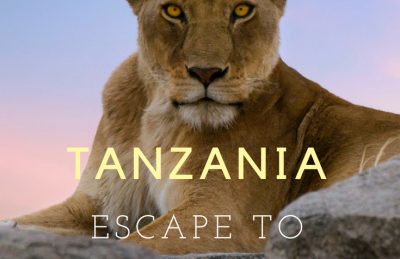
Going on a safari in Africa is one of the most thrilling adventures in the world. There is nothing more exciting than seeing African animals roaming free on the great plains. We have been on safari in South Africa, Kenya , Tanzania , Namibia, and Botswana. We are truly lucky people.
Table of Contents
African Safari Animals in Photos
Our first time in Africa was in 2008 when we cycled from Cairo to Cape Town. Our trip took us from the north through Sub-Saharan Africa all the way to the southern tip of the Cape of Good Hope in South Africa. We saw a lot of wildlife on that six-month trip alone and since then, we’ve gone back four times. These are our favorite moments of coming face-to-face with African animals.
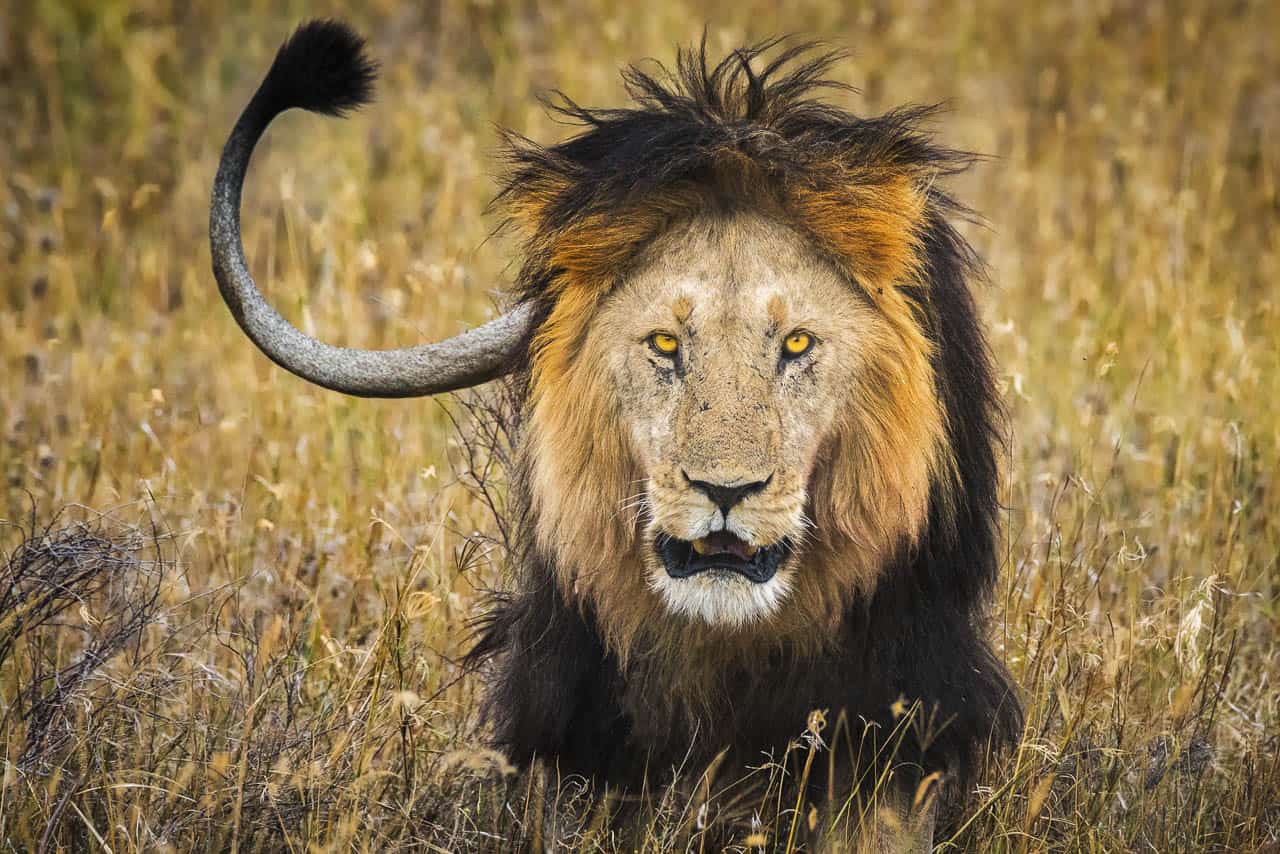
It wasn’t until going on at least three safaris that we actually saw a proper pride of lions. It was while touring Tanzania with Go Ahead Tours that we had our most outstanding lion encounters. One that sticks out is while on a game drive in the Serengeti.
Lion Chasing Lioness
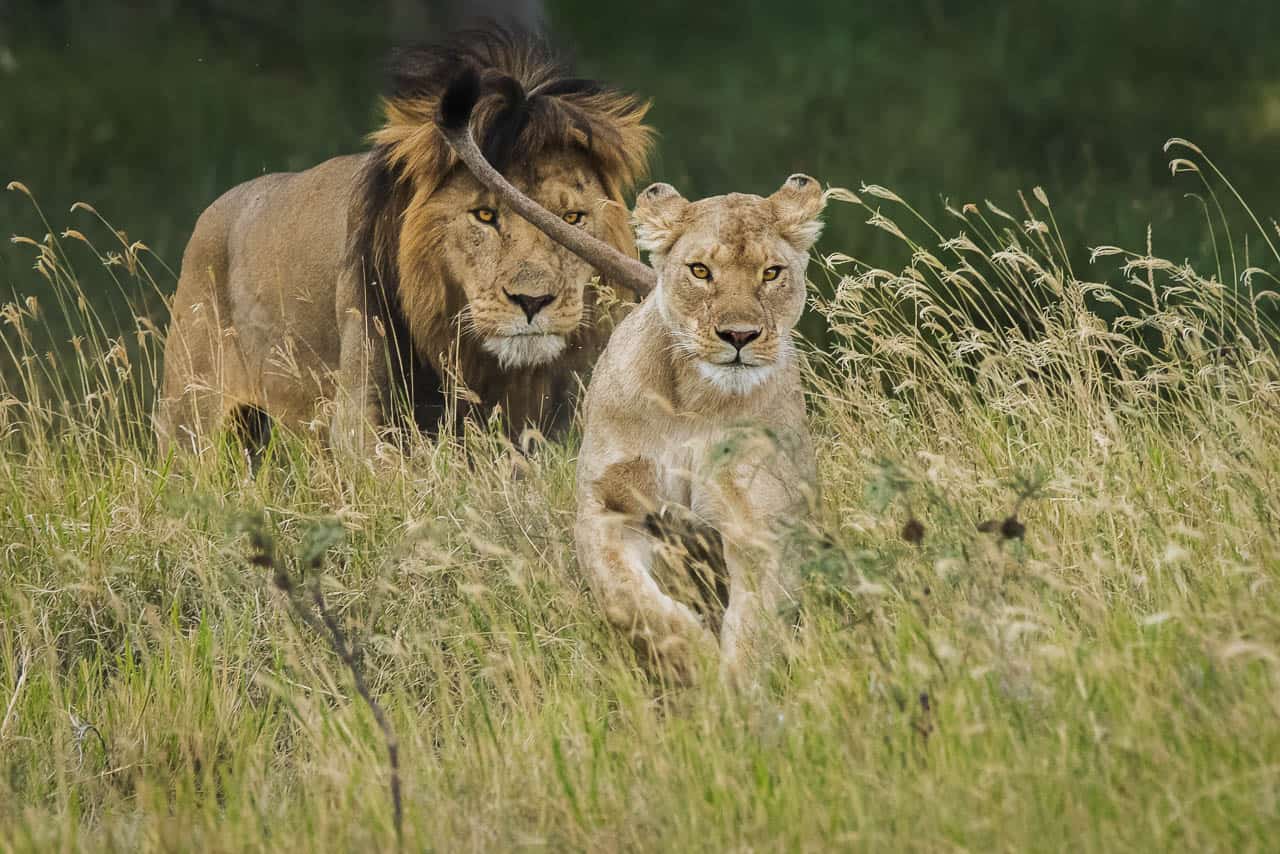
We watched three male lions try to court a female as a herd of elephants kept chasing them away. It was incredible to see how the lions kept watch on the elephants who drove them away whenever they came to close, yet never took their eyes off the female prize.
Lioness And Her Cubs
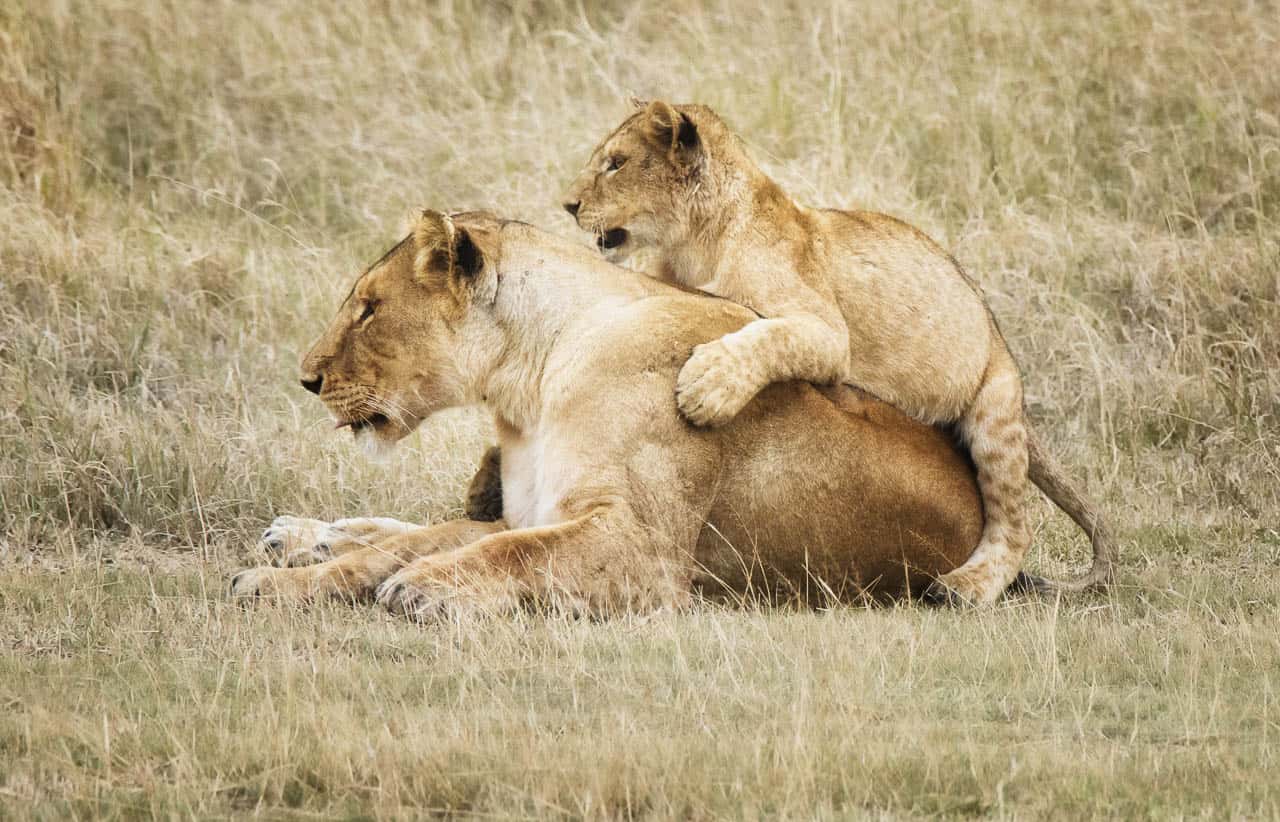
This memorable moment consisted of 13 cubs following one lone female lion. Our guide George told us that there were probably three other adult female lions lurking in the grass, but the cubs were following her – the Alpha. As they followed along, this little guy broke away from the pack charging at his mom. He brought her down, nipping at her throat and belly before climbing on her back to tell the rest of the cubs to come on down!
Watch our Wildlife on Safari in the Serengeti Video
Watch all the videos above and at about 1:50 into the video, you’ll see the lion cubs playing with mom.
You can see lions all over Africa: Some of the best places we spotted them were in the Serengeti in Tanzania, Kenya’s Masai Mara, a South African Game Reserve, and the Ngorongoro Crater in Tanzania. Lake Manyara is the place to see lions sleeping in trees. We also saw them in the Okavango Delta and Chobe National Park in Botswana.
Lion And Elephant Fighting For Space
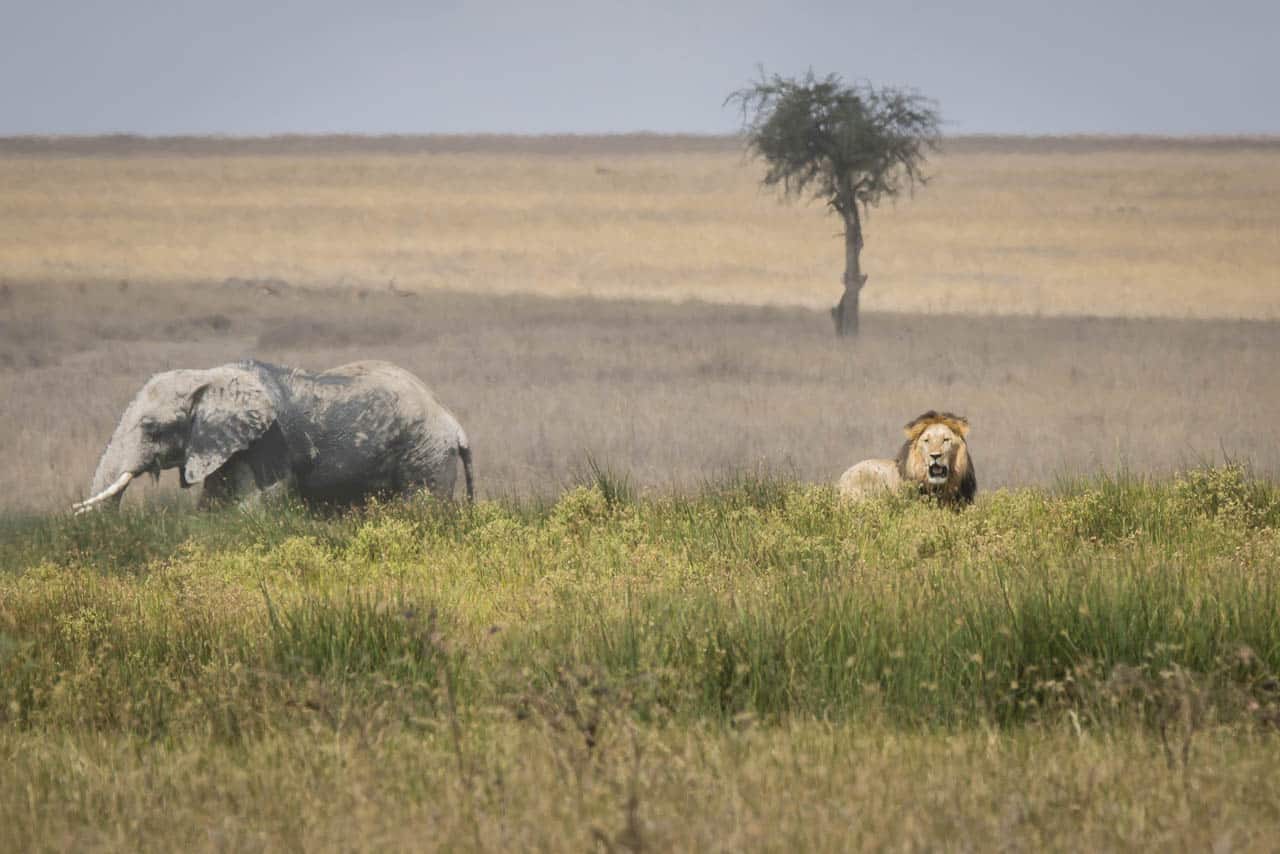
We all thought that lions are the kings of Africa, but if elephants are mad at you, you’re in trouble no matter who you are. T his lion and his brothers were way too close to a herd of elephants and their calves. The elephants were having no part of that and a group of big males split off to chase the lions away.
One of the best places to see elephants in Africa is in Amboseli National Park where there is a huge concentration of elephants. Plus, you get a great view of Mount Kilimanjaro. But we also saw elephants in all the usual places in Africa as well including the Serengeti, South Africa, Addo Elephant Nature Park in South Africa, plus Botswana, Malawi, and Zambia.
Leopard in Tree
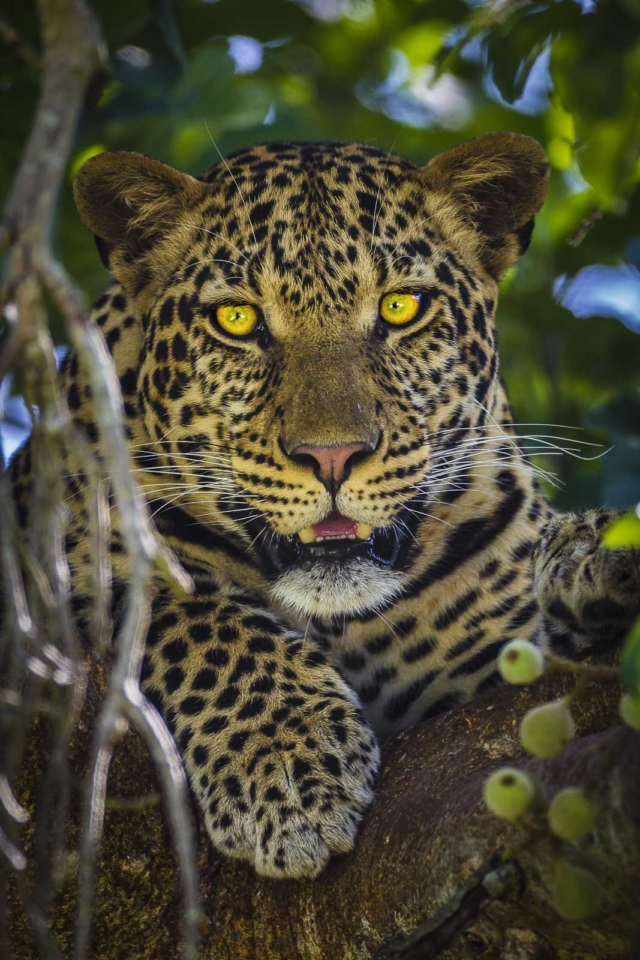
Leopards seem to be the most elusive animals in Africa. We had waited for days to find a leopard when on safari and we finally heard that one was sitting in a tree at the end of our trip to the Masai Mara in Kenya. We joined the line of safari trucks sitting around the tree to spy on her, but she never showed her face. It wasn’t until everyone left that we waited patiently by ourselves. Sure enough, when the commotion died down, she lifted her head from the branch and looked right at us. It was a breathtaking moment.
Leopard Jumping Into A Tree
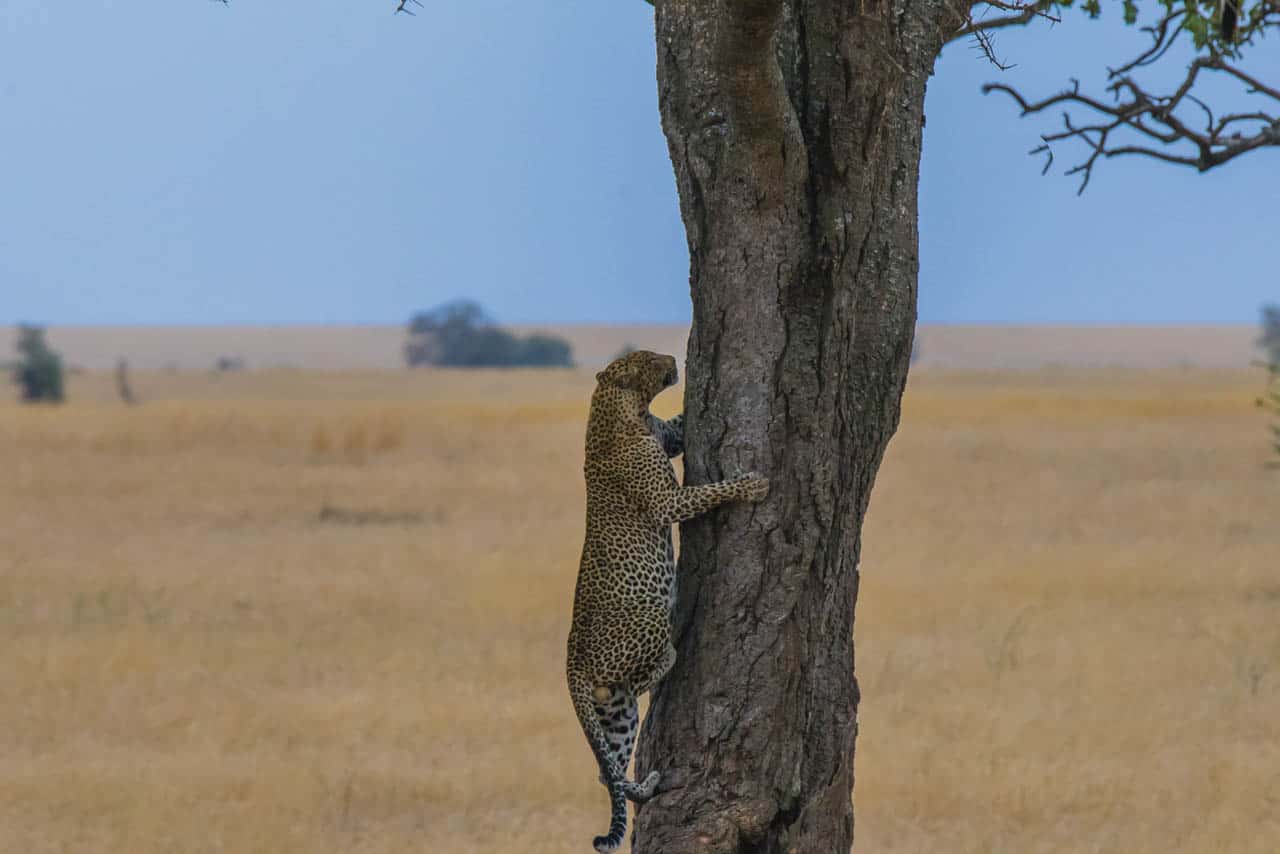
Seeing a leopard in Africa is a rare and beautiful thing. Seeing a leopard jump onto a tree and continue to climb it is nearly impossible! It was the end of a long day of our final day in the Serengeti in Tanzania and we knew a leopard had been hanging out in a tree for a couple of days. We never got a great view until driving back to the lodge near sunset. On our way back to the lodge, Dave asked our guide George if we could swing by the leopard tree to see if she had moved. Sure enough, we caught her walking from one tree to another and snapped this shot just as she leaped to her perch.
Three Rhinoceros – The Whole Family
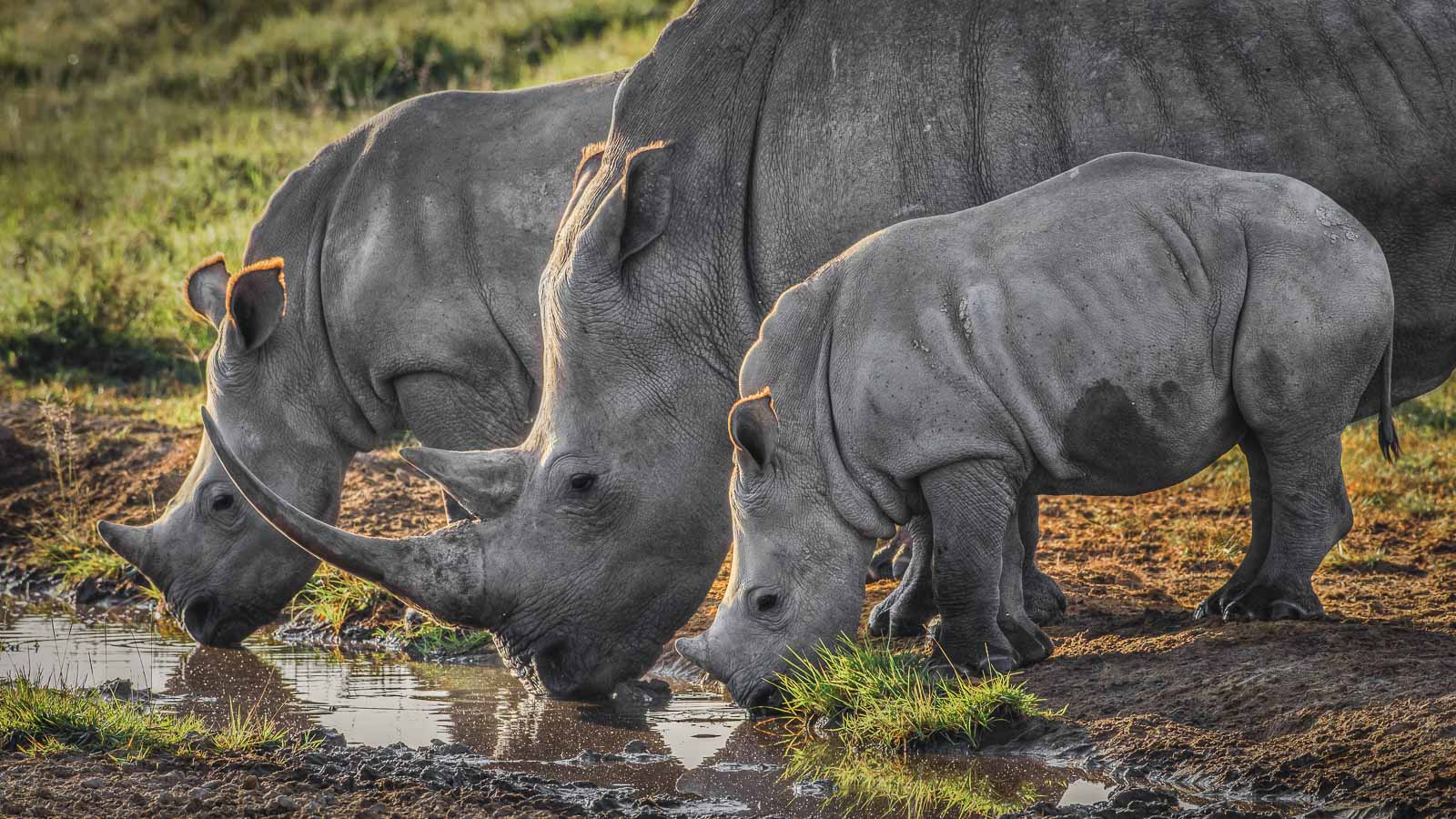
Getting to see a rhinoceros in Africa is rare indeed. They are the most critically endangered famous species of animal in Africa. Sadly, the Northern White Rhino went extinct in 2019 and the Western Black Rhino went extinct over a decade ago. Why do people think that the fibers from a rhino’s tusk are healing or an aphrodisiac? Leave them, alone people!
Cheetah And Her Cub
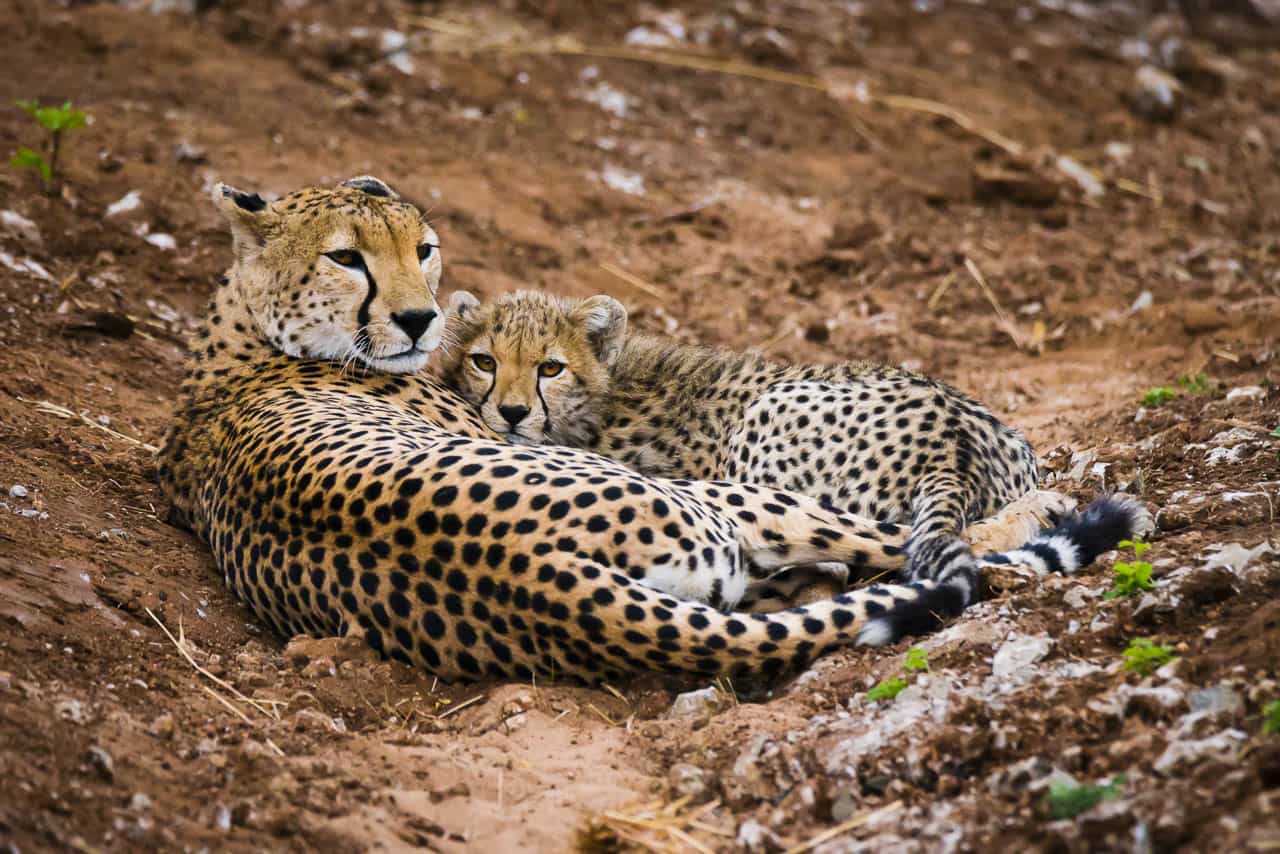
One of our favorite moments seeing African safari animals came while leaving Tarangire National Park in Tanzania. We were on our way to the next stop with our safari vehicle’s roofs and windows closed but our guides spotted this cheetah on the hunt with her cub. A herd of gazelles was grazing nearby and she was keeping an eye on them. At one point they made a move to chase one and it seemed like the perfect moment. But the baby jumped the gun bounding ahead giving the gazelle ample warning to getaway.
Keeping Watch Before The Next Hunt
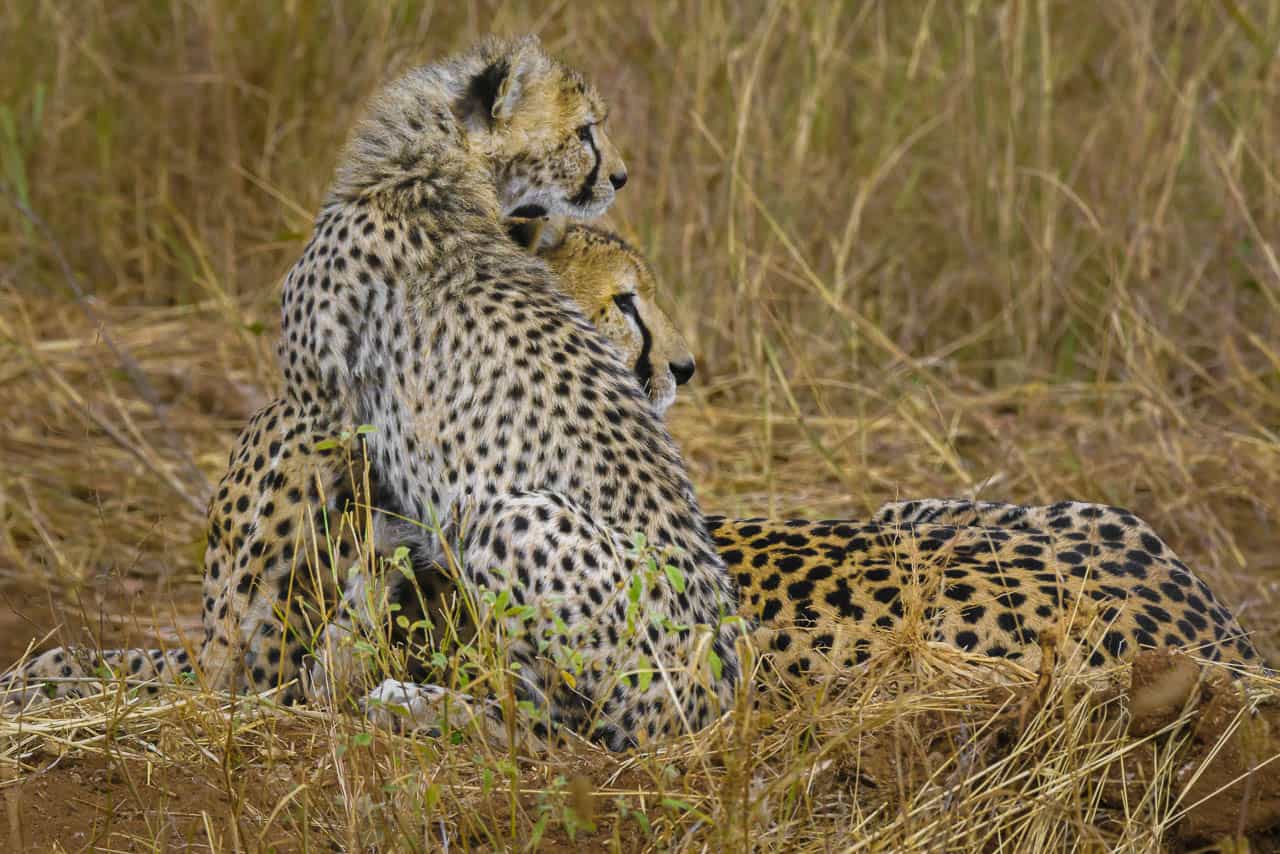
Not to worry though, the mother quickly forgave her child and they cuddled up waiting for the next set of prey to walk by. The cheetah and her cub eye a pack of gazelles. Will they get a kill on the second try? I sure hope so. Mom has a lot of patience, so I think she’ll teach this little fellow how to hunt in no time.
Cheetah In The Grass
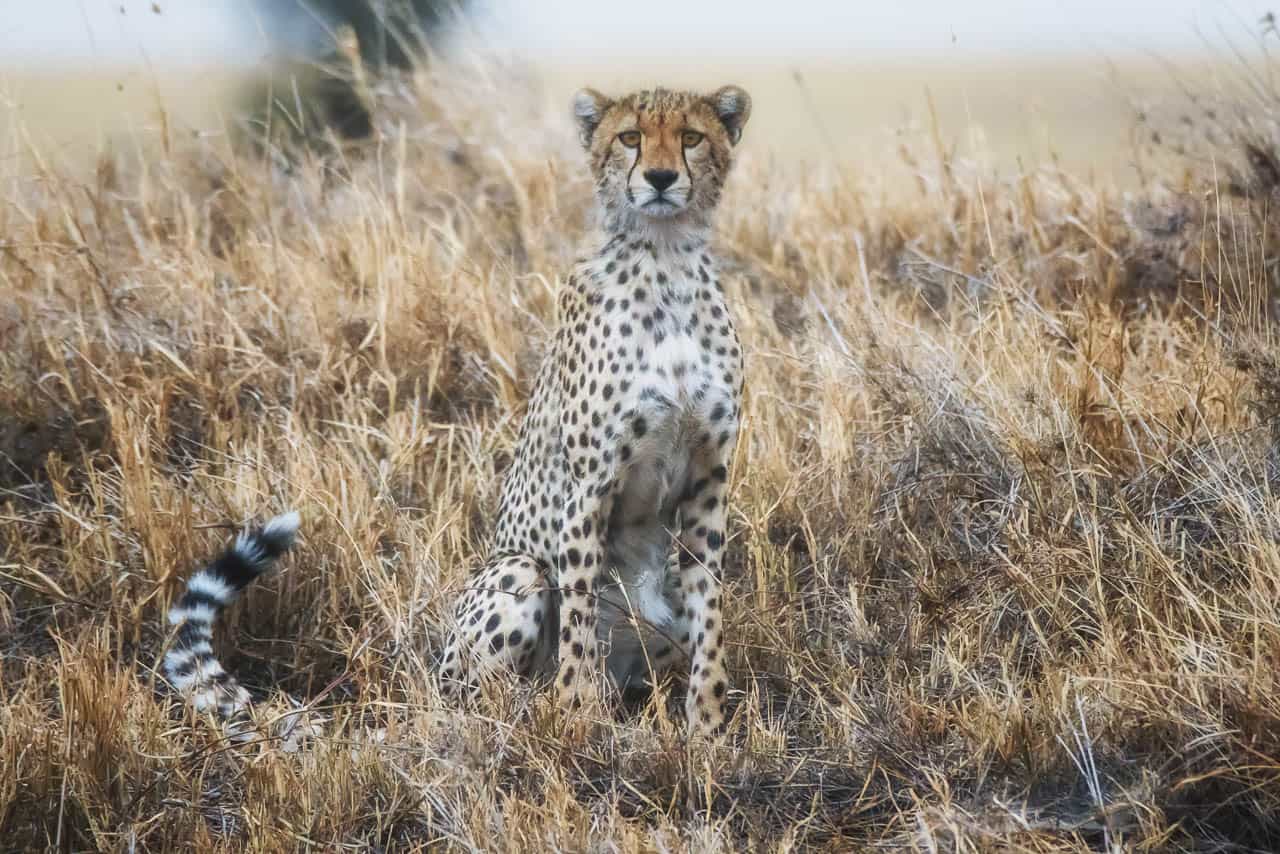
Spotting cheetahs on an African safari can be tricky business. Cheetahs are one of the more elusive African animals to see. Our first two safaris we never saw on Cheetah! It was when visiting the Masai Mara in Kenya that we encountered our first cheetah walking through the grass. We followed her for a while in awe. Cheetahs are difficult to spot because they hide well in the long grass, but this beauty was sitting poised and ready as we approached in our trucks.
Baby African Elephants Playing
Seeing baby elephants will melt your heart. When we happened upon a herd of elephants filled with frisky baby elephants, we had one of our most breathtaking Subsaharan animal encounters. Watching the family unite work together and protect their young filled me with joy. Seeing the baby elephants play and show off made me giggle. They are the most adorable creatures and I cannot believe that people have hunted them to the point of being critically endangered.
African Elephant On The Way To The Watering Hole
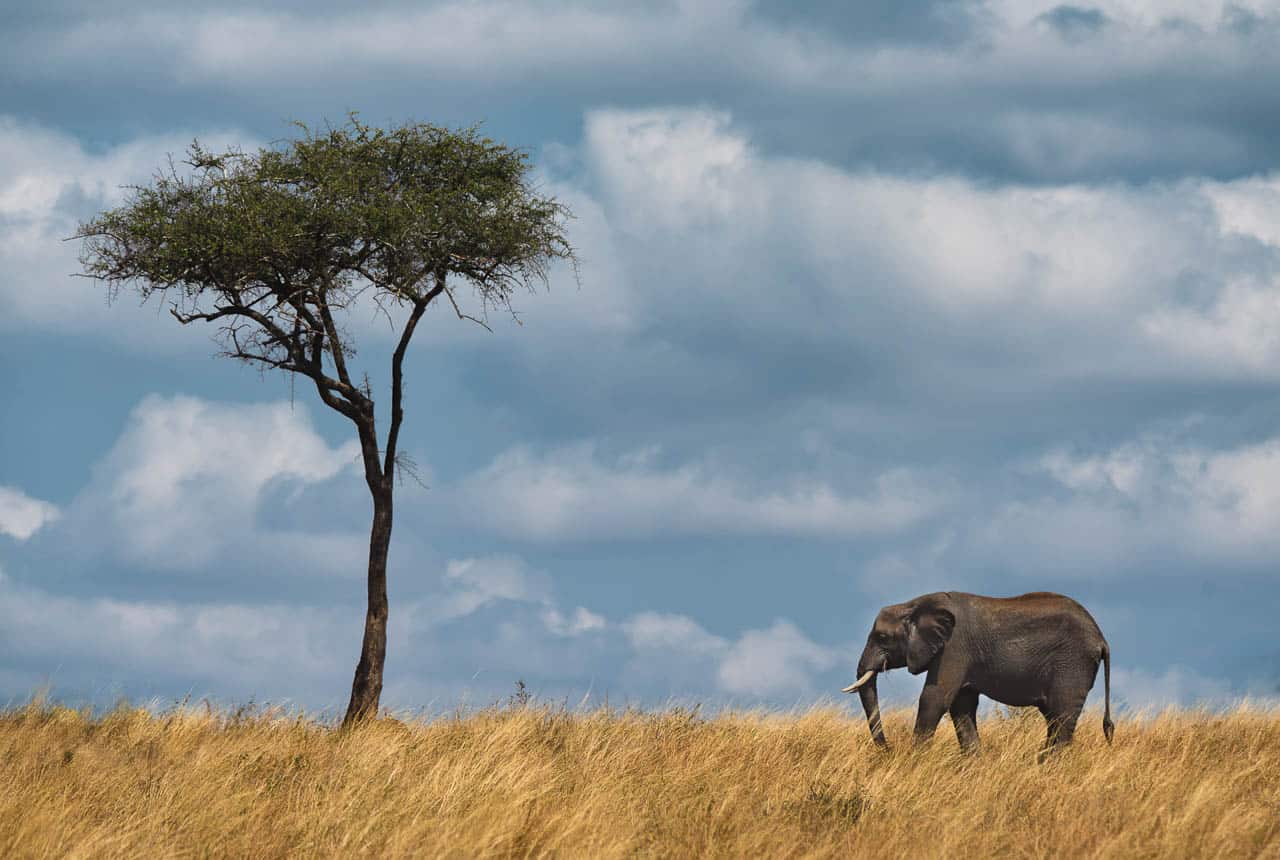
I cannot get over how quickly elephants cover vast amounts of land. They seem like they are moving in slow motion, but as you sit and watch them approach from the far distance, they are near you within minutes. We watched a herd of elephants walking to a watering hole while on safari in Tarangire National Park in Tanzania, all the wildlife seemed to be walking to one place. Processions of elephants, zebras, and impalas were all walking in long lines towards the watering hole. This was the perfect African safari scene and what I think of when I dream of Africa.
The Lone Bull Elephant
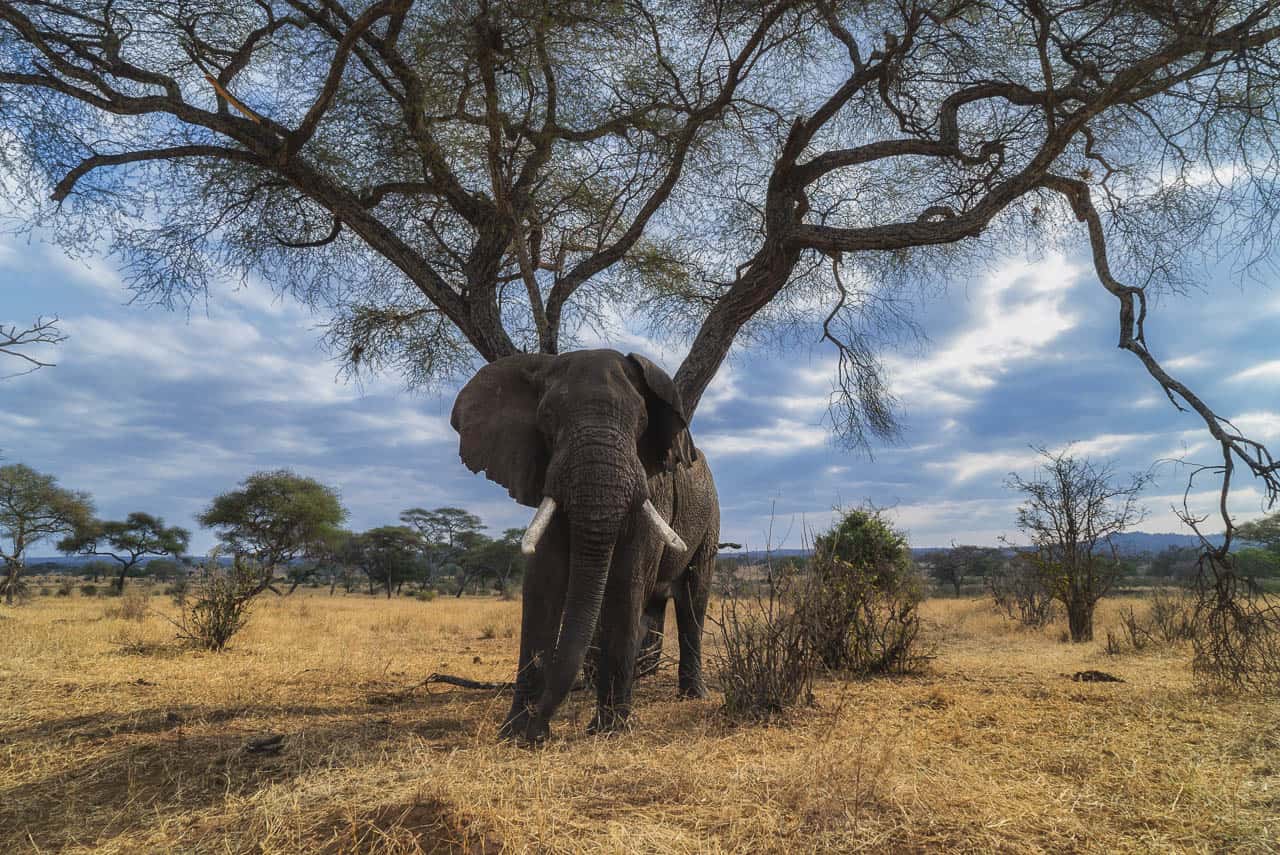
When male elephants are too old to be a part of the herd (or when male elephants grow out of their adolescence) they are sent off on their own to either find another herd or spend the rest of their days in solitude. This giant elephant was definitely an old man and he took notice when our safari jeep came near.
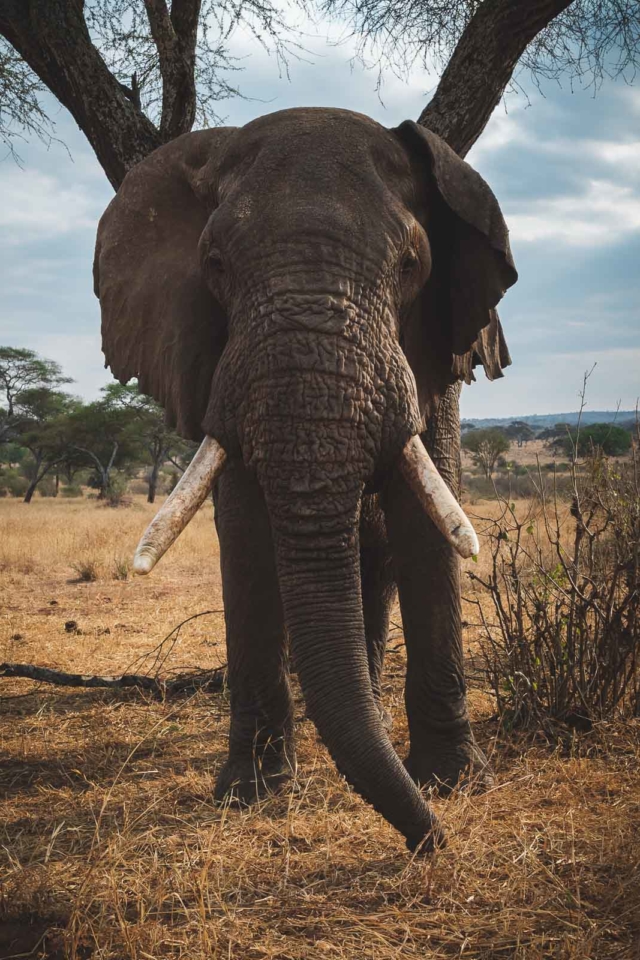
While watching this bull elephant from the safety of our truck, he suddenly charged. Elephants are the most unpredictable animals when on safari (in our opinion). They look so relaxed one minute, but they can quickly turn the next. We were enjoying a quiet moment, but the truck next to us suddenly laughed loudly. This guy didn’t like that at all and charged at our truck. Luckily it was just a warning.
Giraffes On Lake Manyara
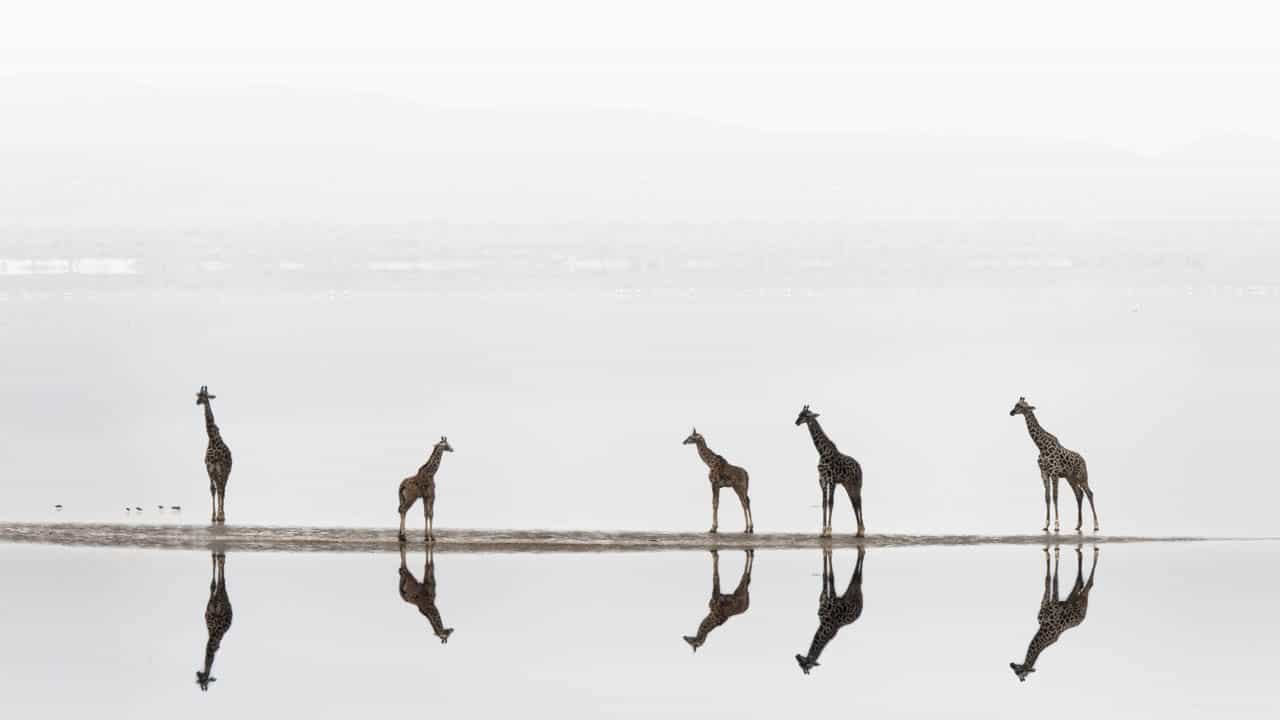
Lake Manyara is one of the most interesting places to see African safari animals. It’s one thing to see giraffes on the Serengeti, but to see them standing on the beach with water reflecting their long necks is mesmerizing. We counted 18 giraffes standing like statues on the shores of Lake Manyara; an alkaline lake known for its flamingoes and baboon population. It’s not an easy life for the “Ladies of the Serengeti.”
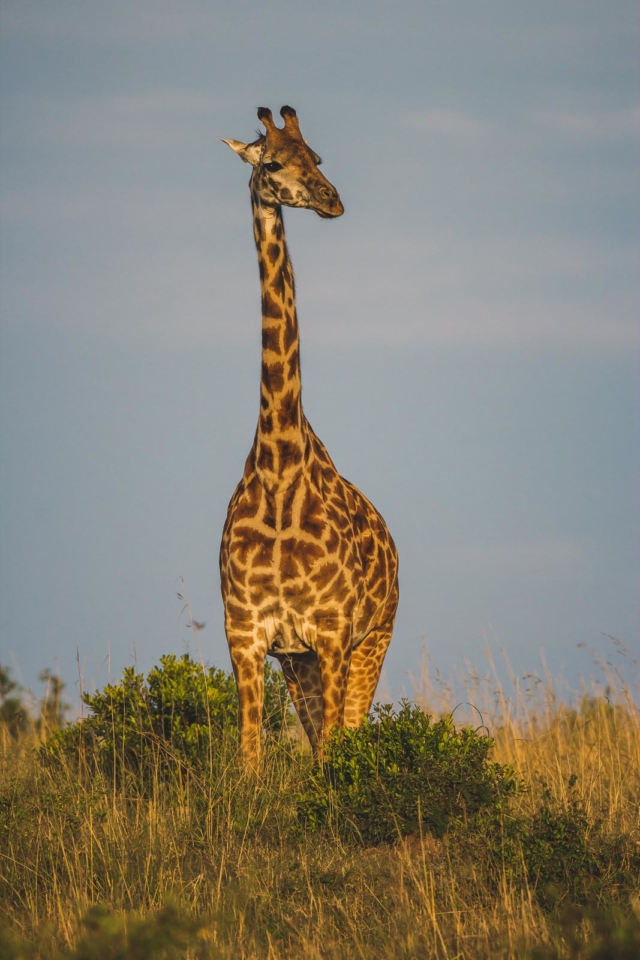
Sadly, we have heard that giraffes are quickly becoming critically endangered in silence. We can believe it, we have always had a difficult time seeing giraffes on an African safari. Other than at Lake Manyara, we have only seen the odd one or pair on our outings.
Necking Giraffes
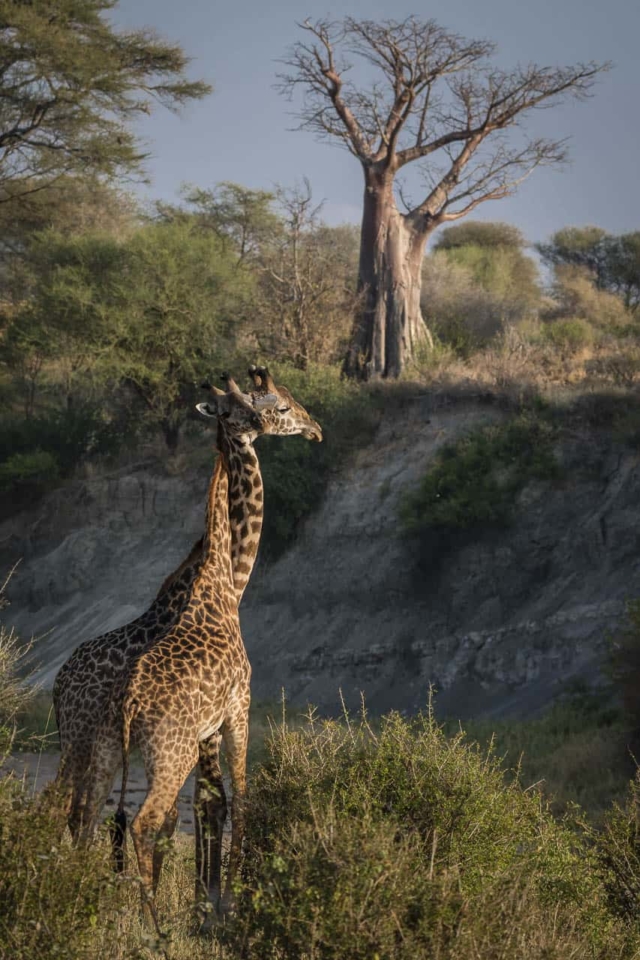
When you are lucky enough to spot giraffes in Africa, make sure to stop to watch them. They are the most elegant of creatures. Watching giraffes intertwine their long necks while swaying back and forth is like watching a ballet. They swing from side to side in perfect unison coming together for a few moments before beginning the dance again. The movements mesmerize you into a trance as you watch the moment unfold.
You can watch it in our video: The Best Things to do in Tanzania
If you love African animals you will love visiting Tanzania. There are so many animal encounters to be had here. Our video above also highlights all of the other things you can do in Tanzania.
Black Rhino
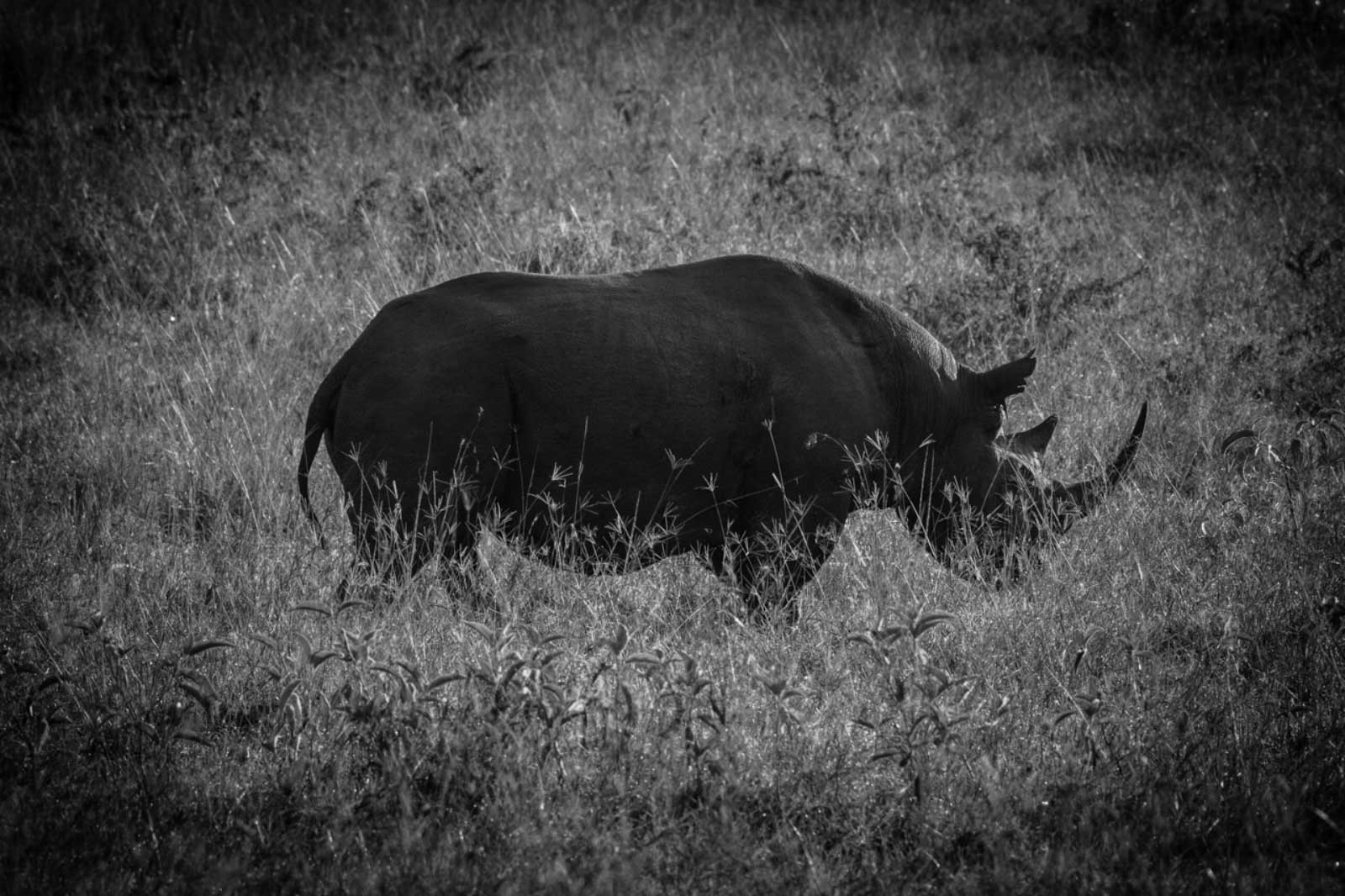
Lake Nakuru is home to one of the largest number of black rhinos in Africa. This sanctuary is under strict guard keeping an eye for poachers and is one of the best places in Africa to see rhinos. More than 100 rhinos inhabit Lake Nakuru National Park in Kenya with several different species of rhino living under protection. You’ll find black rhinos and white rhinos in Lake Nakuru.
Yawning Hippos
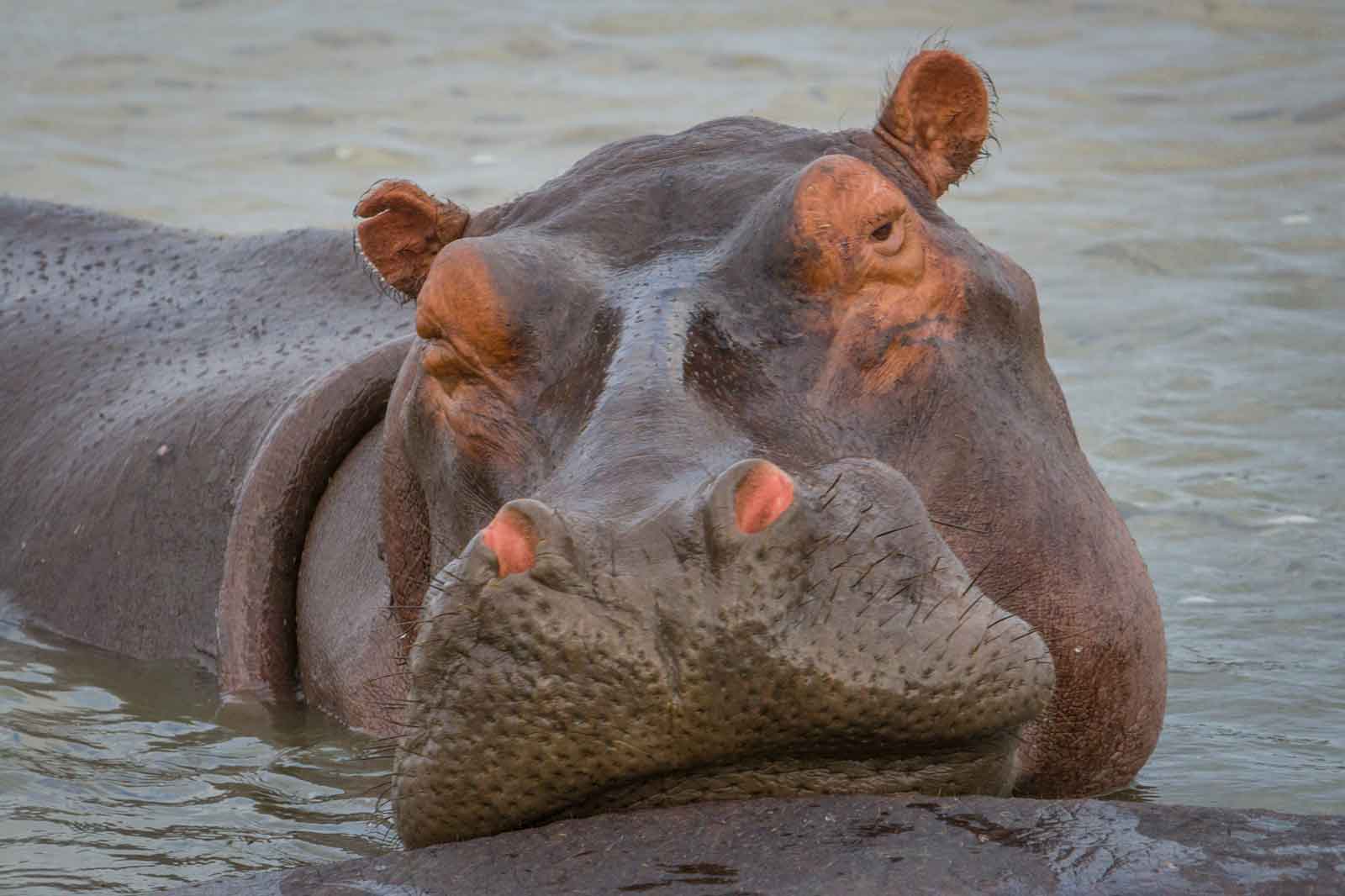
Hippos are pretty boring to watch. Most of the time they lay in pools of water with only their nostrils and ears sticking out. However, don’t take that mellow feeling for granted, the hippopotamus is one of the most dangerous animals in Africa.
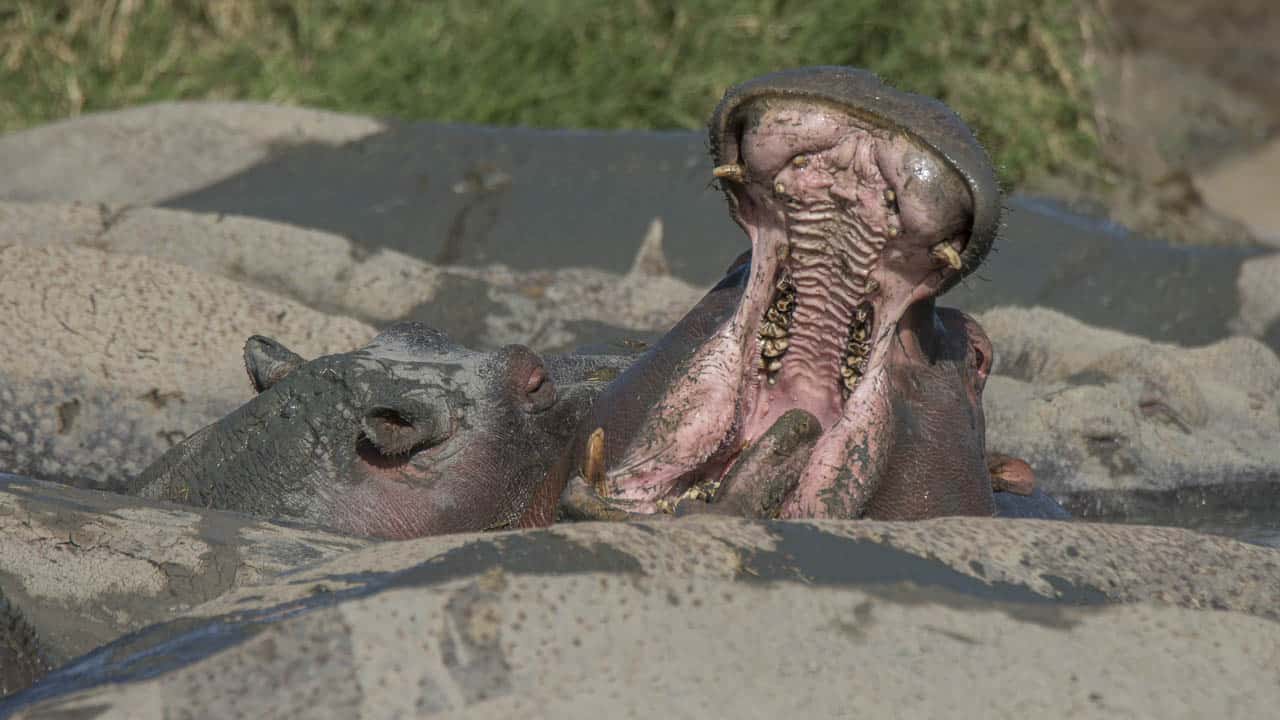
They kill more people than lions or elephants. They may be herbivores but just look at those giant mouths. They are very territorial and fiercely defend their area. Hippos all pack together protecting one another from the sun as they stay covered in mud. But every once in a while a hippo yawns and it’s the most exciting moment of the day!
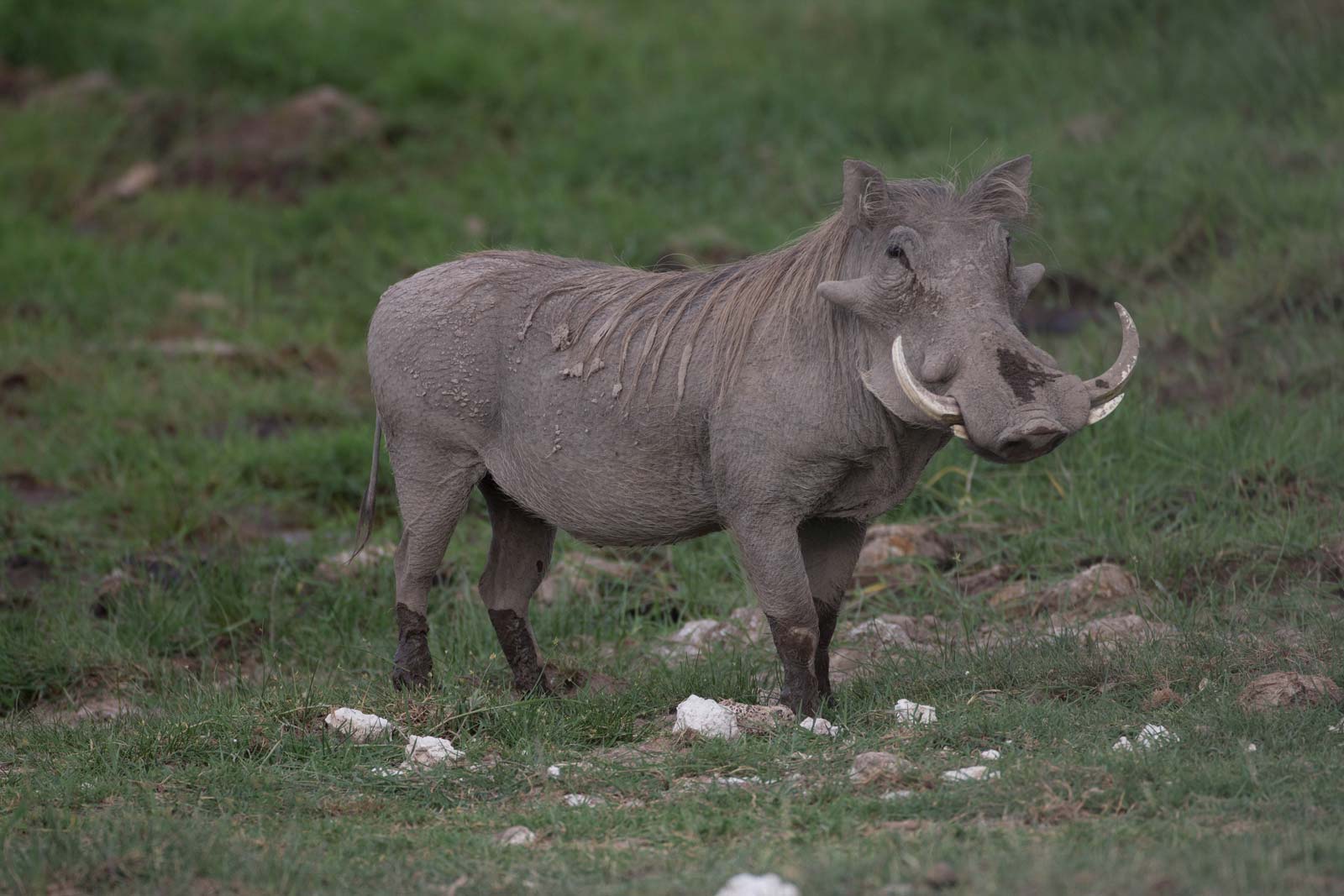
I must admit, the warthog is my favorite African animal. Honestly! they are so odd-looking they’re cute! They also never stop. It’s very difficult to get a photo of a warthog because they never stop moving. They are always scurrying about looking terrified that they are going to be eaten any second. I am always rooting for the warthog to survive. There are two species of warthogs found in Africa and they are related to the pig family. I can see the resemblance, they definitely look like a wild boar.
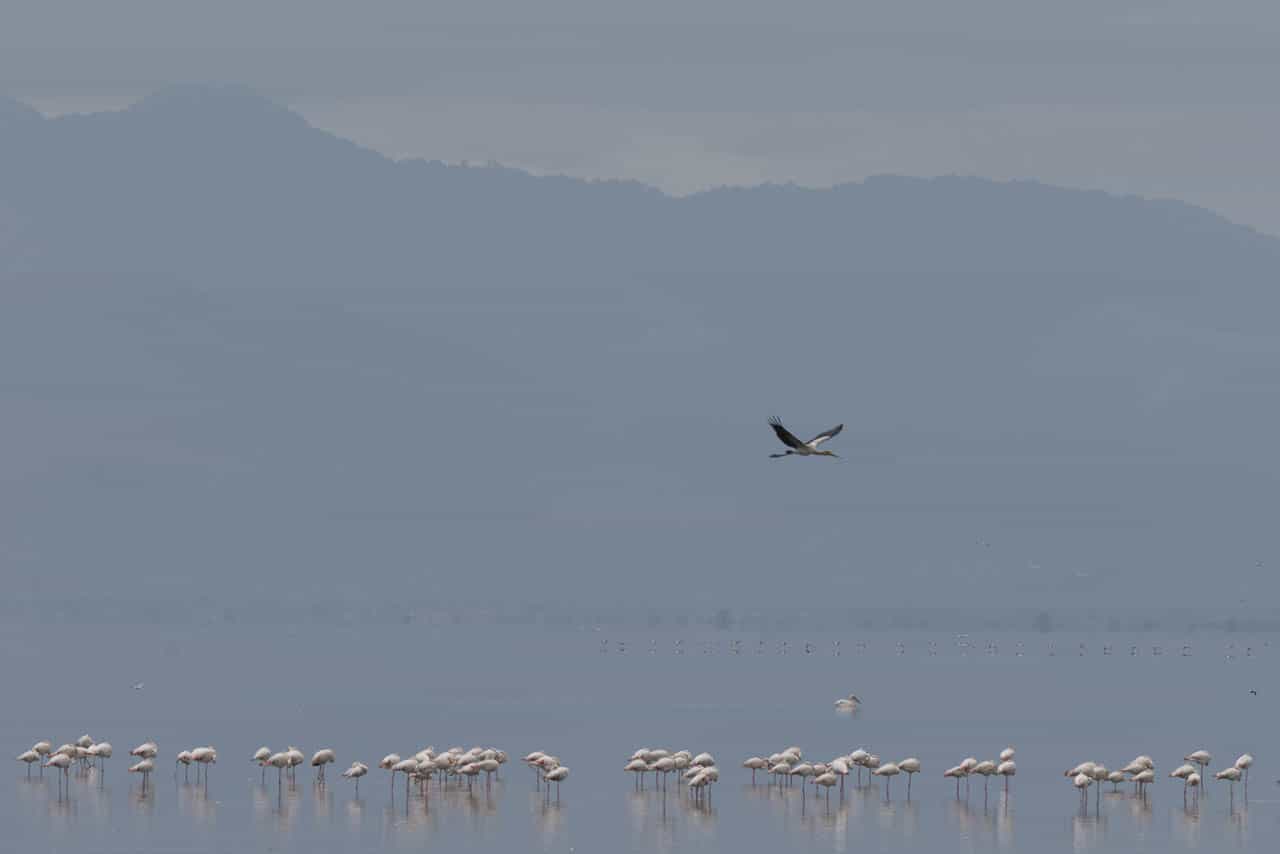
Flamingoes are found on the salt lakes of African nations. One of the best places to see them is Lake Manyara in Tanzania. We also had an incredible view of flamingoes in Lake Nakuru in Kenya. You will not only see flamingoes at these lakes, but also storks, cranes, pelicans, and eagles all flying and floating on an incredible lake surrounded by rolling hills.
Flamingo Reflections
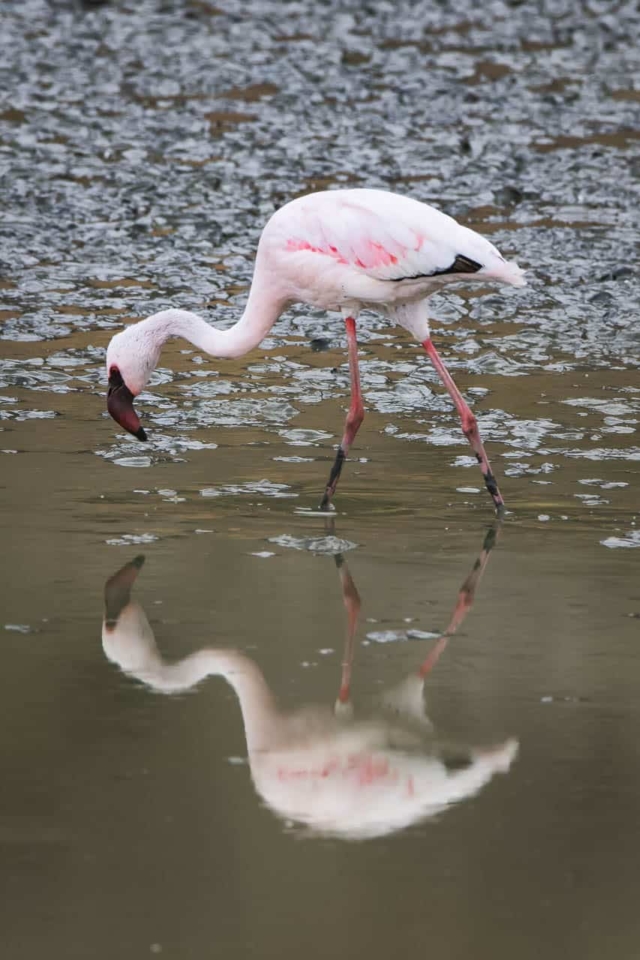
Did we tell you we were excited about the flamingoes? We love this reflection. It literally looks like the flamingo is checking out its reflection. Lake Manyara that we finally saw the thousands of different species of birds and flamingoes gracing its coast.
Flamingos Flying
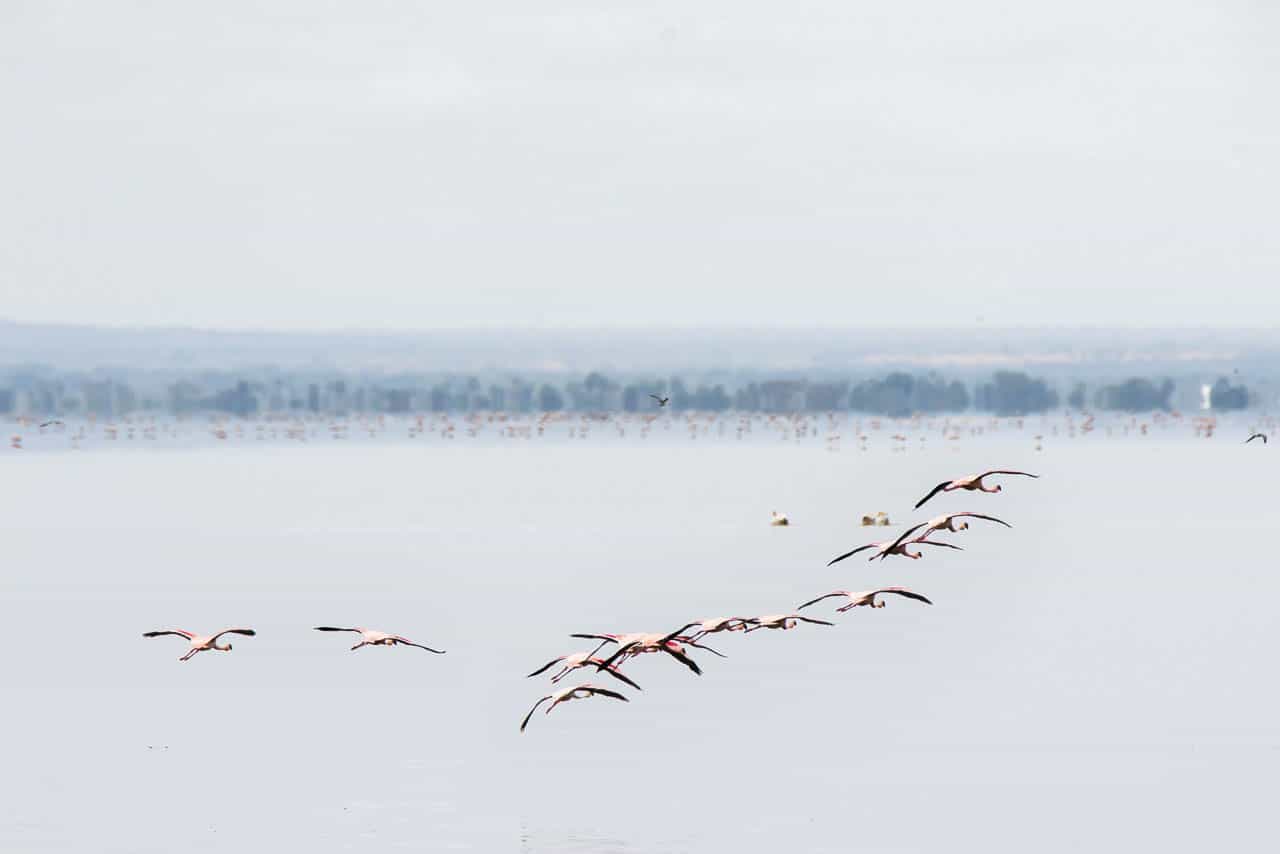
Okay, one more flamingo photo before we move on. It was spectacular to see flamingoes take flight. Did we mention we were really excited about the flamingos of Lake Manyara and Lake Nakuru?
Morning Light On A Hyena
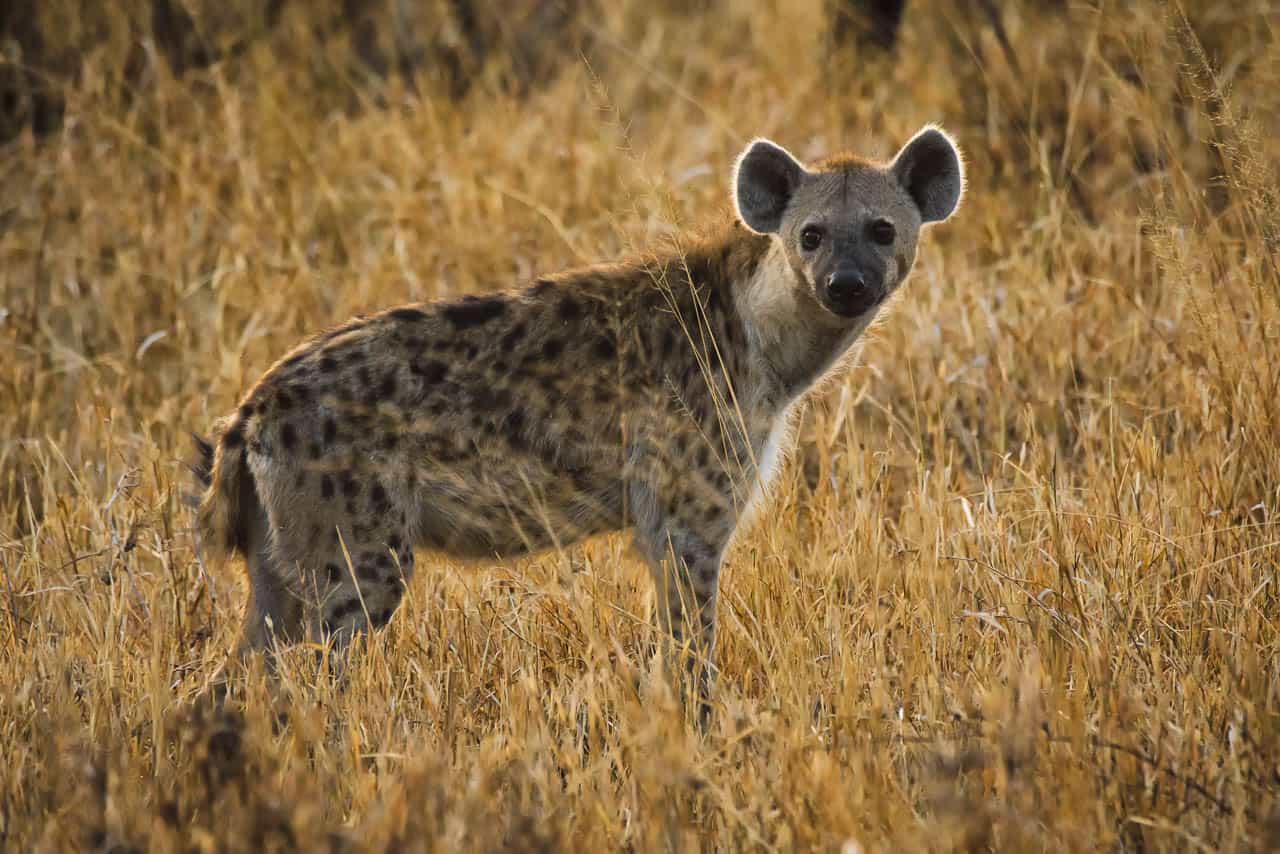
The poor hyena isn’t the most famous of African safari animals, but seeing one is pretty rare. I think they are cute. Just because they are scavengers doesn’t mean they aren’t fierce. When cycling Africa we often had hyenas circling our camp. We didn’t stray too far from our circle at night with these guys hanging around.
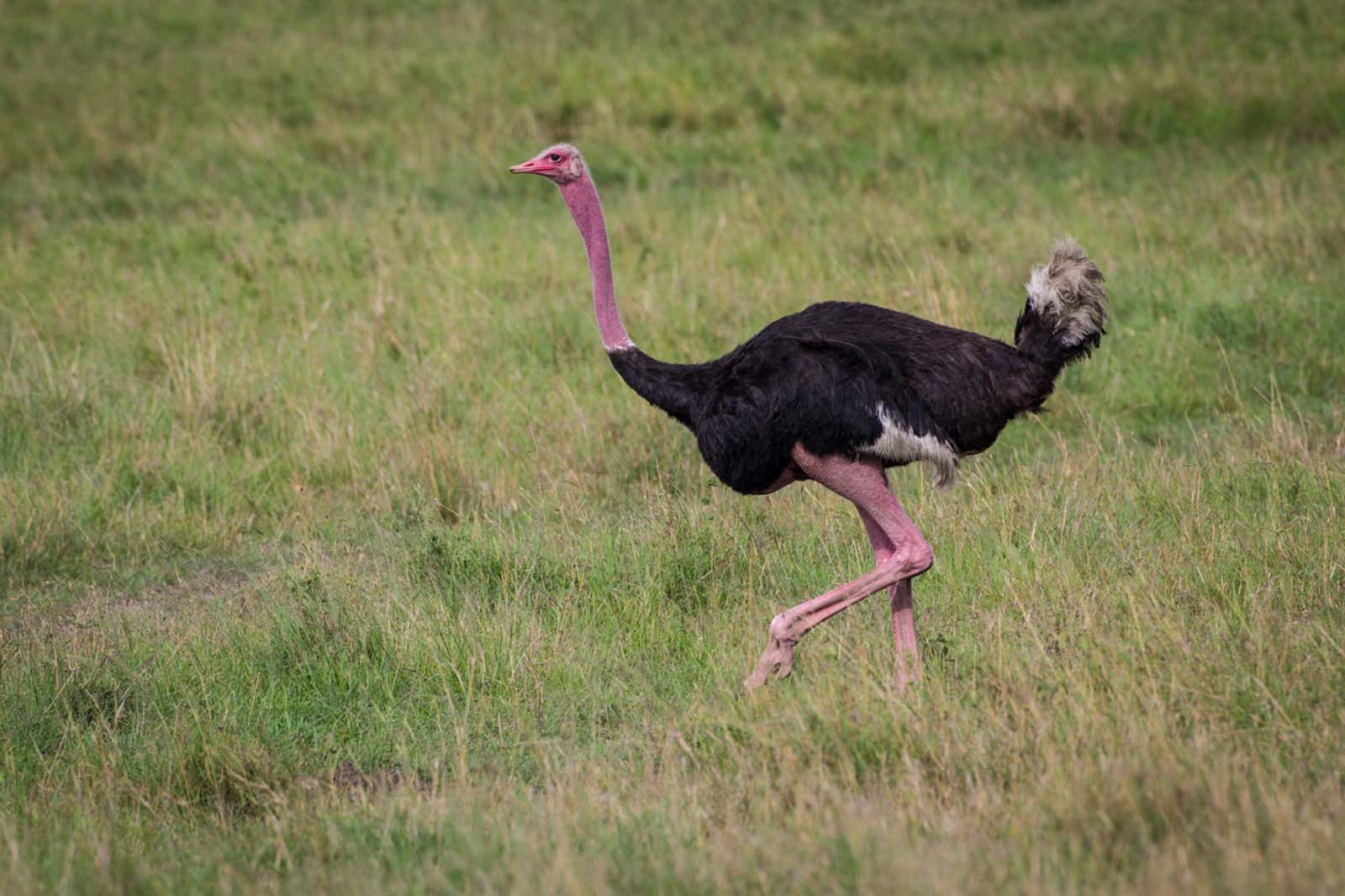
There are two species of ostrich in Africa. The common ostrich and the Somali ostrich. Contrary to popular belief, the Ostrich isn’t the world’s largest bird, which belongs to the albatross. However, they are the largest flightless bird in Africa and they lay the largest eggs of any living land animal. Want some more ostrich facts? They are also the fastest birds on land and can run up to a whopping 70 km/h (43.5 mph)
African Crocodile
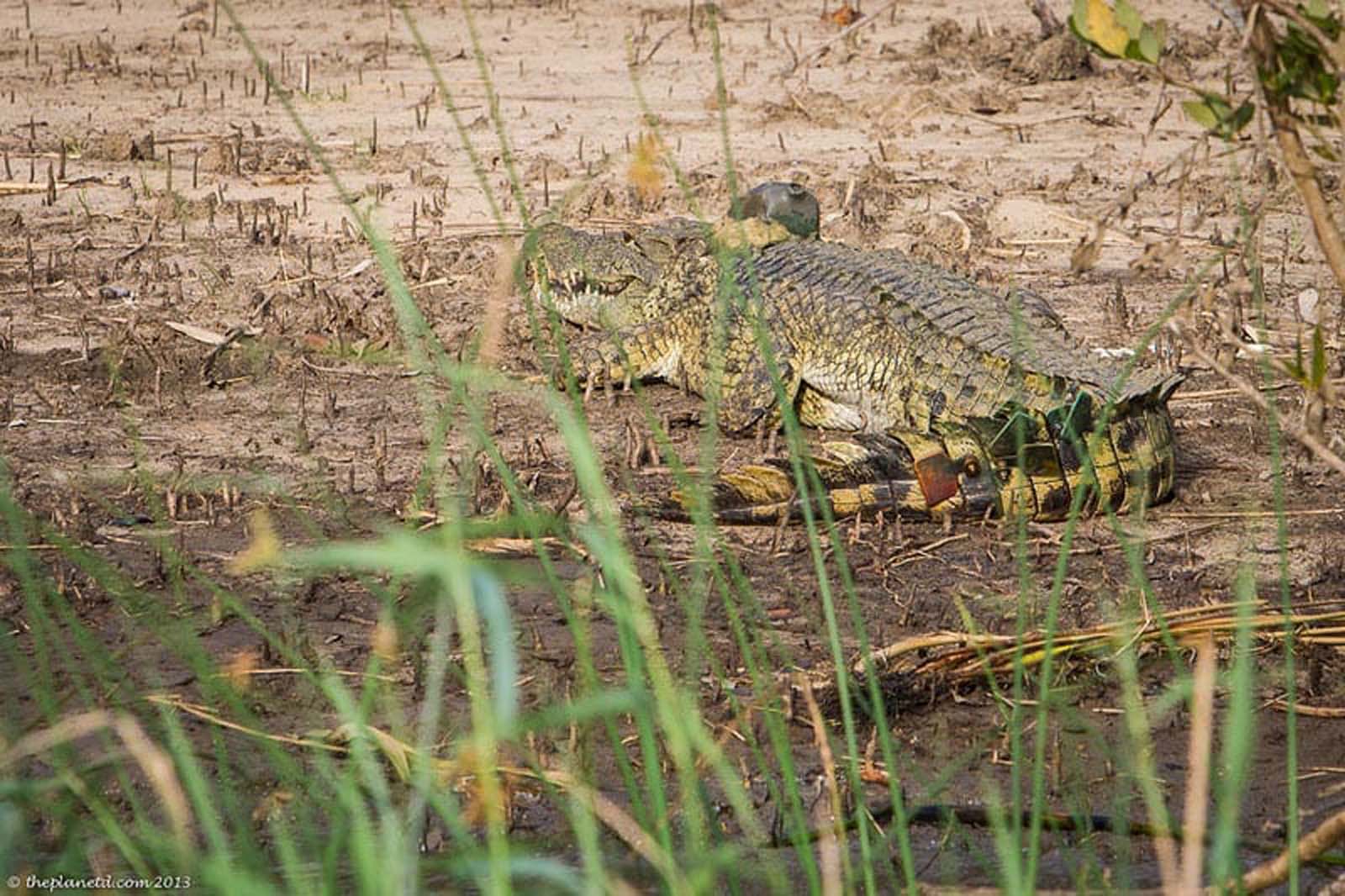
While cycling Africa, we camped along the Nile and I must admit, I was terrified of an encounter with a Nile Crocodile. Luckily we never encountered one while camping, but we did see them when on safari.
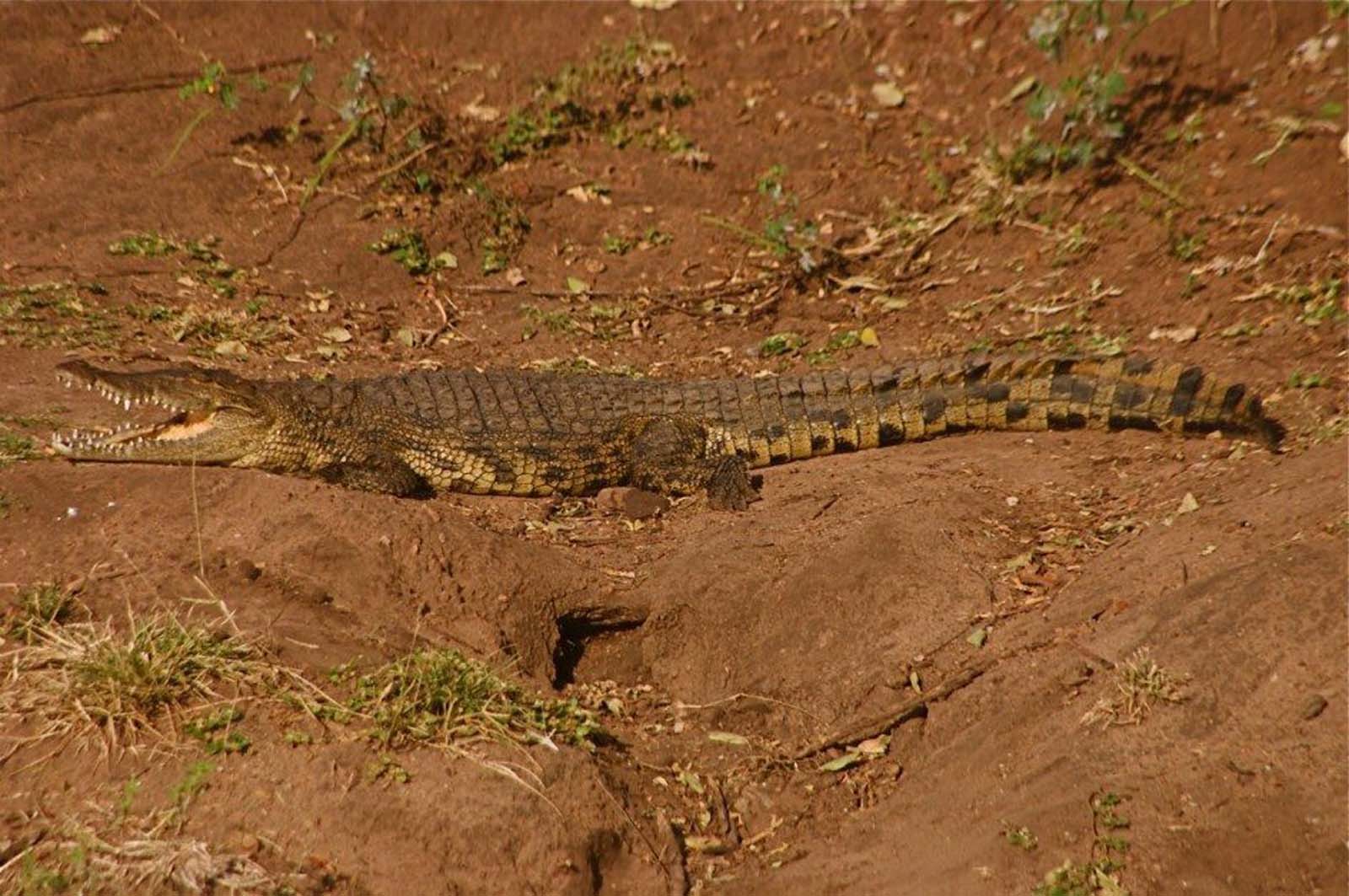
The Nile crocodile is the largest reptile in Africa and they are pretty dangerous too. They kill more people than lions as they lurk in shallow waters on river banks. We were silly enough to go kayaking with crocodiles in South Africa. What were we thinkings? Check it out to see.
Cape Buffalo (African Buffalo)
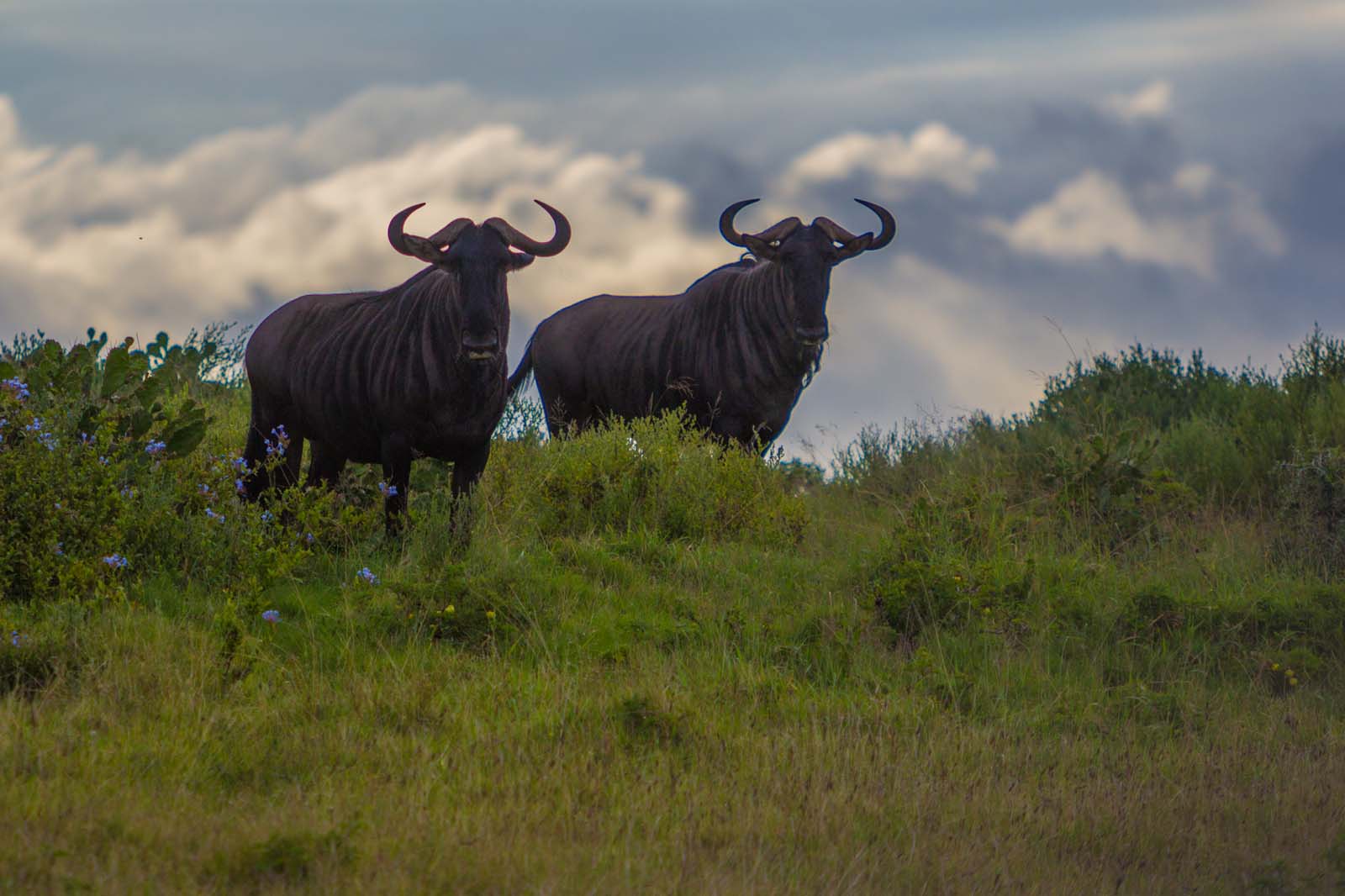
The African buffalo is one of the big 5 African animals. The Big five were named so because back in the day, hunters shot these beautiful creatures for their trophy heads. The big 5 are buffalo, rhino, elephant, lion, and leopards. (we remember it by using the acronym BRELL) Sadly, many species of animals in Africa are critically endangered today because of hunting. I have an idea, let’s shoot them with our camera lens instead of with a gun.
Plains Zebras
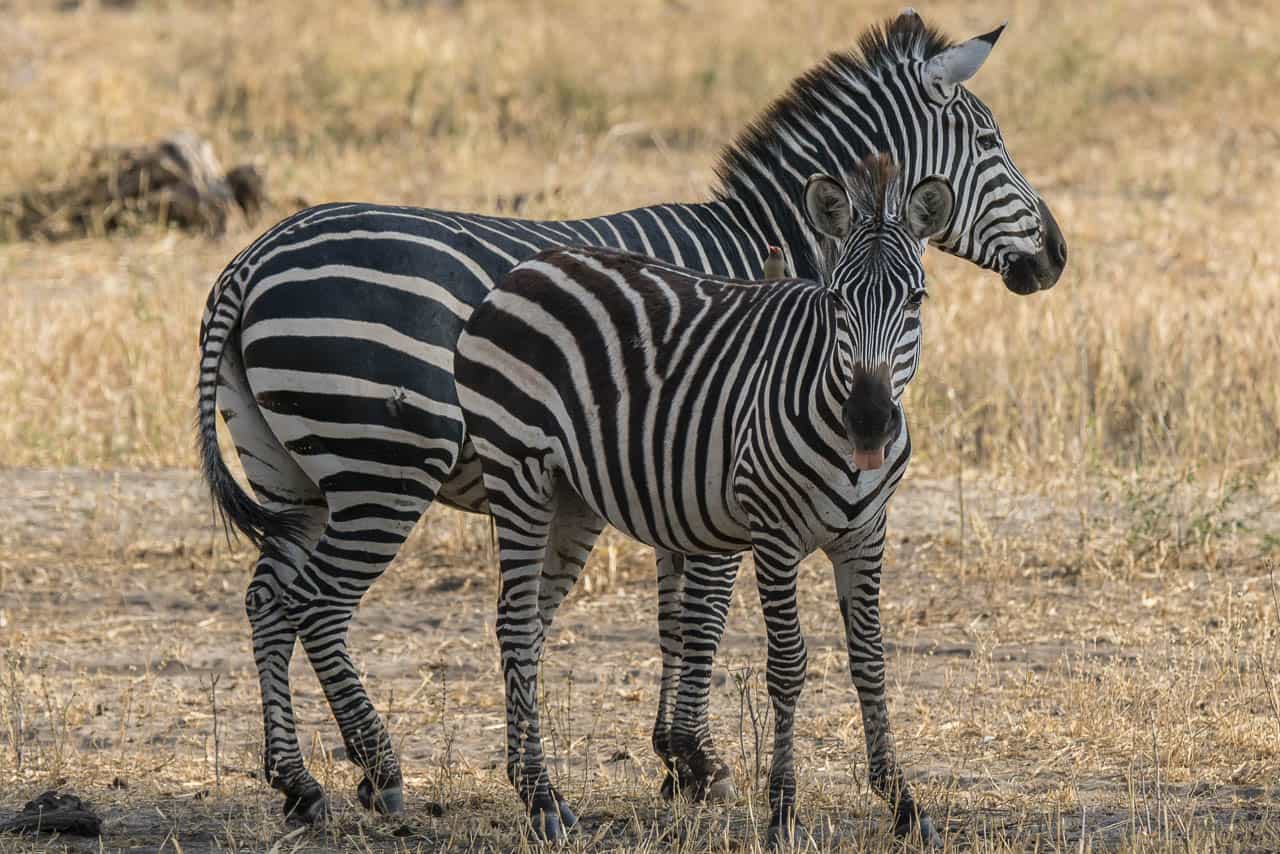
One of the most common animals you’ll see in Africa is the Plains Zebra. We saw a lot of zebras in Tanzania, Kenya, Botswana, and South Africa. We even went horseback riding with zebras on a safari in South Africa. Our horses were surrounded by wildebeest and zebras and I could feel that the horses wanted to join in the run. When you see them up close, they look as if they’ve been painted with thick chalky makeup.
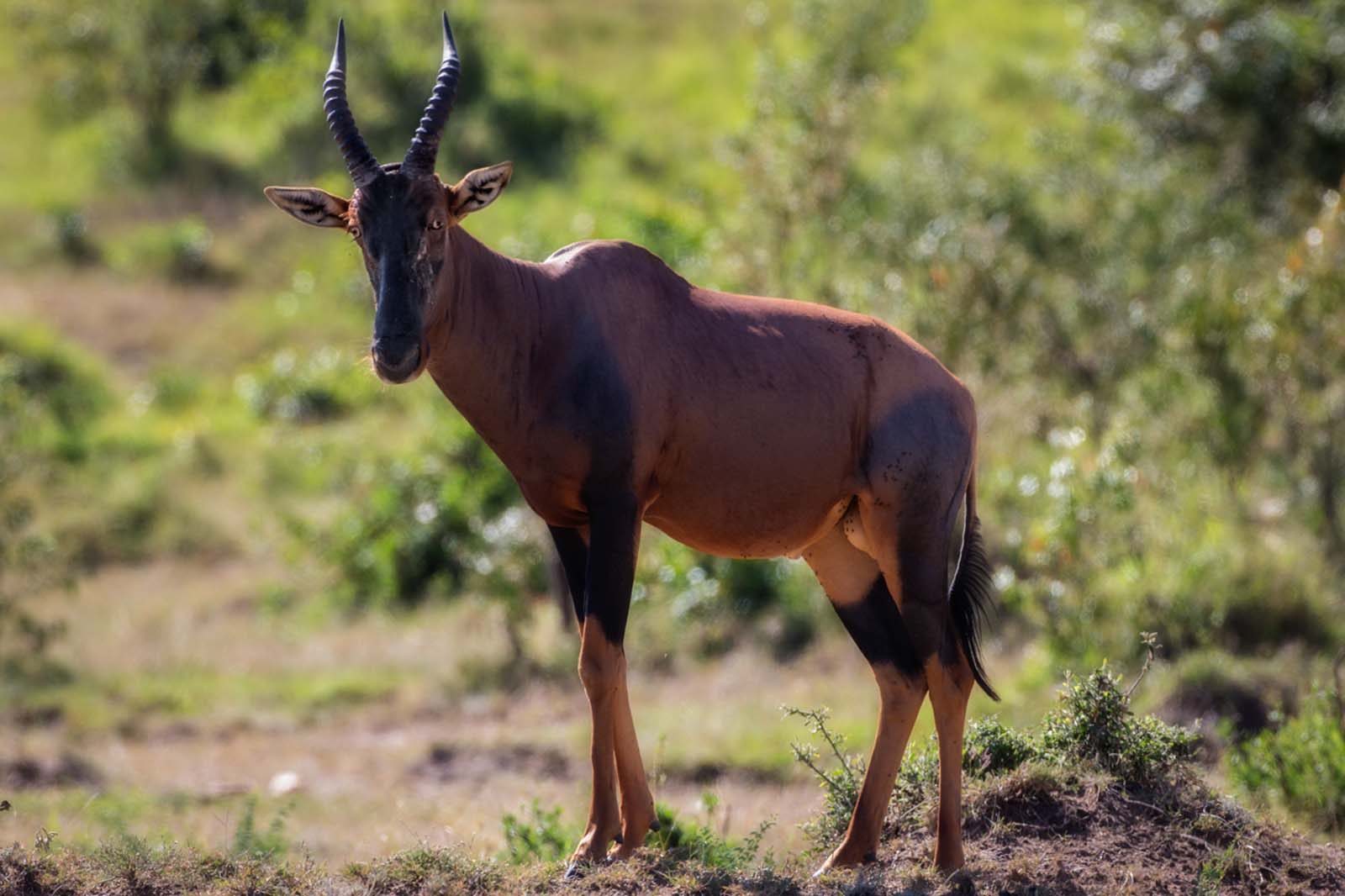
We saw quite a few hartebeests on safari in Africa. This large African antelope was often hanging out with zebras and gazelles. Their face totally looks like an elongated heart. Sadly, like many African animals, the hartebeest numbers are declining due to human encroachment, hunting and habitat destruction.
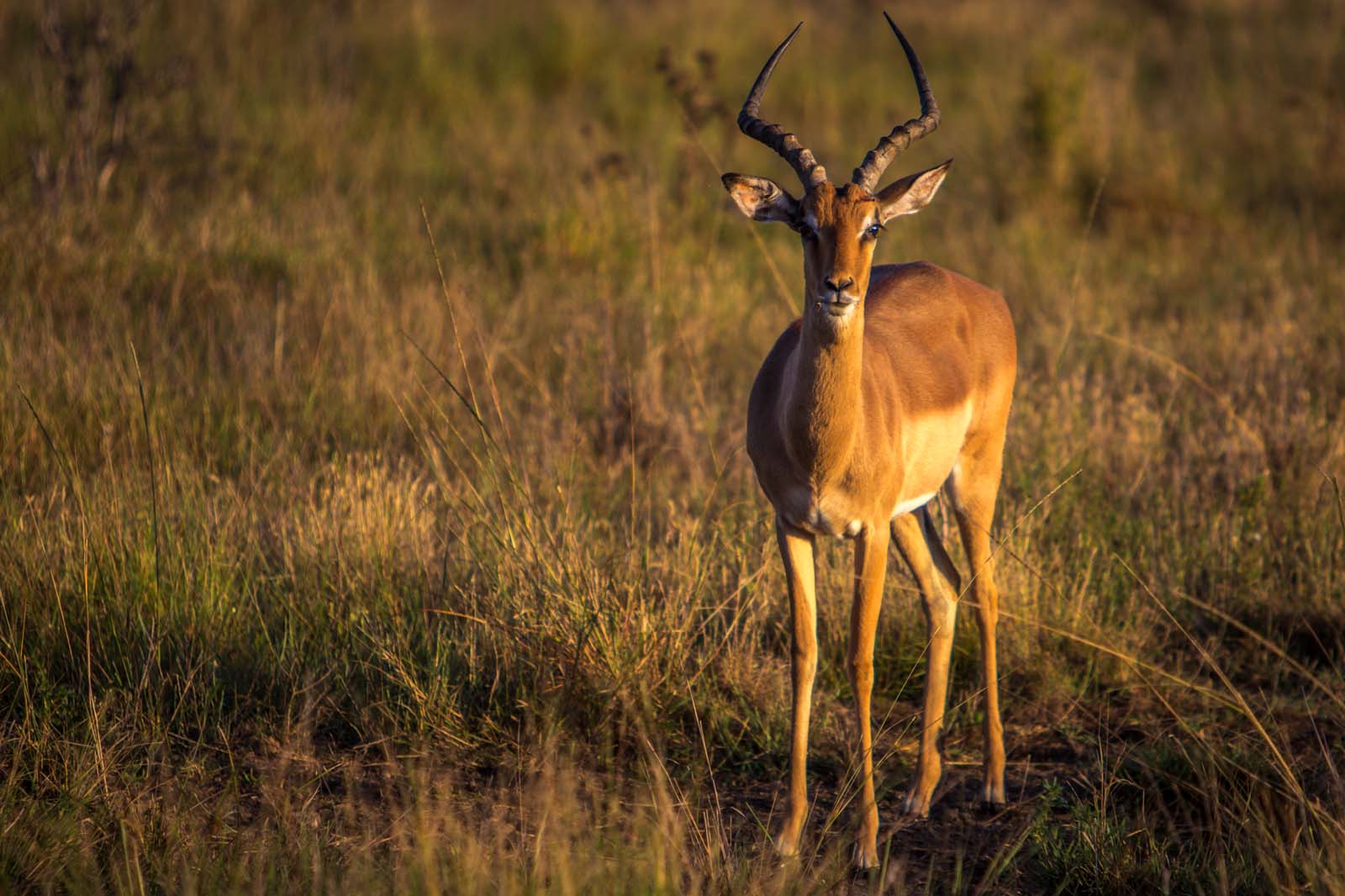
Another African antelope is the Impala. Impalas are graceful and beautiful antelopes that I always thought were gazelles. They are fast and can actually run up to 60 km per hour. (37 miles). Only male impalas have horns.
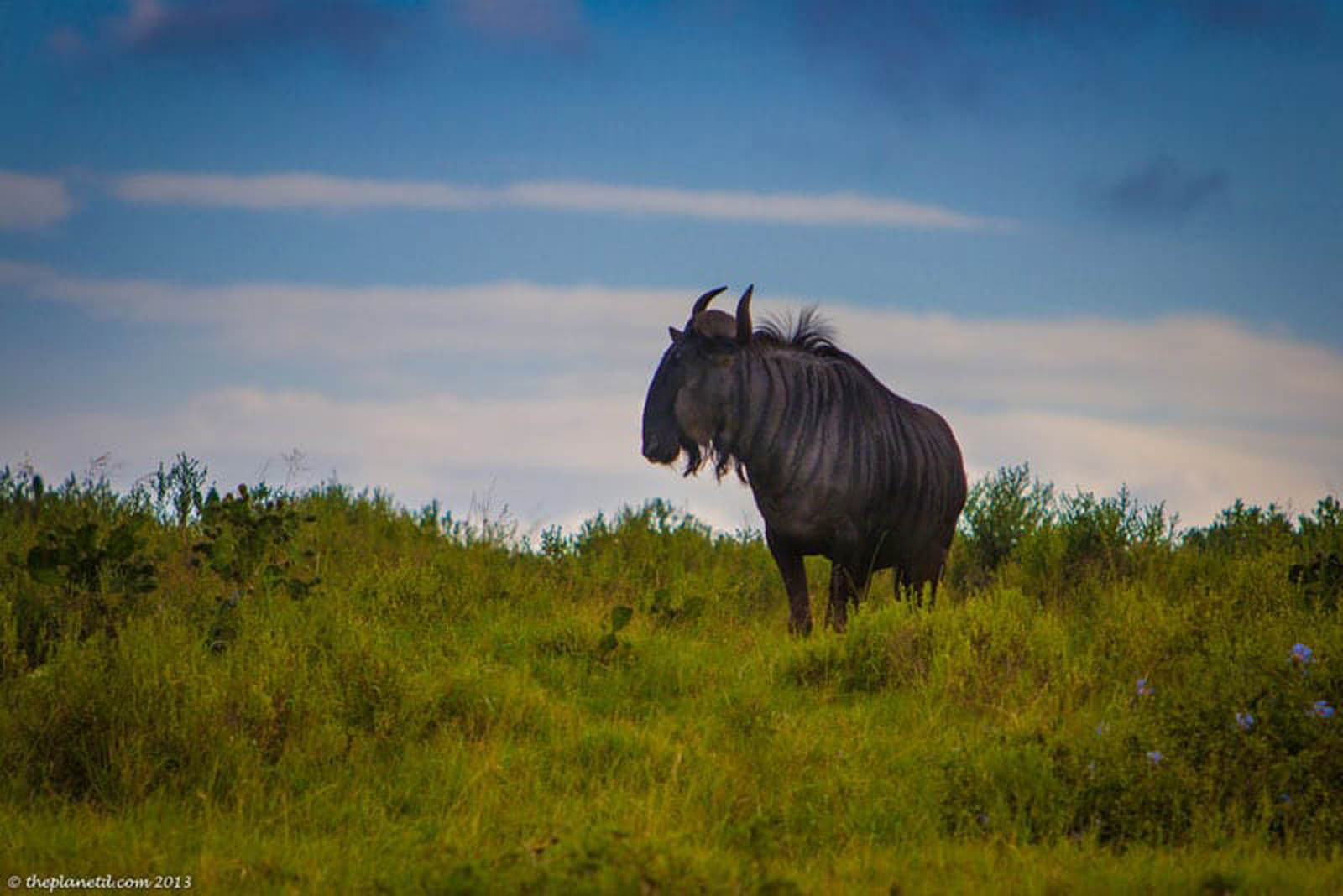
Many people know of the wildebeest because of the famous wildebeest migration in Tanzania and Kenya. It has always been our dream to see the millions of wildebeest cross the African plains. We haven’t been to Africa for the migration, but we have seen many wildebeests. Wildebeests are also calle a gnu. Believe it or not, they are also part of the antelope family.
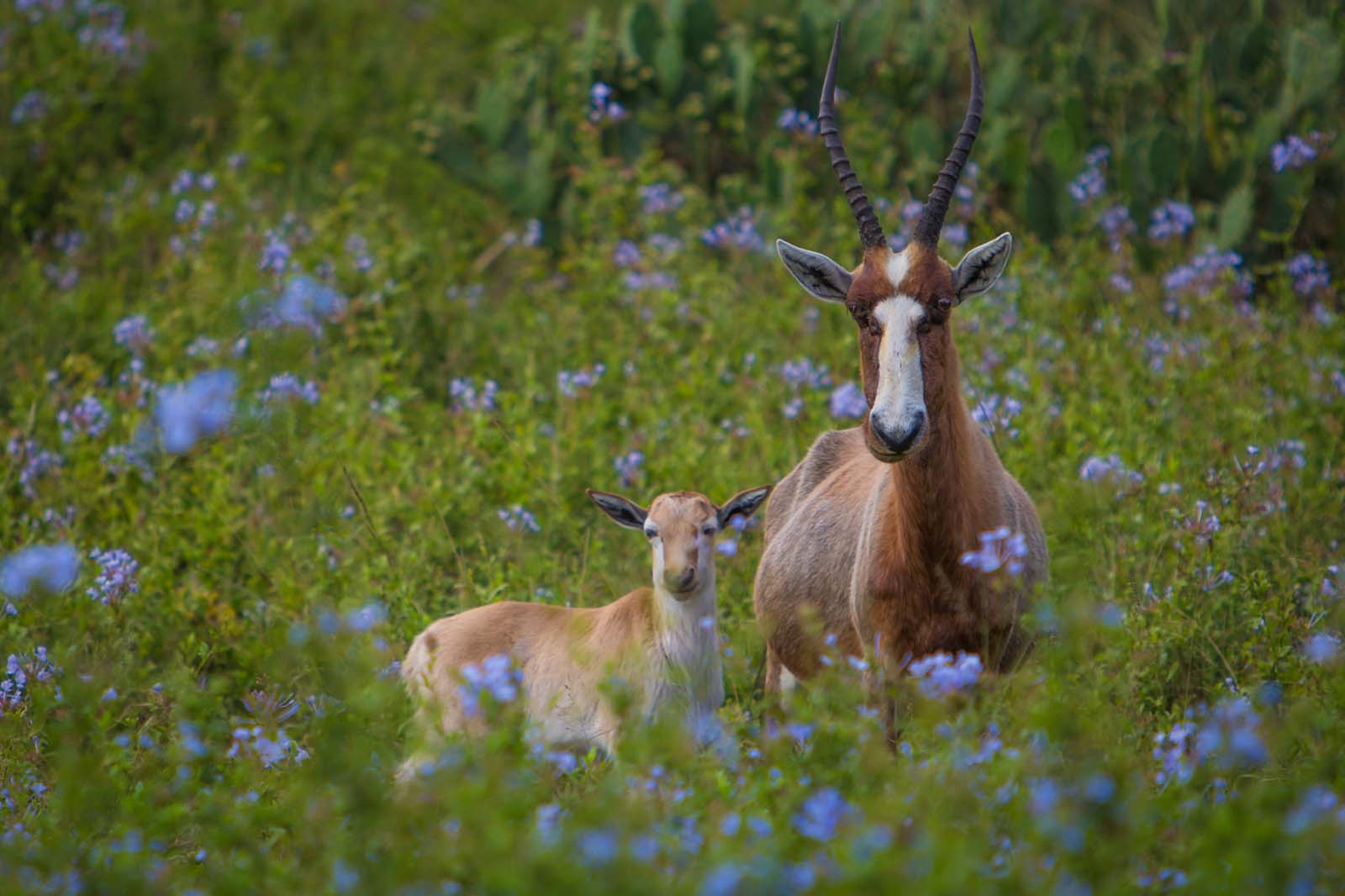
Another member of the African antelope family is the Springbok.
I started to really fall in love with the zebras of Africa. If you look closely at the picture above, you’ll see a little bird on this foal’s back. Read more: iSimangaliso Wetlands – Horse Safari
A Chillin’ Baboon
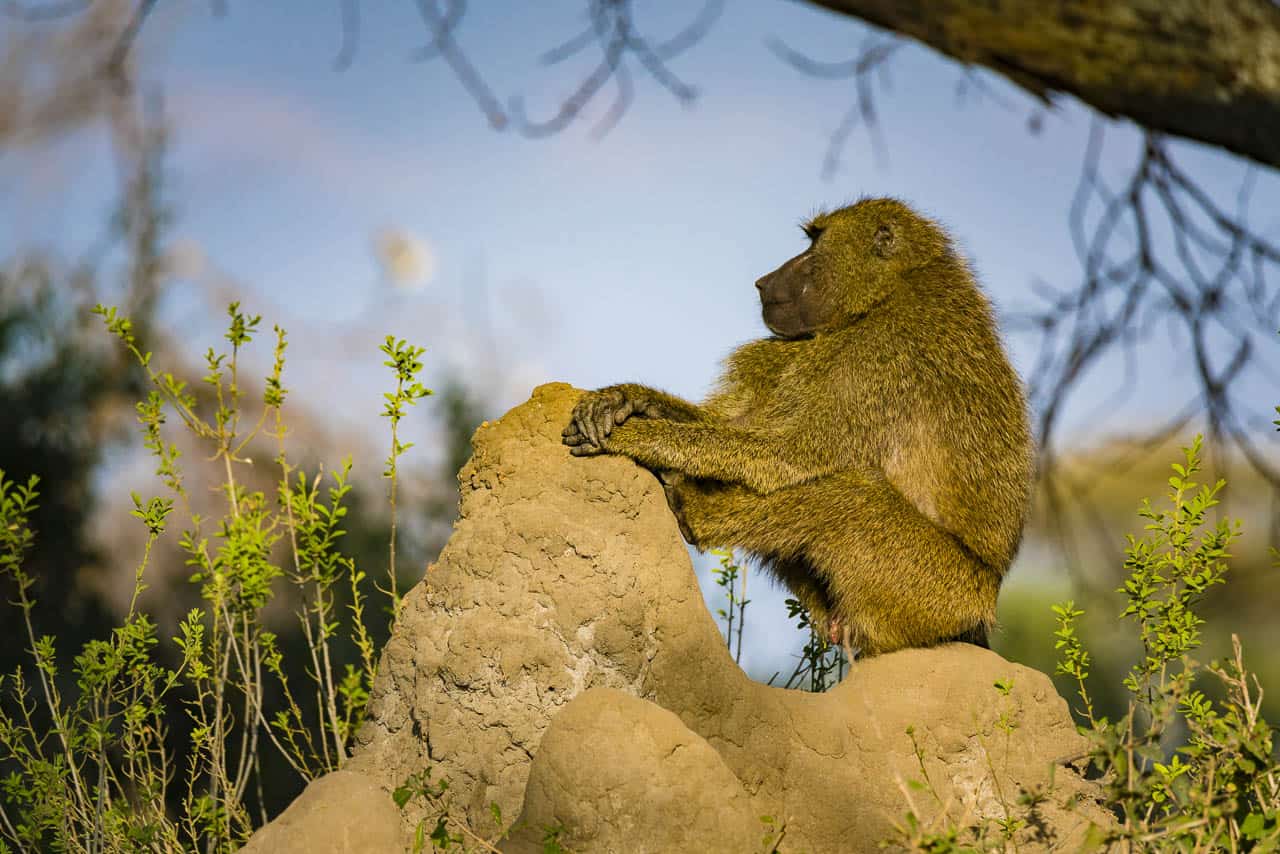
Sitting atop this termite mount, a baboon looks like royalty. A group of elephants had just left the area and this baboon wasted no time jumping on top this mound after they left. You could tell that he was itching to get his spot back.
Sikes Monkey
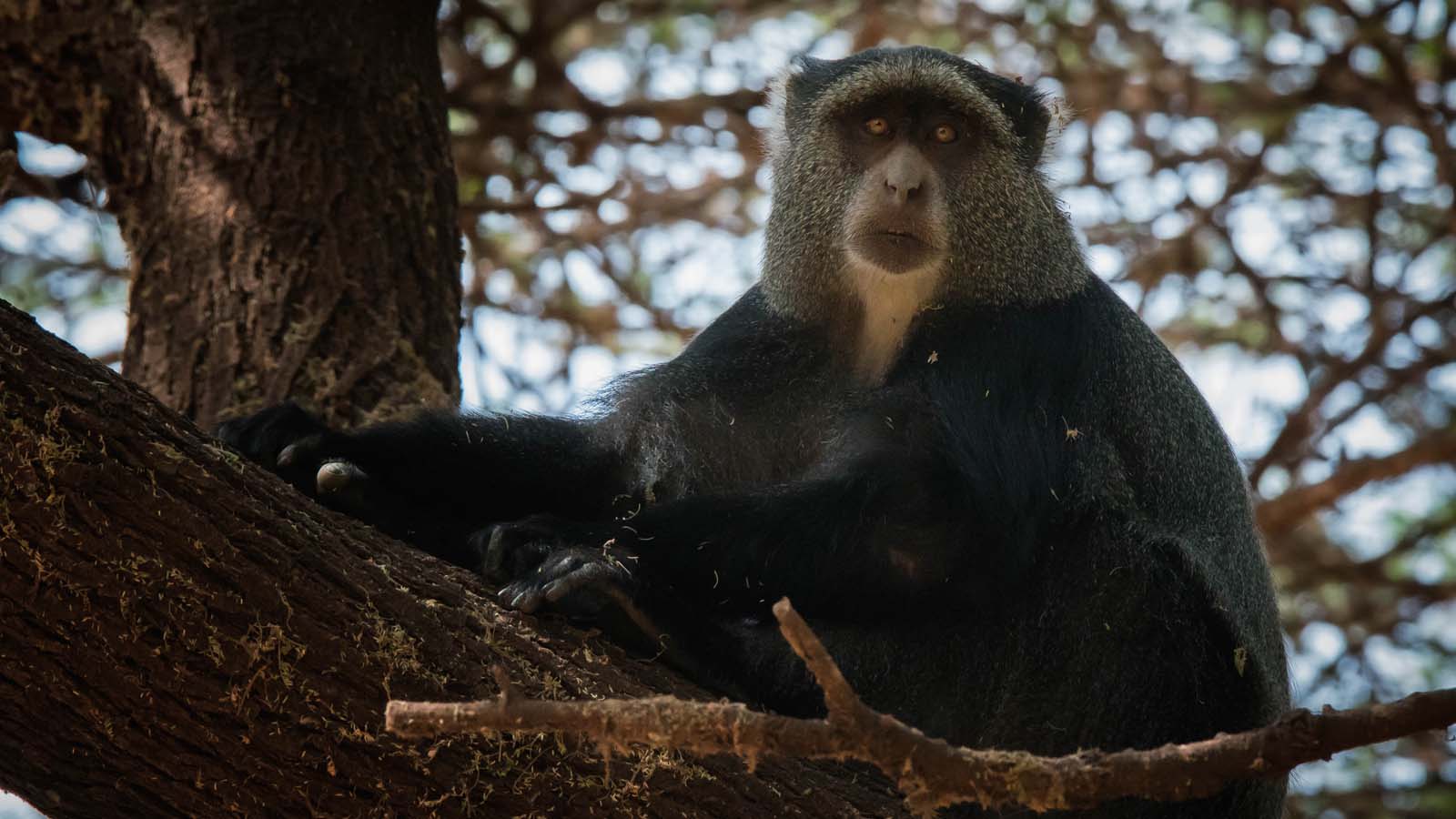
The Sikes monkey was named after Colonel William Henry Sykes an English naturalist from the 1800s. It’s known for its white throat and we saw this handsome devil in Kenya.
Vervet Monkey
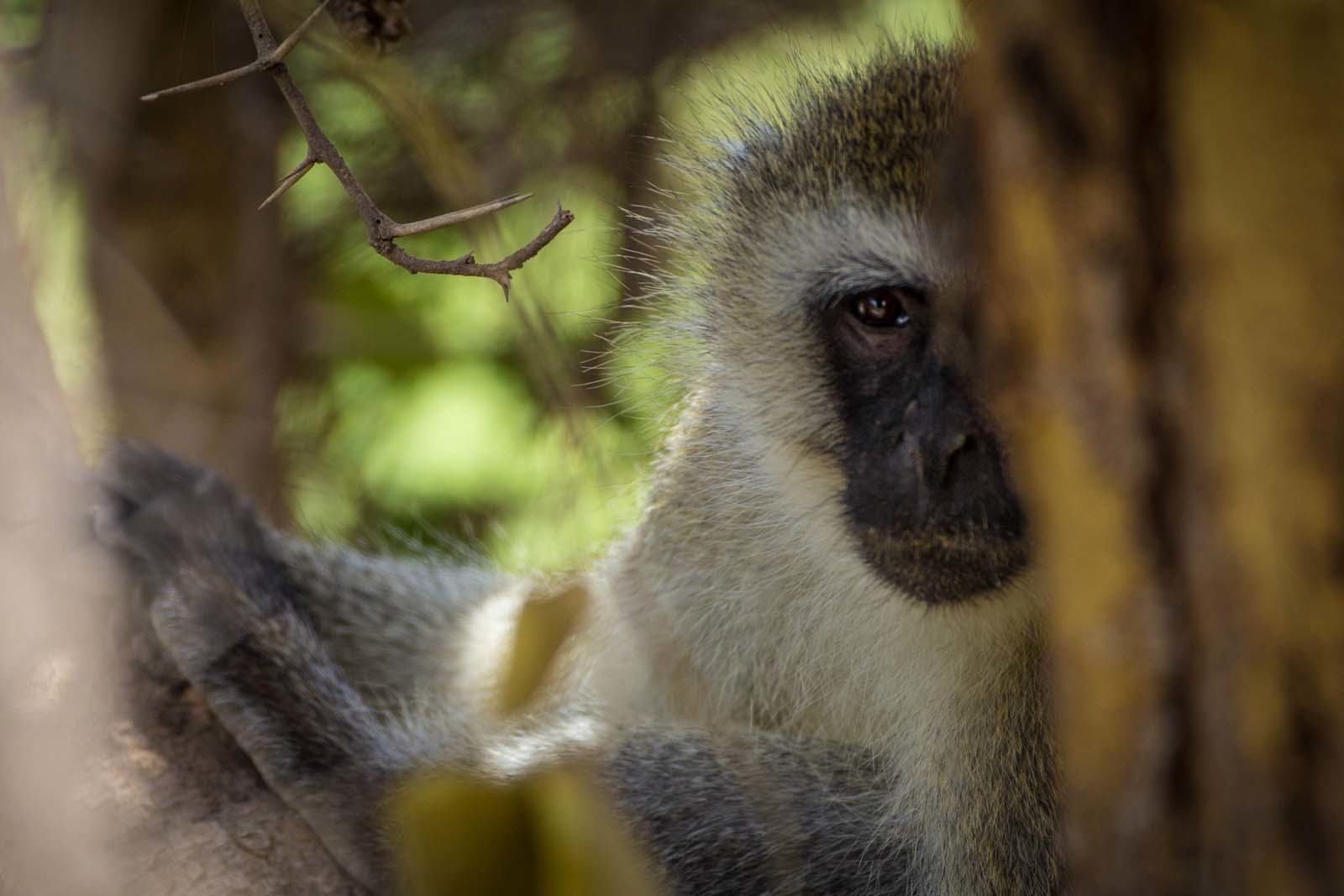
Vervet Monkeys are so cute and are found around lakes and streams in acacia forests and woodlands. We saw this little fellow at Lake Nakuru in Kenya. We also saw a lot of monkeys at Mayanara in Tanzania.
Colourful Birds Of Africa
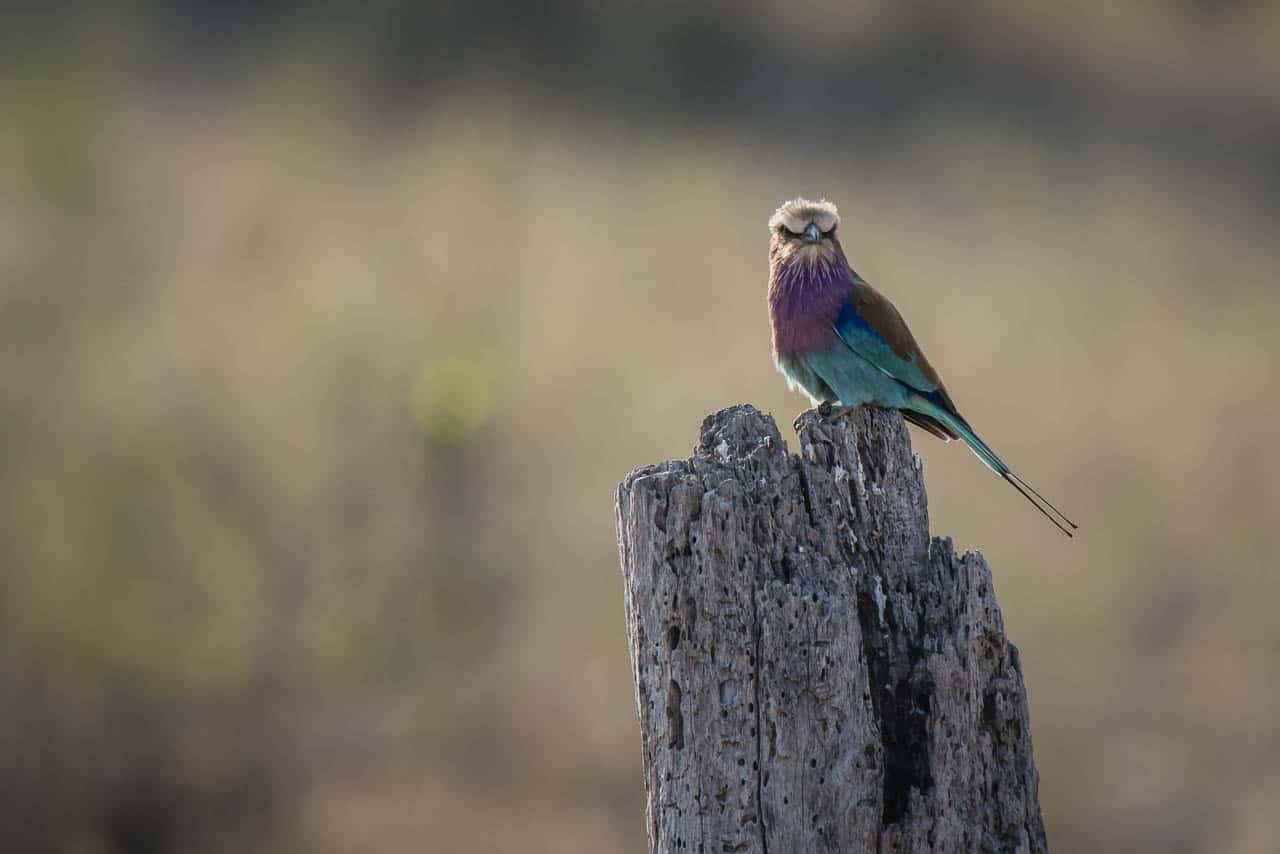
Dave and I are normally not into bird watching, but our safari mates in our truck were very big birders. Their excitement over birds was contagious and by the end of the trip, I started to know the names of the birds of Africa like this colorful cutie the Lilac Breasted Roller.
Penguins of South Africa
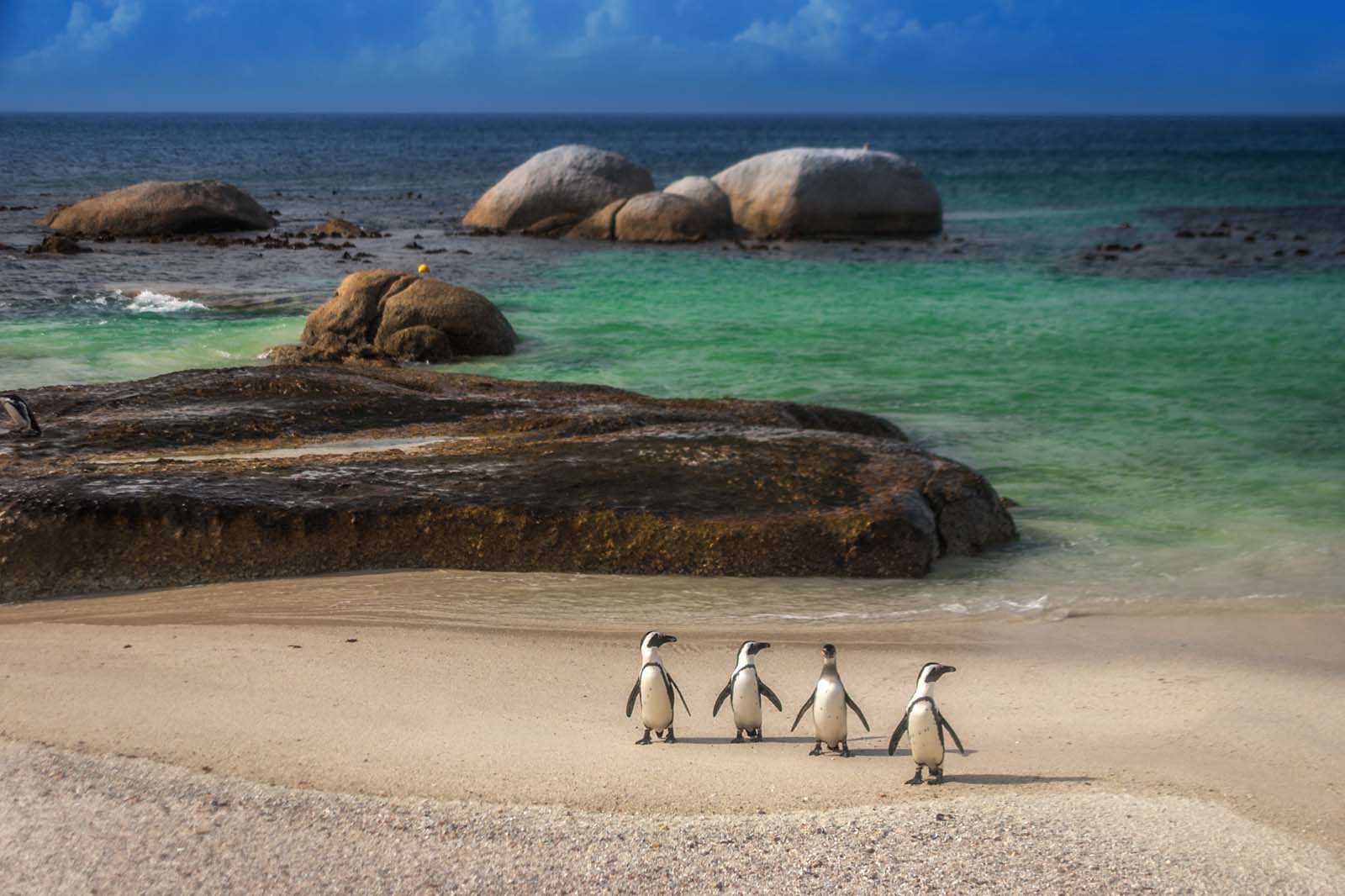
Did you know that southern Africa has penguins? It does! The penguins of South Africa can be found just south of Cape Town near Simon’s town. There is a colony that swims in the cool waters of Southern Africa and they are adorable to see.
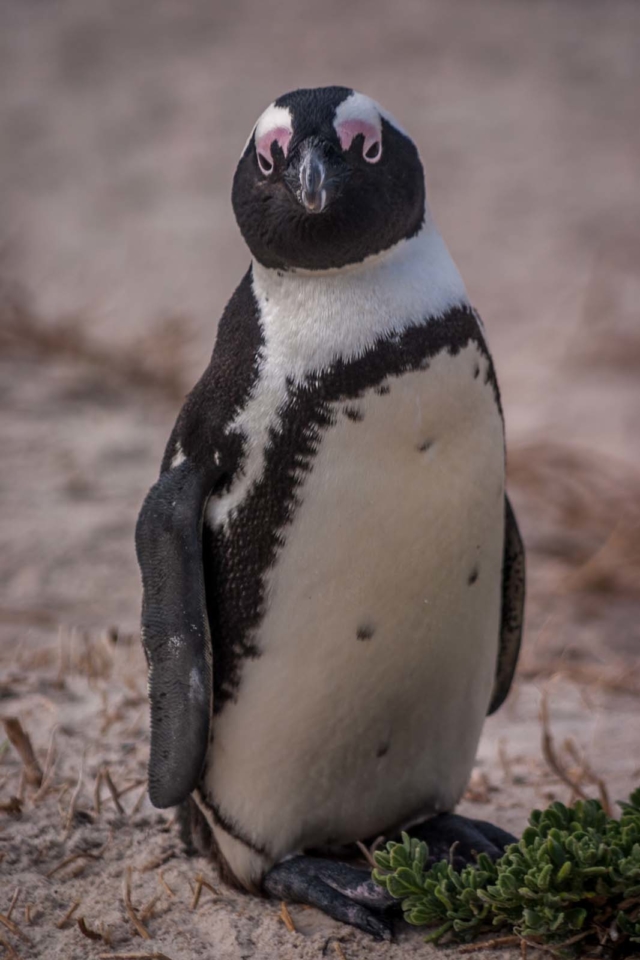
If you make your way out to Boulders Bay Beach, you’ll see a colony of cute African penguins frolicking in the sand on the beach
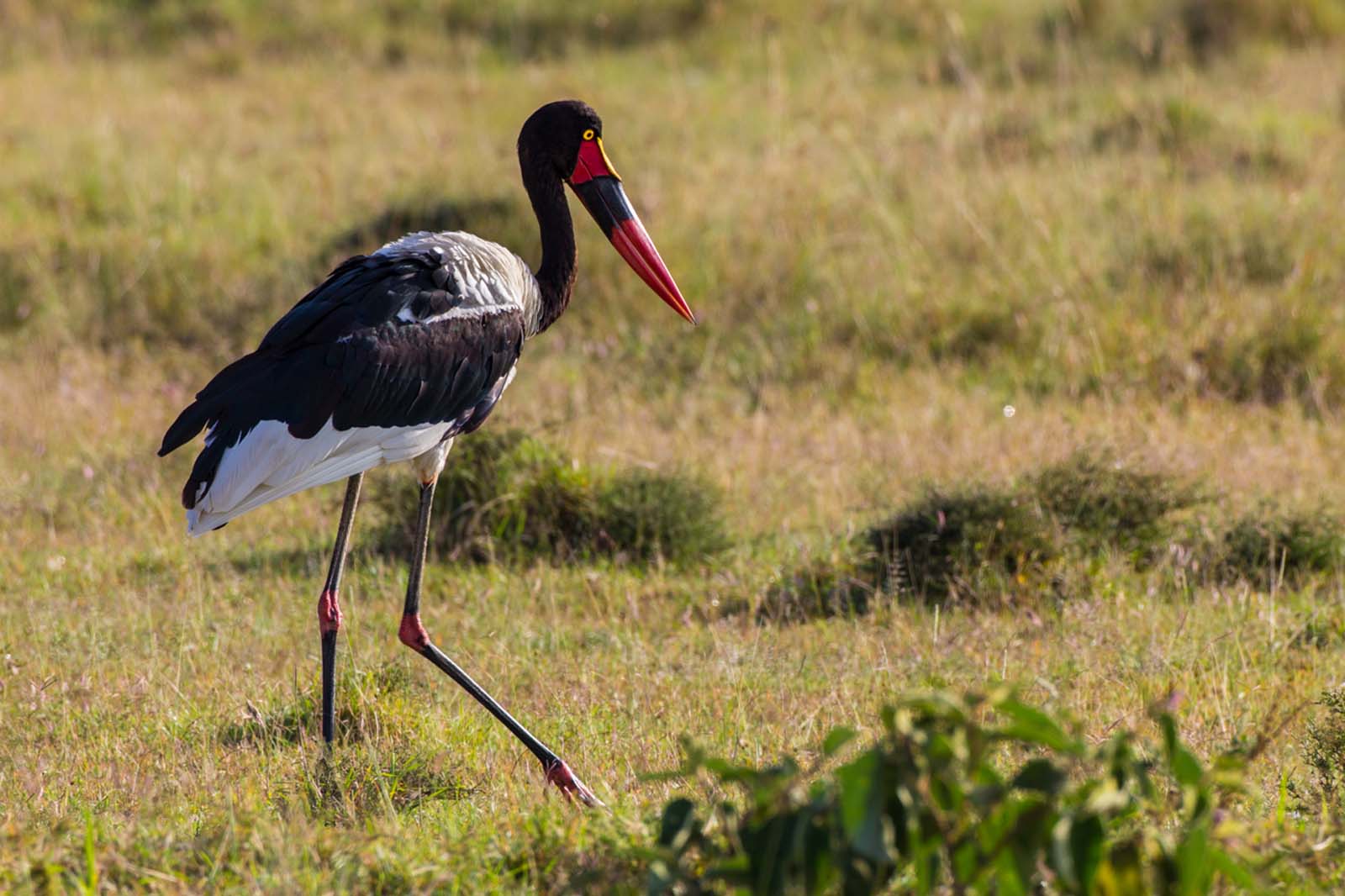
I was very excited to see a stork in Africa. When we were cycling through Ethiopia we saw a lot of them. When I was young I thought storks were made-up birds because people always said that a baby was brought in by a stork. However, they are real! There are 8 species of storks in Africa. We saw them in The Rift Valley, in South Africa near St. Lucia, at lakes in Tanzania, and in Kenya.
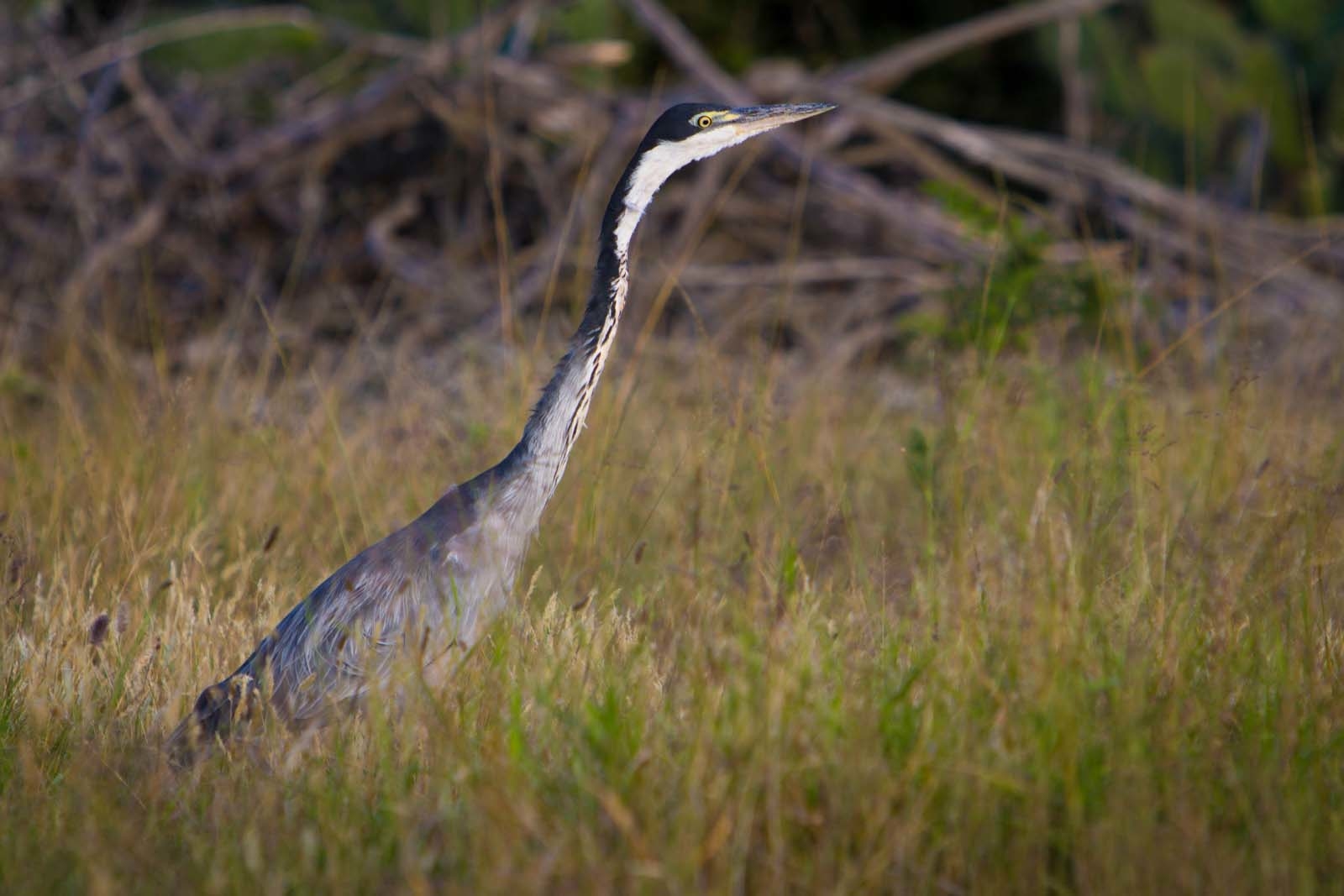
At first, we weren’t too excited about the bird species in Africa, but then on one of our safaris in Tanzania, a truck mate was a full-on bird watcher. She pointed out birds for us to see and we started getting excited whenever we saw a new species. I can see why birding is so popular!
A Late Evening Yawn
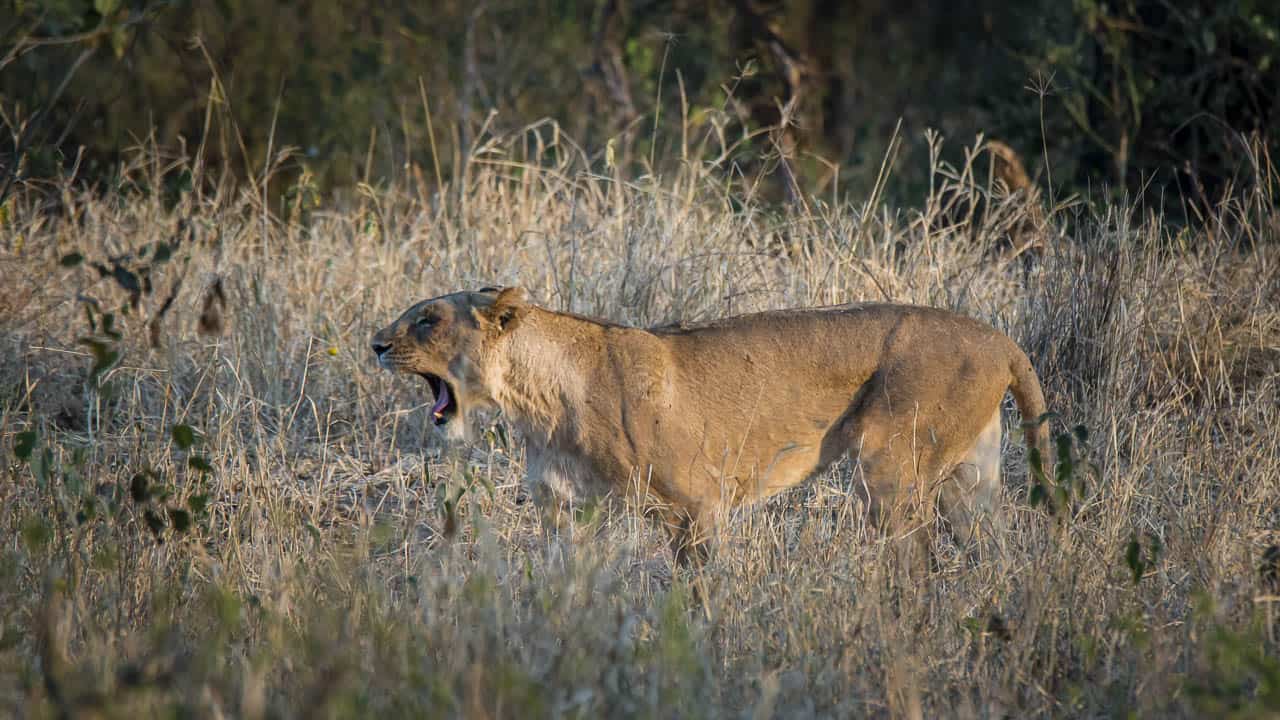
The sun was setting and this lion knew it. Almost time for a nap and time for us to head back to the lodge. This was on safari in South Africa at Kariega Game Reserve on the Garden Route.
Lion Looking At Me Licking its Chops
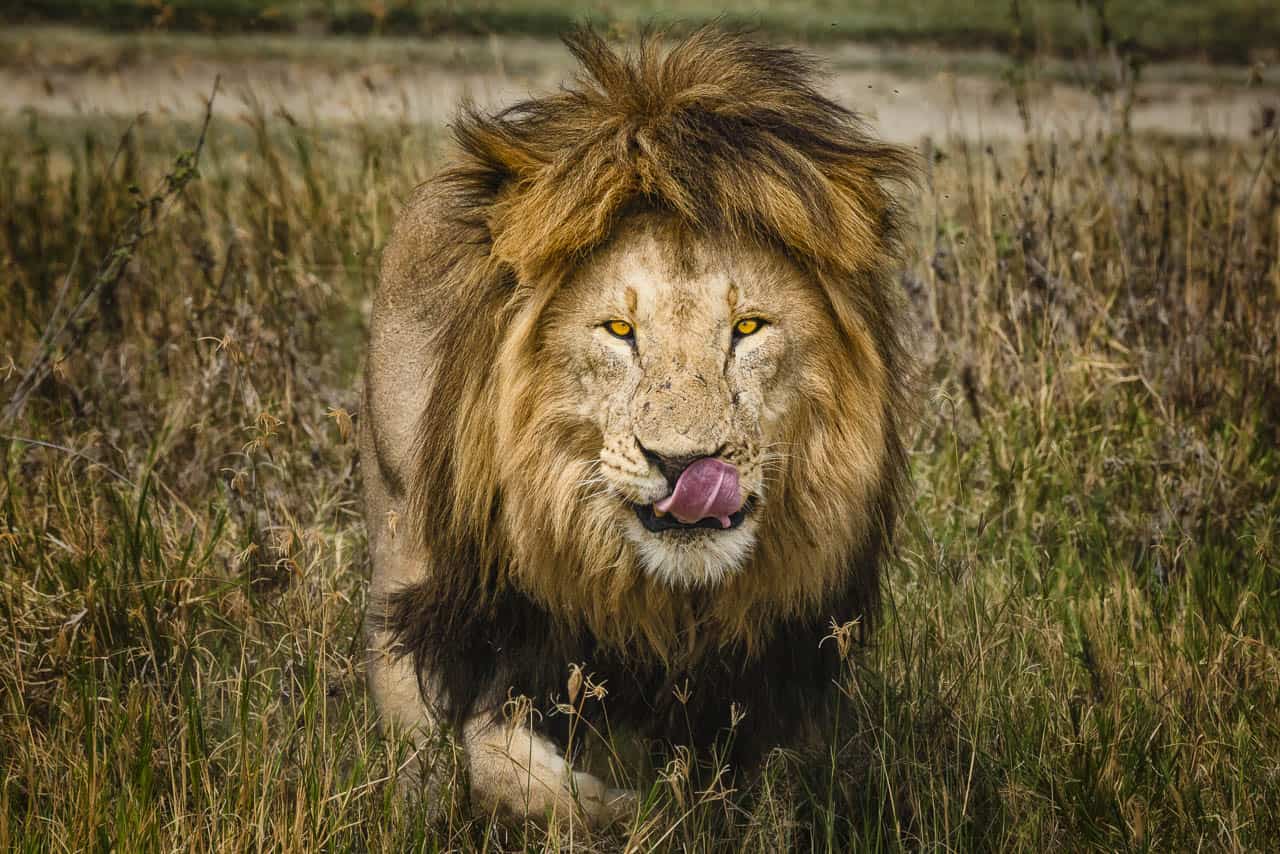
This is the brother of our first lion photograph in the Serengeti. He walked so close to our truck that George told us to get our hands inside. He was licking his chops, so you knew he was ready for lunch!
Lioness On A Rock
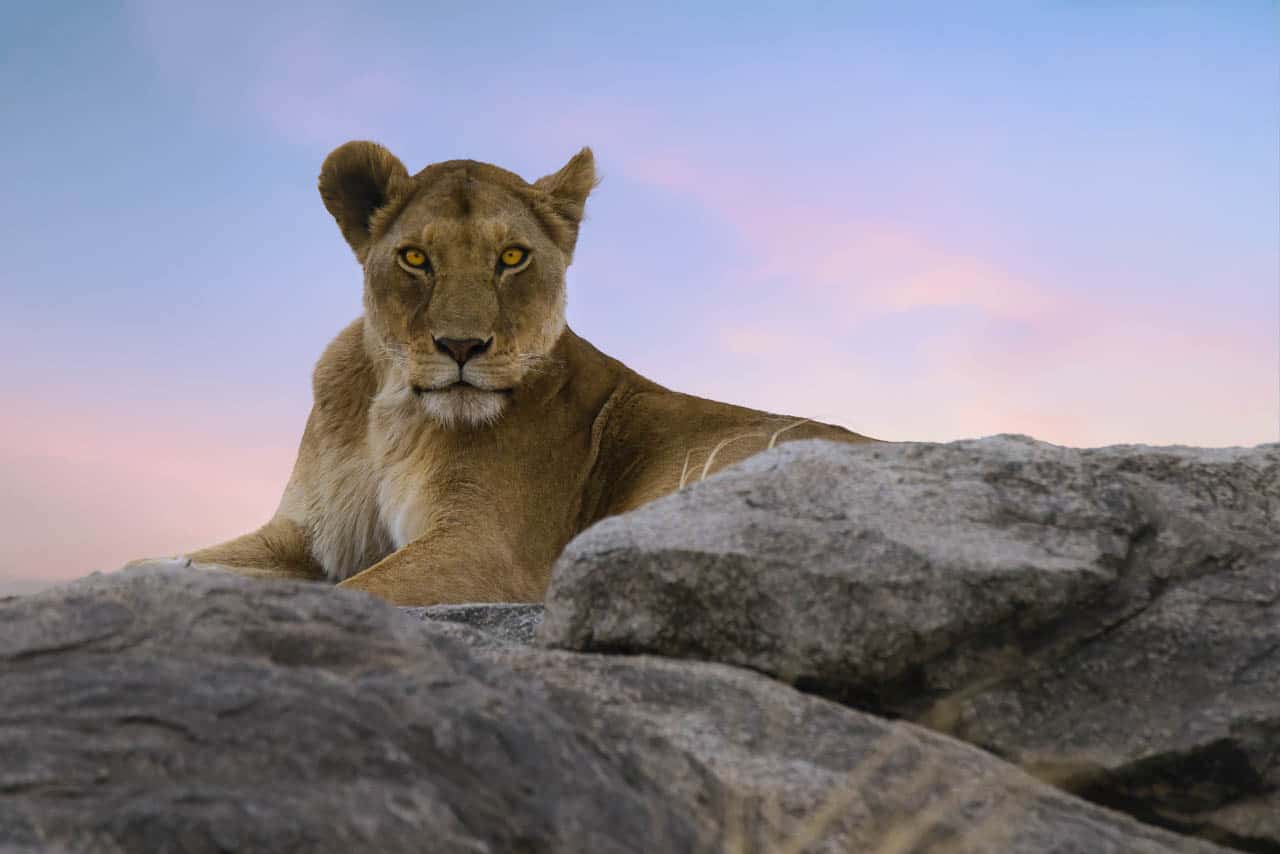
One of our favorite African animal encounters was certainly seeing this female lion perched on Lion King Rock. When entering the Serengeti, the first thing we spotted was this lioness relaxing on a rock beside the famous Lion King Rock. And this scene was fitting. This is exactly what we expected to see on the African savanna and the moment didn’t disappoint.
Watch the Big 5 of Africa in Kenya
We can’t wait to go back to Africa to go on more safaris. We haven’t seen the mountain gorillas of Rwanda, Uganda, or the Congo yet and we still have yet to see the Chimpanzees at Jane Goodalls sanctuary. But isn’t that what makes travel exciting. We are always adding more encounters and adventures to our list!
More African Animals in Photos
Lions napping in a tree.
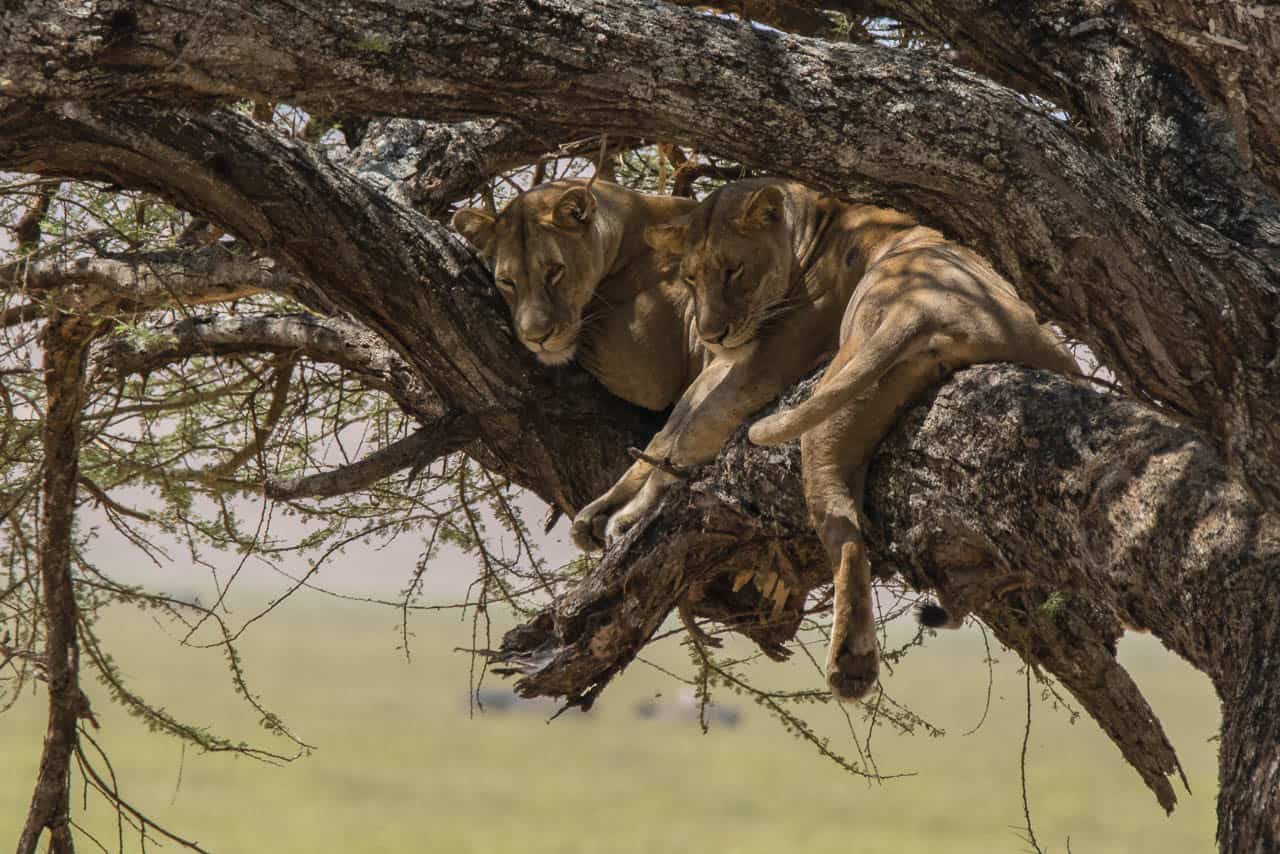
I’ve always wanted to see lions sleeping in trees. It was a first for us on our Tanzania safari. Lake Manyara claims to be famous for sleeping lions, but we saw lions sleeping in trees in the Ngorongoro Crater and here at Tarangire National Park. Aren’t they beautiful?
Lioness With Her Kill
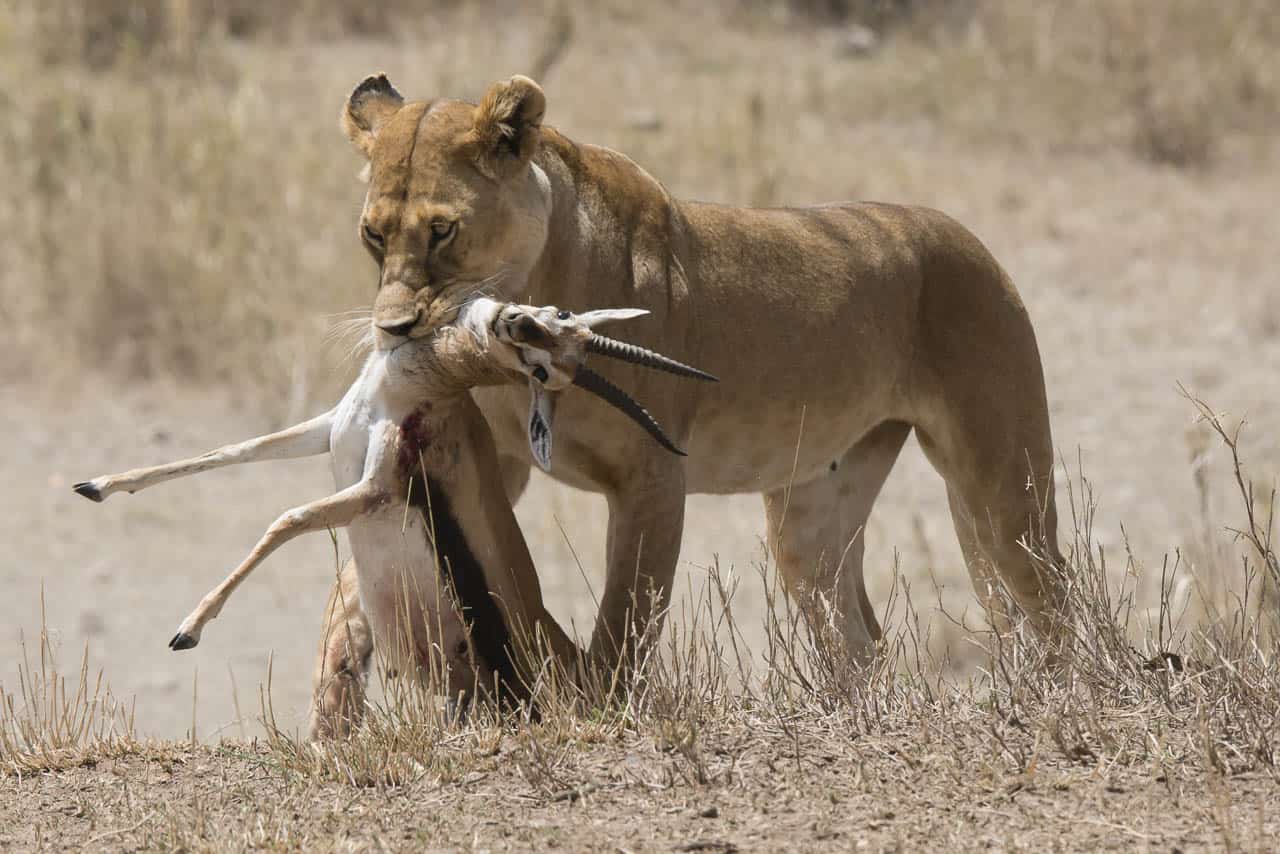
Watching this female lion carry her recent kill along the African savanna showed just how harsh conditions are for animals. She may have caught dinner but getting it back to her cubs took a lot of hard work. She walked for a few minutes and then dropped the gazelle taking heavy breathes as she caught her breath.
All the while she had to keep an eye out for other predators that could challenge her to take her kill. At one point she saw a lone gazelle and dropped her kill to try for another. It managed to outrun her, but she exerted a lot of energy. I wonder how she would have carried two kills at a time?
Cheetah Cub
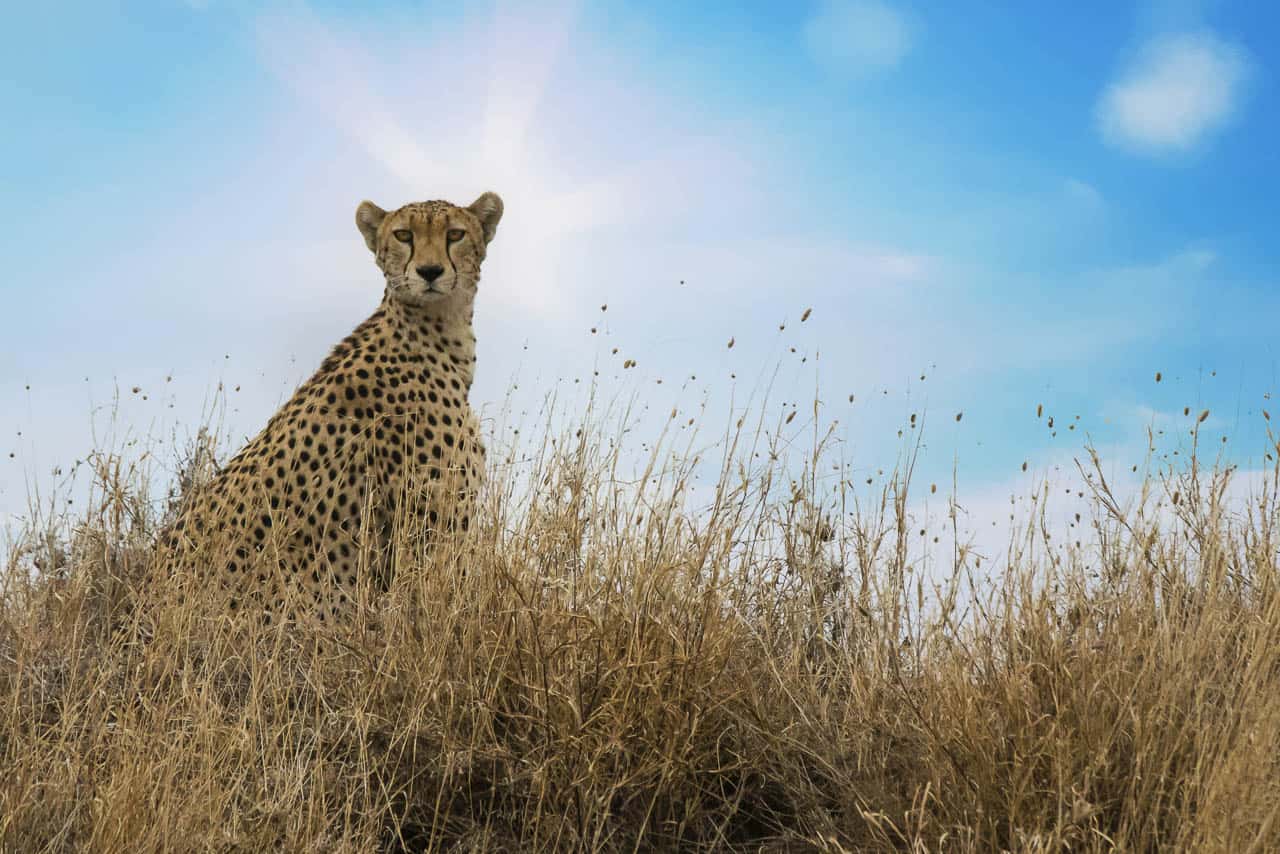
When visiting the Masai Mara in Kenya, we only saw one cheetah our entire safari. While on safari in Tanzania, we saw half a dozen cheetahs including moms, cubs, and this adolescent.
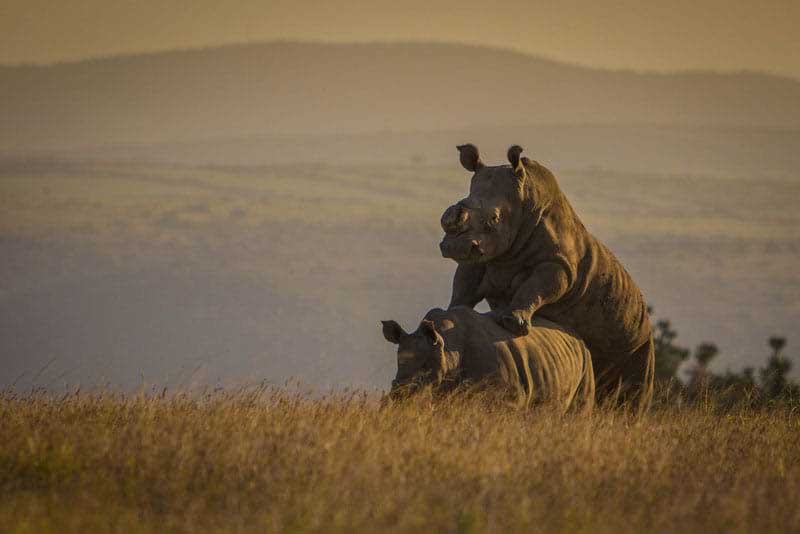
At the game reserves in South Africa, they cut off the rhino’s horn so that poachers don’t kill them for it. It is sad to see that this needs to be done, but at least it keeps them safe. I don’t think these two felt too bad about it, they seem to be enjoying life pretty well!
Male Lion In The Ngorongoro Crater
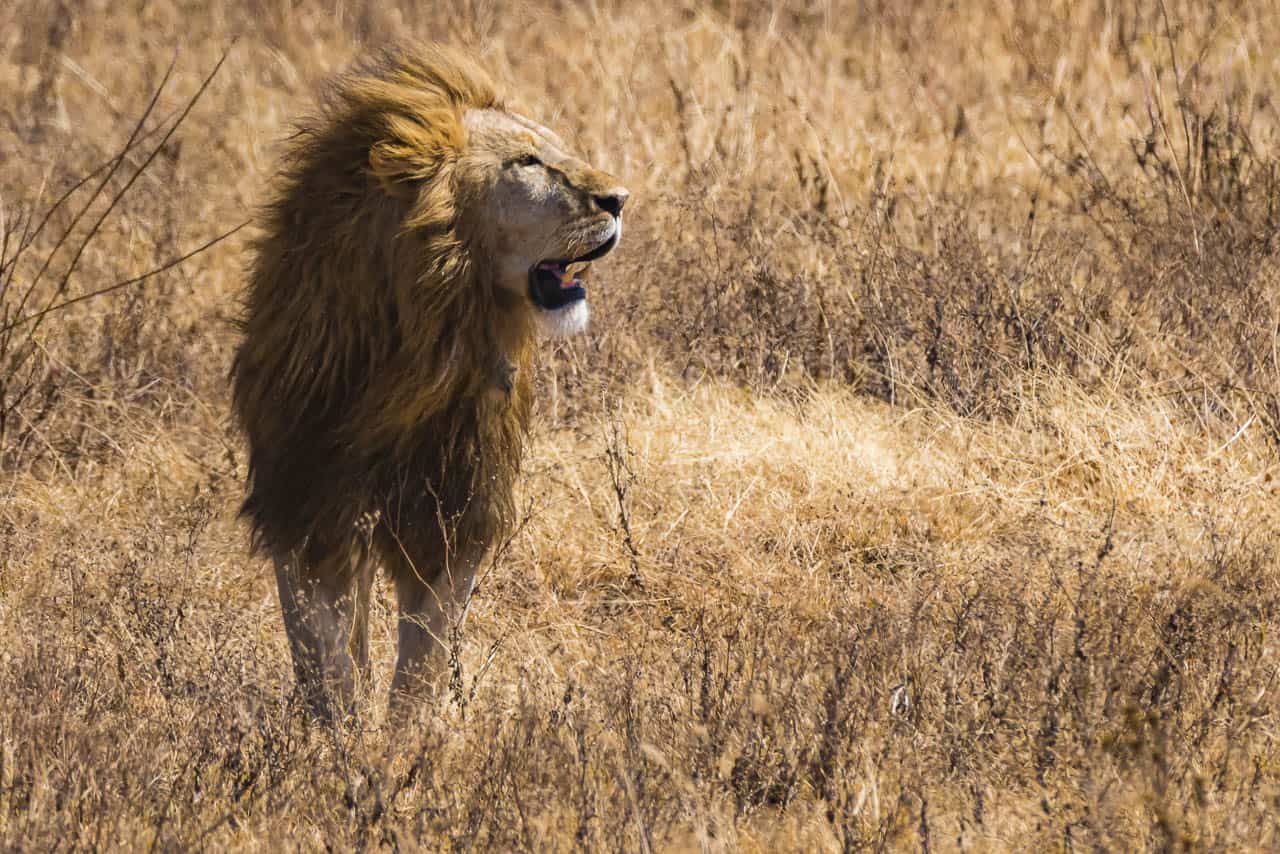
We didn’t expect to see male lions at the Ngorongoro Crater but sure enough, after spending time watching the wildebeest and zebras, we came across two male lions walking steadily to find some shade. We followed them for a bit before they changed course towards a very big and shady baobab tree.
Staring Into The Breeze
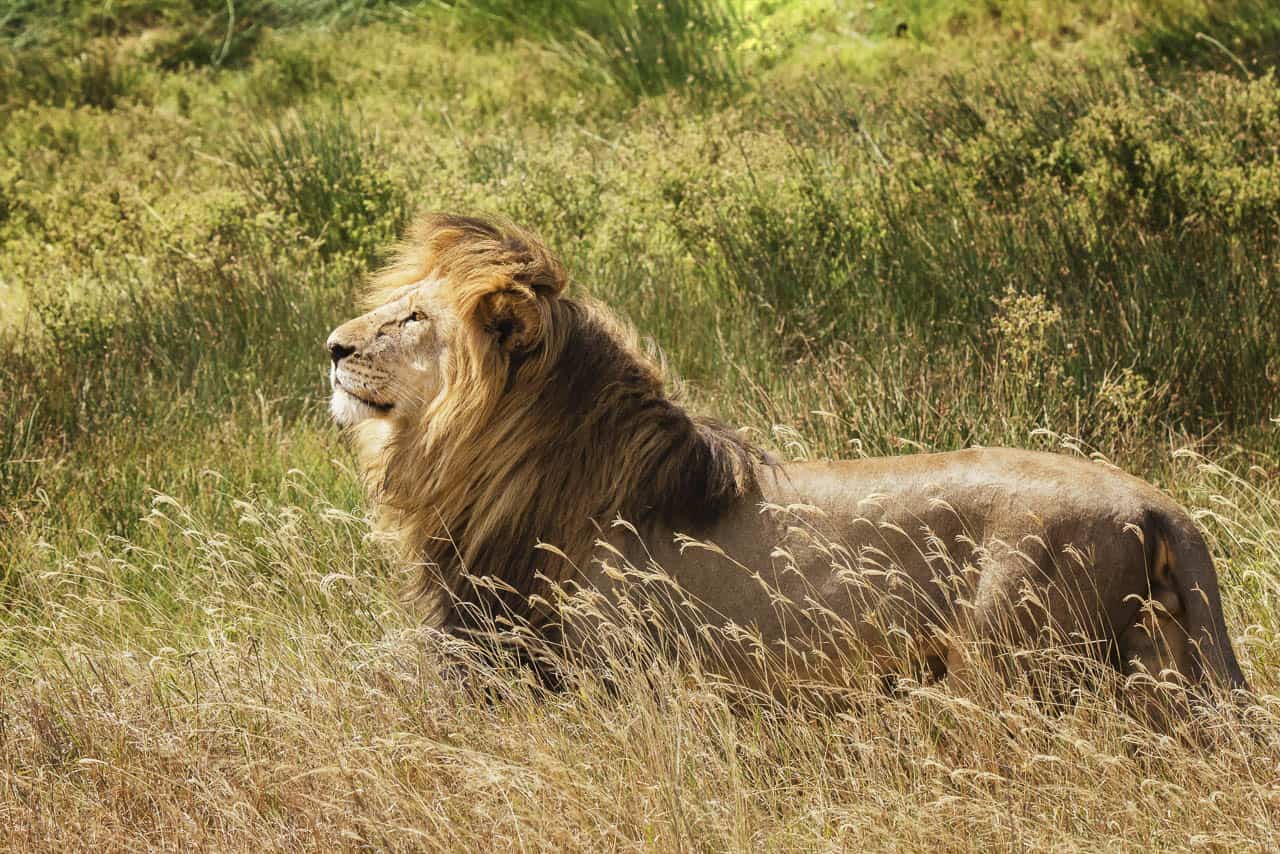
Something tells me this lion smells tonight’s dinner.
Close Up Of A Giraffe
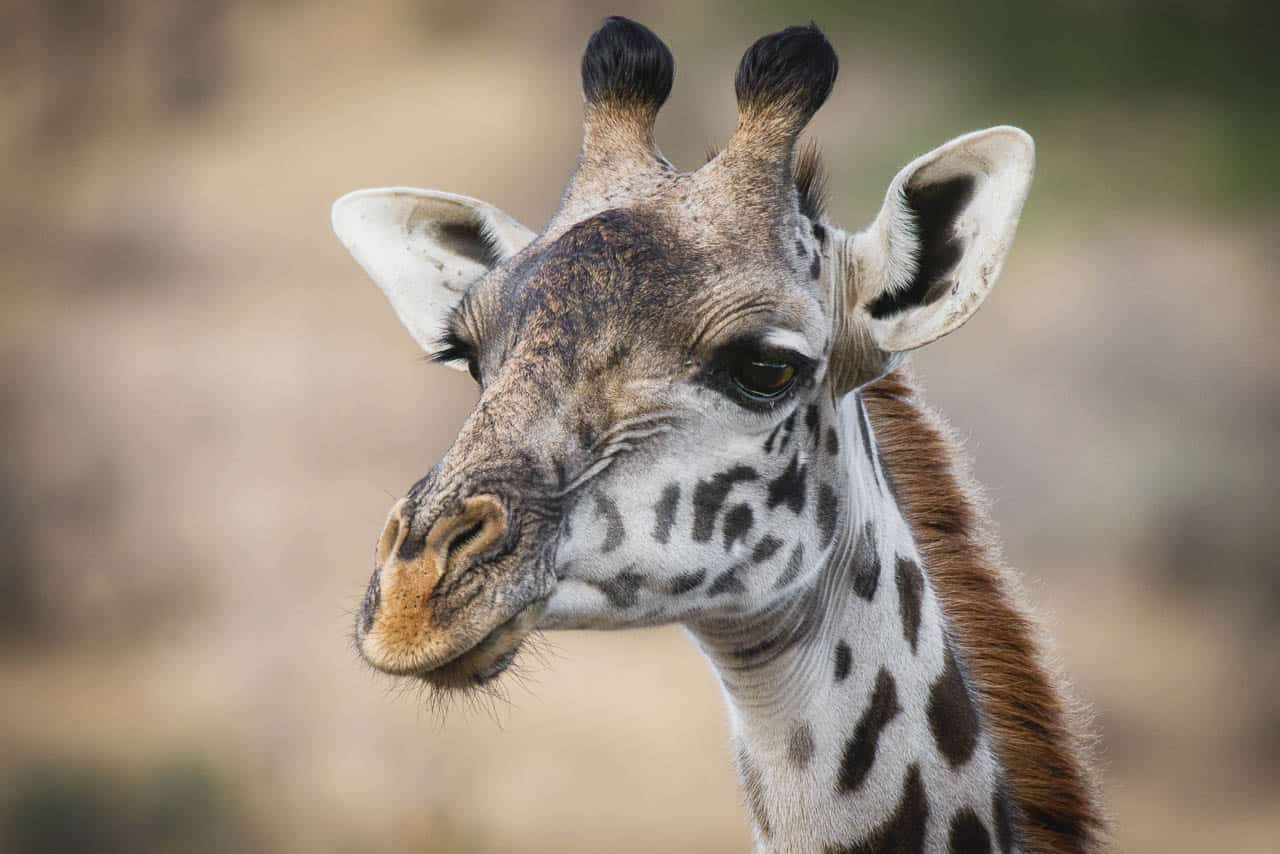
Giraffes have a strange mix of being beautiful and dopy looking at the same time. This captures the beauty of the giraffe.
A Lioness and Her Cubs
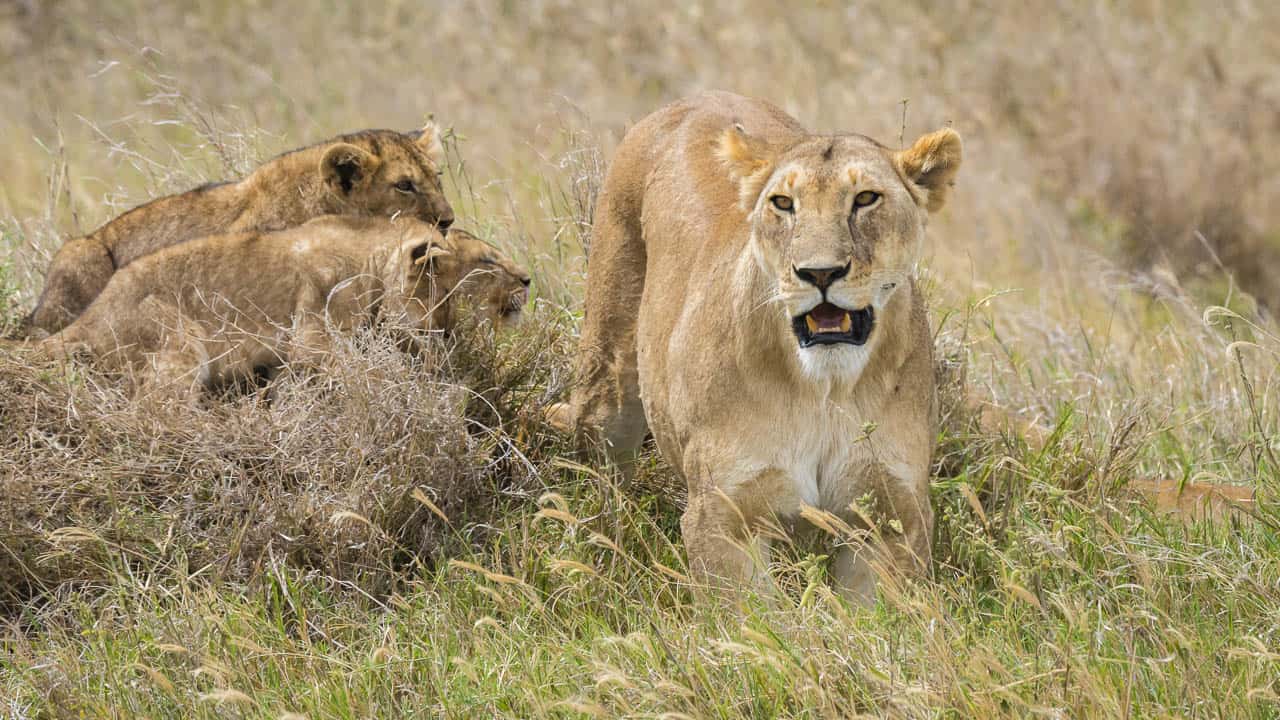
Being on an African safari in August lets you see all the cubs at their cutest. It seemed that every turn in the Serengeti found us at another squad of cubs with mother.
Watch our Safari Tips for Tanzania
Africa is close to our hearts and we were so excited to finally go on Safari in Tanzania. We’ve been fortunate enough to safari in Kenya, South Africa, and Botswana.
- On Safari in Tanzania
- The Maasai Tribe Visit – What it’s Really Like
- Kenya Safari – The Masai Mara Experience
- What to Wear on Safari
- Best Things to do in South Africa
Travel Planning Resources
Looking to book your next trip? Why not use these resources that are tried and tested by yours truly.
Book Your Flights: Start planning your trip by finding the best flight deals on Skyscanner. We have used them for years and have found that they have the best flight deals.
Book your Hotel: Find the best prices on hotels with these two providers. If you are located in Europe use Booking.com and if you are anywhere else use TripAdvisor.
Find Apartment Rentals: You will find the cheapest prices on apartment rentals with VRBO .
Travel Insurance: Don't leave home without it. Here is what we recommend:
- Safety Wing - Occasional Travelers.
- Medjet - Global air medical transport and travel security.
Book Your Activities: Looking for walking tours, skip-the-line tickets, private guides, and more? Then we recommend Get Your Guide.
Need more help planning your trip? Make sure to check out our Resources Page where we highlight all the great companies that we trust when we are traveling.
You May Also Like
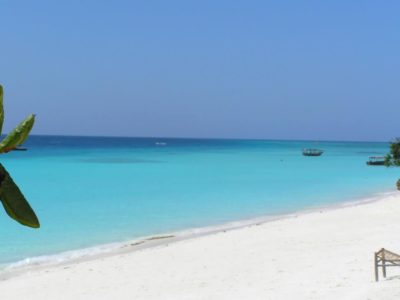
Discover The Best Beaches in Zanzibar
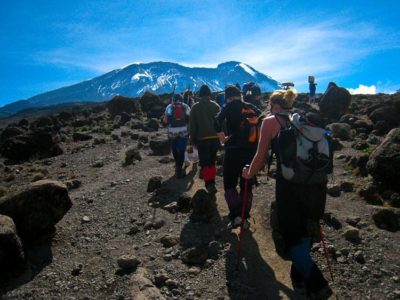
Complete Guide to Climbing Mount Kilimanjaro – How Hard is It?
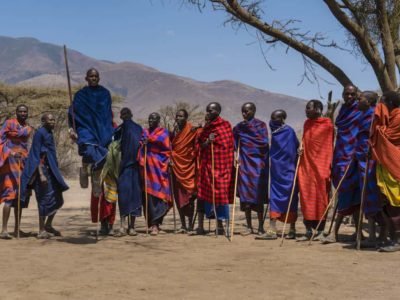
The Maasai Tribe: What a Visit is Really Like
About The Planet D
Dave Bouskill and Debra Corbeil are the owners and founders of The Planet D. After traveling to 115 countries, on all 7 continents over the past 13 years they have become one of the foremost experts in travel. Being recognized as top travel bloggers and influencers by the likes of Forbes Magazine , the Society of American Travel Writers and USA Today has allowed them to become leaders in their field.
Join thousands of others who get our monthly updates!
Leave a comment cancel reply.
Save my name, email, and website in this browser for the next time I comment.
10 thoughts on “African Animals – Incredible moments on Safari”
This is one of the best travel gallery I have ever seen. How I wish you could also visit my country Uganda and share such amazing wildlife photography. Very impressive!!
Tanzania is truly the East African wildlife capital if not African. The photos in this article says it all. The blog is also as amazing.
You’ve really captured the essence of an African safari in these photos. Really wonderful shots. I will never forget my safari in the Serengeti and Ngorongoro Crater a few years back. I even got to see a black rhino which was a highlight. It is one of those things that I could keep going back to do more and more and never get sick of it. It is an incredible thing to see these animals in the wild.
Wow. Such amazing photos. We visited the Ngorogoro Crater a while back and the diversity of animal wildlife was absolutely stunning. It’s also a quick hop over the border to Kenya where it’s Masai Mara territory. One of our favourite places to visit was a real Masai village. Stunning.
Superb pictures. Totally inspiring. We cannot wait to go to Tanzania (probably 2019). It is so good to see these amazing creatures thriving. Thanks for sharing.
Julie | 2checkingout
Wow…these animals seemed to leap right off of my screen and into my office. Thanks for showing these beautiful and amazing photos!
Excellent photos. Just as you have said, it makes me want to visit Tanzania! What a great nature, and what a great place!
I went gaga watching the pics in your Issyk Kul Lake post. Imagine my state right now… I am like – screw everything and fly to Tanzania. Stunning pics guys! Really drew me to the moment. The lion cubs playing with the alpha was the best one. Loved every pic. Cheers.
WOW, THESE IMAGES ARE STUNNING!! My husband and I are planning a safari trip next year to Africa with a Luxury Travel company called BerkeleyTravel.co.uk – I cannot wait to try and take some pictures like this. Thanks for making me realise there is hope yet!
These are beautifully captured… your photographs are so inspiring. Thank you for sharing them.
30 African Safari Animals You Need To See (With Pictures)

Africa’s natural beauty is unmatched, luring you to gaze at the passive stride of a lioness that you forget to breathe and marvel at a giraffe’s tripod bent to water.
The continent’s jungles, savannahs, forests, and other natural habitats contain mysteries that even a wise man cannot understand.
Therefore, seeing one-tenth of these African animals would bring about an incredible safari escapade.
It would be impossible to find all of Africa’s wildlife species, prompting us to compile a list of thirty African safari animals you need to see, including lions, elephants, zebras, and antelopes, among others.
Each animal we will consider has its scientific name, geographical range, conservation status, and photo highlighted, with a description that features the best places to find them.
So come along with us as we explore the beautiful world of these animals you can see on an African safari.
African Safari Animals You Should See
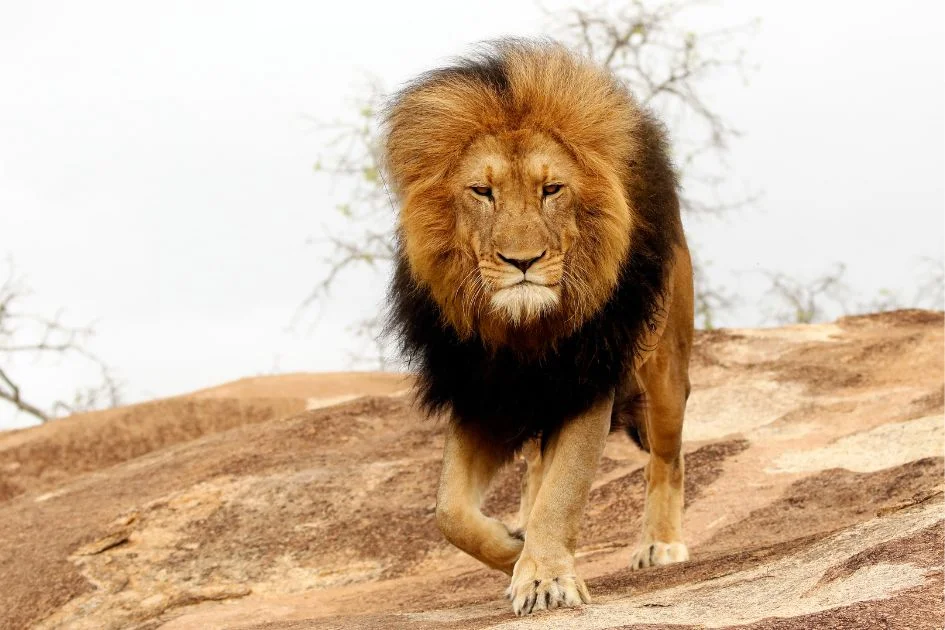
- Scientists Name: Panthera Leo
- Conservation Status: Vulnerable
Lions are endemic to Africa, occluding in savannahs, scrublands, grasslands, grassy plains, open woodlands with bushes, and bordering rivers.
Between 300 and 1,500 mm of annual rainfall, Savannahs constitute most African lion habitats.
Some populations reside in West African tropical moist forests and montane forests.
Sadly, Africa’s lion population has declined substantially by fifty percent in only twenty years. 1
However, one can still find lions in the Kgalagadi Transfrontier Park, South Africa, and Serengeti National Park, Tanzania.

- Scientific Name: Panthera pardus
- Conservation Status: Not Extinct
The leopard resides across sub-Saharan Africa and is aboriginal to many African nations.
These spotted cats inhabit the Cape Provinces of South Africa, Somalia, Ethiopia, and West Africa, occurring in mountainous forests, grasslands, and savannahs.
Leopards are among Africa’s “Big Five” safari, attracting many tourists; Zambia’s South Luangwa National Park and South Africa’s Sabi Sands Game Reserve are some of the most prominent leopard centers in the continent.
The Virunga National Park in the Democratic Republic of the Congo has recorded leopard sightings as the animals drink the park’s thermal waters.
3. Elephant
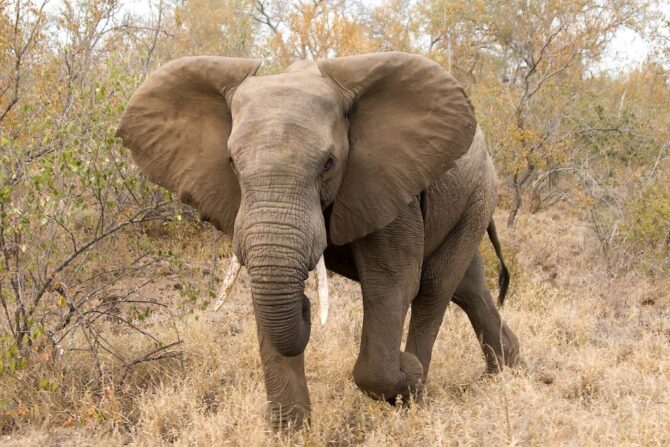
- Scientific Name: Loxodonta africana
- Conservation Status: Endangered
African elephants are considered endangered by the IUCN; still, they are indigenous to the continent, inhabiting the Sub-Saharan arid regions and Sahelian scrub.
They also reside in the continent’s jungles in tropical rainforests, mopane, and miombo woodlands.
African elephants primarily have populations in Central Africa.
Still, they exist in the Chobe National Park in Botswana, the Amboseli National Park in Kenya, East Africa, and the Hwange National Park in Zimbabwe, Southern Africa.
Also See: List of Animals with Big Heads (with Pictures)
4. Rhinoceros
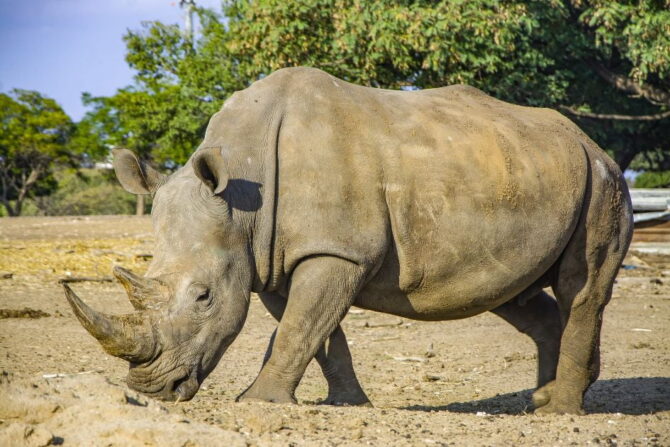
- Scientific Name: Rhinoceros
- Conservation Status: Critically Endangered
The black rhino species is endemic to Africa, living in its eastern and southern regions.
Rhino populations inhabited eleven countries, but most wild rhinos today, from the estimated six thousand, occupy only four countries — Zimbabwe, South Africa, Namibia, and Kenya.
They roam the open savannahs and grasslands and naturally exist in Etosha National Park, Namibia, Ziwa Rhino Sanctuary in Uganda, Nairobi National Park, Kenya, and Kruger South Africa.
Black rhinos have a size worthy of making them major African wildlife, growing up to 5.2 feet, and weighing 1,760 to 3,080 pounds.

- Scientific Name: Syncerus caffer
- Conservation Status: Near Threatened
Various species of the African buffalo occupy every part of the continent. The Cape buffalo inhabits Southern and East Africa, while the forest buffalo occurs in Central and West Africa.
These species are enormous, measuring up to 5.6 feet in shoulder height and weighing up to 1,900 lb.
They live in savannahs, swamps, mopane grasslands, and densely covered habitats.
Some wildlife parks include Masai Mara National Park in Kenya, Chobe National Park in Botswana, and Serengeti National Park in Tanzania.
6. Hartebeest
- Scientific Name: Alcelaphus buselaphus
- Conservation Status: Least Concern
The hartebeest is an antelope species native to the black continent.
It is a large-sized species with a prominent hump, a large chest, and a long face that distinguishes it from other antelope species.
Hartebeests are primarily grazers, with grasses making their menu, but they mostly occupy wooded grasslands, dry savannas, and open plains in Central, West, southern, and southeast Africa.
The hartebeest roams in their natural habitats in the Kruger and Bontebok National Parks in South Africa, Etosha National Park in Namibia, and Camp Linyanti in Botswana.

- Scientific name: Tragelaphus eurycerus
The bongo is another antelope species native to African jungles, with white-yellow stripes and black-and-white markings on its reddish-brown coat.
Bongos exist in tropical forest mosaics with dense undergrowth around West and Central Africa.
The Aberdare National park in Kenya is one major spot to find the bongo.
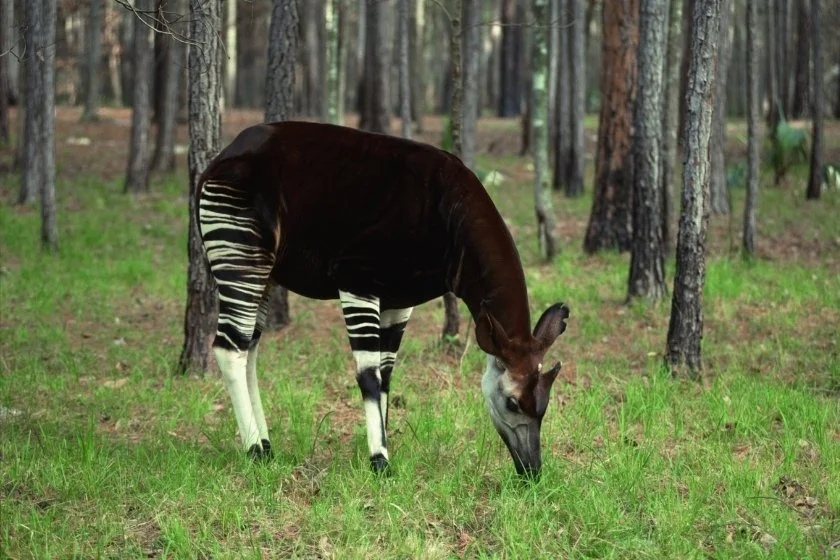
- Scientific name: Okapia johnstoni
- Conservation Status: Endangered
The okapi, a zebra look-alike, is the only extant member of the Giraffidae family along with the giraffe.
However, the okapi is not as tall as a giraffe, measuring only four feet and eleven inches.
It occupies canopy forests but is essentially solitary, with wildlife populations in the Okapi Wildlife Reserve, Ituri Rainforest, and Virunga National Park in the Democratic Republic of Congo.
9. African Wild Dog
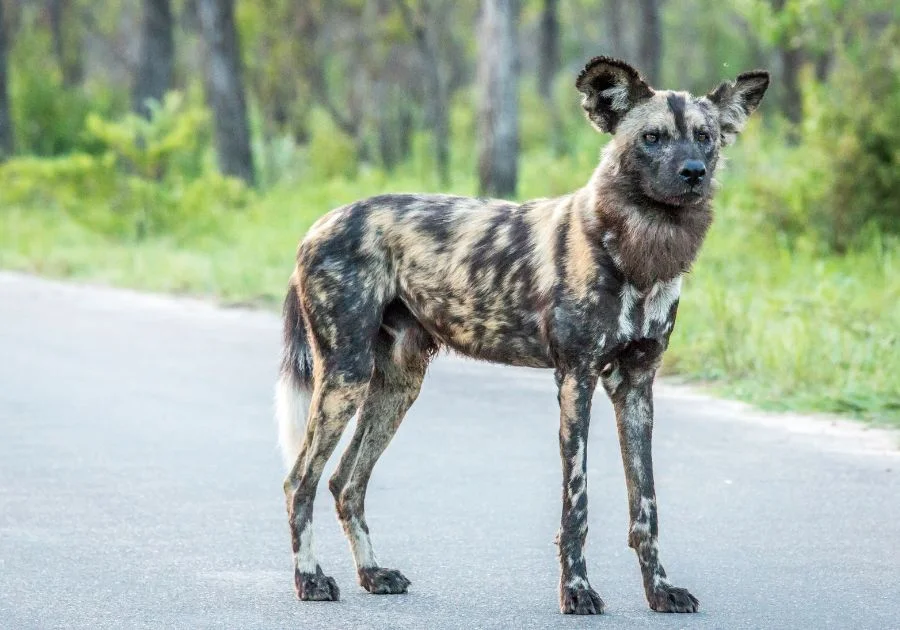
- Scientific Name: Lycaon pictus
The African wild dog is a threatened species now mostly located in the southeast of Africa, with only over 6,000 individuals left. 2
These wild dogs primarily inhabit Africa’s savannas and dry regions, preying mainly on antelopes.
African wild dogs have a strong sense of socialization to form packs of about thirty dogs.
The best places to find the African wild dog include woodlands, scrublands, and mountains, and they are open to the public in their natural habitats in:
- Madikwe Game Reserve in South Africa
- Mana Pools National Park in Zimbabwe
- Moremi Game Reserve in Botswana
- Selous Game Reserve in Tanzania
- South Luangwa National Park in Zambia
Also See: Different Types Of Wild Dogs (Species List With Pictures)
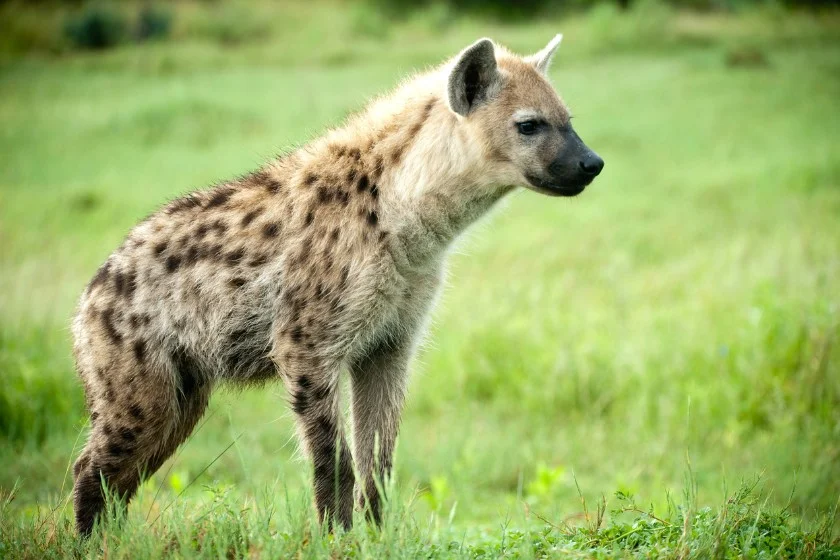
- Scientific Name: Hyaenidae
Hyenas occupy Africa’s savannas, sub-desserts, grasslands, forest edges, and woodlands and hold an apex position on the food chain.
Hyenas control prey populations and prevent the spread of diseases, primarily by consuming animal remains that could rot and cause diseases.
They have unparalleled bone-crushing abilities, helping them fight off potential competitors. 3
Hyenas may not be among the most beautiful animals, but they attract visitors around Kruger National Park and Pilanesberg National Park in South Africa.
11. Wildebeest
- Scientific Name: Connochaetes taurinus
The antelope’s imposing appearance is why the Afrikaans named it the wildebeest.
However, it is never too fearsome to the African wild cats, wild dogs, and hyenas that constantly prey on it.
Wildebeests are among the jungle animals in southern Africa that also occupy grassy plains and open woodlands that support their grazing routine in Angola, Botswana, South Africa, Mozambique, and Tanzania.
The Serengeti National Park in Tanzania and Masai Mara National Reserve in Kenya are some of the best places to watch the wildebeest.
12. Warthog
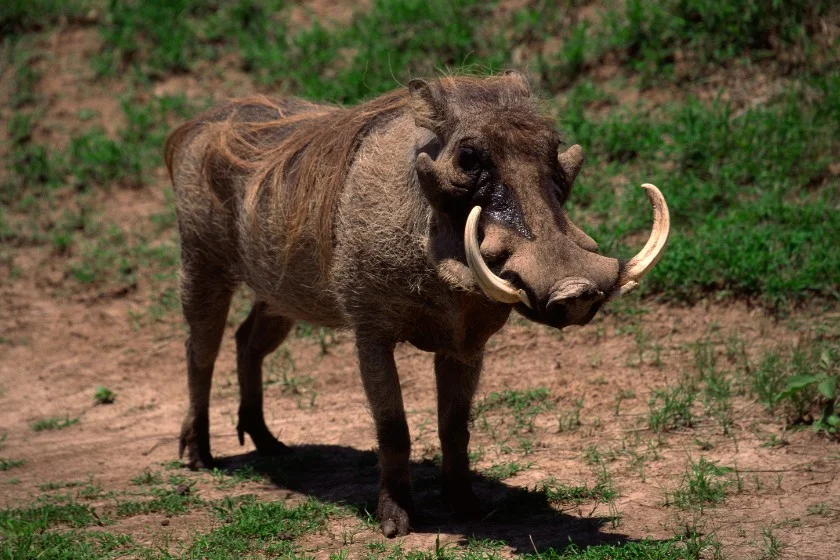
- Scientific Name: Phacochoerus africanus
The common warthog is a plump, hooved wild pig with little fur, a mane through the spine to the middle of its back, and upper tusks that protrude upwards from the mouth.
Warthogs, commonly called Pumba by many safari guides, are among Africa’s highly-watched safari animals.
They reside in grasslands, savannas, and woodlands in sub-Saharan Africa, across western, eastern, central, and southern Africa.
The Kruger National Park, South Africa, and Meru National Park, central Kenya, are famed for housing the warthog.
13. Vulture
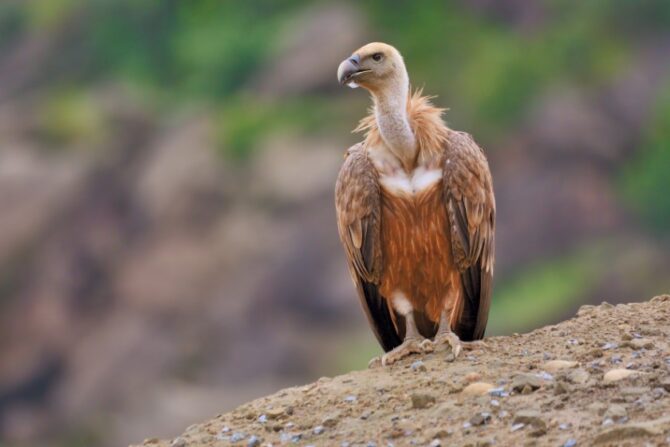
- Scientific Name: Accipitridae (Old World vultures); Cathartidae (New World vultures)
About eleven vulture species from the Accipitridae and Cathartidae families reside in Africa, popular among many as a scavenger and keystone species in most of the continent’s ecosystem.
Sadly, about seven of eleven African vulture species are critically endangered, with West Africa losing about ninety percent of the native White-backed vulture. 4
However, vultures spread across the black continent in west, north, east, central, and southern African cliffs and tall trees.
The Kruger National Park in South Africa and Comoé National Park have vultures, and one might be fortunate to find one while visiting.
Also See: African Birds: 30 Amazing Safari Bird Species, With Pictures
14. Marabou Stork
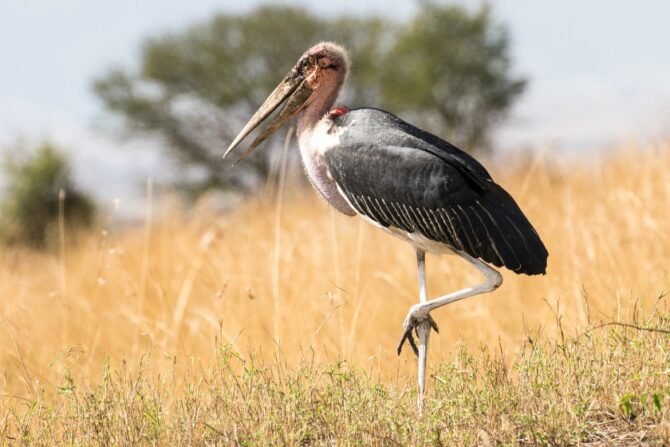
- Scientific Name: Leptoptilos crumenifer
While most storks are beautiful, the marabou stork has a reputation for horror due to its black cloak, large, fleshy pouch, and featherless features.
However, even the world’s most unattractive creatures attract large fanbases, explaining why the marabou stork ranks among Africa’s safari animals you should see.
Marabou storks are also large birds, reaching four feet, eleven inches in height, and 6.5 feet in wingspan length.
The IUCN ranks these birds as ‘Least Concern,’ with a stable population to support their evaluation.
Therefore, one can find the marabou stork in the west, east, central, and southern Africa.
One can find the marabou stork in Ben Lavin Nature Reserve and the African Bird of Prey Sanctuary in South Africa.
- Scientific name: Beatragus hunteri
The hirola is the world’s rarest antelope, native to Kenya and southwest Somalia.
White spectacles around its eyes, a white tail through to the hocks, and lyre-shaped horns are distinctive features that distinguish the hirola from other antelope species.
The hirola occupies parched environments with relatively low annual rainfall.
However, it is a primary grazer, enjoying grasses with more leaves than stems. Hirola populations exist in Tsavo East National Park, Kenya.
16. Giraffe
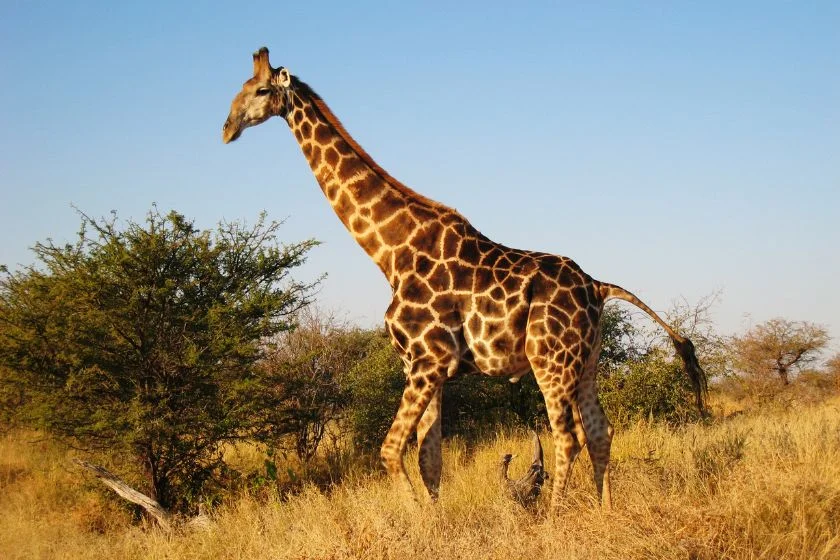
- Scientific Name: Giraffa camelopardalis
- Conservation Status: Vulnerable
Everyone wants to watch the world’s tallest living terrestrial and largest ruminant creature.
Giraffes occupy semi-arid savannah and savannah woodlands and are highly distinguished by their extremely long necks and legs.
Some best places to find the Giraffe in its natural habitat include:
- Africa’s Murchison Falls National Park in Uganda
- Etosha National Park in Namibia
- Serengeti National Park in Tanzania
- Maasai Mara National Reserve in Kenya
- Kruger National Park in South Africa
- Kouré in Niger
Also See: Amazing Long Neck Animals (List With Pictures)

- Scientific Name: Equus
Three zebra species reside in Africa, but the common zebra is the most popular. They all share black-and-white striped coats, but patterns are unique to each species.
The common zebra ( Equus quagga ) occupies much of southern and eastern Africa, the mountain zebra ( Equus zebra ) in southern Africa, and the Grévy’s zebra ( Equus grevyi ) in east Africa.
Zebras are herbivores and inhabit grasslands, savannahs, shrublands, woodlands, and mountainous areas.
The best places to find Zebras in their natural habitats include:
- Makgadikgadi Pans in Botswana
- Lewa Conservancy in Kenya
- Klein Karoo in South Africa
18. Hippopotamus

- Scientific name: Hippopotamus amphibius
Hippos are famed for their round and cute appearance and a fearsome reputation for being the world’s deadliest land mammal, killing an estimated 500 people annually in Africa.
They weigh up to 2,750kg, with large tusks and speeds reaching 30 km/h. Hippos are everywhere in the black continent, occurring in Central, Eastern, and Southern Africa.
The hippo’s history with man implies that encountering it in the wrong place might not end well.
However, the South Luangwa and Lower Zambezi National Parks in Zambia, Okavango Delta in Botswana, and Selous in Tanzania are among the best places to view the hippopotamus.
19. Common Ostrich

- Scientific Name: Struthio camelus
The common ostrich is the world’s largest and heaviest extant bird . However, such feats make the bird incapable of flight due to its immense weight.
However, the common ostrich makes up for its lack of light with speed, running up to forty-three kilometers per hour.
They are also impressive with using their long, powerful legs as defensive weapons.
A mature ostrich can grow to a height of nine feet and weigh up to 160 kilograms, a size worthy of ranking among African Safari animals one should see.
Many zoos feature ostriches in captivity, but the Kidepo Valley National Park in Uganda and the Kruger National Park in South Africa are nice places to find the common ostrich in their natural settings.
20. Shoebill
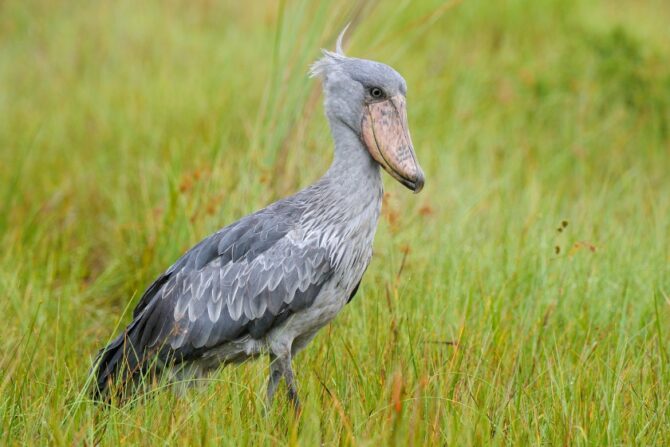
- Scientific Name: Balaeniceps rex
The bird’s large, striking shoe-shaped beak earns it the distinguished name. However, its enormous bill is just one of its features.
The shoebill is one of the world’s largest birds, growing up to four feet, eleven inches, thus becoming one of the five most captivating birds in Africa, according to birdwatchers.
The shoebill can be found in the Murchison Falls National Park in Uganda, Kasanka National Park in Zambia, and a few wildlife centers in the continent present views of shoebill storks.
21. Leopard Tortoise
- Scientific Name: Stigmochelys pardalis
The leopard tortoise is one of the smallest wildlife Africa’s safari offers. However, the leopard markings on its shell account for the most prominent feature.
The leopard tortoise has populations scattered across Africa’s semi-arid shrubland of the Sahara, from Sudan to the cape of South Africa.
The tortoise’s leopard markings are not its only distinctive feature, but its ability to swim is unique as it is the only Testudinidae with such an ability.
The Serengeti National Park in Tanzania and Mountain Zebra National Park in South Africa are wonderful destinations to find the leopard tortoise.
22. Meerkat
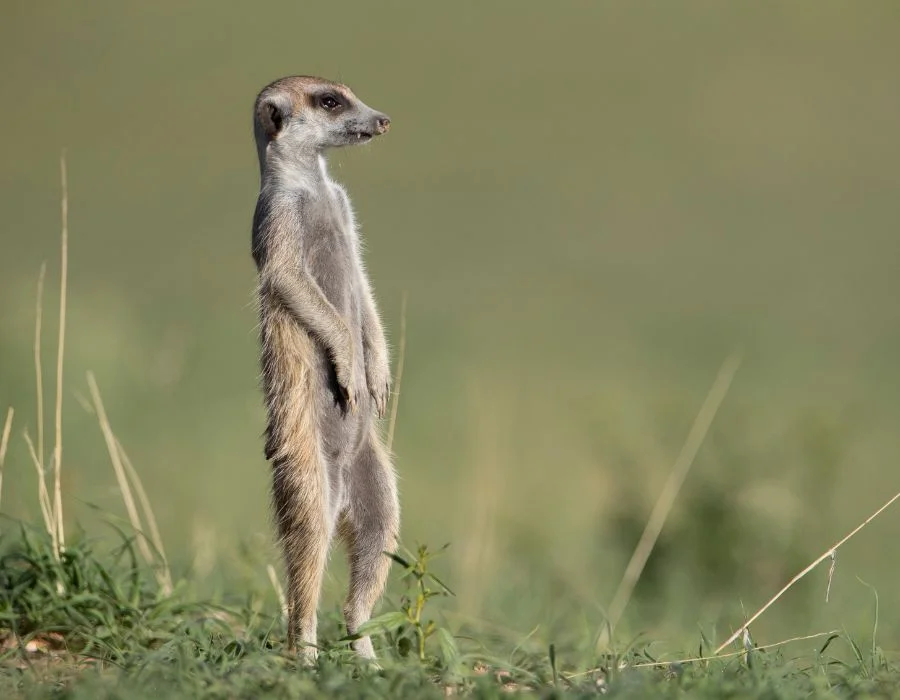
- Scientific Name: Suricata suricatta
Mongooses are popular for killing snakes, and here is the meerkat, an animal belonging to the same family — Herpestidae.
The meerkat is a small mongoose native to Southern Africa, inhabiting arid, open habitats containing little woody vegetation in Namibia, Botswana, and South Africa.
Mongooses have a distinctive banded pattern, big eye circles, thin tails, and sharp, curved foreclaws that support digging.
They dig burrows in the Kgalagadi Transfrontier Park and Tswalu Kalahari Reserve in South Africa.
- Scientific Name: Tragelaphus
- Conservation Status: Least Concern
The kudus are two large-sized antelope species found in East and Southern Africa.
The most distinctive feature differentiating both species is size, with the greater kudu measuring over five feet and the lesser kudu within the four-foot range.
They inhabit savanna near Acacia and Commiphora shrubs, relying on thickets for protection.
Therefore, these antelopes are found in the Addo Elephant National Park and Hluhluwe-Imfolozi Game Reserve in South Africa, Chobe National Park in Botswana, and Etosha National Park in Namibia.
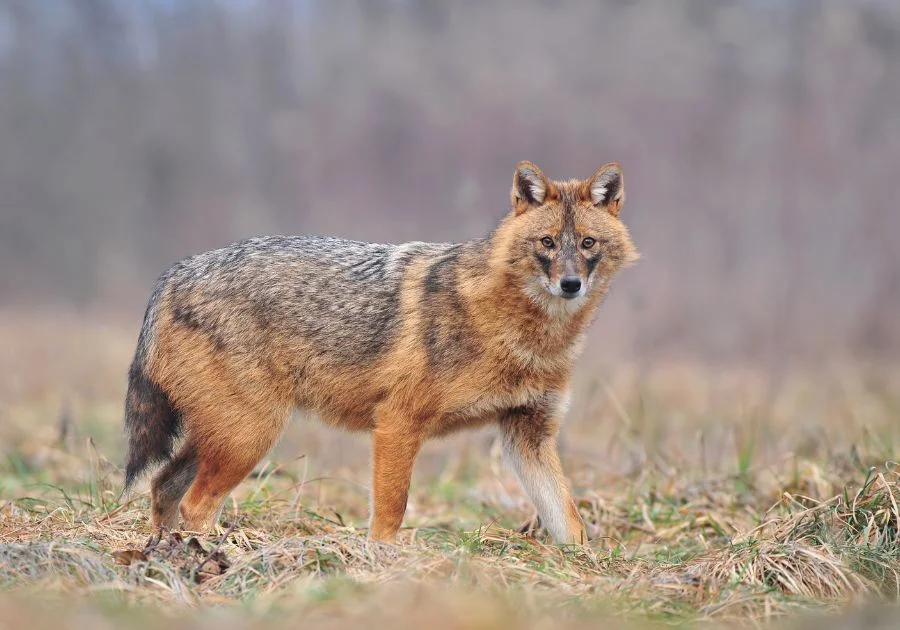
- Scientific Name: Canis aureus
Jackals are dog relatives of the genus Canis. Three jackal species exist — black-backed, golden, and side-striped, all occurring in different parts of Africa, especially the eastern and southern countries.
The black-backed jackal inhabits savannas and wooded areas; the golden jackal occupies dry environments, including deserts, open savannas, and arid grasslands.
The side-striped jackal lives in damp savannas, marshes, bushlands, and mountains.
Visiting the Kruger National Park, Shongweni Resources Reserve, and the wildlife parks offers the intriguing sights of jackals in South Africa.
The Tsavo West National Park in Kenya, Chobe National Park in Botswana, and Etosha National Park in Namibia are other nice places to find a jackal.
25. Cheetah
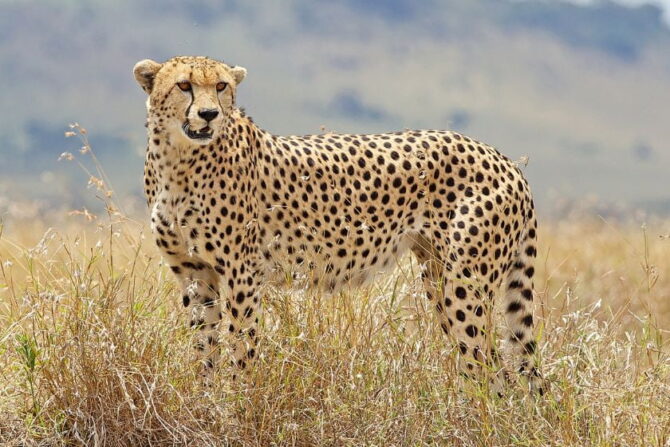
- Scientific Name: Acinonyx jubatus
Watching the world’s fastest land animal stalk its prey and initiate its signature high-speed chase is a dream sight to anyone willing to enjoy the untamed beauty of the African safari.
Therefore, some of the best places to watch a cheetah in your next safari escapade include:
- Okavango Delta in Botswana
- Phinda Private Game Reserve in South Africa
- Phinda Private Game Reserve in Tanzania
- Kidepo Valley National Park in Uganda
- Kafue National Park in Zambia
- Scientific Name: Aepyceros melampus
The Impala is one of the most elegant antelope species, featuring a graceful stride, plush, glossy, reddish brown coat, and slender, curved horns.
While you might love to admire them, it will be more thrilling to watch them jump clear of obstacles, leaping up to ten meters long and three meters high.
Such a sight lies in the Lake Mburo National Park and Katonga Wildlife Reserve in Uganda, Kruger National Park, Hluleka Nature Reserve in South Africa, and Masai Mara National Reserve in Kenya.
27. Waterbuck
- Scientific Name: Kobus ellipsiprymnus
It would help if You never get tired of seeing antelopes if you visit Africa for its safari.
The waterbuck is among the many antelope species you may find, especially if you cruise through Chobe National Park in Botswana, Serengeti National Park in Tanzania, Kruger National Park in South Africa, or Lake Nakuru National Park in Kenya.
Waterbucks are large, robust antelopes with reddish-brown to shaggy gray coats that become darker with age.
As the name suggests, the waterbuck depends on water, thus inhabiting areas close to water sources.
28. Kori Bustard
- Scientific Name: Ardeotis kori
- Conservation status: Near Threatened
Kori bustards are very large birds — the heaviest flying bird native to Africa. Male kori bustards weigh between seven and eighteen kilograms.
The male kori bustard’s wingspan ranges from seven feet seven inches to nine feet.
Even though they have large wings, they do not frequently fly unless necessary.
Therefore, there is much to admire in this feathered giant, bringing you to the Etosha National Park in Namibia and the Serengeti National Park in Tanzania, where it occupies sparsely wooded savannas and open grasslands.
29. Nile crocodile

- Scientific Name: Crocodylus niloticus
- Conservation status: Least Concern
Some insects and amphibians might be insignificant during a safari escapade, but not large reptiles and apex predators like the Nile crocodile.
The crocodile occupies various habitats, including rivers, lakes, and marshes, and earns a fearsome reputation for its size, fearlessness, and extremely powerful bite.
One can find the Nile crocodile in Serengeti National Park in Tanzania, Maasai Mara National Reserve in Kenya, the Okavango Delta in Botswana, and Murchison Falls National Park in Uganda, among others.
30. Grey-crowned Crane
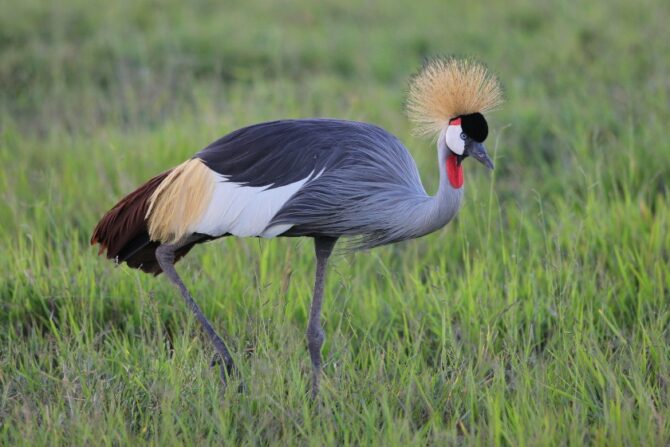
- Scientific Name: Balearica regulorum
- Conservation status: Endangered
The large, attractive bird, growing over three feet in height, with plush blueish-gray plumes and a golden crest, would be one of the most majestic creatures to see on one’s African safari.
The grey-crowned crane primarily inhabits dry savannas in Sub-Saharan Africa but could occur in cultivated areas and grassy flatlands in Kenya, Uganda, and South Africa.
The Amboseli and Lake Nakuru National Parks in Kenya and the Serengeti in Tanzania.
Also See: Beautiful Birds With Mohawks (With Pictures)
Frequently Asked Questions
What animals feature on africa’s top safari.
Africa’s safari features several animals, but lions, rhinos, leopards, elephants, and buffalos are the continent’s top-five safari animals.
Some of the world’s most popular animals, including zebras, cheetahs, giraffes, and antelopes, also feature on an African safari.
Would you see a tiger on an African safari?
While Africa is home to some of the world’s largest wild cats, including lions and cheetahs, it is very unlikely to find a tiger that is not in captivity in Africa.
However, one can find the tiger in a zoo or special reserve; the Laohu Valley Reserve, Tiger Canyon, Jugomaro Predator Park, and Pilanesberg National Park in South Africa are some places to find the world’s largest wild cat.
What is the most common animal on the safari?
The lion tops most people’s wishlists of animals to find on a safari. Without a doubt, it is one animal almost everyone coming on a safari would want to see, thanks to the beast’s title as the king of the jungle and the continent’s top carnivore.
What is the largest safari animal?
Lions, giraffes, hippos, and buffalos are in contention for Africa’s largest safari animals, but they do little to match the African bush elephant ( Loxodonta africana ).
The mammal can grow up to 13 feet and weigh almost 23,000 pounds, more than any other safari animal.
What African habitats support wildlife?
Most African habitats support wildlife, including savannas, rainforests, semi-deserts, wooded grasslands, deserts, and plains, because they have the perfect climate and terrains to support specific animals.
One might never get enough of Africa’s scenic terrains and the breathtaking explorations of its safari.
However, various challenges, including habitat degradation, human activities, and climate change, pose considerable threats to the survival of several African safari animals, driving some of these species to extinction.
Therefore, it will be more helpful for all to support conservation efforts to ensure the continuity of the continent’s beauty of undomesticated animals.
References & Notes
- Bauer H., Chapron G., et al. 2015. Lion (Panthera leo) populations are declining rapidly across Africa, except in intensively managed areas . PNAS.
- Alexis Valdes. 2018. Painted Ferocity: The Social Behaviors of African Wild Dogs, Threats to Survival, and Resulting Conservation Initiatives [pdf] . Liberty University.
- Binder W., Valkenburgh V. B. 2000. Development of bite strength and feeding behavior in juvenile spotted hyenas (Crocuta crocuta) . Journal of Zoology.
- White-backed Vulture Gyps africanus . BirdLife International.
Related Posts:
- African Birds: 30 Amazing Safari Bird Species, With Pictures
- 310+ Unique Monkey Names (Famous, Cute, Funny, Creative)
- Black And White Birds (30 Species, With Pictures)
- Types Of White Birds (30 Beautiful Species, With Pictures)
- 20 Most Beautiful Birds In The World & Where To Find Them
- Types Of Yellow Birds (31 Stunning Species, With Pictures)
About The Author
Jake Wilson
Related posts.

7 Interesting Animals in Jamaica
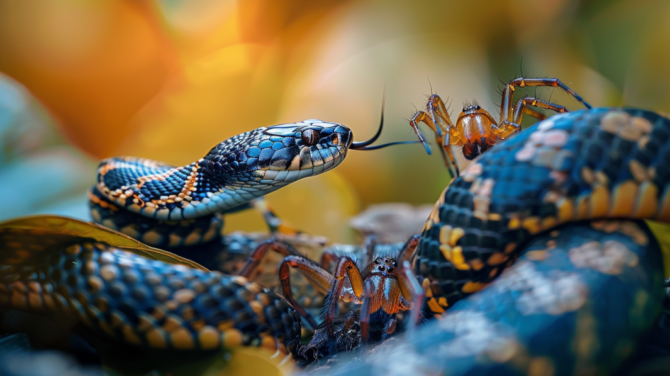
10 Common Dangerous Animals In Ohio

What Does A Black Wolf Symbolize?
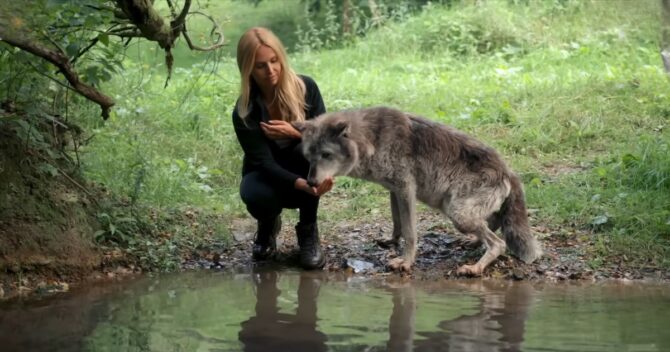
What Is A Female Wolf Called? – Unveiling Wolf Terminology and Behavior

A Guide To Animals That Are Not Mammals
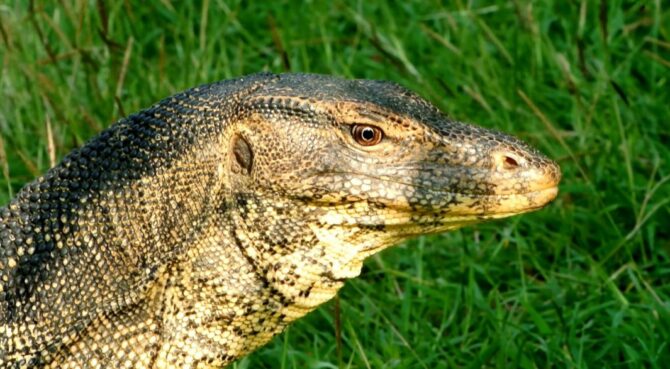
10 Common Dangerous Animals In Thailand You Need to Avoid
40 Safari Photography Tips For Stunning Wildlife Photos
Written by BELLA FALK
Contents (click to view)
So you’ve booked your dream African safari , and you’re ready to go!
I imagine you’re excited for the adventures, the landscapes, the amazing food and the friendly people, but mostly for all that incredible wildlife you’re going to see – and photograph.
But you don’t want to spend all that money and go all that way, only to come back with rubbish photos! You want to make the most of the opportunities that are about to unfold in front of you, and come home with stellar safari images to post on Instagram and put up on your wall.
If that’s why you’re here – you’ve come to the right place!
Welcome to my top 40 African safari photography tips , to help you bring home wildlife photos you’ll treasure for years to come.
About my safari photography experience
Hello! In case we haven’t met, I’m Bella, and I’m an award-winning travel and wildlife photographer .
I’ve photographed wildlife on all seven continents , from penguins in Antarctica to puffins in the UK and from whales in Sri Lanka to sloths in Costa Rica .
In 2020 I won Travel Photographer of the Year at the UK Travel Media Awards (and was a finalist in 2019 and 2023 too).
My wildlife images have been shortlisted five times in the world-famous Wildlife Photographer of the Year competition. I’ve written and photographed for National Geographic Traveller, BBC Wildlife Magazine and Travel Africa among others, and I’ve led workshops and written guides to travel photography and wildlife photography .
Read more: 60+ Awesome Antarctica Photography Tips
But most importantly, I love safari photography!
I’ve worked with safari companies in Botswana and Kenya to shoot images for national publications , and I’ve also photographed safaris in South Africa, Ghana, Tanzania and Uganda (where I lived for three months).
Throughout all of that I’ve learned a few things about how to make the most of your safari photography tour, and I’d like to share some of that knowledge with you now.
I’ve tried to write this for beginners and intermediate shooters so I’ve kept it fairly simple, but hopefully there are tips and inspiration in here for more advanced photographers as well.
Let’s get started!
Wildlife photography for beginners: some troubleshooting
If you’ve come here looking for Africa safari photography advice, that probably means you’re currently a bit dissatisfied with your wildlife photography.
So first up, I want to discuss some of the reasons why you might be finding your photos disappointing, and what you can do to deal with some of those issues.
The animals are too far away
If you’re annoyed because the wildlife in your photos appears too small, you need to get closer! You can do that in one of three ways:
- Ask your driver to move closer (if it’s possible without breaking any rules or disturbing the animal).
- Wait and hope the animal comes closer to you.
- Zoom in. If you’re already fully zoomed in, then you’re gonna need to buy a bigger lens or a better camera. You could also crop the image later, but how much you can get away with depends on the resolution of your camera.
The photos are blurry
Blurred images happen for one of three reasons:
- Camera shake. Use a faster shutter speed to counteract things like bumpy roads or shaky hands.
- The animal is moving too quickly. Again, you need a faster shutter speed to freeze the animal’s motion (unless you’re going for an artistic slow shutter speed effect).
- Your image is not in focus. Modern cameras have extremely advanced autofocussing systems but if you don’t know how to use yours properly, it can and will make bad decisions. Get properly acquainted with your camera’s focussing system, and practise using it!
The images are poor quality
If you’re not happy with the resolution or quality of the images your camera produces, I’m afraid the only answer is to buy a better camera!
But this doesn’t mean you need to splurge thousands on a top-of the range new camera. You can get great deals on older camera models second hand , and many of them are excellent.
I shot this image using a Canon 5D Mark II which you can buy today second hand from Wex , MPB.com or eBay for less than £200.
The lighting is bad: the image looks too harsh, too dark, or too flat
Most safari game drives take place in the early mornings and late afternoons which is when the animals are usually most active. Happily, this tends to also be the prettiest light for photography, but sometimes it can be quite dark. So in an ideal world you should also have a camera that can cope well in low light.
If the light is dull, flat or too harsh, there are still ways round it. Try changing the position of the car so the subject is backlit, or using a high- or low-key technique to exploit strong contrast.
Learning to edit your images will also make a huge difference: shoot in RAW and then try adjusting the exposure, highlights and shadows, or convert to black and white.
Safari photography tips: before you go
1/ choosing your camera.
Your trusty camera is your window into the wild, so pick the right tool for the job! While it is possible to take great safari images with a smartphone, unfortunately you will be very limited by what your phone camera can do.
If you really want to get those beautiful closeups and soft backgrounds, you’ll need a DSLR or a mirrorless camera with interchangeable lenses – or at the very least a compact camera with a good zoom lens.
You also need to consider factors like how much weight you’re prepared to carry, weather sealing (dust and rain resistance), image stabilisation, and how well it performs in low light.
In Tanzania and Uganda’s national parks I used my much-loved Canon 5D Mark IV ; for my recent trips to Botswana and Kenya I upgraded to a Canon R5 mirrorless which has a much faster focussing system with animal eye detection which is a total game changer for safari photography.
2/ Learn your camera
That said, there’s no point in splashing out thousands on a fancy camera if you don’t know how to use it. The best camera for safari photography is always the one you know well and are comfortable using.
So if you do splurge on a new camera, don’t be caught fumbling with settings when that perfect wildlife moment arises! Make sure you learn its functions beforehand, explore the menu, and practise using it so that it feels like second nature by the time you’re out in the bush.
I took my new R5 to London Zoo and London Wetland Centre before heading to Kenya , so that I could get it set up how I like it and get any teething troubles out of the way in a controlled environment.
3/ Master your camera’s focus
Modern cameras have extremely intelligent focussing systems that take much of the trial and error out of focussing – but you do need to know how to control them or they’ll take over and get things wrong!
It’s vital you learn how your camera’s focusing system works, get it set up in a way that works for you, and practise focusing on moving subjects.
Experiment with single-point autofocus for static subjects and continuous autofocus (or servo mode) for tracking moving animals. Don’t be afraid to manually focus for a critical shot, but I normally reserve that for when the subject is still and the autofocus can’t cope – such as a lion sitting amongst tall grasses.
Many newer cameras have fantastic animal eye detection AI but it doesn’t always work and you need to know how to take over quickly if it doesn’t want to play ball.
4/ Pick the right lenses
The lens you choose will dramatically impact the types of shots you can capture.
A telephoto lens (200 mm and above) is essential for bringing distant animals closer – and I’d recommend a minimum of 400 mm.
Consider a zoom lens for versatility, but a prime lens offers superior image quality at a fixed focal length. Don’t forget a wider lens (24-70mm range) for capturing landscapes and dramatic animal encounters at close range.
Prime lenses or lenses with a wide maximum aperture (f/4 and below) give you more of that lovely shallow depth of field and perform better in low light, but big prime lenses like the Canon RF 400mm f2.8 L are very large and eye-wateringly expensive!
Check out my guide to camera gear for wildlife photography in Antarctica – you can obviously ignore the cold weather and water sections but all the camera and lens advice is pretty much the same.
5/ Take a second body
It’s a luxury, but if you do have a second camera or a spare body, I recommend you bring it.
Animal encounters can change in the blink of an eye, and you don’t want to be rushing to change lenses when the lion suddenly comes right up to you, or when you want to switch between a close up and a wide shot showing the environment.
The African bush is also very dusty, so not having to change lenses while you’re out and about will help protect your gear.
I always take two cameras – one fitted with a long lens for close ups or animals that are far away, and one fitted with a wide lens for landscapes or if an elephant is right next to the car. A backup camera is also there should some misfortune befall your main camera.
If you don’t have a spare, why not buy an older model, cheap and second hand ? You can get great deals on pre-loved gear and having a second camera will definitely add more flexibility to your African safari photography.
6/ Protect your gear
If you’re going to take all that expensive gear to Africa and expose it to the dust, wind, sand and possibly rain, you’d better protect it!
Invest in a decent padded backpack , and a rain cover for when an unexpected downpour blows in through the side of your open vehicle. Make sure you bring plenty of lens cloths and a dust blower , and give your gear a wipe at the end of every day to keep it in top condition.
And don’t forget proper insurance! Most cameras are too expensive to be covered by your travel insurance policy, so check and get separate gear insurance or cover it under your home insurance policy instead.
7/ Shoot RAW and learn to edit
While RAW files take up more space and need post-processing, they capture more data than JPEGs and offer the flexibility to edit your images to bring out their best.
If you really want to take your wildlife photography to the next level, one of my top safari photography tips is to shoot RAW and learn some editing skills, to transform your images from good to great.
8/ Dress for success
Neutral-coloured clothing blends into the environment, making you less likely to spook the animals.
Opt for natural fabrics or sweat-wicking sportswear that breathes well in hot weather, and avoid bright colors and noisy clothing that might startle wildlife.
Read more about what to pack for safari here .
9/ Beanbag, tripod or monopod?
If you’re taking a large telephoto lens, you’ll need stabilisation. It’s hard to hold a heavy camera and lens for long periods at a time!
Some safari companies provide beanbags for you to rest on the window ledge or roof, while others have adapted their cars with padded arm rests to balance your camera on. So it’s worth asking before you travel.
I usually pack an empty photography beanbag , which I can then fill with beans or rice at the local market when I arrive.
A tripod or monopod can offer even greater stability but can be impractical if you want to change your angle in a hurry, or if you don’t have much space. However, if you have a monopod (and trust it!), you can also use it to lower your camera over the side of the car for eye-catching low-angle shots.
10/ Don’t forget spare cards and batteries
Running out of power or storage on safari is a recipe for disappointment!
Pack plenty of fully-charged batteries and enough memory cards – you’ll probably shoot way more than you usually do. Consider high-capacity, fast cards for capturing bursts of action, like birds in flight or a cheetah on the hunt.
Cards are expensive, so I bring just two, and then back up my photos daily onto a portable hard drive before reusing the cards the next day.
Find out more about my travel photography workflow here .

African safari photography tips: practicalities
Getting the best out of your safari photography begins before you leave the lodge – in fact, you could say it begins before you even get on the plane!
Here are some things to think about before you head out on your safari adventure:
11/ Ask about your vehicle
Not all safari vehicles are created equal. Before you book, find out what type of car you’ll be using. Will it be open sided; will it have a pop-up or a roll-back top?
Does everyone get a window seat, or will some people have to sit in the middle? Is there tiered seating and will you be able to get down low?
Ideally, you want a car with open sides and a pop-up or open roof for unobstructed views. At all costs avoid tour buses or normal-style jeeps with windows that don’t open fully.
I prefer to book with companies that offer smaller vehicles (maximum six people per car) and a guaranteed window seat. In an ideal world, you’ll be able to have an entire row to yourself, so you have a prime spot no matter which side the animal is on.
Knowing the vehicle will also help you choose the right accessories to bring: do you need a monopod or a beanbag? Will you have space to spread your gear out or will you need to bring a more compact setup?
12/ Consider a private car
For the ultimate in control and flexibility, a private safari vehicle might be better for you if you have the budget.
Not having to worry about what other people want to do, or compete for the best angles, allows you to tailor the itinerary to your photographic goals, spread yourself around the car, and get in the perfect position every time.
Looking for African safari tours? Search TourRadar for a huge selection from 5* operators
13/ Talk to your guide
Your guide is your key to unlocking the secrets of the bush – he or she is the person who’ll hopefully help you find your dream safari animals or get the shots you’re after.
What’s more, a good guide who understands light and angles is probably the number one most important thing you can have for safari photography. So before the trip or when you first arrive, I always tell the company I’m a photographer and ask to be assigned their best photography guide.
I noticed a huge difference in both Kenya and Botswana between the shots I got with a guide who really ‘got’ photography, and the ones who didn’t.
Chat to them before you head out on your first game drive. Let them know the wildlife you’re hoping to see and the shots you’d like to get, and they will do their best to help you.
When you’re out and about, don’t be afraid to ask if you want something. The guide won’t know what shot you have in mind, so if you want to stop, move on, nudge the car forward or back a little, get a little closer, or find a different angle, just ask. It might not always be possible or allowed, but they will do their best to help you if they can.
Remember though, that guides, while brilliant, are not miracle workers. If you’re desperate to see a leopard, they will use all their skills to help find one, but unfortunately the animals don’t perform on demand and sightings are never guaranteed.
14/ Don’t just talk, listen!
As well as communicating your needs effectively, it’s important to listen. Guides are a goldmine of information when it comes to animals – not only in general, but they will also know the habits of specific animals in their patch. Your guide will be able to tell you where and when you’ll have the best chance of seeing a certain species or where certain individuals like to hang out.
Once you’ve found the animal, the guides are experts at recognising behaviour cues and will be able to tell you if the lion is about to stretch or the hippo is about to yawn, so you can capture the money shot.
In Kenya, our guide Saruni anticipated that this lion would be thirsty after eating and would walk to this puddle to drink, so he positioned the car in the perfect spot and then all we had to do was wait for the lion to come to us.
15/ Get up early and stay out late
Lighting is crucial in photography. Early mornings and late afternoons offer the soft, golden light that creates stunning wildlife portraits, while midday sun can be harsh, creating strong contrast and deep shadows.
Typically, most safari itineraries include morning and afternoon game drives, as that is when the animals are most active. Make sure you’re ready to go – if you hit snooze or dawdle over breakfast, you’ll may miss the best moments.
Likewise, at the end of the day many safari companies offer ‘sundowner’ drinks and snacks – which is exactly when you want to be photographing. So I always let my guide know that I’d prefer to skip cocktail hour and keep shooting instead (which is much easier to do if you’re not sharing the car with non-photographers who don’t take kindly to this!).
Safari photography tips: framing and composition
16/ think about your composition.
Now you’ve sorted the practicalities, it’s time to think about the images you’re going to take. Don’t just snap what’s in front of you – instead, think about what you want to include or leave out, and where you want the main focal point to be.
You’re probably already familiar with the Rule of Thirds, where you imagine dividing the frame into thirds and then place your subject off-centre on one of those ‘third lines’ to create a more pleasing composition. Give it a go!
I explain more about the Rule of Thirds, as well as giving loads more general wildlife photography tips, in my Easy wildlife photography tips for beginners post.
17/ What’s in shot? Keep it simple.
Be mindful of what fills your frame. Where possible, try to avoid clutter and distracting elements like branches or leaves that obstruct your subject. If necessary, change position in the car or ask the driver to move back or forward a little to get a better angle.
Avoid photos with too many elements competing for attention. Where there are many animals together, try to isolate one to three individuals, or wait for the group to space out a little to create a clean composition.
There were many zebras at this waterhole at Leroo La Tau in Botswana but I focussed on just these three to create a simple composition
18/ What’s in the background?
A messy background can detract from your subject. Whether that’s tangled trees or random other animals, try to aim for clean backdrops that don’t distract.
If necessary, ask your driver to move the car, or wait for the animal to move into a better position.
19/ Focus on the eye
In wildlife photography, it’s generally accepted that you should always focus on the main animal’s eye. We want the viewer to connect with the subject, and we are naturally drawn to eyes, so if the eye isn’t in focus the viewer’s connection to the image may be lost.
There are exceptions of course, such as if the eye isn’t visible in the shot, or you’ve deliberately chosen something else to focus on, but as a general rule of thumb, you should always get at least one eye sharp.
20/ Wait for eye contact
Connected with this, notice how when the animal’s gaze is locked on you, it creates an extra dramatic connection.
Some safari animals are curious and will look right at you, so keep your camera poised and ready to click the shutter at that crucial moment when your subject looks right at your lens.
21/ Get low
Sitting in a car, with the animal on the ground, most of the time you’ll be looking down on your subject and the background will be the grass around it.
It’s not easy to do because most of the time it’s not safe to get out of the car, but if you can get down to the same level or lower than your subject so it’s framed against the sky instead, it makes for much more dramatic images.
You obviously can’t do this when there are predators around, but if you ask your guide, it may be possible if the animal is a herbivore, it’s far enough away and you stay close to the car. I shot these rhinos by staying safely behind the car, and lying on the ground so I could shoot underneath it.
22/ Shoot landscapes
Another top safari photography tip to remember is that going on safari isn’t just about the animals.
Don’t forget to capture the vastness and beauty of the African landscape, from the wide savanna grasslands, to lonely trees silhouetted against the sunset, to dramatic mountains on the horizon or reflections in lakes and wetlands.
23/ Include the environment for context
Show how your animal subject interacts with its environment. Did you spot a lioness stalking through tall grass or a solitary giraffe eating acacia? Close ups can be dramatic and beautiful but including context can tell a different story.
In Tsavo West, Kenya , I was amazed by the magnificent elephants which are often stained red or orange thanks to the landscape’s red dust. In this image I wanted to show how the elephants’ vivid colour stands out in the dry landscape and is mirrored by the orange dust bath just behind them.
24/ Shoot silhouettes
Sunrise and sunset are the most magical times for safari photography. And if you get dramatic colours in the sky, you can shoot sensational silhouettes.
Find a recognisable animal – giraffes and elephants are great for this – and then get down low (positioning your car a little downhill is ideal) so the animal’s shape is against the sky and you can see its legs.
Time the shot so all the legs and the tail are visible, and underexpose by a stop or two to bring out the sky and turn the animal into a dark silhouette.
25/ Use the beauty of backlighting
It’s tempting to always have the sun fully illuminating your subject from the front, but moving round to the other side so the animal is backlit often gives much more attractive results.
Low backlighting at the beginning and end of the day also illuminates grasses and creates a beautiful rim of light around your animal, highlighting the texture of its fur.
26/ Look up and around
Don’t forget to look skyward! Capture African birds soaring overhead, or giraffes munching on leaves from tall trees.
And don’t forget to look behind you too. While everyone is clicking away at resting lions, there might be some hyenas or a band of mongooses on the other side of the car.
27/ Include soft foreground elements
Frame your shot with interesting foreground elements like wildflowers, tall grasses, or branches, using a wide aperture and shallow depth of field to make them soft focus. This creates depth in your image and draws the viewer’s eye towards your subject.
This spoonbill standing by a lake was a pretty boring shot, until I moved behind the bush to create a natural frame around the bird.
28/ Include cars and people
As well as taking shots of the animals you see, don’t forget to include people too.
Sometimes lions, elephants and other wildlife comes extremely close to the vehicles, and you can’t get a clean shot. Embrace this and make a point of it! Shots of animals and people’s reaction to them being so close can give you dramatic images and great memories of your safari photography trip.
29/ Try high key and low key
Playing with your exposure and going for a minimalistic look can add a new dimension to your safari photos.
High key photography, emphasising bright whites and light colours, creates a clean feel, and can work well on overcast days when the sky is white. A great way to start practising with this is to find an animal against a white sky, and overexpose by a stop or two to blow out the sky and give an airy feel to the image.
Conversely, low key photography emphasises darker tones and deeper shadows, ideal for dramatic portraits. This works best if you have an animal lit by the sun against a darker background such as trees or rocks. Underexpose by 1-2 stops for that moody look.
I mainly shoot aperture priority, so the exposure compensation wheel is your friend here if you want to start experimenting.
30/ Use black and white to convey drama or texture
I love bright colours, but sometimes, stripping the colour away can be incredibly powerful.
Black and white photography can allow the textures and shapes of your subject to shine – and works especially well with patterned animals like zebras, leopards or giraffes.
Converting your image to black and white is also great for giving a boost to flat images shot on cloudy days or in disappointing light.
31/ Don’t ignore the little guys
While everyone wants jaw-dropping shots of lions and cheetahs, don’t ignore the less celebrity animals.
Some antelopes have wonderful character and colours, and if you look at your feet you may spot a colourful lizard or a fascinating dung beetle. So keep your eyes open!
32/ Look for natural framing
Trees, leaves, or even the bodies of other animals can create great natural frames which add interest to your composition.
In the image of silver-backed jackal pups below, I deliberately cropped the shot so the body of the standing puppy makes a natural frame around its siblings
33/ Try an unusual crop
You don’t always need to include the whole of the animal. If your zoom allows, why not crop in to draw the attention to details or a single individual amongst a herd.
I’ve cropped this image so you only see the eye and mouth of the mother crocodile, but it draws attention to the two babies sitting on her head.
34/ Be creative
Try to think outside the box with your images. What can you shoot that tells a story in an creative way but isn’t a basic portrait of an animal?
Perhaps a lone elephant casts a long shadow as the sun dips below the horizon. Or look for reflections in watering holes – the mirrored image can add an artistic touch.
Buy my safari prints
Did you know that all my images are available to buy as prints to hang on your wall? And if you head to my Print Store and something you like is not there, you can simply message me via the contact form or on social media and I can add it for you.
Safari photography tips: some tricks and techniques
35/ aperture or shutter priority, or manual.
Some photographers like to make you think that if you’re not always shooting full manual, you’re just an amateur. Well I’m here to tell you that’s rubbish, so don’t worry.
Yes, you do need to get away from full auto, because although auto can be helpful and gets some things right, it often gets things wrong too.
But the ‘semi-auto’ modes, where you tell the camera your priorities and it calculates the rest, are ideal for wildlife photography. Things happen quickly and unexpectedly on safari, and there simply isn’t time for you to be fiddling with all the settings.
Looking for Africa photography safaris? Check out these photo safaris to fin d your dream trip
I pretty much always use Aperture Priority (AV) mode with my aperture fully wide open for lovely soft depth of field, while keeping an eye on my shutter speed to make sure it’s not too slow for fast-moving animals.
I keep my ISO on manual as well, to avoid the camera pushing it right up and giving me noisy images.
You could also use Shutter Priority (TV) mode to make sure your shutter is fast enough to freeze the action, but then you don’t have any control over the depth of field you want.
36/ Auto focus or manual focus?
Manual focus can definitely be useful at times, but in general I always use auto focus. Cameras have extremely complex and clever auto focussing systems, so why wouldn’t you use it!
You do need to understand your focussing system and know how to control it, otherwise the camera may choose to focus on the wrong thing. I use a single spot which I either point at the subject and then reframe to take the shot, or I move the spot around the frame. For fast-moving animals, the animal eye detection AI is really very good, but not always perfect.
For more on how I set up my camera for wildlife photography, check out Using The Canon R5 For Wildlife Photography: A Full Review .
37/ Use burst mode to freeze action
The animal kingdom is unpredictable, and perfect photo opportunities can happen in a flash.
Today’s DSLRs and mirrorless cameras – and even smartphones – can now shoot many frames per second, allowing you to capture a rapid sequence of images and increasing your chances of getting that razor-sharp shot of a lion leaping or a gazelle mid-air.
Later, you can sort through the burst and select the image with the perfect composition and action frozen in time.
I used a high-speed burst to take a sequence of images of this leopard snapping a flies so that I could pick the facial expression I liked best (on the right).
38/ Or experiment with slower shutter speeds
Safari photography is all about capturing movement and it can be tempting to go for the fastest shutter speeds possible to freeze the action.
Why not try using a slower shutter speed and either panning or zooming at the same time, to create a sense of motion and a very different look?
I used a slow shutter speed of 0.3 seconds and turned the zoom as I took the photo to create this impressionistic images of a lion in Botswana.
39/ Be patient
Animals move on their own schedule, and if you get bored too quickly, you may miss that dream moment. In fact, some of my best shots have happened after all the other cars have got bored and left, while we waited and were rewarded for our patience.
So embrace the waiting game! Enjoy the scenery, listen to the sounds of the savannah, but always be ready to shoot quickly when that leopard finally comes down from the tree or the sleeping lion gets up and goes on the hunt.
Click here to start planning your dream photo safari adventure!
40/ Be a team player
Sharing a vehicle means compromising sometimes. If another guest has a dream shot, or there’s only one good angle on the animal, be flexible and allow them some space, and they should do the same for you.
The same goes for your car as a whole. Don’t be that guy who parks in front or hogs the best spot for hours. You may not get every shot, but life is better when people are considerate of others too – and it’s better for the animals if they’re not being harassed by jostling cars.
Communication and courtesy go a long way in ensuring everyone gets a chance to capture unforgettable moments and has a great time in the process.
And that’s it! I hope you enjoyed all these tips for safari photography.
My favourite travel tools and brands
To help you organise your trip, here’s a short list of some of the brands and tools I use over and over again when I’m planning my travels. You can see more on my Travel Resources page.
- Booking.com : A huge range of hotels to choose from, often with free cancellation. If you book hotels regularly you can earn discounts. I’m on Genius Level 3 which gets me 20% off!
- Expedia : Another great place to find hotels and Expedia also sell flights , car hire, and loads more all in one place.
- Skyscanner : The only place I ever go to search for flights and compare prices.
- Flight Centre : Booking a more complicated route? Let Flight Centre organise it for you (and deal with the drama when something goes wrong).
- Priority Pass: I love having access to 1,400+ airport lounges when I fly, allowing me to enjoy my time at the airport. With my link you get 30% off a standard membership or 20% off standard plus.
- Airalo: Say goodbye to ridiculous mobile roaming charges. Did you know you can now buy an e-SIM , install it in your phone before you leave home, and then use data abroad at local prices? Game changer.
- TourRadar: If you prefer group travel and organised tours, TourRadar has a huge range of fantastic tours from respected operators. They’re very helpful and have 4.5 stars on TrustPilot.
- Viator: Part of the TripAdvisor brand, Viator is another great place to search for group adventures and day trips.
- GetYourGuide: A great place to find local tours and day trips in your destination.
- Wex Photo Video: The UK’s best camera gear store. Quote my name – Bella Falk – to get £20 off your first purchase.
- Ellis Brigham: Looking for good quality backpacks, travel clothes and other gear? Ellis Brigham is where I buy almost all of mine.
- Rentalcars.com: Part of the Booking.com family and the world’s largest online car rental service, with 24/7 customer service.
- World Nomads Travel Insurance: I never ever travel without travel insurance and nor should you!
Where to next?
If you liked this safari photography tips post, why not try some of my other safari posts?
- A Kenya Safari Holiday: How To Plan The Perfect Trip For You
- Which Is The Best Botswana Safari Lodge? My Favourites With Photos
- Kenya Vs Tanzania: Travel Experts Decide
- 28 Brilliant Things To Do In Uganda
- 46 Amazing African Safari Animals – A Photo Guide
- What To Wear On Safari: My Detailed Safari Packing List With Photos
- My Camera Equipment List: What’s In My Gear Bag?
- Is Cardamom House In Vipingo The Best Beach Hotel In Kenya?
Liked this safari photography tips post?
Social shares help support my hard work! You can share via the buttons at the bottom, or pin this handy Pinterest Pin. Thank you!
Cyprus in Spring: 10 Reasons Why It’s The Best Time To Visit
Jasper in fall: 10 reasons autumn is the best time to visit.
Some of the links on this site are affiliate links. This means that if you click through and make a purchase, I will earn a small commission at no additional cost to you. Passport & Pixels is a participant in the Amazon Services LLC Associates Program. As an Amazon Associate I earn from qualifying purchases.
© 2024 Passport & Pixels. All Rights Reserved.
WORK WITH ME

21 Safari Photography Tips for Capturing Stunning Safari Photos
As a passionate ethical wildlife photographer and qualified safari guide, I've gathered some valuable safari photography tips to help you elevate your safari experience. Even if you've never held a professional camera, you can still capture the raw beauty of the wild with just a few tips and tricks.
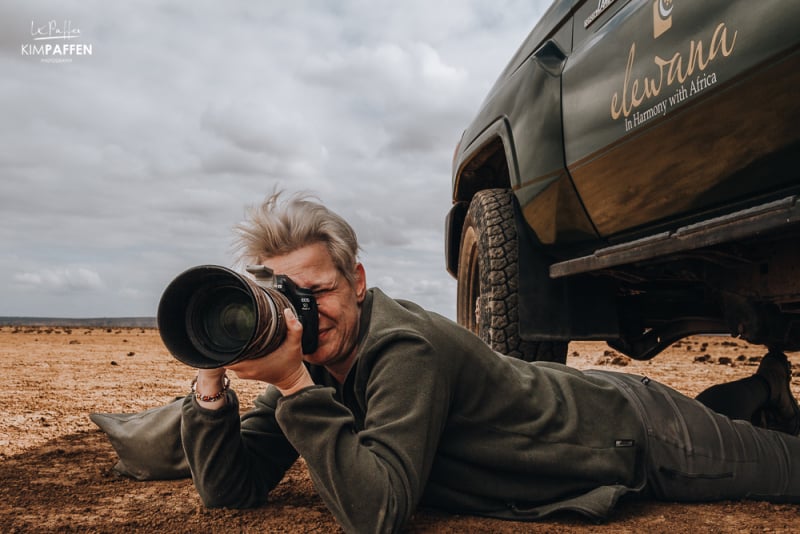
Embarking on a safari in Africa is a magical journey, and capturing these moments through photography allows you to relive the excitement and share the beauty of the African wilderness with others. Photography on safari also encourages you to pay attention to other things that might have gone unnoticed. By actively seeking unique angles and observing moments to capture, you become more attuned to the intricate details of the wildlife and the breathtaking landscapes surrounding you. It helps you notice small details and appreciate nature even more.
Read my 21 safari photography tips for capturing stunning safari photos :
1. Immerse Yourself in the Experience
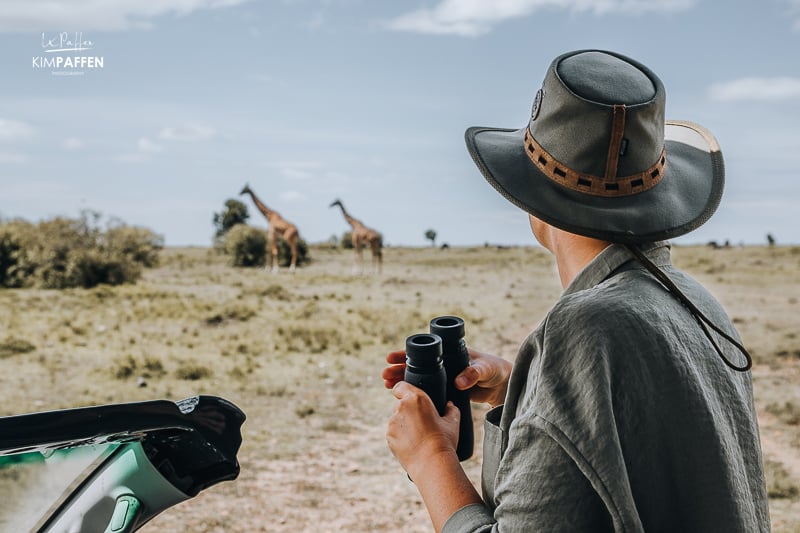
Each day on safari brings unique moments. Photography not only preserves memories but also encourages you to notice intricate details and appreciate nature. Seek unique angles and moments to capture, and let the beauty of the wild inspire you.
2. Be mindful of the Environment and Respect Wildlife
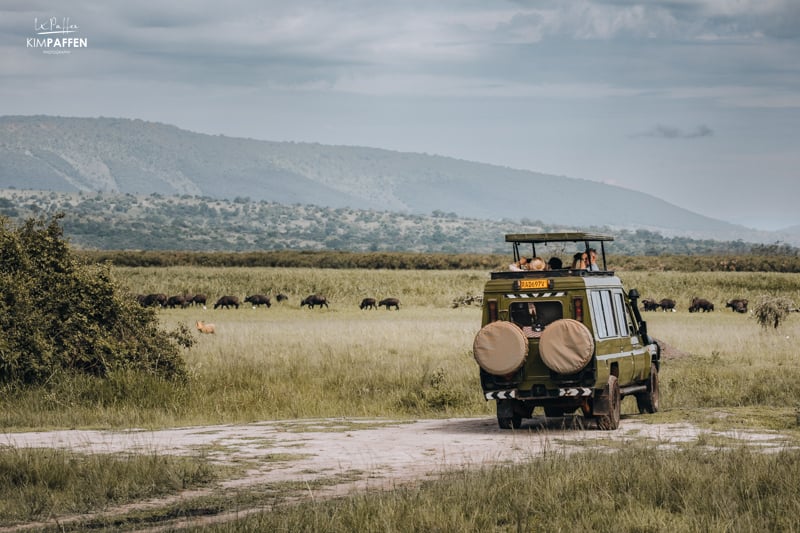
Patience is key to capturing natural behavior. Maintain a respectful distance, observe quietly, and avoid disrupting the animals' natural rhythm. Remember, you are a guest in their home and therefore this is one of the most important wildlife photography tips . Always respect local regulations, cultures, and environments. Your patience will be reflected in the authenticity of your safari photos.
If you approach an animal sighting, always be careful to not disturb the animal and minimize noise. How to show respect for the animals during wildlife photography?
- Maintain a respectful distance
- Approach animals indirectly
- Avoid positioning yourself upwind from the animal
- Keep your voice extremely low
- Switch your camera to silent mode to avoid startling wildlife
- Don’t use your flash
Whether you're a beginner or an experienced photographer, adhering to a code of conduct ensures the well-being of wildlife, contributes to conservation efforts, and ensures a more authentic safari experience.
3. Utilize Your Guide's Knowledge
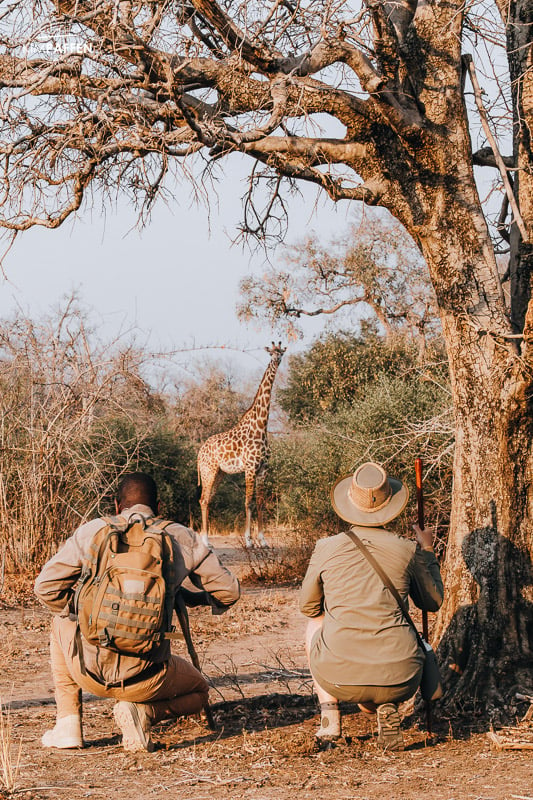
Collaborate with your local field guide who possesses invaluable knowledge of animal habits, territories, and behavior. Communicate your photography preferences, and leverage their expertise to position yourself for the perfect shot. Guides can anticipate lighting conditions and animal movements, enhancing your photography experience. For example, positioning the vehicle in a way that the sun is in your back instead of in your lens to have nice lighting on the animal or landscape you want to capture. However, on some occasions, it’s also great to photograph towards the sun to create a nice rim light around the animal.
As a nature and wildlife enthusiast, I encourage you to ask your safari guide lots of questions to learn more about the behavior and habitats of the wildlife you encounter. This knowledge helps you anticipate movements and position yourself for the perfect shot.
4. Pay Attention to Composition
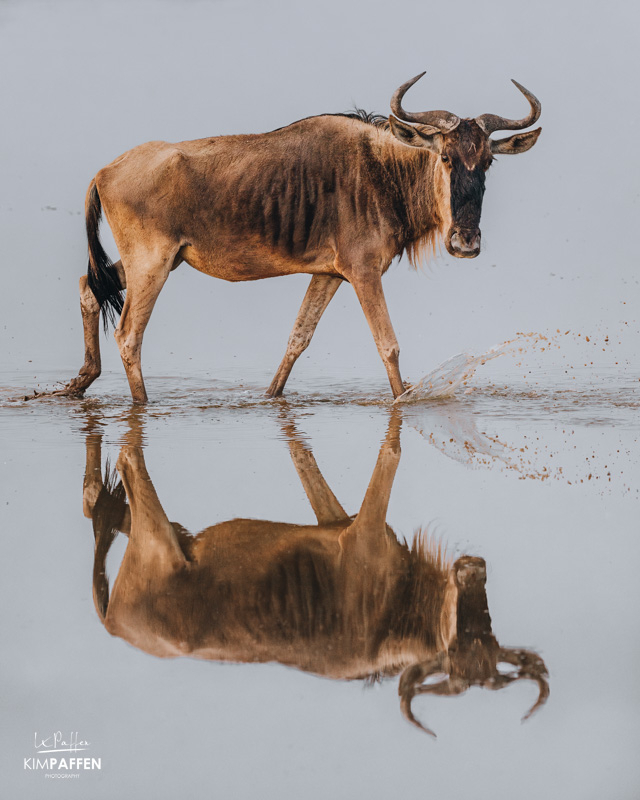
Crafting attractive compositions on safari is key to impactful photography. Be creative. Explore angles, perspectives, and framing techniques to create visually appealing images.
Rule of Thirds
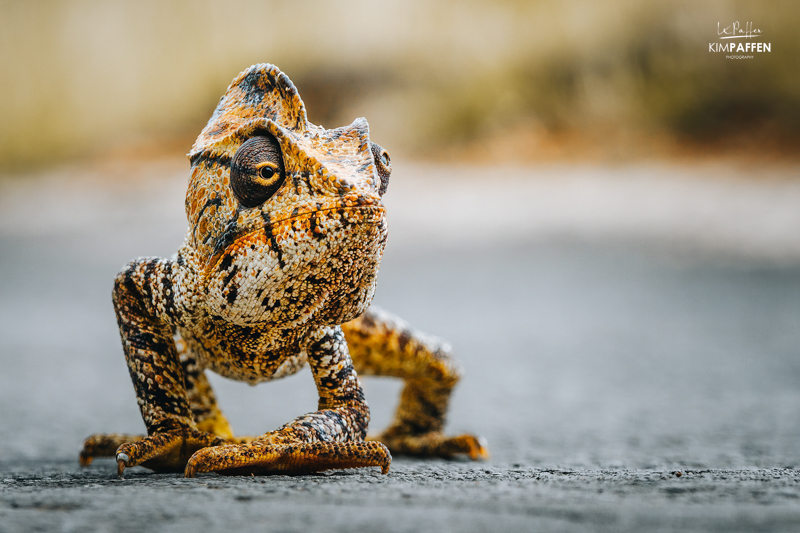
Apply the rule of thirds by placing your subject off-center for dynamic images. Utilize paths, tracks, or natural elements like bushes, rocks or trees for depth and scale. These composition tips elevate your photos without requiring advanced technical skills. Most cameras also have a grid that helps you to better frame your subject. Also, always think of leaving an empty space in the direction the wildlife is heading or the direction the animal is looking. In some occasions, it's also a good idea to put your subject in the middle.
Shoot from a low angle
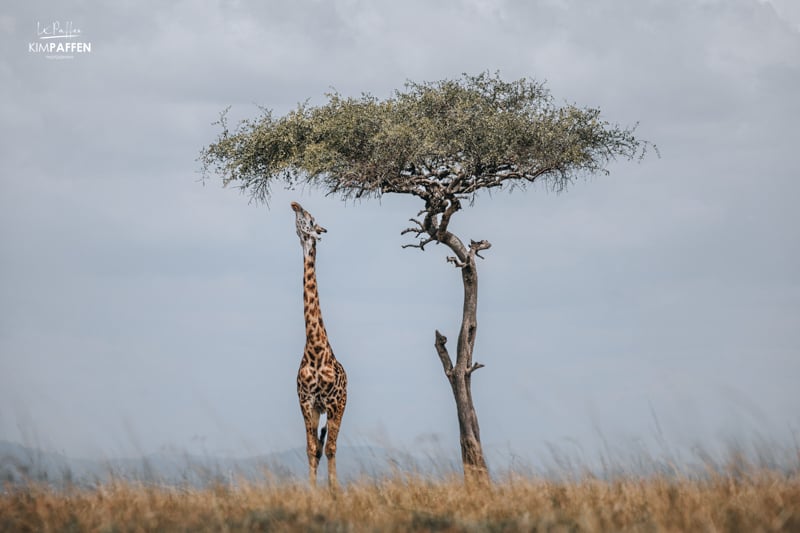
Shooting from a low angle (on the ground) can also make your composition more attractive. Safari in a game drive vehicle mostly doesn’t allow you to get out of the car to photograph wildlife, but on some occasions it might be possible. Another occasion could be if you’re on a walking safari . The advantage of getting low on the ground is that you are able to change the background in your scene. Being on eye-level with your animal also establishes a better connection.
Please consider the ethics of your framing – prioritize the well-being of the wildlife you encounter.
5. Show animals in their natural environment
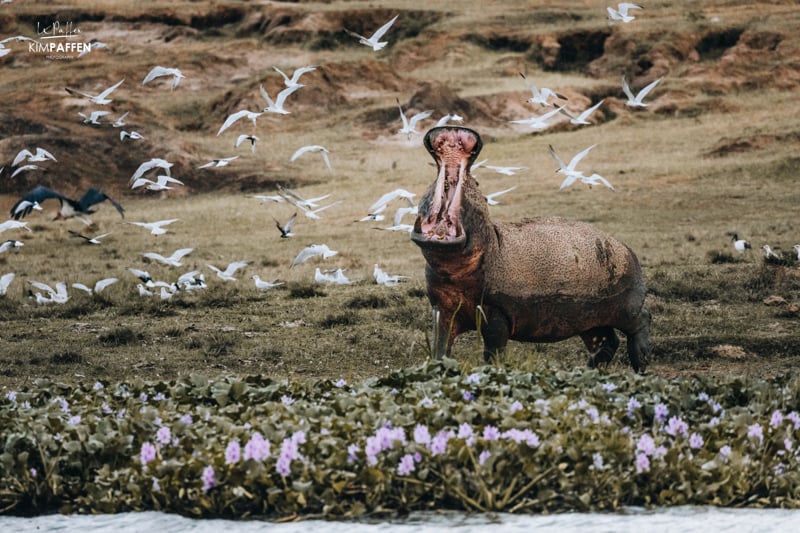
Capturing close-ups of the Big Five is often popular among safari tourists, and wildlife photographers, but don’t forget the beautiful environment these animals live in.
Their natural environment is equally important as they form that bigger picture together. And it’s those areas that we need to protect to save wildlife from extinction.
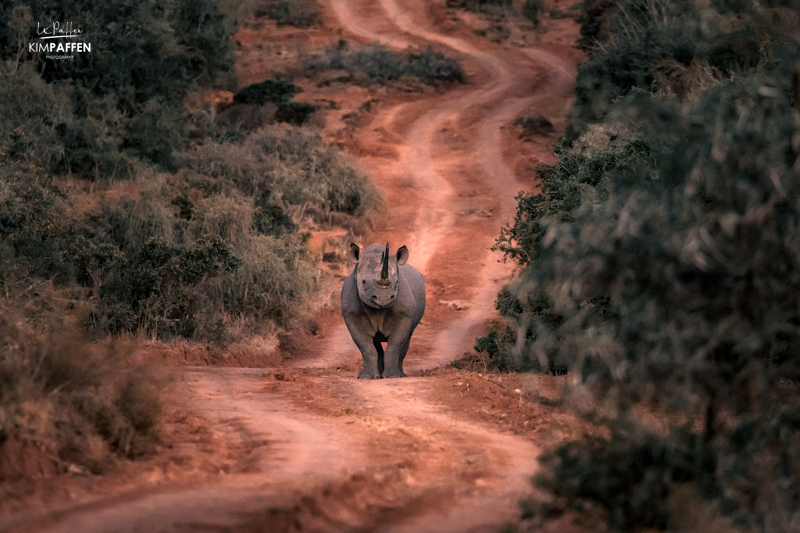
Every part of the ecosystem is dependent on each other. That’s the beauty of nature, and it allows the viewer to understand where the animal lives and flourishes. As a conservation photographer, I also love to showcase the wildlife’s home that we need to protect.
6. Master the Exposure Triangle
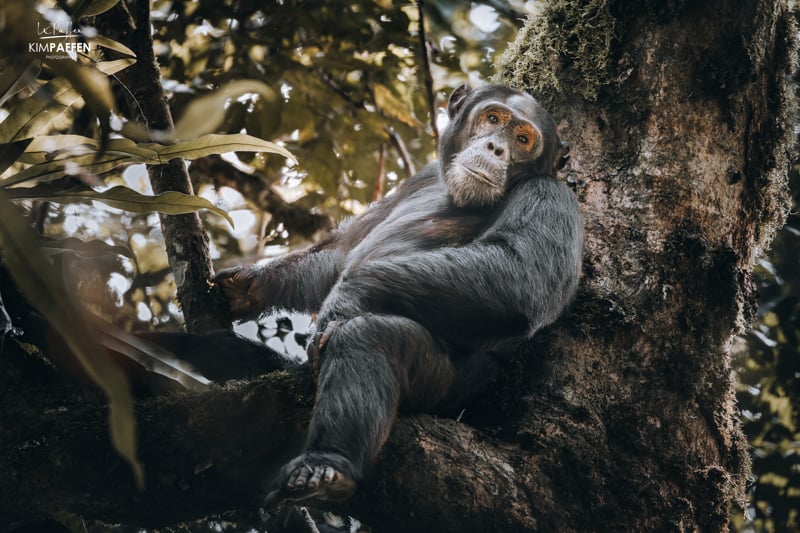
Light is a fundamental element in photography, and understanding the exposure triangle is a fundamental part to master the art of safari photography. Understanding aperture , shutter speed , and ISO allows you to adapt to various lighting conditions. These three factors work together to determine how bright or dark your photos will turn out, as well as the level of sharpness and graininess.
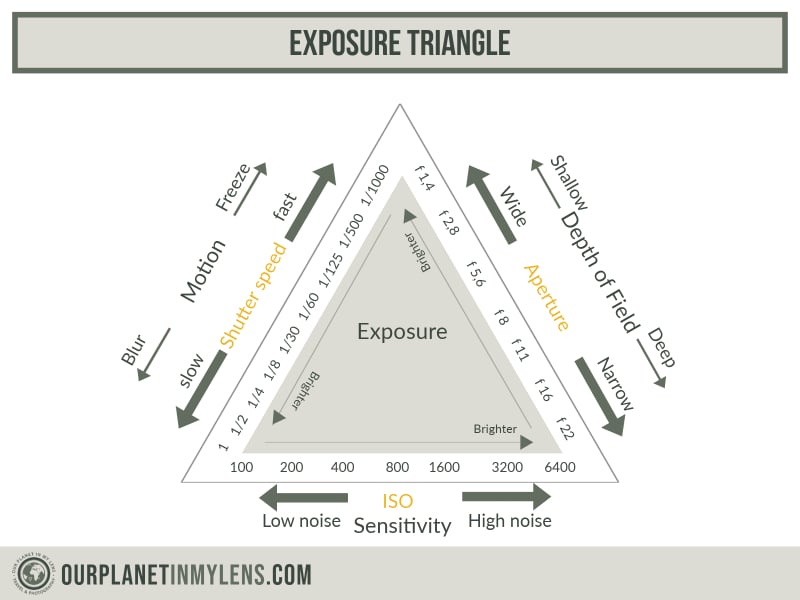
Adjust aperture for light control and depth of field , use shutter speed to freeze or create motion of animals, and set ISO for sensitivity (lower during the day, higher when it’s getting darker).
7. Use Shutter Priority Mode for moving wildlife
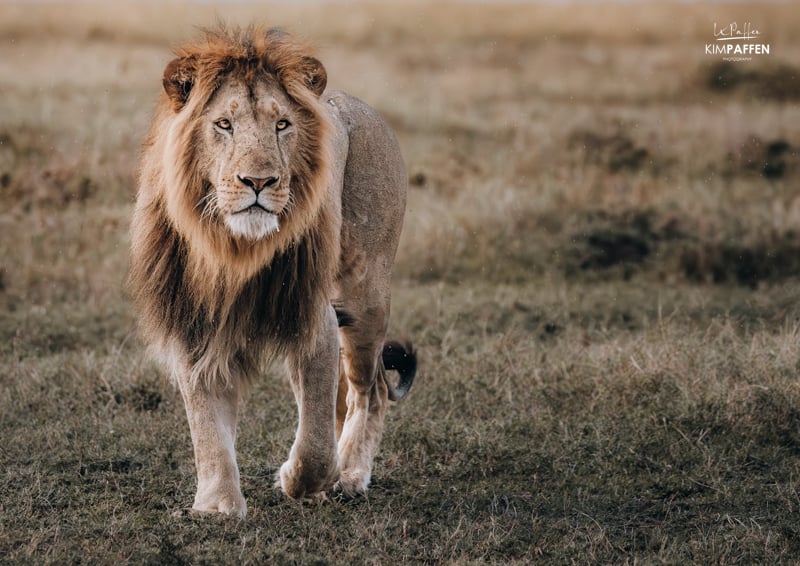
If you’re used to photographing in automatic mode, it can feel like a puzzle if you want to photograph wildlife manually. Therefore, my best photography tip is to set your camera on shutter priority mode (S). It means that you only have to think about the shutter speed and the camera does the rest like your ISO and Aperture (semi)automatically.
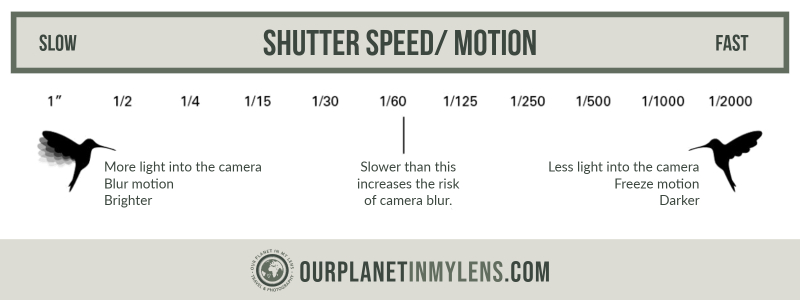
This technique ensures sharp and clear images, especially when photographing animals in motion on your safari. Use a fast shutter speed to freeze fast-moving wildlife action, and try to practice with various settings between 1/250th of a second up to 1/2500s. Additionally, fast shutter speeds can help prevent camera shake, particularly when shooting handheld.
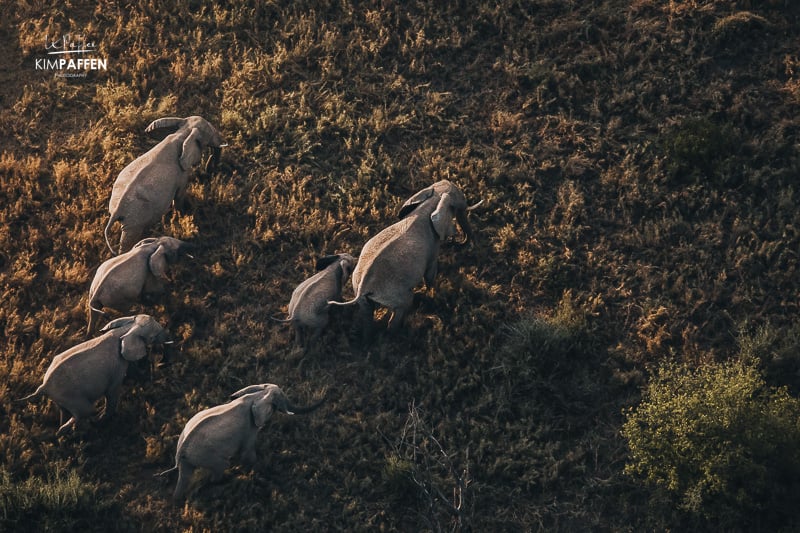
A rule of thumb: choose a minimum shutter speed based on the focal length you are shooting. An example: I often capture wildlife with a focal length of 400 mm, meaning my minimum shutter is 1/400s. If you are in a moving safari vehicle, boat or hot air balloon, and/or the animal you want to photograph is moving fast, then use a minimum of 2 times the focal length. So, shooting at 400 mm would mean a shutter speed of 1/800s. To capture moving birds in flight , you might want to practice choosing shutter speeds to up to 1/2000s.
8. Choose AI Servo (AF Continuous) Mode for moving wildlife
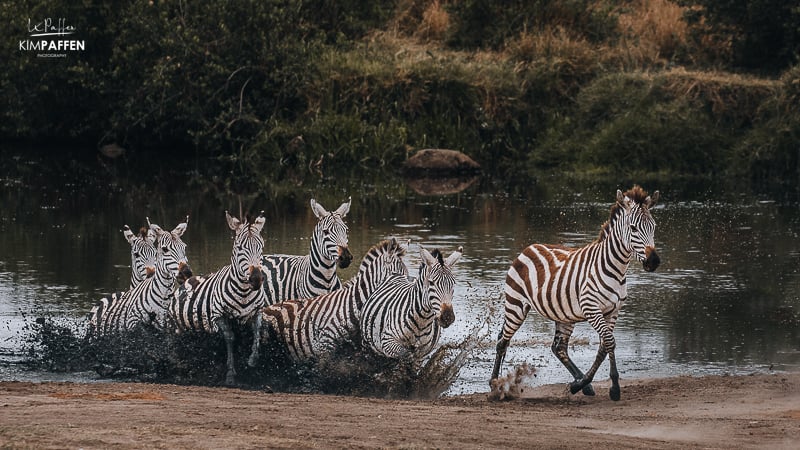
AI Servo is the best mode to capture wildlife that is moving, to automatically keep track of and stay focussed on the moving animal.
9. Practice with Aperture Priority Mode for a ‘blurry’ background
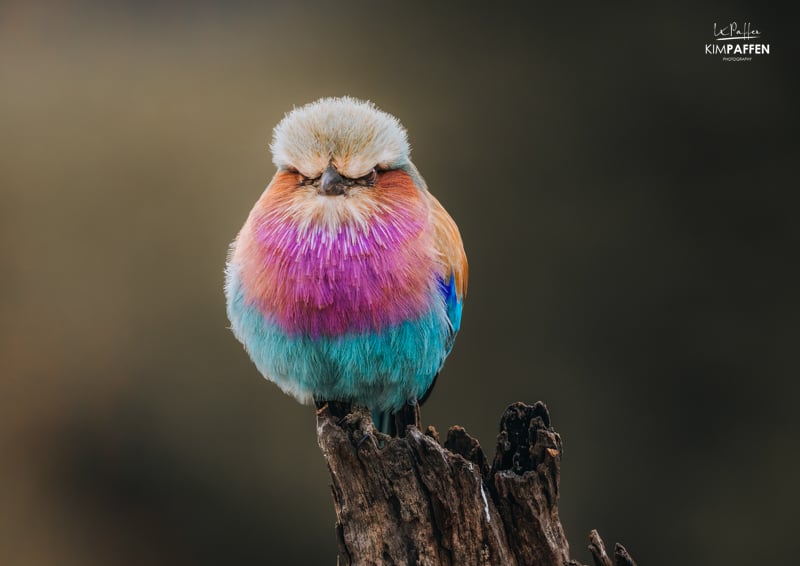
Aperture Priority in safari photography allows you to set the desired aperture, controlling the depth of field in your wildlife shots. In situations where you want a blurred background to emphasize the subject, or conversely, a broader depth of field to capture more details.
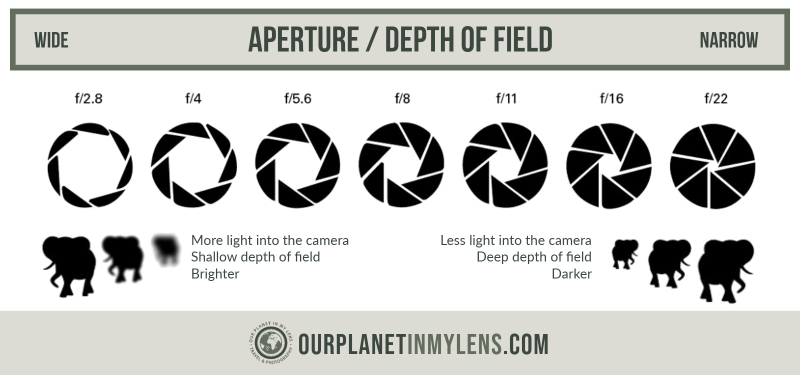
Aperture Priority mode gives you this creative control. For example, when you want a close-up of a lion or a colorful bird with a blurred background effect, like the Lilac-breasted Roller in the above image. The more zoom and the lower the aperture number, the more you are able to eliminate the background in your image and create that nice compression.
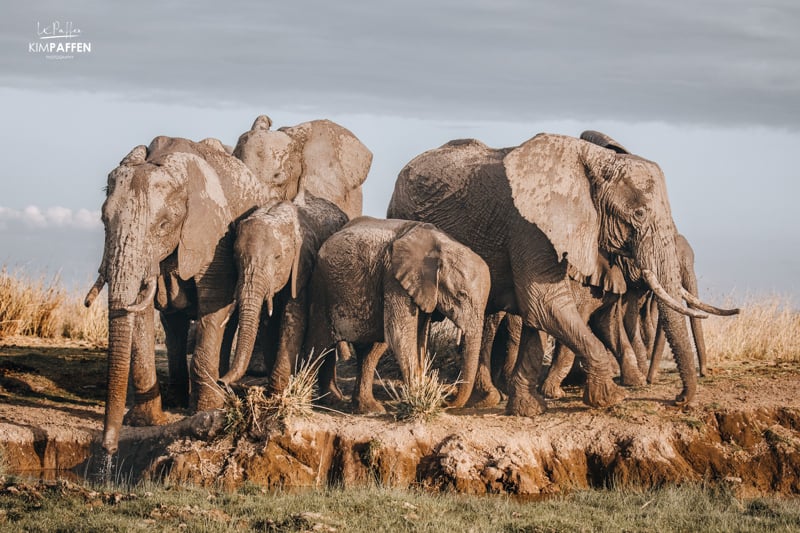
On the other hand, if you want to photograph a group of animals like a herd of elephants, I recommend choosing an aperture of f/8 to get the whole group of animals in focus (and not only one).
10. Try Burst Shooting Mode in Safari Photography
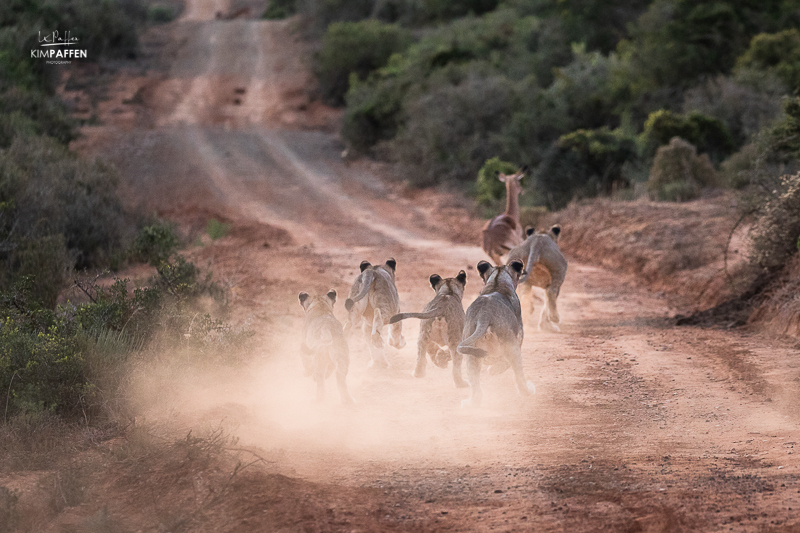
Shooting in burst mode is an important wildlife photography tip for safari enthusiasts, catering to both beginners and advanced photographers. Wildlife is unpredictable, and animals often move swiftly. Burst mode allows you to capture a series of rapid shots, increasing the chances of freezing dynamic moments, ensuring you don't miss critical actions or spontaneous behaviors.
Beginners benefit by having a safety net, capturing shots even if timing is a challenge. For advanced photographers, burst mode offers creative opportunities to select the perfect frame from a sequence.
11. Focus on the eyes of an animal
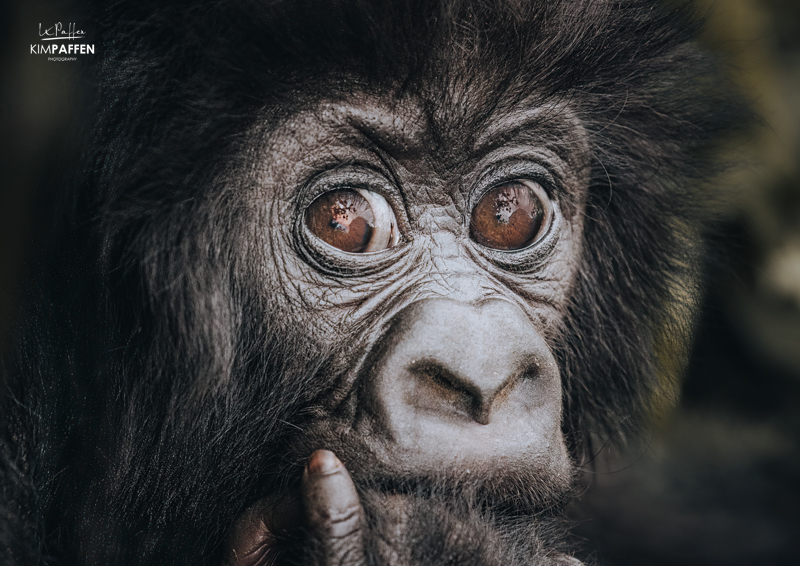
Always focus on the eyes of the animals ; that’s the cardinal rule of wildlife photography! This golden tip elevates your shots, creating a connection between the viewer and the wildlife subject. Instead of hastily snapping numerous wildlife images, wait for the moment when the animal turns its gaze towards you.
Focusing on the eyes provides viewers with a unique perspective. It creates a visual connection, as if the animals are looking directly through the photograph at the audience. This transformative approach adds depth and emotion, making your wildlife images more memorable and resonant, especially when capturing close-up shots of animals. This technique enhances the details in the eyes, showcasing the intricacies and expressions that might be missed in broader shots.
Aim for a shutter speed between 1/250s to 1/2500s, depending on the animal's movement, and an aperture between f/2 to f/6, depending on your lens. These settings ensure both eyes are in focus, capturing the essence of the wildlife subject.
Remember, the eyes are the windows to the soul , even in the animal kingdom. So when focusing on the animal’s eyes, you can create truly remarkable and memorable wildlife photographs.
12. Shoot in RAW if you can

Shooting in RAW format on a safari offers several advantages.
RAW images provide a higher dynamic range compared to JPEG, capturing more details in both shadows and highlights. This is crucial in the diverse and often challenging lighting conditions encountered during a safari.
RAW files contain more image data , allowing for extensive post-processing without compromising quality. This flexibility is valuable when adjusting exposure, contrast, color balance, and other elements during the editing process (I usually edit my wildlife images in Lightroom).
Shooting in RAW preserves the original quality and detail captured by the camera's sensor. This is especially important in wildlife photography, where preserving the authenticity of the scene is crucial.
13. Timing is Everything: The Golden Hour and Beyond
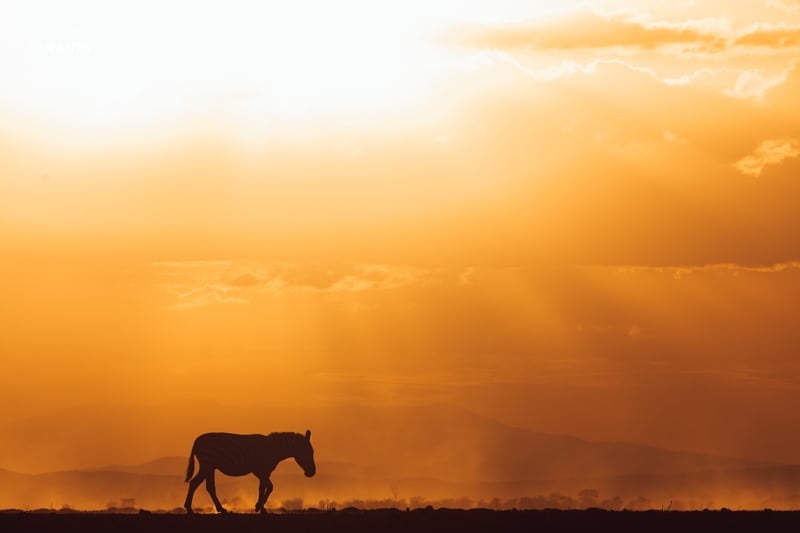
The golden hours of sunrise and sunset conveniently align with the typical timing of game drives during a safari when the animals are most active. The warm, soft light enhances the colors and textures of the African landscape, creating a captivating backdrop for your photos.
The advantage of photographing during the Golden Hour , sometimes called ‘Magical Hour’, is that the soft golden light reduces harsh shadows and creates a golden glow. Patience during these hours rewards you with captivating glimpses into the animals' daily lives.
14. Equip Yourself Wisely with the right camera gear
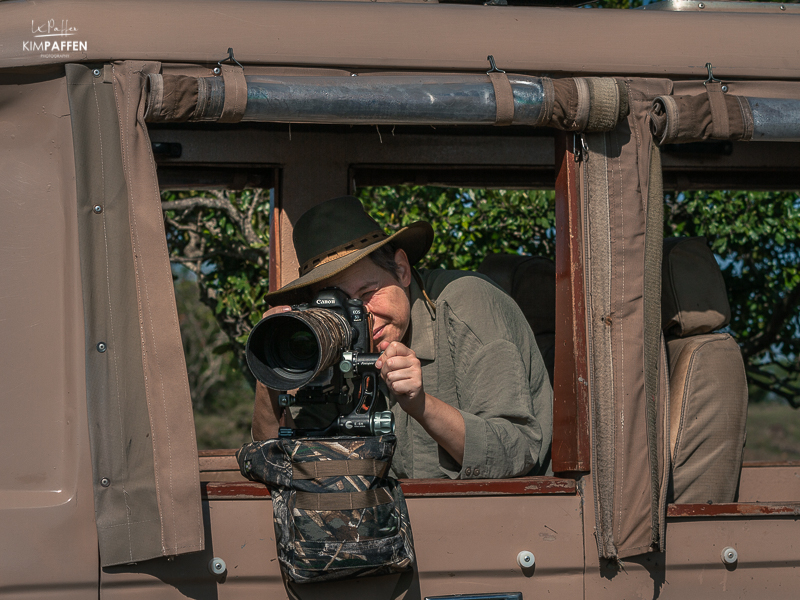
Ensure you have the right camera equipment for safari photography.
Bring a DSLR (Digital Single Lens Reflex) camera and zoom lenses with 200-600 mm range or a quality compact camera for versatile quality wildlife photos. Safari photography on a smartphone is not the best option to photograph wildlife, but it is, of course, a great option to create short videos, stories, and reels.
Zoom lenses for safari photography
I highly recommend a long lens with a minimum of 200 mm zoom to capture distant wildlife. A zoom lens allows you to effortlessly switch between photographing animals from a distance without disturbing them and capturing intricate details of flora and fauna up close.
More ideally, a zoom lens with a focal length of 300 mm+ is great for capturing wild animals or birds. If you’re using a full-frame camera, I would suggest a 400 mm zoom lens and if you are a keen birder a 600 mm long lens is perfect for bird photography on safari.
Wide-angle lens
Apart from zoom lenses, I always carry a wide-angle lens (for example 16-35 mm), great for capturing the beautiful African landscapes and its animals or magical sunsets.
Essential accessories
Don't forget essential accessories, such as memory cards, extra batteries, cleaning wipes, a charger, a camera bag, and a rain cover. Consider a beanbag for stability.
Hire photography gear for safari
Not having the right camera gear ? Nowadays, the quality of compact cameras is pretty good as well, and it’s also possible to hire photography gear .
15. Consider bringing a tripod and/or beanbag
Bringing a tripod and/or beanbag on safari is a crucial photography tip for the following reasons:
- Stability for Clear Shots: A tripod or beanbag provides stability, reducing camera shake and ensuring clear shots, especially when using longer lenses.
- Flexibility in Composition: Both tripods and beanbags allow photographers to compose shots with precision. A tripod is ideal for setting up shots in a fixed position, while a beanbag provides a more flexible option, allowing quick adjustments and movements.
- Support for Heavy Equipment: Professional camera gear, including telephoto lenses, can be heavy. A tripod and/or beanbag offers robust support for heavier equipment, preventing fatigue during extended periods of shooting.
- Long Exposure and Low Light Conditions: In low light or during sunrise/sunset safaris, a tripod is essential for capturing long-exposure shots without introducing motion blur. A tripod is also great to practice with star photography and photographing the milky way when you're back at the safari lodge .
- Silent Shooting with Beanbags: Beanbags are preferred for wildlife photography as they provide a stable base without the noise associated with adjusting tripod legs. This is especially important to avoid disturbing animals in their natural habitat.
- Versatility in Safari Vehicles: Safari vehicles often have limited space, and tripods may be cumbersome. Beanbags are more versatile, easily adapting to the contours of the vehicle and providing a stable platform for photography.
16. Make a back-up of your images on safari
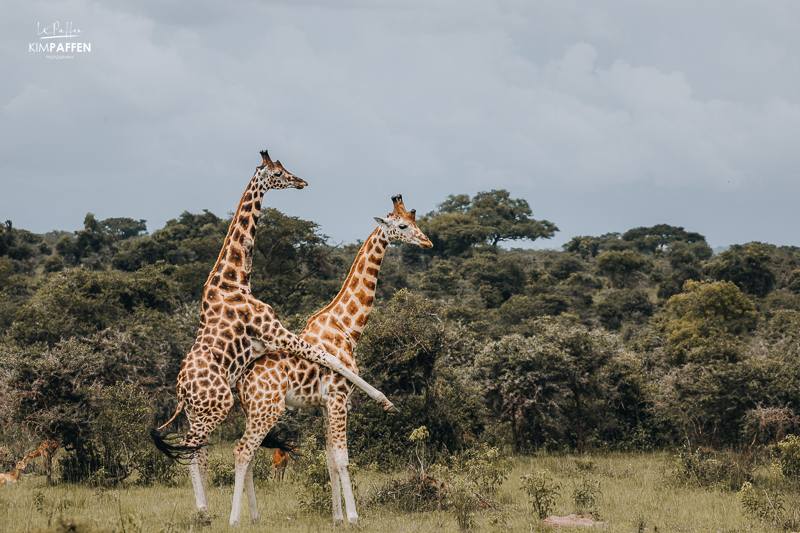
I always back up my images while traveling. When my memory card is full, I back up my images onto an external hard drive. That is mostly enough, but for people who want to travel longer, I highly recommend backing up to a second external hard drive (kept in different locations). Hard drives I use are Lacie Rugged, Samsung, and Seagate.
If you are using your phone only, I also recommend backing up your images in the cloud, for example iCloud, Dropbox, Google Drive, Google Photos, you name it.
17. Keep it Simple and Be Patient
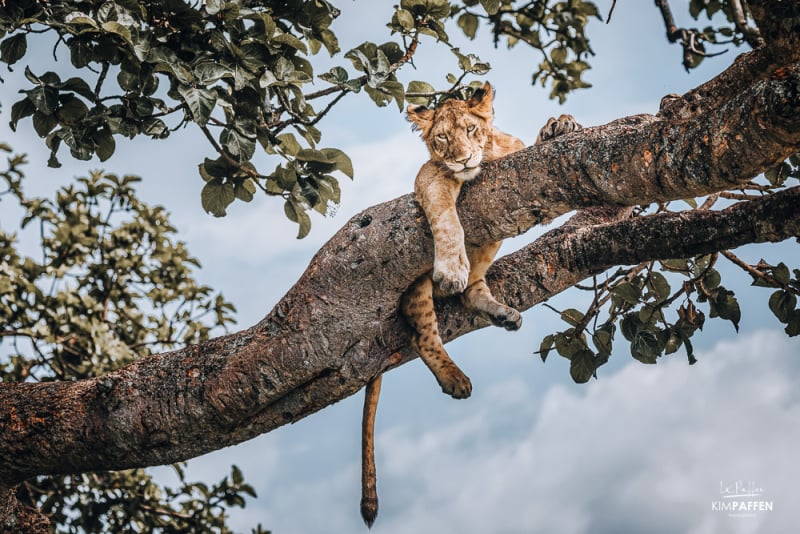
Wildlife photography requires patience . Allow yourself time to observe and wait for the right moment, focusing on mastering basic techniques. Don't be overwhelmed by settings; simplicity often reveals the raw beauty of wildlife.
18. Edit your photos
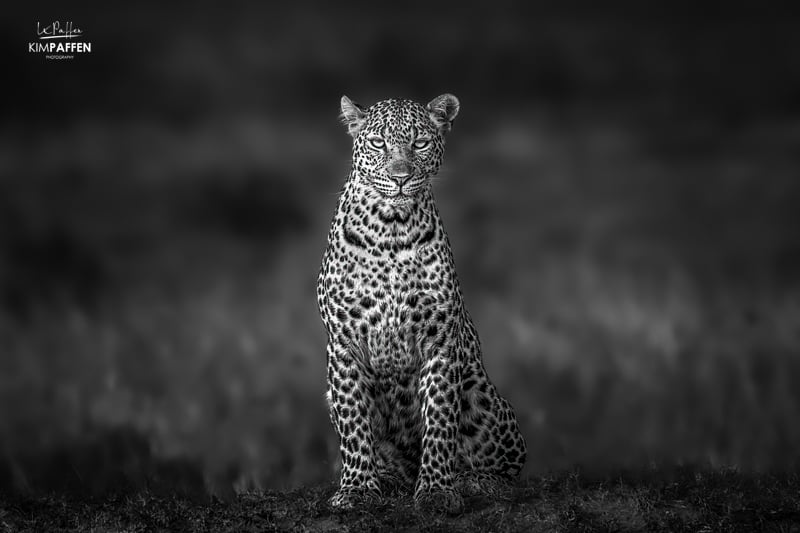
Editing your safari photos is not essential, but if you want to step up your safari photography game, I highly recommend learning how to edit your wildlife images in, for example Adobe Lightroom (for both desktop and smartphone) and Photoshop . Especially if you are planning to print your photos, post-processing is an important step.
Get in touch for a private workshop on how to edit your safari photos or join me on a photo safari where I will share editing tips to improve your wildlife photography.
19. Know Your Camera
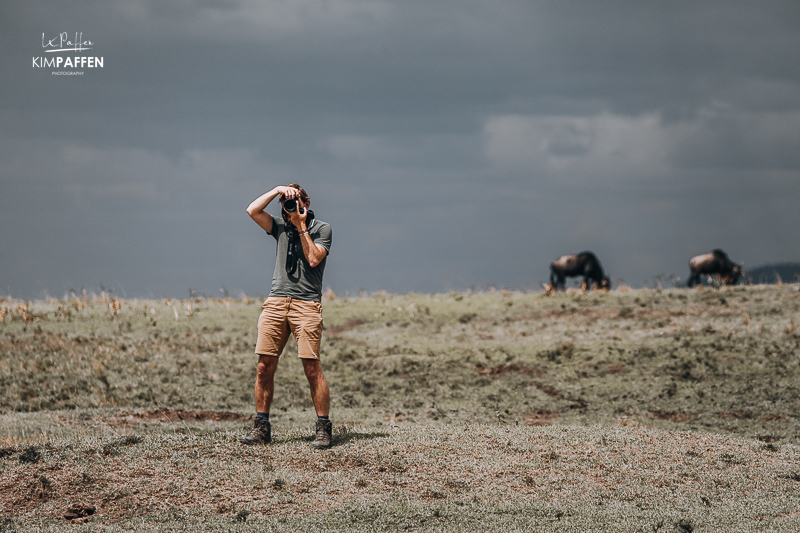
If you're a beginner photographer, all the settings on your camera can be a bit overwhelming. When I first started photography, my camera was a puzzle to me. I kept using the automatic mode until I learned the basics of photography during a volunteer program in South Africa . Having two game drives per day in Thanda Game Reserve in KwaZulu-Natal was the perfect way to start practicing shooting in manual mode and learn more about the best settings for safari. I highly recommend to start learning more about your camera and camera settings before you go on safari. Go through your camera manual to find the buttons and settings of some of the technical photography tips I mentioned in this article.
20. Embrace Learning and Growth
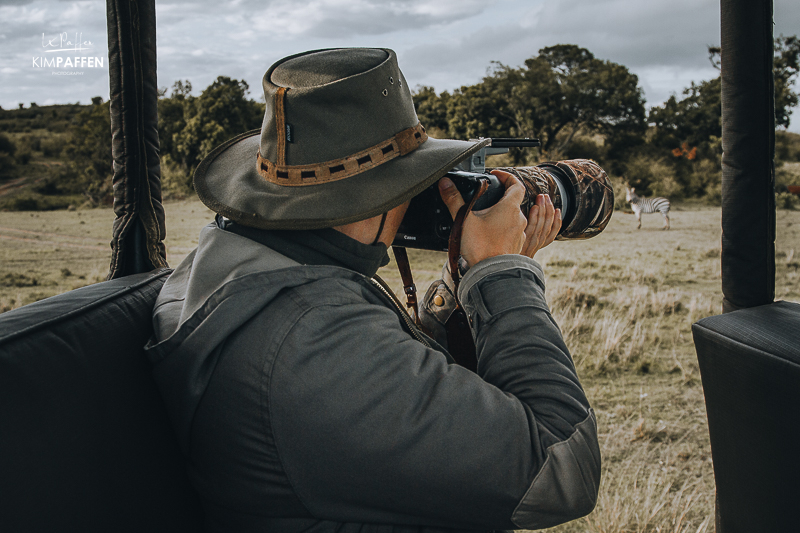
Whether you're a beginner or experienced photographer, nurture your interest in learning photography. Books about photography, online photography courses, workshops and guided photo safari tours with photography experts offer opportunities to enhance your safari photography skills; including my small group photo safaris . To master a new skill, learning by doing is often the most effective approach to get to know your camera better. So please remember, anyone can learn photography, and the wonders of a safari in Africa can ignite your passion for capturing the mesmerizing beauty of our planet's wildlife.
21. Join me on a photo safari to Africa
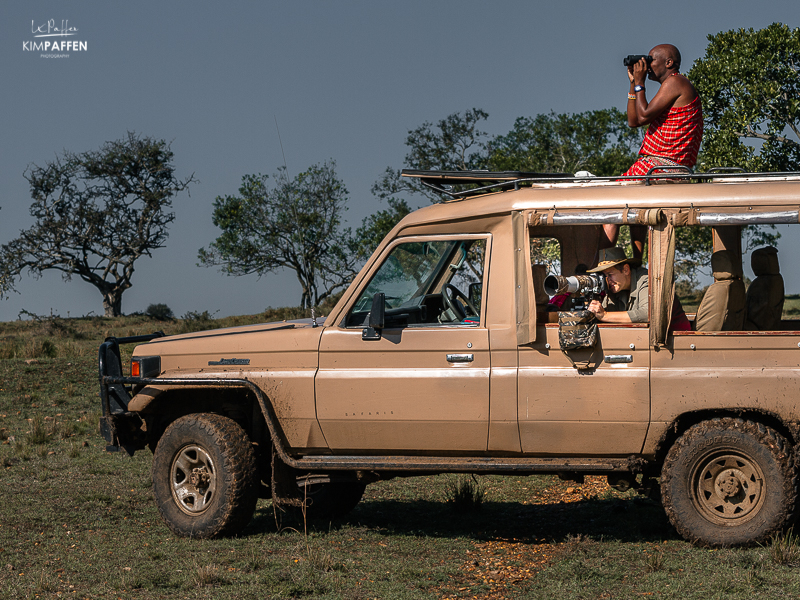
Do you want to improve your photography skills on safari and travel with like-minded travelers? Join me on a small group safari to Africa . As a professional wildlife photographer, I can help to improve your photography skills on safari by sharing hands-on experience and valuable tips. Instead of rushing to tick off the Big Five, we will spend our time carefully during the beautiful golden hours around sunrise (morning game drive) and sunset (afternoon game drive).
It doesn't matter if you're a beginner, intermediate, or professional photographer. Having an interest in photography and and being prepared to learn are the most important aspects.
Safari Photography Tips to take the best photos on safari
These tips, coupled with the expertise on my photographic safari trip to Africa , will undoubtedly enhance your safari photography journey. Capture the essence of Africa's breathtaking wildlife and create lasting memories with every click of your camera (or even your smartphone).
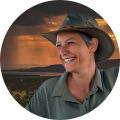

Go Wild! The Ultimate Guide To Safari Animals And What You Can Expect While On The Prowl
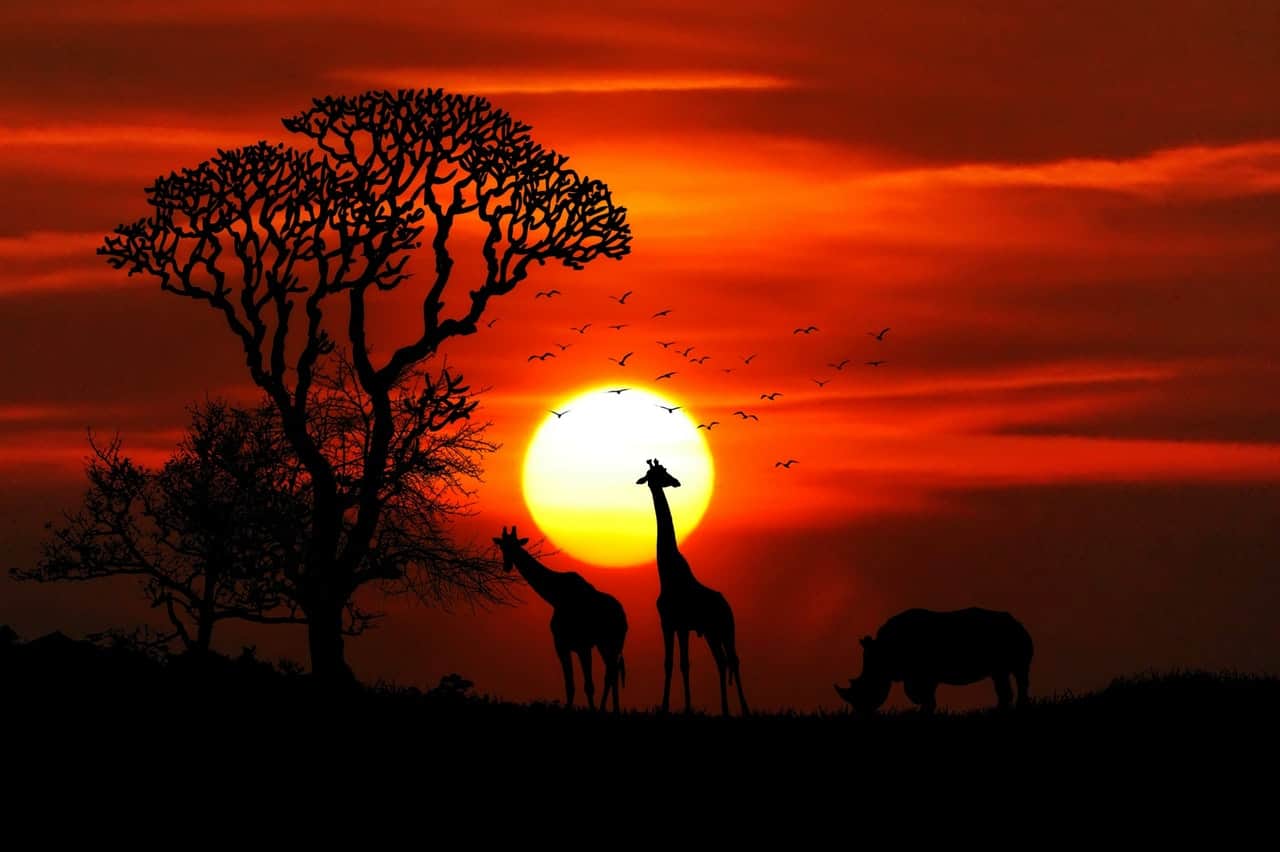
Table of Contents
*This post may contain affiliate links. As an Amazon Associate we earn from qualifying purchases.
Learning, Surviving And Thriving On Your First African Safari
First of all, way to go! Look at you, making African safari plans as your next holiday getaway. How adventurous and worldly of you!
However, seeing safari animals for the first time, live, in person and right there in front of you with no zoo glass in between is a life-changing event that you need to be prepared for in more ways than one.
Don’t worry. We’ve got you covered!
Below you’ll find a beginner’s comprehensive guide to all things “safari.”
Grab your backpack and binoculars and let’s get movin’!
Nants Ingonyama Bagithi Baba!
Does that ring a bell?
If you’re not familiar with what a safari is, then just think Lion King — only safer, and with no animals talking.
A safari technically means a journey, usually by vehicle, in Africa. Believe it or not, even the word “safari” means journey in Swahili.
Let’s Get Into It
So, when did these journeys first start?
Well, as it turns out, many years ago the first safaris were focused on trading and traveling (aka journeying) through the land.
While it is true that they had guides to get them through the wilderness safely, the main purpose wasn’t to see safari animals like it is today.
It’s safe to say that safaris have always been a profitable business model that has a tendency to attract a wide array of people from many countries and distant lands.
Go Here; Trust Us
African safaris to add to your bucket list.

How To Take The Perfect Safari Photo
The safari photography guide.
Photographing wildlife is always challenging, so we’ve put together our top tips on how to take a steady stream of great wildlife photos whilst on safari to help capture the amazing sights that await on your African adventure.
Photo Prep Before You Go:
– Take the time to familiarise yourself with how your camera works. Practice using the different modes and studying the result. You don’t want to waste a moment of your trip getting frustrated over how to use your camera!
– Think about the environment you’re going to be in – will you want the hassle of carrying around a tripod, extra lenses, and filters? For a safari situation, your extra gear may be a touch too limiting and distracting.
– Study the animals you are hoping to photograph. Being familiar with their movements and features can help you plan how best to capture them when the moment arrives… and end up with a safari animal photo portfolio like this .
– Check your equipment to ensure it is not too noisy or distracting for the animals. See if you can turn off the shutter sound, for example, or choose a camera with a quiet one if you’re buying something new.
Tips Whilst On The Trip:
– Be sure to charge your battery and bring spares if you have them, or invest in a few if you don’t. You could be out all day and are likely to be doing a lot of shooting, so start each day with a fully charged battery to limit the chances of running out and missing a perfect shot.
– Make sure you have extra memory cards for the same reason as above. The general consensus is – however much memory you think you will need, bring more! For many, a safari is a once in a lifetime experience, so don’t limit yourself to the number of memories you can capture.
– When trying to shoot a moving animal, switch your camera mode. Sports or action mode are both good options if you have them, as they increase the shutter speed, meaning you can catch the movement without the result being a blurry mess. Do remember to switch it back to normal afterward, however, as this won’t produce a good result for stationery shots.
– Avoid shooting into the light and try to position yourself on the opposite side of the vehicle to the sun. Ideally, you would like the sun to be behind you, illuminating the subject.
– Turn the flash off! You won’t need it during the day and it can annoy the animals, so be mindful and respect the local environment.
– Don’t put your subject in the middle of the picture. Think about the shot you want and how best to compose it, then spend some time setting it up (even if the animals aren’t yet there). It is all too easy to get caught up in the moment and just start pointing and shooting, but this will not result in the best images.
-Following on from the above point, use the rule of thirds. In a nutshell, this means imagining your screen as a grid cut into 3 x 3 squares, placing the focal point(s) of the scene where the lines intersect.
Technical Talk:
– For capturing animals in motion, you ideally want a camera that shoots at 5x a second, with a shutter speed of 1/125.
– If you are bringing a Digital SLR along, a long lens is crucial. A 300mm lens will work fine, but a 400mm lens is better for shooting from a distance. For landscape shots, use a wide-angle lens.
– If you don’t think a tripod is practical, take a bean bag or a window-mounted tripod instead.
– Blurred backgrounds can look great, particularly on close-up shots.
– For zoom shots, keep the eyes of the creature in focus, which will result in a more engaging photo that embraces the personality and spirit of the animal. Find out more about some great zoom lenses .
And finally, don’t get so caught up in taking the perfect photo to show everyone back home that you forget to take the time to experience the moment! Put your camera down for a while and make some memories that are just for you.
Interested in putting your new-learned photography skills to use on a safari? Read our guide to photography safaris across Africa.
Interested in sharing your photos with the world? Learn more about how to start a photography blog on 9 Mousai .
Top countries for safaris
- Botswana safaris
- Kenya safaris
- Namibia safaris
- South Africa safaris
- Tanzania safaris
- Uganda safaris
Safari basics
- Safari animals
- How to find the right safari company
- When to go on safari
- What to take on safari
- Safari clothing – what to wear
- Safari rules & etiquette
- Wildlife spotting tips
Most read articles
- All about the ‘big five’ animals
- Collective nouns for animals
- Safari movies to watch before you go
- The world’s fastest land animals
- Apex predators
- 10 Fascinating African tribes
- The biggest animals in the world
- 17 Epic hybrid animals
- The world’s ugliest animals
- Why are flamingos pink?
Africa’s best game reserves
- Chobe National Park, Botswana
- Etosha National Park, Namibia
- Kruger National Park, South Africa
- Masai Mara National Reserve, Kenya
- Moremi Game Reserve, Botswana
- Okavango Delta, Botswana
- Serengeti National Park, Tanzania

Session expired
Please log in again. The login page will open in a new tab. After logging in you can close it and return to this page.
Finding the Universe
Travel tales, photography and a dash of humor
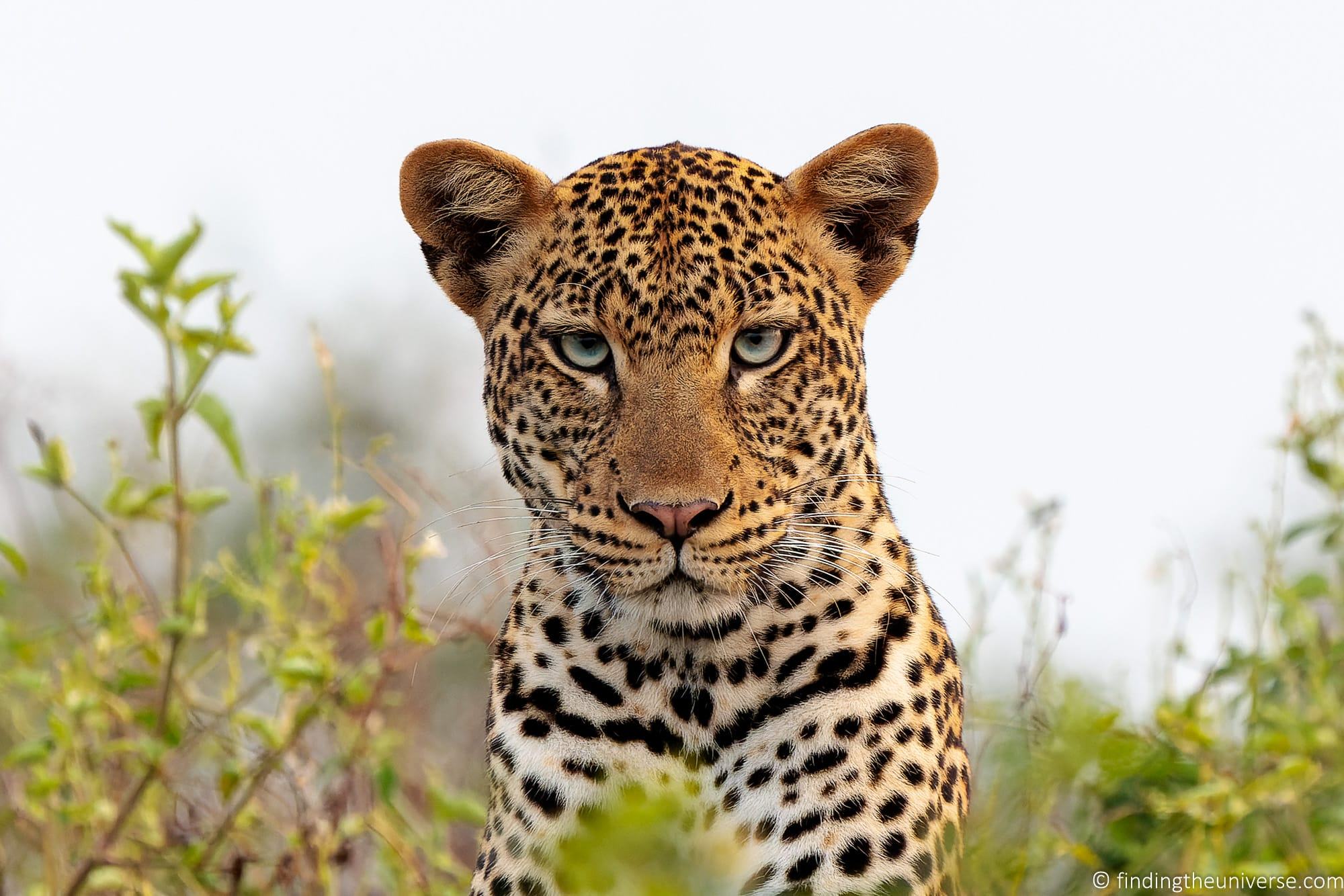
Safari Photography Tips – How to Get Great Photos on Safari
Last updated: May 7, 2024 . Written by Laurence Norah - 4 Comments
A safari is a fantastic way to see a wide range of wildlife in its natural habitat. It’s also an opportunity to take lovely photos of that wildlife! However, there are some unique challenges to taking photos on safari. In this post, I’m going to share some safari photography tips to help ensure you get the best photos when you go on safari.
As a professional travel photographer, I’ve been lucky enough to take photos in a wide range of scenarios, including on a number of safaris in both Africa and Asia. Based on my experiences, I’m going to share with you everything you need to know to get great photos on safari.
Most of my examples used in the post are from taking photos while on safari in Africa; however, these tips will work for most safari destinations. as well as for wildlife photography in general. Many of these tips can help anyone looking to improve their wildlife photography and also for anyone wanting to take photos from a vehicle.
I’ll cover a few things in this post. I’m going to talk about some general tips and things to think about when going on safari from a photography perspective. I’ll also include ideas on suggested cameras and camera accessories for safari so you know what is important to bring along.
A safari is a big investment for many of us, and is often a once in a lifetime trip. So getting great photos to remember our experiences is important. Let’s get started with the tips!
Tips for Taking Better Photos on Safari
Plan where you want to go.
The first thing you are going to have to do is decide where you want to go on safari. It’s likely that you already have an idea as to what you want to see and photograph on your safari, be it specific animals or birds, or maybe you are interested in certain landscapes.
The main thing is that you pick a destination that will give you a good chance of seeing the things you really want to see and photograph. This is particularly the case with animals or birds that are rarer, like rhinos.
On a recent trip across East Africa, we knew that we wanted to see and photograph things like gorillas, chimpanzees, rhinos, and spoonbill storks. We picked the countries we visited as well as the time of year we travelled to ensure that we would have a good chance of seeing these particular animals.
We also wanted to see the Great Wildebeest Migration on that trip. This is always taking place, so it was just a question of researching where it would be at the time of year we would be visiting to ensure we would have the best chance to see and photograph it.
Planning your destination properly is definitely the first step to getting the photos you want to get on your safari.
Research Your Chosen Safari Location
Once you have chosen your safari destination, do some research to better understand your trip itinerary and the wildlife, landscape, and climate of the destination.
All of these things can affect how you will want to prepare for your safari and the type of camera equipment you might need.
For instance, if your main photography goal of the trip is take photos of lions, you will want to try to make sure that you spend a sufficient amount of time in places with healthy populations of lions to increase your chances of seeing and photographing them. Lions are often best seen in savanna areas.
However, if you are interested in malachite kingfishers, you’ll want to make sure that you spend enough time in wetland areas for a good chance to see these birds. These little birds are best spotted and photographed either from a boat or on foot.
This research will also help you decide on the equipment you will need to take with you. For photography of smaller birds for example, you’re likely going to need a longer lens. If you are more interested in landscapes, then a wide-angle lens will be an essential item.
Finally, check out the climate for the country you are visiting and the time of year you plan to visit. Having an idea of what to expect will ensure you bring the right clothing as well as any protective equipment like camera rain covers on your trip.
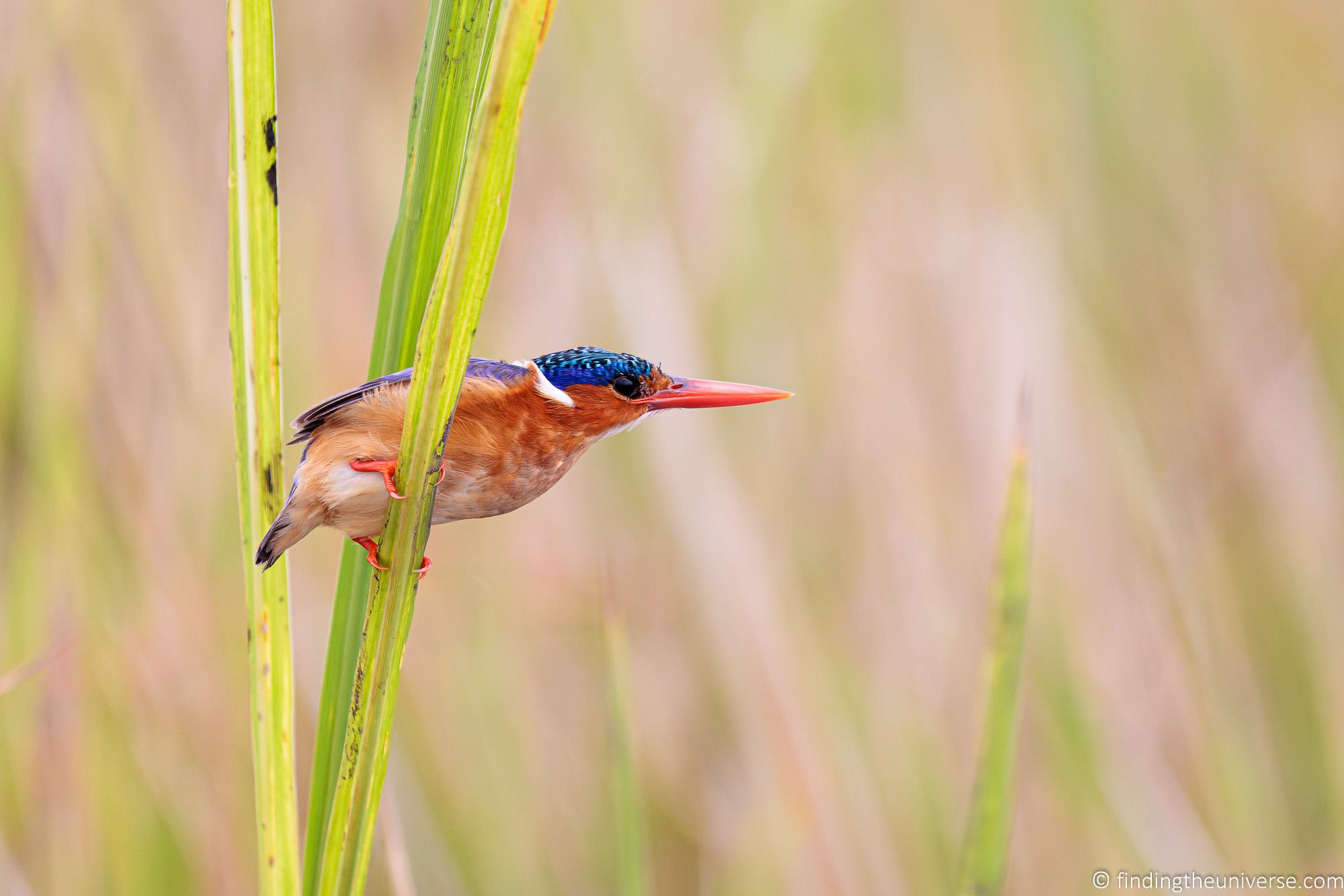
Choose the Right Camera for Safari
One of the main decisions you’ll have to make when planning your safari trip is what camera to take with you on your trip. This decision will have you weighing various factors, from your budget through to the size and weight of the camera.
When you are deciding how much to spend and how much you are willing to carry with you, consider what sort of images you want to get. If you are looking for amazing wildlife shots of fast action or in low light, then you will want to invest more money in a high-end set-up.
As an example, compare these two shots of a leopard taken in low light at the end of the day. Both are uncropped.
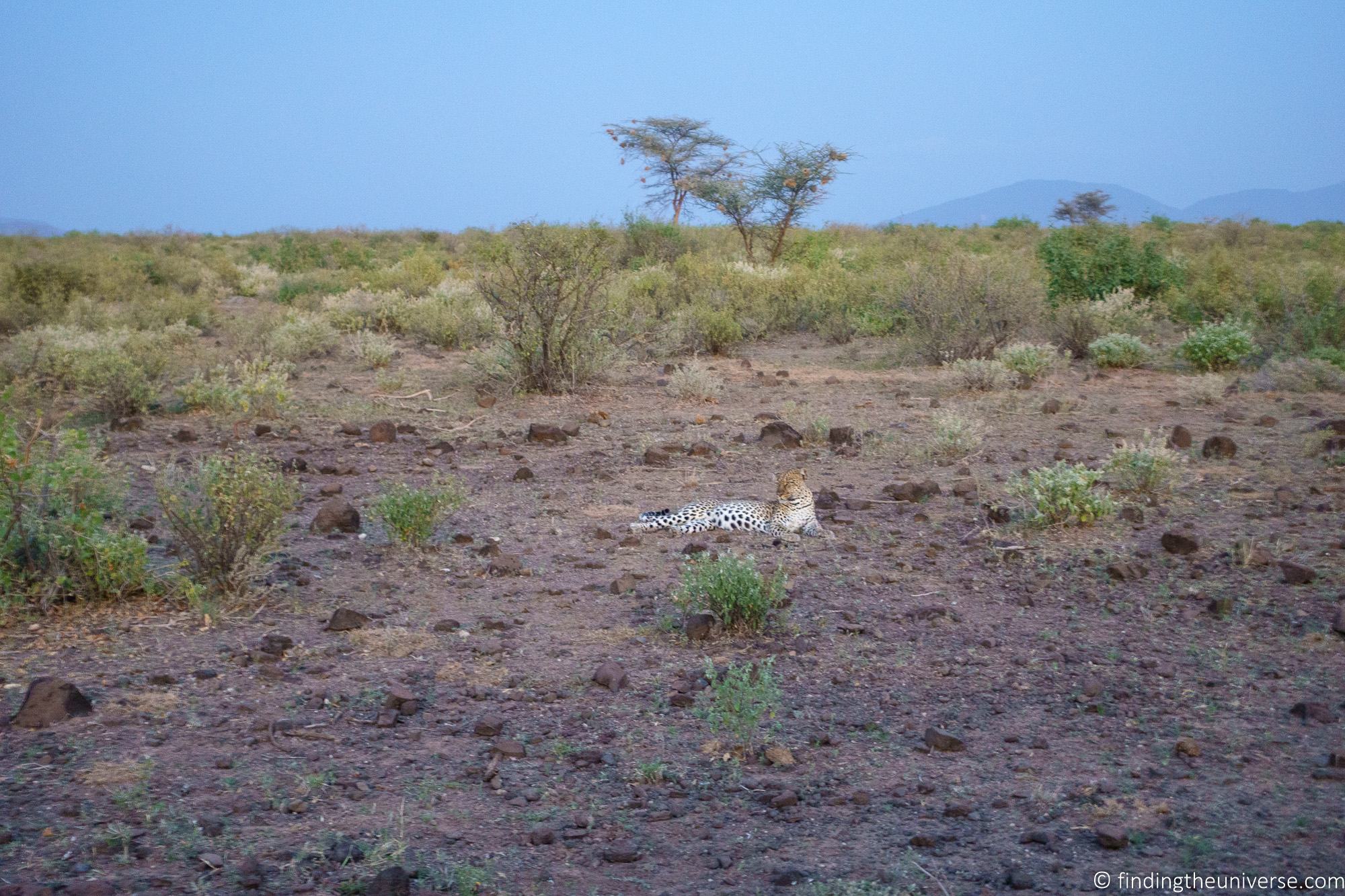
Both images are obviously of a leopard. However, the compact camera struggles to get a close up shot due to the maximum 70mm focal length, and even at ISO 800 the image ends up being quite noisy. The slow shutter speed, even with image stabilization, also means the shot is not too sharp.
The larger and more professional Canon EOS R5 mirrorless camera paired with a 100-400mm lens is still able to get a very usable image, even at 10,000 ISO.
If you are just happy to capture memories of your trip, then a compact camera or smartphone will likely do the job.
A good compromise for many users is a bridge camera , which offers a good balance between a long zoom, affordability, and image quality.
However, if you want the most flexibility and opportunity to get the best shots from your trip, then a higher end mirrorless camera would be my recommendation.
If money and size are no object, my recommended camera for safari would be a high-end mirrorless system. The latest mirrorless models feature excellent auto-tracking autofocus which can recognise and lock onto a subject very quickly, which can really help with fast moving subjects.
In this situation, I’d probably pick a Canon EOS R5, Sony Alpha a7r IV or a Nikon Z9. I’d pair it with a telephoto zoom in the range of 100-500 with stabilization and as wide an aperture as I could afford.
If you want something that offers a good balance between affordability, image quality, and zoom, then my suggestion would be a bridge camera.
I have a whole post on the best camera for safari which I would suggest reading if you don’t already have a camera you want to bring with you. It’s definitely important to choose the right camera for you.
In summary though, here are some recommended cameras that I suggest you take a look at, depending on the type of camera you would like to take on safari:
- Smartphone: either a Pixel 6 Pro or iPhone 13 .
- Compact camera Panasonic Lumix ZS70 or Sony RX100 VII
- Bridge camera: Panasonic Lumix DC-FZ80 / FZ82 or Sony RX10 IV .
- Mirrorless camera: Sony a6100, Sony Alpha 7c , Canon EOS R6 Mark II , Nikon Z7II , Canon EOS R5 , or Sony Alpha a7 IV
- DSLR camera: Nikon D3500 or Canon EOS 6D Mark II
For more on choosing a camera in general, we also have guides to the best travel camera , best compact camera , best bridge camera , best mirrorless camera and best DSLR cameras .
If you have, or plan to buy, a mirrorless camera or DSLR camera, you may be wondering what kind of lens would be best for safari. It depends of course on your photography goals and what you want to photograph, but I would generally recommend a lens with a focal range of 100-400mm. See my safari camera post for lens recommendations.
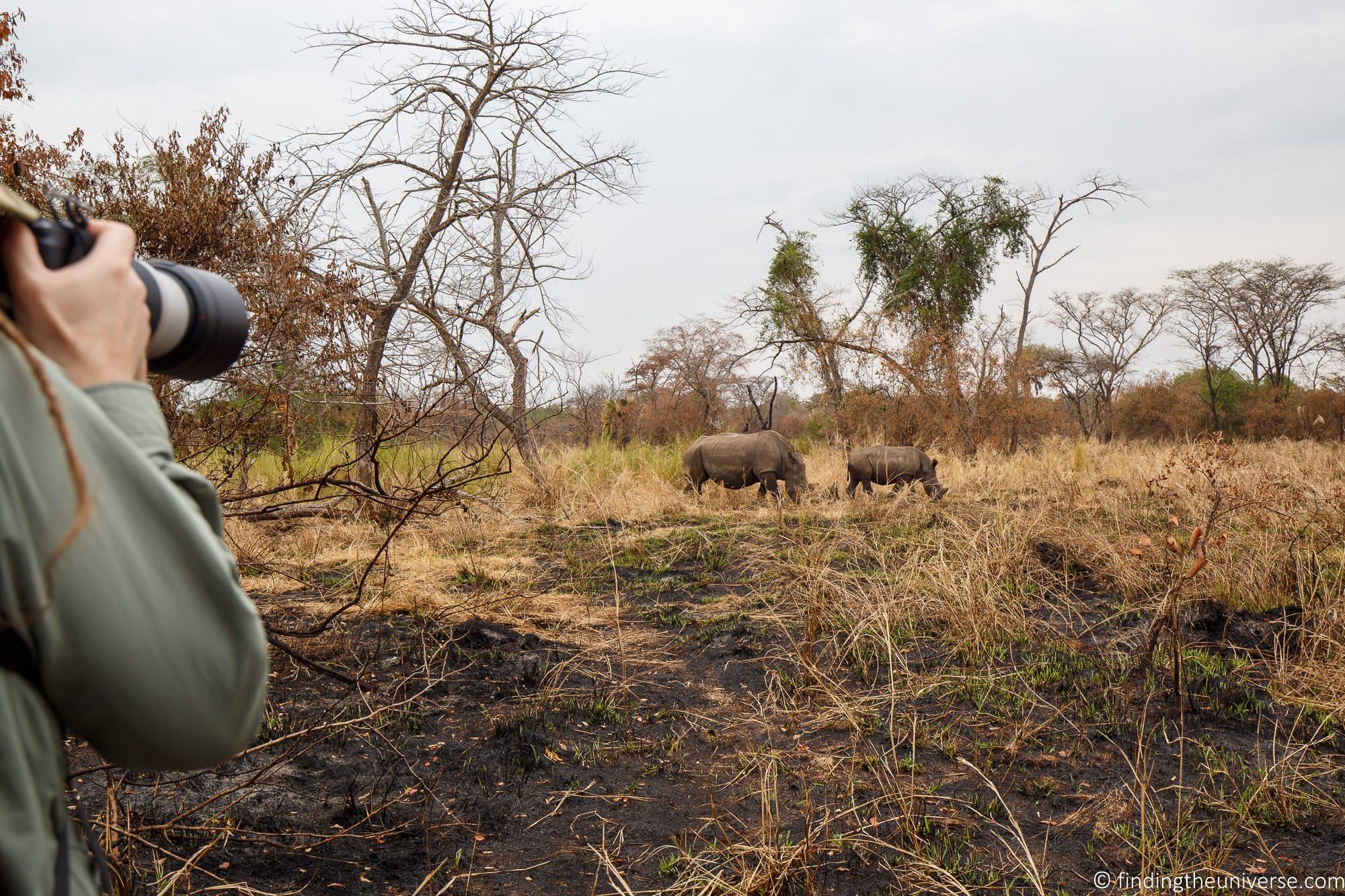
Learn How to Use Your Camera
Once you have decided on which camera to take with you, it’s important that you learn how to use it properly. This applies to whatever kind of camera you are using, be it a smartphone camera or a high-end DSLR or mirrorless camera.
A camera is ultimately just a tool to help you take great photos, and like any tool, it will only do what you ask of it. Understanding the various features of your camera and how to access and adjust key settings is vital to ensure you don’t miss a shot.
When you are on safari, great photography opportunities can arise very quickly and be gone just as quickly. For example, for the shot of the leopard at the start of this post I had just a couple of seconds to frame the shot and ensure all the settings were correct before he decided to sit up and slink away out of sight.
Had I not been able to nail the focus or adjust ISO, aperture, and shutter speed appropriately in time, I would have missed the shot. I would recommend checking out my guide to the exposure triangle , as well as how to use a mirrorless camera for detailed advice.
Understanding how to adjust the settings and set up your camera properly means you’ll have more control over the final look of your shots. For example, you could learn how to manually change the shutter speed so as to capture movement in different ways.
Here are a couple of examples of different shutter speeds to show the difference.
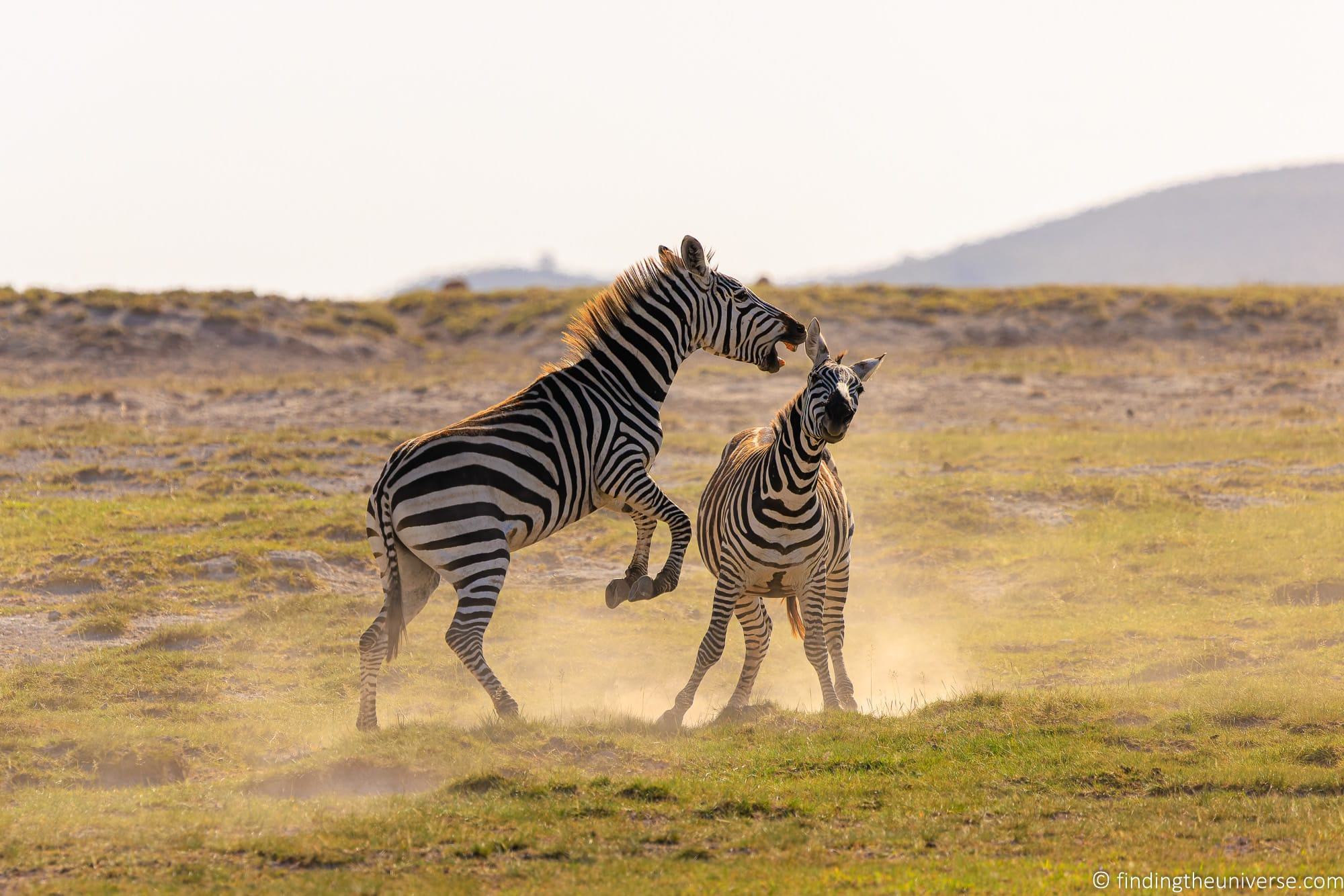
In the first shot, even though the fighting zebra are moving quickly, the fast shutter speed freezes the action. In the second shot of the wildebeest crossing, they are just walking over the road. But in 1/5th of a second, they cover a small amount of ground, and so they become blurry. The single stationary wildebeest remains sharp as it isn’t moving.
There are many features of a camera which can be used to adjust how the final shot looks, and understanding how to control them will help ensure you get the shots you want.
If you feel you need help with using your camera and would like to improve your photography, there are a lot of photography courses, books, and workshops out there. I run an online photography course that teaches all the basics as well as more advanced skills, and have proudly helped thousands of people improve their photography skills.
Understand the Limitations of Your Camera
Every camera has limitations as to what it can do. These limitations will vary, and even high-end cameras will have some sort of limitation.
Examples of limitations are:
- The zoom isn’t very big, meaning you can’t capture animals which are far away and will have limitations capturing smaller animals like birds
- The camera sensor is small, and so will produce noisier images when there is less light
- The lens is big and heavy, so you need to use a fast shutter speed to avoid getting blurry images due to your hand motion when hand holding it
- Big and heavy equipment is more difficult to pack and travel with
The important thing is to understand the limitations of your camera so you can work around them, or at least, know what to expect before you go on safari.
The most common issue is probably not being able to take photos of animals that are further away. We saw a number of travelers frustrated by this on our recent trip in East Africa. All cameras will have their distance limitations, just be sure to have a good idea of yours so you can have realistic expectations of what kinds of photos you will be able to take. You can simply go outside and take photos of local animals or birds to get a good sense of this.
Another common issue I see from safari photos and wildlife photos in general are images that are not as sharp as they could be.
This is usually because the shutter speed is too low, and the user is hand holding a larger lens. A slow shutter speed means that any movement in your hand is translated into motion blur as you take the picture. You can fix this by increasing the shutter speed and/or resting the lens on a steady surface.
Some limitations can’t be overcome though, and are usually down to the actual hardware inside the camera. For example, the maximum zoom, the sensor size and maximum aperture size will be fixed.
However, if you know what the limitations of your equipment are, then you will be able to either accept them and work around them, or decide on upgrading to a different camera for your trip.
I’d also add at this point that you shouldn’t compare your photos to those you’ve seen on TV, online, and in wildlife magazines. You have no doubt seen some amazing wildlife photos and videos on sites like National Geographic or the BBC , and might wonder why you aren’t able to get the same sorts of shots.
Whilst it is of course possible to get images like those photographers do, they often have a lot of advantages over the average tourist. Not only do they typically travel as a crew with tons of high-end equipment, but they often take photos in locations that are hard to get to with limited public access.
They also often have paid for special press / filming permits to get off-road access or shoot in private areas outside of national parks. They also often spend weeks planning and trying to get the right shots, and only share the best shots with the public.
So don’t be too hard on your gear or yourself. Just be aware of the limitations of your photography equipment and know how to get the most out of it.

Understand What Causes Blurry Wildlife Images
It’s important that your images are sharp. Two things can cause an image not to be sharp. The first is using too slow of a shutter speed for the situation you are shooting. The second is not focusing correctly.
A slow shutter speed can result in blurry images for a number of reasons. If you are hand holding your camera, then any movements in your hands can translate to blurry images. Movement of the subject can also translate to blur, as can movement due to you taking photos from a moving vehicle or boat.
You can resolve the slow shutter speed blur problem by using a faster shutter speed, and ensuring you are as still as possible when shooting. Ideally, you’ll want to rest your camera on something totally stable when shooting. Then all you have to think about is the motion blur that might result from the animal moving.
For focus, the main issue is likely to come about as a result of the camera’s autofocus system picking the wrong part of the scene to focus on, leaving your subject out of focus. I’ll cover that in my next tip.
Master Your Camera’s Focus System
An important aspect of wildlife photography is knowing how to use your camera’s focus system.
It is important to be able to focus on the animal or thing that you want the viewers’ eyes to go to in the image. This means that you will want to be able to use your camera’s manual focus system (if it has one) and/or learn how to change the focus if your cameras autofocus gets it wrong.
A shot can technically be in focus and sharp, but if you have focused on the wrong part of the scene your actual subject will be out of focus and so you won’t end up with the image you want.
Nearly every camera on the market today has an automatic focus, or autofocus system. As the name suggests this system automatically focuses for you when you point the camera at a scene.
There is however quite a difference in the capabilities of these systems. At the more basic end, an autofocus system will allow you to select an area of the scene to focus on, and then focus appropriately.
More advanced autofocus system will be able to identify specific types of subject like animals or people, and track them as they move so you can keep focus.
Many cameras and lenses also feature manual override, so you can manually adjust the focus if you need.
For the main camera I use for wildlife photography, the Canon EOS R5 , this has a very sophisticated autofocus system which is able to recognised and lock onto a wide range of subjects. If it can find an eye, it will lock focus on that. Otherwise it will try to track a torso or head. Additionally, it can continue to track the subject as it moves, switch between subjects, and I can override the focus selection if necessary.
It took me quite a while to get to grips with this system, and also to get used to its quirks and limitations. For example, on some occasions it would prefer to focus on the grass in front of the subject rather than the subject. Other times it might focus on a marking on an animal’s hide, rather than the eye.
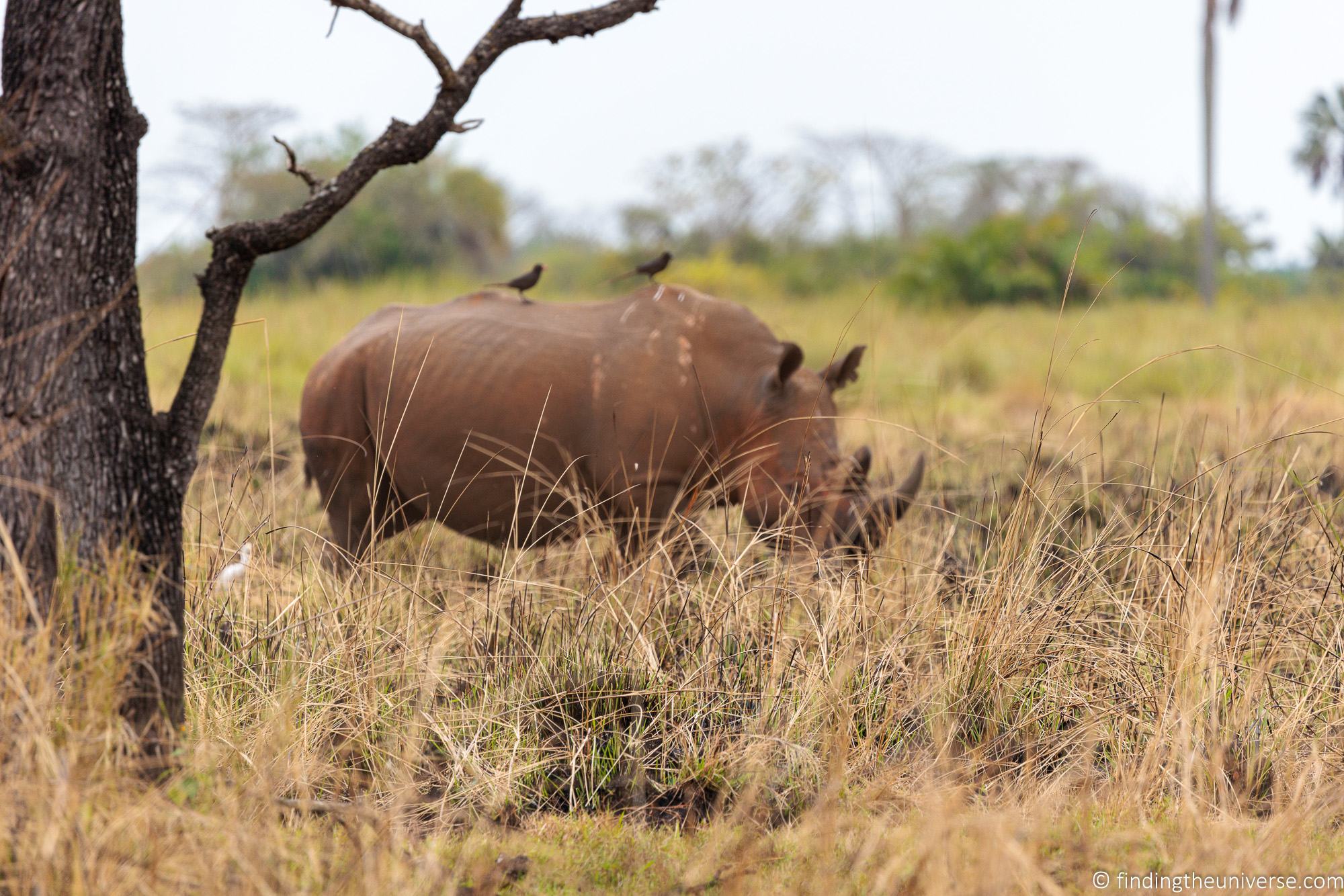
Results like this are why it is so important to both understand the various focus modes of your camera, but also understand how to override them.
For example, on my Canon EOS R5 I have a separate button set up for centre spot focus. This allows me to point the centre of the frame at the area I want to focus on, and know I’ll get sharp focus in that area when I press the focus button. I can also entirely override the focus with the manual focus ring on the lens.
Whilst I can rely on the autofocus subject tracking 90% of the time, it also means I don’t miss focus in those edge cases where the camera doesn’t get it right. Technology can be smart, but it can’t read minds quite yet, so it’s usually working off a best guess as to what you want to take a photo of.
Whatever your camera is, my recommendation is to spend some time learning the various focus modes, what they are, and how to quickly override the focus if necessary, either manually or by selecting a different focus area.
Ideally you’ll want the camera to be in a continuous focus mode so it keeps tracking a moving subject. Try to find some subjects like wildlife in your garden or a moving pet that you can practice on before you go on safari to master your camera’s focus features.
Try Shooting in Burst Mode
Most cameras have a range of shooting modes, which may also be called drive modes. The choices normally vary, and will include single shot and burst shot modes. The drive mode menu on your camera is also where you’ll often find the camera’s self-timer mode.
For wildlife photography, a lot can happen in a short sequence of time. For this reason, shooting in burst mode is usually the way to go when you have a moving subject. This means that as you hold down the shutter button the camera will keep taking images.
Alternatively, in single shot mode, you have to keep pressing and depressing the shutter button. This loses you time and you may miss the shot.
Shooting in burst mode will let you take a sequence of images and then pick the best one. For example, here’s a sequence to show a yellow-billed stork landing.
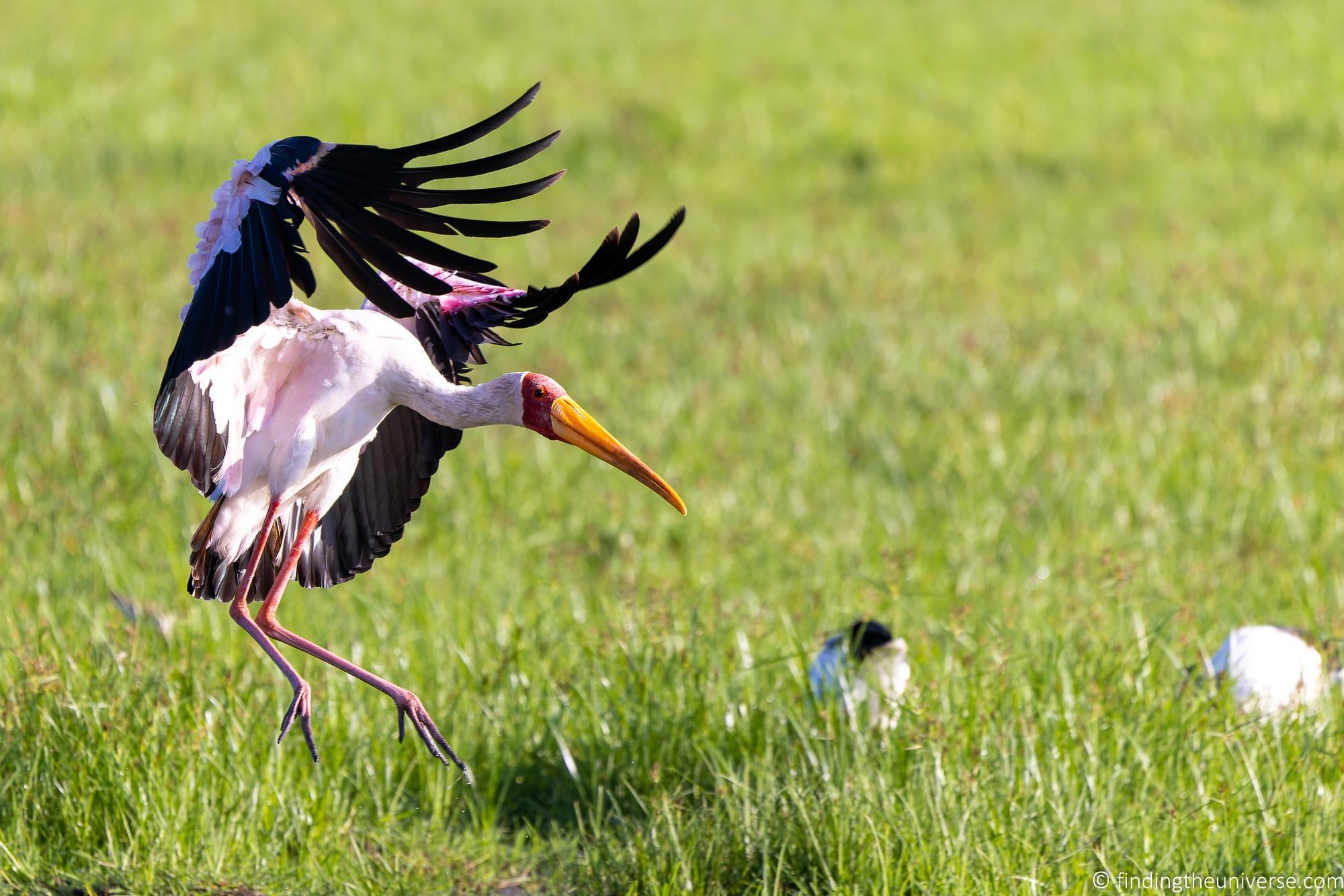
The number of images the burst mode will take will depend on two main factors.
First, the camera’s burst speed, which is the number of images per second your camera can take. For instance, a camera with a burst speed of 10fps (frames per second) can take up to 10 photos per second.
Second, the speed that your camera can write to the memory card inside the camera as it takes pictures.
Most cameras will be able to take a certain number of images at the maximum burst speed for a few seconds, and then as the memory buffer fills up, this rate will slow down or even stop until the images have been written to your memory card. These details should be made clear on the specification sheet for your camera.
When you shoot in burst mode you will definitely also want to have continuous autofocus enabled. This will mean that if your subject moves as you are shooting it will hopefully stay in focus.
The main disadvantage of shooting in burst mode is that you will end up taking a lot more photos and using more memory card space. However, memory cards and memory in general are relatively inexpensive these days, so this shouldn’t be too much of an issue. Just be sure to always have an extra memory card with you.
Try to Shoot at the Best Times of Day
If you’ve ever read a photography guide, it will normally advise you that shooting in the earlier morning and later afternoon will give you better results. This is because the light at the start of the day and in the evening is softer and has that nice warm yellow glow.
In addition, the lower angle of the sun in the morning and evening produces shadows, resulting in images that have better contrast and depth compared to images shot in the overhead midday sun which can produce more flat images.
When it comes to safari, this advice is also true, but there are additional reasons to shoot earlier in the morning and later in the evening.
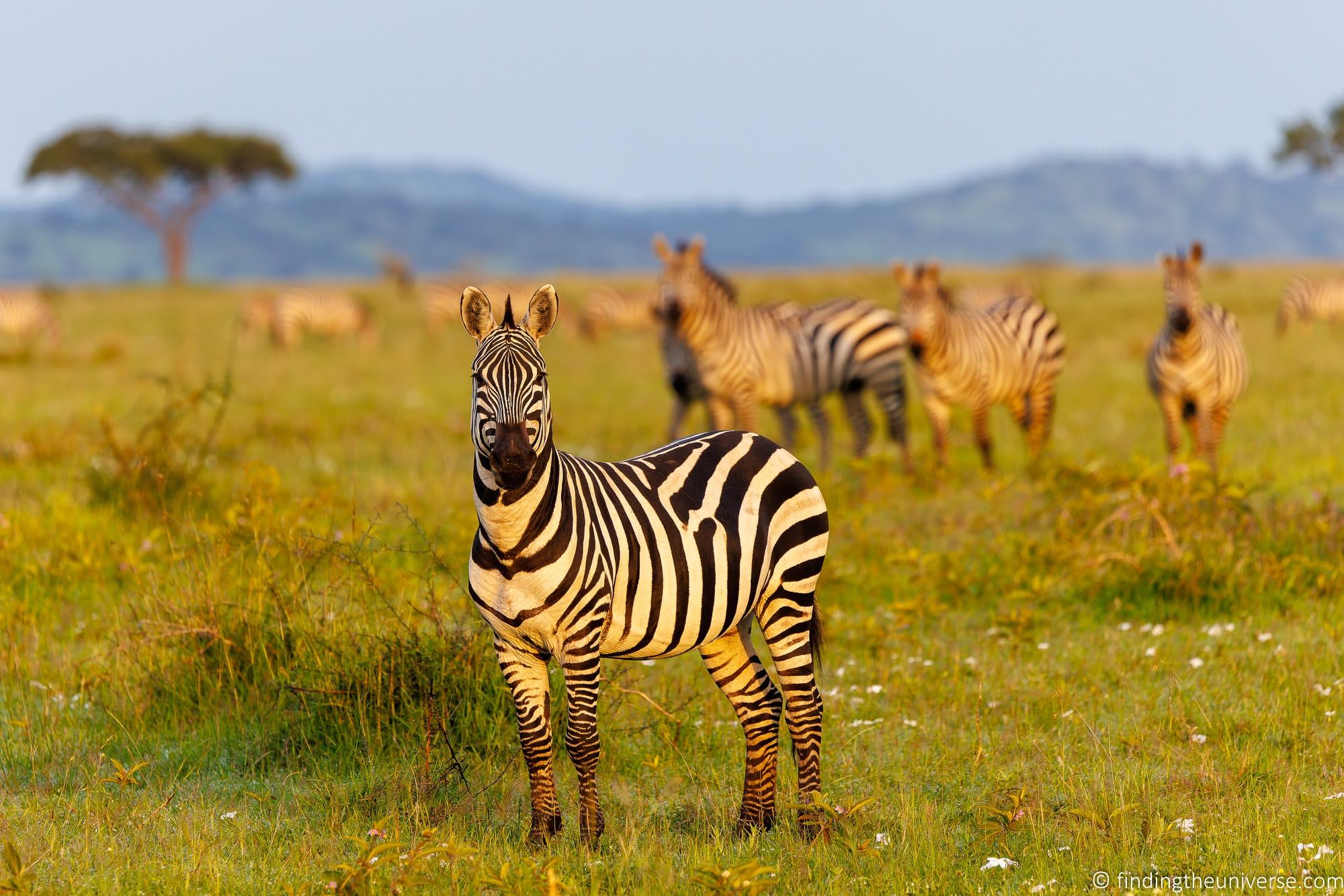
To start with, the majority of animals are going to be more active earlier in the morning and then towards the evening. The middle of the day tends to be hotter, and is a time when many animals are likely to be resting in a nice shady spot.
You will tend to see fewer animals in the hottest part of the day and those you see will tend to be less active during this time.
If you are looking for nocturnal species like genets, bushbabies, or aardvarks, your best chances to see them are on night drives or night walks, or to try to go as early in the morning as you can for a chance to spot them before they have gone off to sleep.
Just note nocturnal animals can be pretty tricky to see in most national parks given the hours that you are allowed to do a game drive. Getting good photos of them can be very difficult given they are often spotted at night.
We recommend trying to start your game drives as early as the park will allow. This will give you a better chance of seeing more wildlife, and also getting better images of that wildlife.
Another reason to avoid the middle of the day is that as the air heats up it gets more hazy. Think of the heat shimmer you see on a hot day—this is a real issue when shooting during hotter days and can negatively impact your images.
The haze will result in less sharp images, especially of further away subjects. In addition, as the day progresses, there will often be more dust in the air from vehicles driving around, which also reduces the clarity in the air.
Of course, I appreciate that I am talking about ideals. It isn’t always possible to pick the ideal time. Sometimes you will be out in the middle of the day. In these situations. Try to get as close as possible to your subject, which will let you avoid more of the heat haze. Where possible, shoot your subject so the sun is behind you rather than behind your subject.
The below two images are of the same black rhino mother and calf in Kenya. Both were shot in the middle of the day. In the first shot, the pair were quite far away and there was quite a lot of heat haze, meaning the shot ended up not being as sharp as I would have liked.
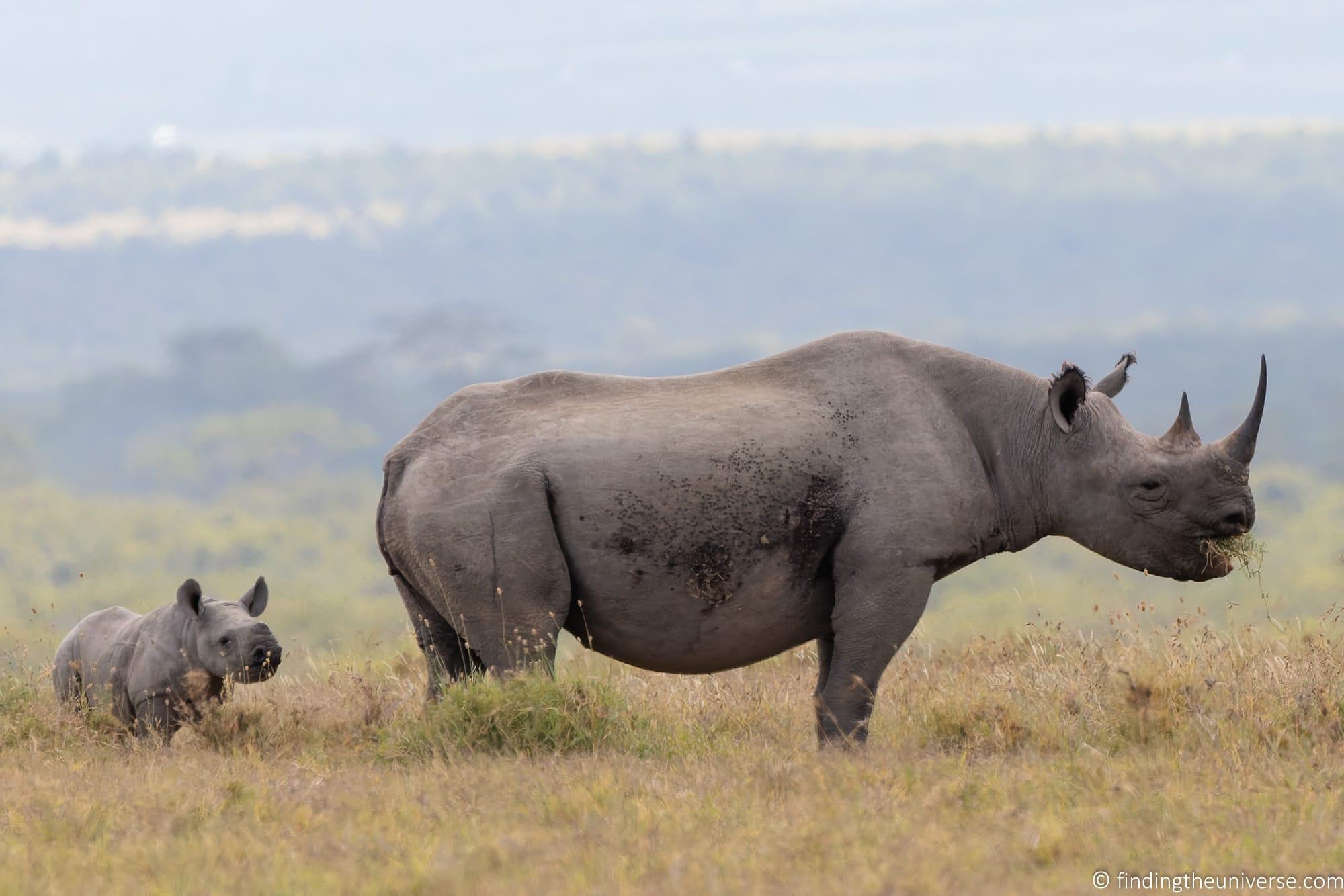
In the second shot, the pair moved much closer to us and the light was slightly improved, so there is some depth from the light and dark. It’s still not the ideal setup, but it’s definitely improved compared to the flat and slightly hazy look of the first shot.
See more on heat haze in photography here , including more tips for identifying and avoiding it.
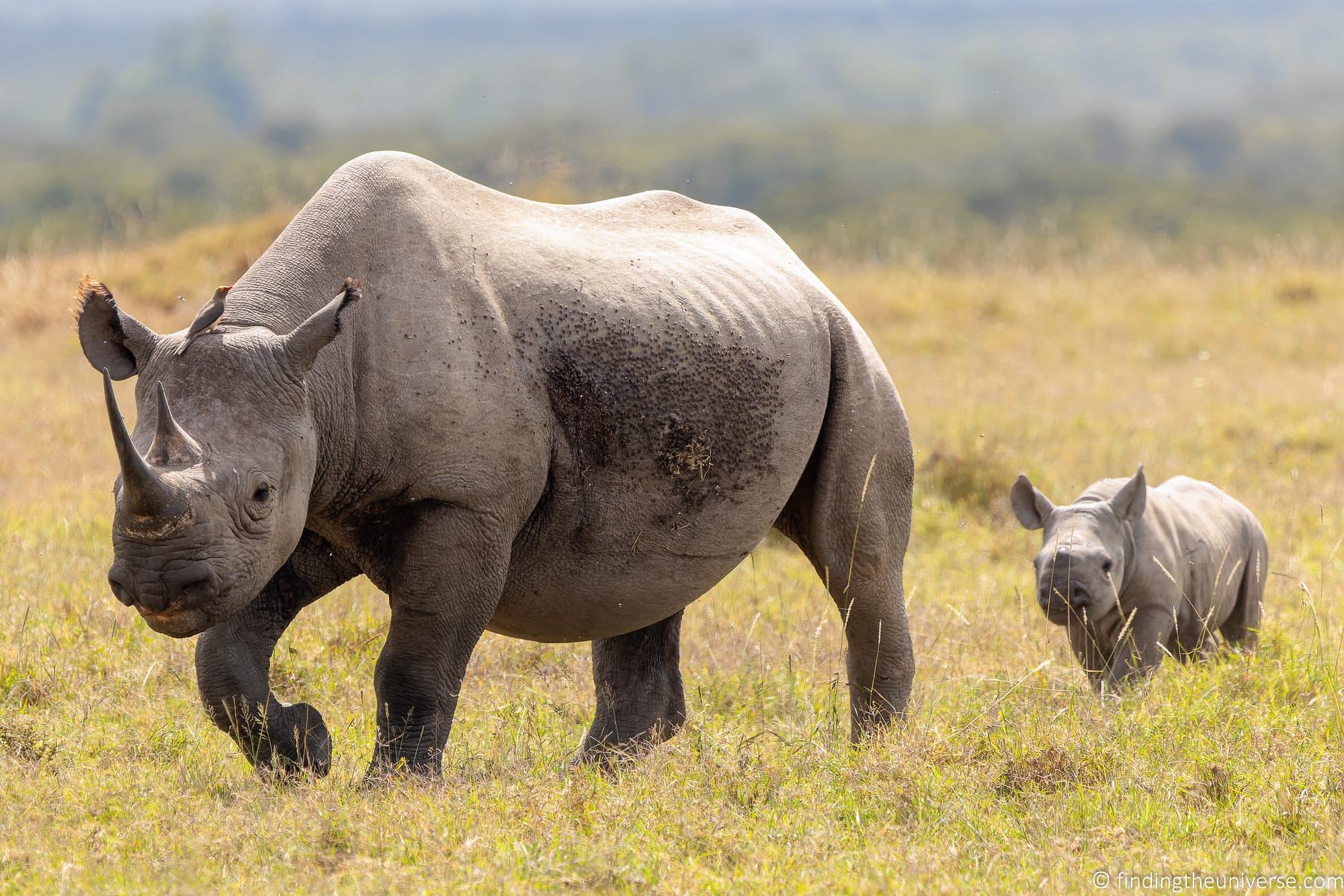
This brings me on to my next tip for getting great photos on safari.
Any wildlife photographer will likely tell you that their most useful skill is patience. When doing landscape photography , I am certainly used to waiting for the right light, but wildlife photography definitely takes the need for patience to a new level.
Wild animals tend not to move to our schedules. They go where they want when they want. Being patient and quiet can reap huge rewards when it comes to photographing them in their natural habitat.
An example is of this leopard in a tree. When we arrived, it was asleep in the tree by its kill. However, we waited for around an hour and it decided to get up, eat more of its kill, descend from the tree and wander off. All these moments provided better photography opportunities than the initial one, and just required patience.
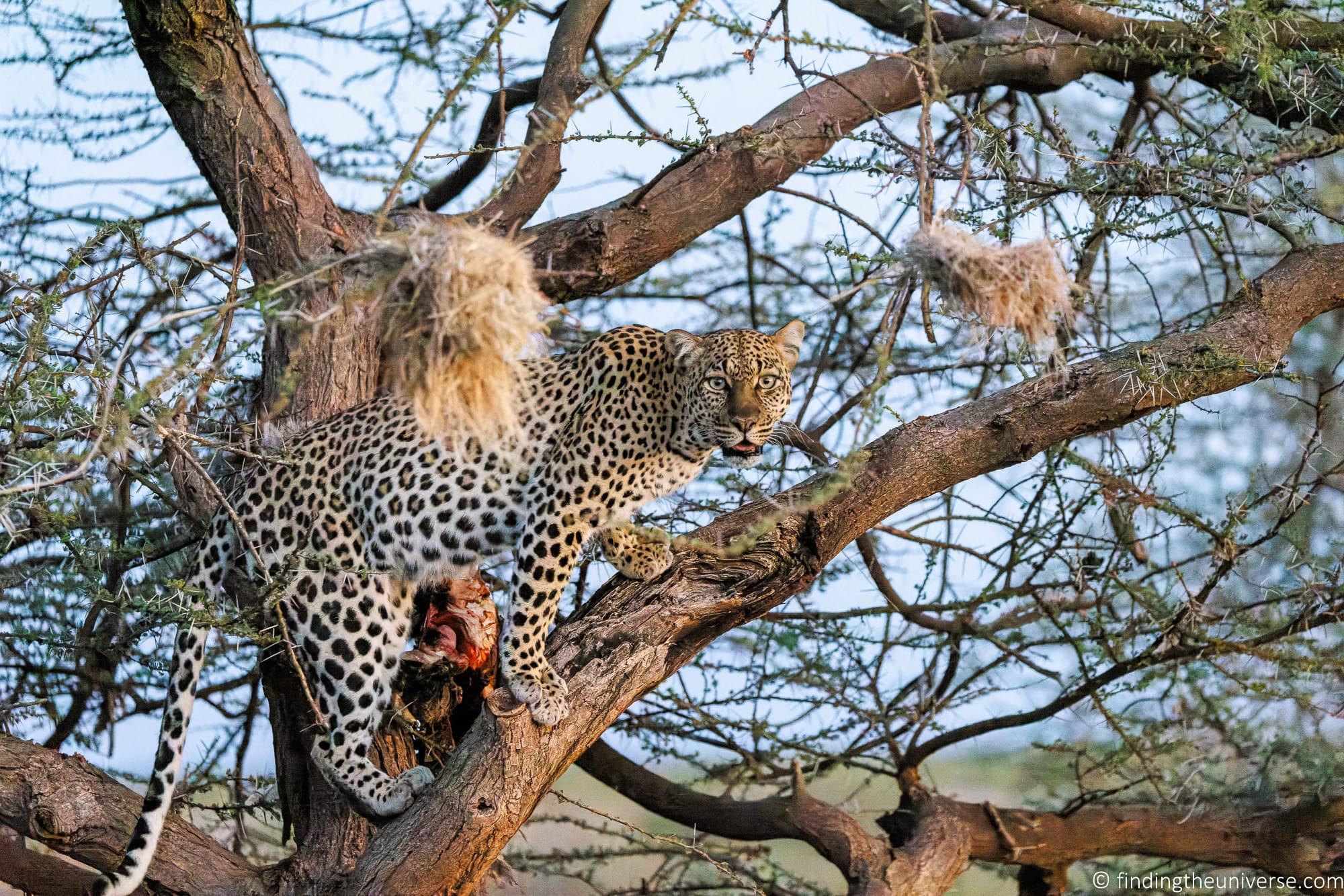
Another example would be a group of lion cubs we encountered in Tanzania. There were eight of them playing near the road, and as we watched two of them climbed up a tree. Shortly afterwards, one of their mothers returned, and we were rewarded by the sight of baby lions bounding across the grass to be reunited.
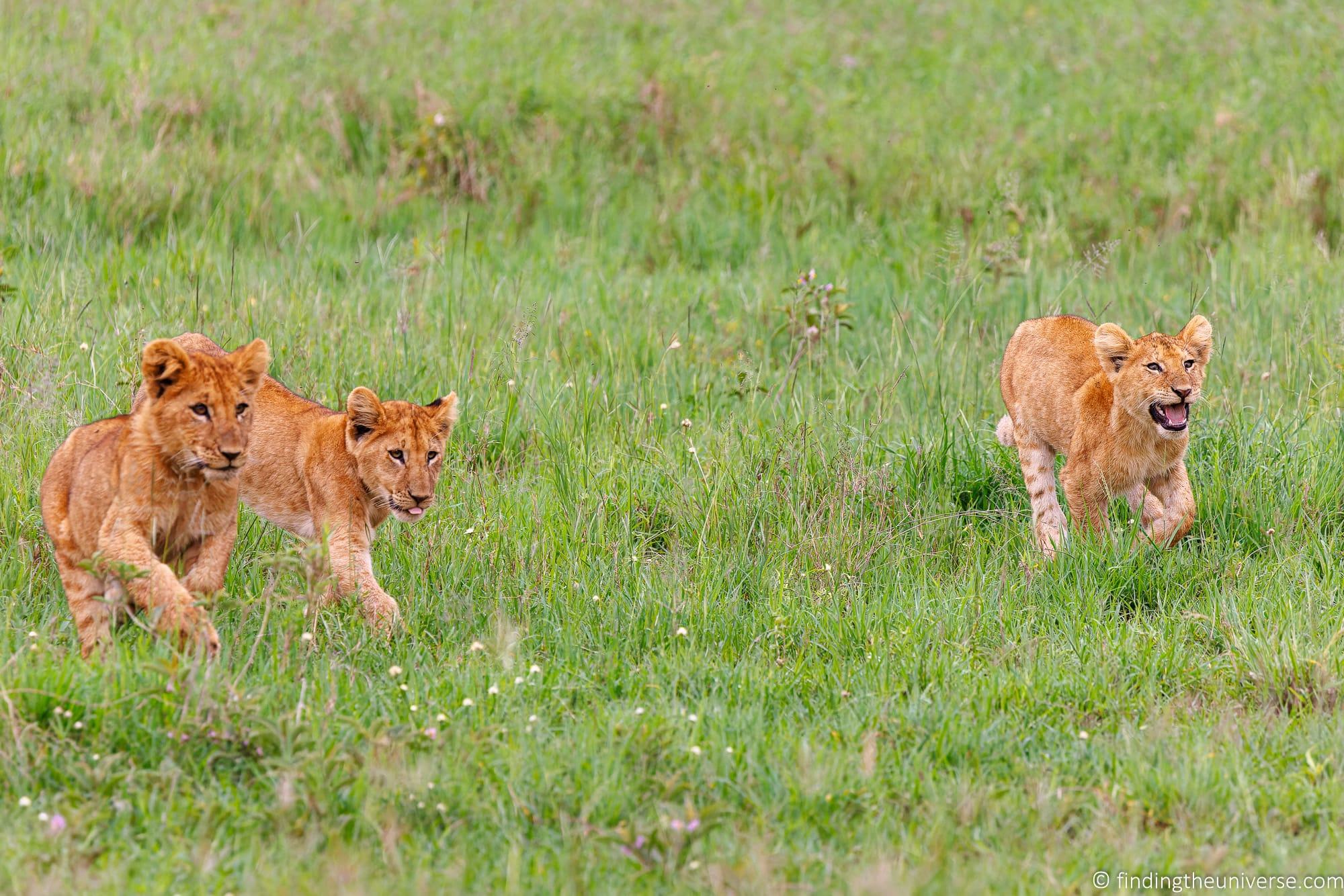
This is a story I could repeat multiple times across many wildlife encounters, but the overall message should be clear. Try to remember that a safari game drive is not an exercise in getting somewhere.
When you find an animal or bird you want to see, you will probably be rewarded if you spend some time just sitting and watching it rather than rushing on to try to find something else.
Prepare Your Equipment
If you already have a camera that you plan to take with you on safari, you want to make sure it’s in great working order before heading on safari. This is especially the case if you have older gear or gear that gets a lot of use.
Before you go, I recommend testing and cleaning the camera yourself to make sure it’s working. You’ll also want to make sure all the gear from your lenses to your camera straps are in good shape before your trip. Your trip is not a good time to learn about a preexisting scratch in your lens, a corrupted memory card, a fraying strap or a battery that doesn’t hold its charge!
You might also consider taking your camera to have a professional clean and check before your safari. Often you can do this at a local authorised dealer or repair shop for your camera brand, as they will have servicing options. Alternatively, your manufacturer might offer mail-in servicing options.
I try to get my cameras serviced every year or two, especially if I know I’ve been hard on them. As well as cleaning the sensor professionally, they check the camera over and make sure things like seals and screws are all in good working order. In my opinion this is well worth the investment, especially on high-end equipment.
Protect your Equipment on Safari
Safaris can be really hard on camera equipment. From dusty conditions to bumpy roads, there are all sorts of hazards that can either damage your equipment or cause it to function less effectively. In this section, I’m going to talk about common issues you can expect to encounter and how to overcome them.
Dust or Sand
When it’s hot and dry, the roads will be dusty. As your vehicle and other vehicles travel on the roads they kick the dust up, and it gets everywhere. If you have the top down or windows open, expect dust to get on your camera equipment.
If you are traveling to a place where sand is a concern, such as a desert or beach, be careful as blowing sand can get into your gear and can also leave scratches on your lens if you accidentally wipe them. Never put your camera down in the sand as it can easily work its way inside.
Cameras contain a lot of sensitive electronics as well as some moving parts, neither of which appreciate dust or sand. In addition, if dust gets onto your camera’s sensor it can cause unsightly spots to appear in your images.
There are a few things you can do to minimize the impact of dust or sand. First, a good camera bag that you can put your camera in between uses will help to prevent general dust getting in. So when you are not using your camera, I’d recommend securing it in a case or bag.
Also be careful about where you set your camera. Don’t place it on the ground or other dirty surfaces, and don’t leave it outside for any longer than it needs to be outside.
Next, remember to use a lens cap if your camera lens supports them as this will help to keep the front element dust free. Just keep the lens cap in your pocket and place it on the camera whenever you are not using it. If your lens supports it, then a lens hood and a UV filter can also provide much needed protection.
If you are using a camera where you can change lenses, try to change the lens in a dust-free location if possible, such as in your hotel or when stopped in a sheltered place. Try not to change your lenses more than you need to when in dusty situations.
In addition, I’d recommend packing a small camera cleaning kit so you can get accumulated dust off your gear as you travel. I’d particularly recommend having a lens cloth, a brush, and a blower with you.
Once you are done with your safari and you have gotten all the amazing photos you wanted, you might consider getting your camera professionally serviced and cleaned to get rid of any errant dust and to ensure it’s back to full working order for your next adventure.
Not all safaris take place whilst in a closed vehicle. Sometimes you might be on foot or trekking, or in an open top vehicle. In these situations, even when visiting a country in the dry season, there’s always a possibility of rain.
Whilst some cameras do offer a level of weather-proofing or rain resistance, the majority are not fully waterproof. So having a camera rain cover to keep your gear dry like this is a good option.
I’d also recommend having a good camera bag or backpack with a rain cover where you can put your camera in between shots.
If you have a smaller camera like a compact camera or smartphone, something like a resealable freezer bag or clear dry bag can also work well to keep it dry.
Bumpy Roads
As well as dust and rain, another issue you will have to contend with will be bumpy roads. Most roads in safari parks are unpaved, and some of them can be very bumpy.
You definitely don’t want your camera equipment flying around the inside of a vehicle as this can damage it, and could even cause injury to the other occupants. I have a few suggestions to help avoid this scenario.
First, I recommend bringing along a good camera bag or case. Camera bags are specially designed to provide padding and protection for your gear, and many of them also come with rain covers. This means that you have somewhere safe, protected, and padded to put your gear in between shoots.
Personally I use Vanguard photography bags and I’ve been an ambassador for Vanguard for many years now. If you see something on their store that works for your equipment, you can save money using our exclusive Vanguard discount code. This will give you 20% off everything in the Vanguard store.
Just use the code FindingTheUniverse for your discount! This code works in the Vanguard USA, UK, Australia, Spain, and Germany stores.
When you are actually using your equipment, I recommend having a strong and comfortable strap to keep it secure around your neck or shoulders. I use the Peak Design strap system which has reliably kept my camera gear comfortably slung at my hip for many years now. You’ll want to find one that is comfortable for you.
I left my DSLR camera on the seat of our Land Cruiser on a trip and it fell on the floor after hitting an unexpected bumpy patch in the road. I was lucky that nothing was damaged but it sure made me more careful about either putting gear away in my bag or keeping it around my neck.
I also recommend that if you are someone like me who enjoys standing up in a safari vehicle, that you sit down or at least put your camera in a camera bag when the roads gets really bumpy. If your guide tells you to hold on or you see that you are going to be crossing a river, it is probably best for both you and your gear to sit down. This way you’ll have a better grip on your gear and avoid banging your gear on something or falling.
Dress Appropriately
Packing appropriate clothing is going to ensure you are comfortable and ready for the weather during your trip. Whilst it might not directly help you get better photos, comfort is a really important factor. When you are comfortable you will be able to focus on getting great photos rather than the temperature or the insects.
When choosing clothes for your trip, consider the climate, weather, and insects of where you are going as well as the activities you plan to do. You are going to pack very differently for a cool weather destination than a tropical one. You also need to pack differently if visiting a country during its rainy season versus its dry season.
In terms of photography specific clothing, you might want to consider having lots of pockets so that you have plenty of places to store things when standing in a vehicle and when hiking. This will give you quick access to things like extra batteries, lens wipes, and your lens caps.
There are a range of different vests you can get, including specialised photography vests . I personally prefer something a bit more versatile that I can use in a variety in situations, and I like the Scottevest products which have a lot of pockets and are great for travel in general. I find them particularly useful for airport travel as they have so many handy pockets.
Generally though, on safari I wear the NosiLife long-sleeve shirts from Craghoppers . These have lots of pockets and also come with built in insect protection and sun protection. They also dry very quickly.
Jess and I mainly wore Craghoppers tops and bottoms throughout the days where we were either in the vehicles on safari or were doing treks. This is the most common brand we’ve seen people wearing for proper safari clothing throughout our travels. You can shop for them on their official store here , as well as on REI in the US here , and on Amazon here .
Depending on where you are going, you will probably also want to consider packing a hat, sunglasses, insect repellent , sunscreen, good practical shoes (we generally wear Scarpa or Merrell ), layers for warmth, and a rain jacket or poncho .
For more tips, check out our detailed guide to what to pack for safari , which has lots more tips and suggestions for your trip.
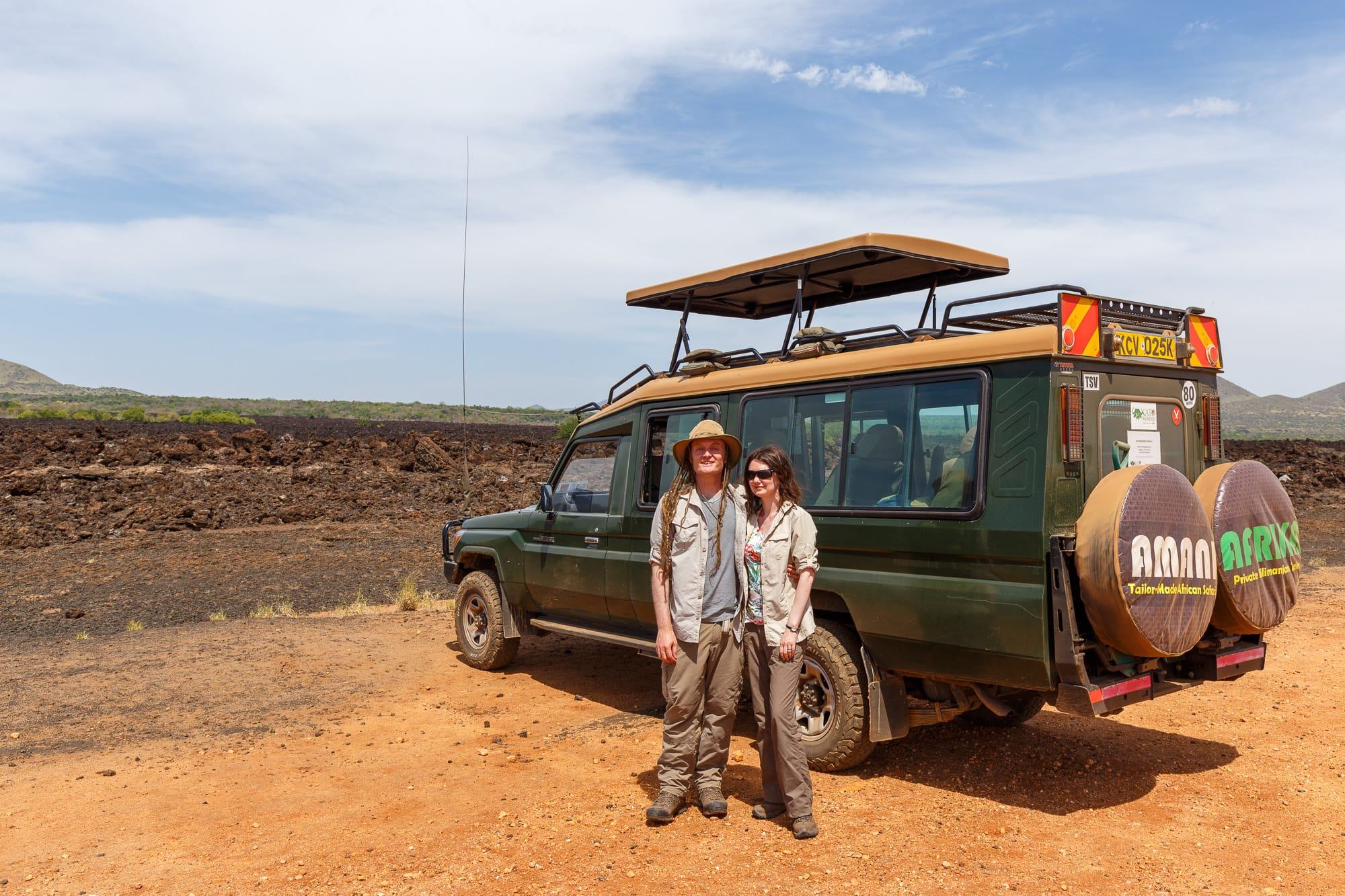
Pack a Photography Bean Bag
If you are traveling with a longer lens, I’d consider getting a photography bean bag or two for your safari trip.
For wildlife photography on safari, I find that a photography bean bag like this is one of the most useful photography accessories I have packed. Generally, I find I get a lot more use out of a bean bag on safari compared to a tripod or monopod.
This is because on safari you are often shooting from a vehicle, either from the window or via the pop-up top. And in both cases, setting up a tripod or even a monopod isn’t always going to be possible.
On the other hand, a bean bag can rest on the top of the vehicle or over a window, where you can then rest your lens or camera on it. If you are shooting with a larger camera and lens setup, you will definitely be thankful of having somewhere to steady it, as it’s unlikely to be practical to hold it up for prolonged periods of time. It also keeps you from putting your camera or lens directly on the metal edges of windows and roofs which could lead to damage.
Using a bean bag means you’ll be able to use slower shutter speeds for more stationary animals as well, so you don’t have to worry about camera shake so much. This is especially helpful when shooting with very big telephoto lenses from around 400mm and up.
Jess also found the bean bags useful for just using as armrests and for placing her elbows when using binoculars.
Bean bags are very light to travel with, and you can usually find inexpensive materials like dried beans to fill them with at your destination. My only tip is not to fill them with anything obviously edible, as some animals in some parks might sniff out the tasty treats within and decide to give them a nibble! Dried (obviously uncooked!) beans are a good option for this reason.
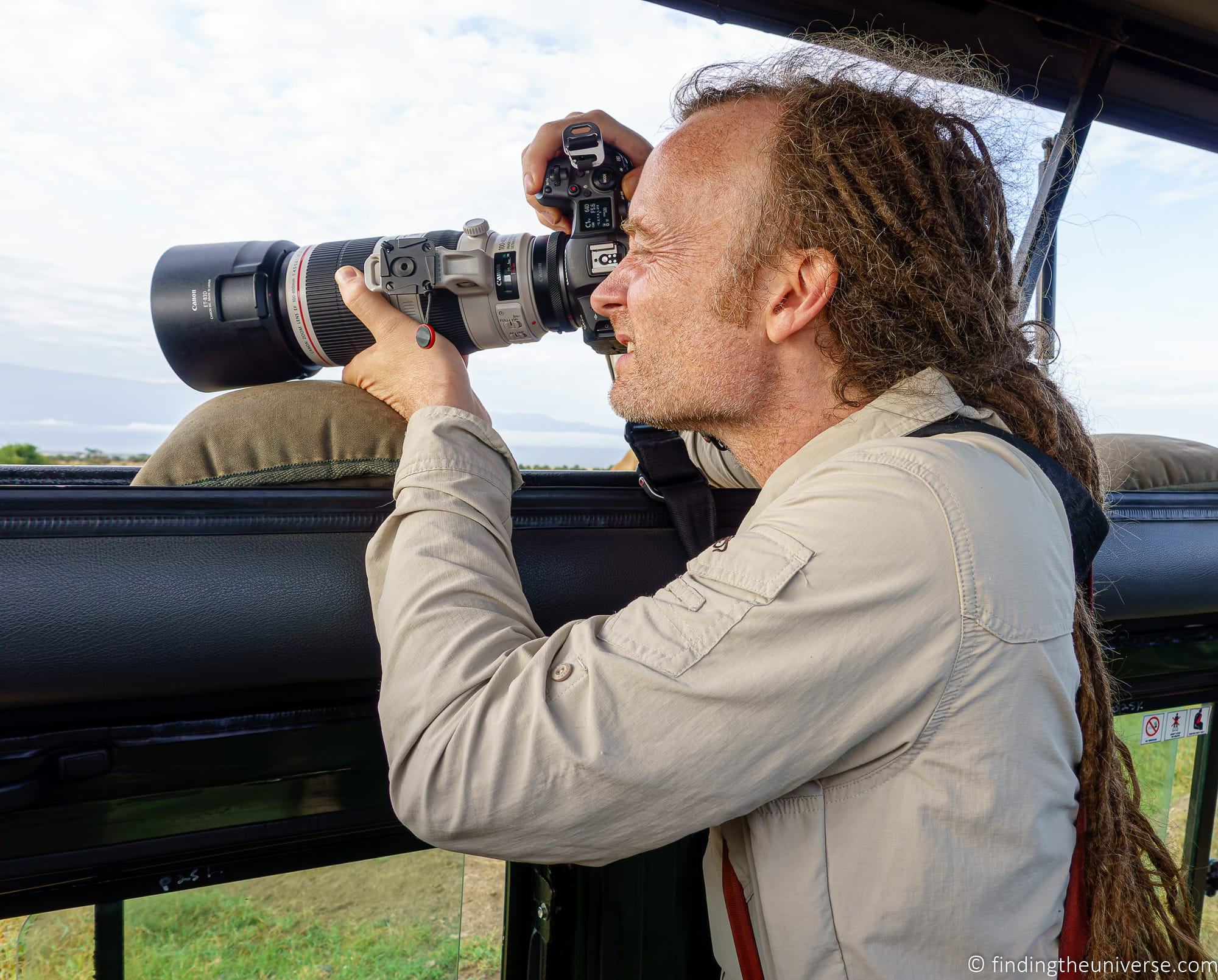
Be Specific About What You Want with your Guide
If you are doing a safari with a driver and/or guide, then being able to communicate about your goals and what you want to see is really important. It is also important for you to listen to your driver/guide for feedback and understand what is realistic based on their expertise. Doing this as early in the trip as possible is best.
If there’s a certain shot or composition that you want, it’s a good idea to let your guide know so you have a better chance of seeing it. Whilst there’s never a guarantee of seeing any wildlife on safari, if you specify that you want a shot of an elephant bathing for example, then your guide should have an idea of where the best places to get that shot might be on your trip.
If you aren’t clear on your interests, then you’ll be on more of a general safari and taken on the common safari drive circuits within the parks. Guides will almost always drive you to see things like lions or cheetahs if spotted, even without asking you. However, if you’d rather photograph elephants, eagles, or zebras, then you need to speak up so that you guide know what your wildlife sightseeing priorities are for the trip.
Whilst you will still likely get great photo opportunities (your guide is there to take you to see wildlife after all!), it might not be exactly the shot you want. So being specific will definitely help improve your chances of getting the shots you want if you have something specific in mind.
Another thing we discussed with our guide from the beginning was to have signals about stopping and when to leave after stopping for a wildlife sighting. So we asked our guide to just ask to make sure we wanted to leave an animal or we’d tell him, or he’d give us a head’s up if we needed to leave.
This not only helped make sure we felt we had enough time to get the photos we wanted, but it also made sure we were prepared for any sudden jerks from stopping and starting the vehicle.
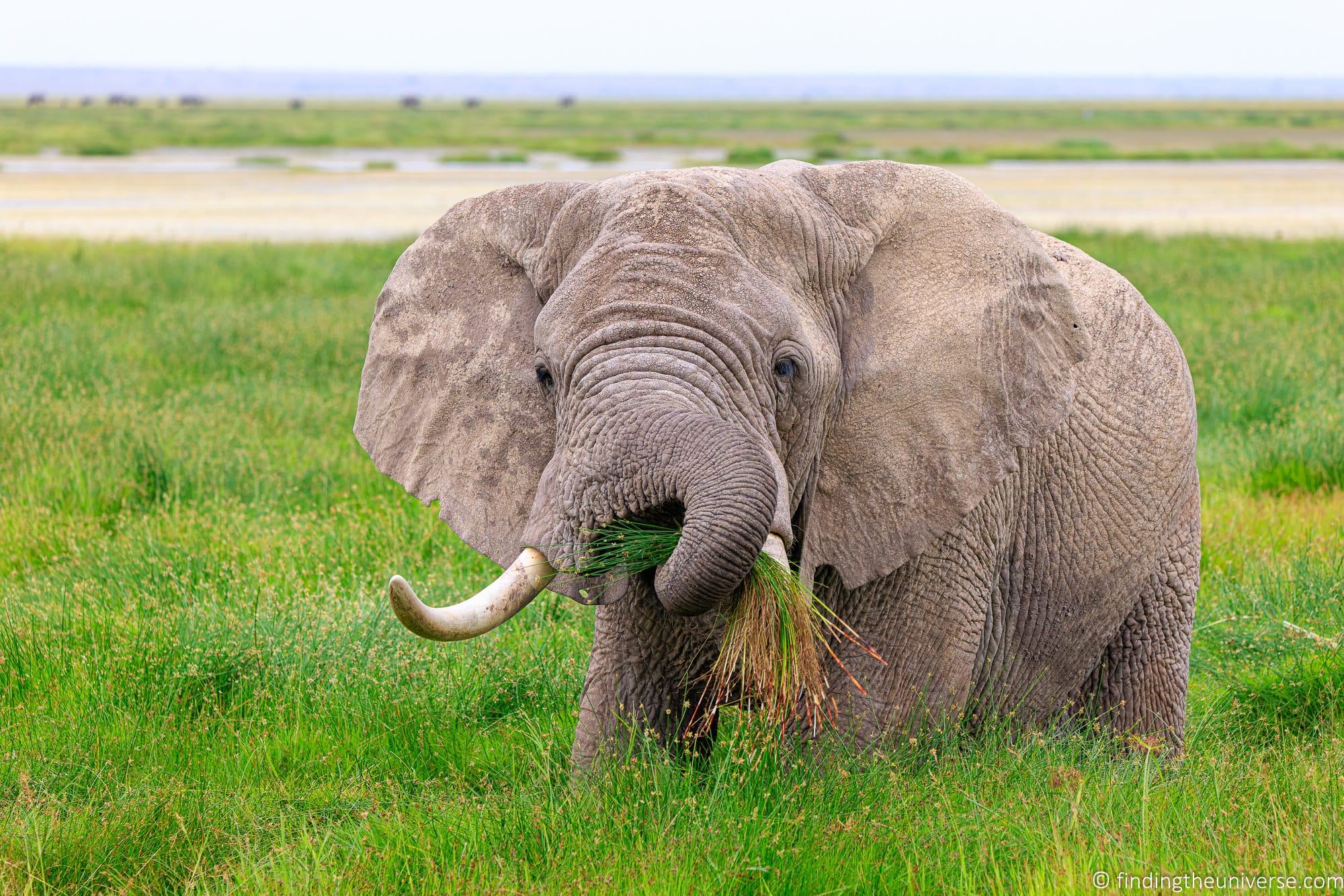
Communicate with your Fellow Travelers
If you are traveling solo, then you will of course have a lot of autonomy in where you go and what you see on your trip. If you have a driver/guide then the two of you can set times and itineraries each day and be in sync about your wildlife spotting goals.
But, if like most safari goers, you are traveling with a partner, your family, friends, or as part of a group safari with other travelers, then you will likely have to be willing to compromise at times.
Common things you will likely need to decide on together will be what time to leave, how long to spend on game drives, whether to eat a hot lunch or a picnic lunch, and how long to spend watching each animal.
This can also affect your ability to get the photos you may want in terms of timing and views from the vehicle. With just one or two people in a vehicle, it is generally easy to find a good view, but once you have 4 or more people, it often becomes difficult for everyone to have a great view all at the same time, especially if an animal is not in an open area.
Generally, in these circumstances everyone will politely take turns and give everyone a bit of time and space to view the animal and take photos. But this does mean you will need to compromise and will sometimes miss the “best” view.
However, group safaris by far offer better value in terms of money compared to a private safari. But just note that they do come with some compromises.
I definitely recommend traveling with family or friends if that is an option, as sharing these experiences is probably worth more than taking a good photo. But it is worth talking about everyone’s goals and travel style before booking your trip to make sure everyone is likely to have a good trip.
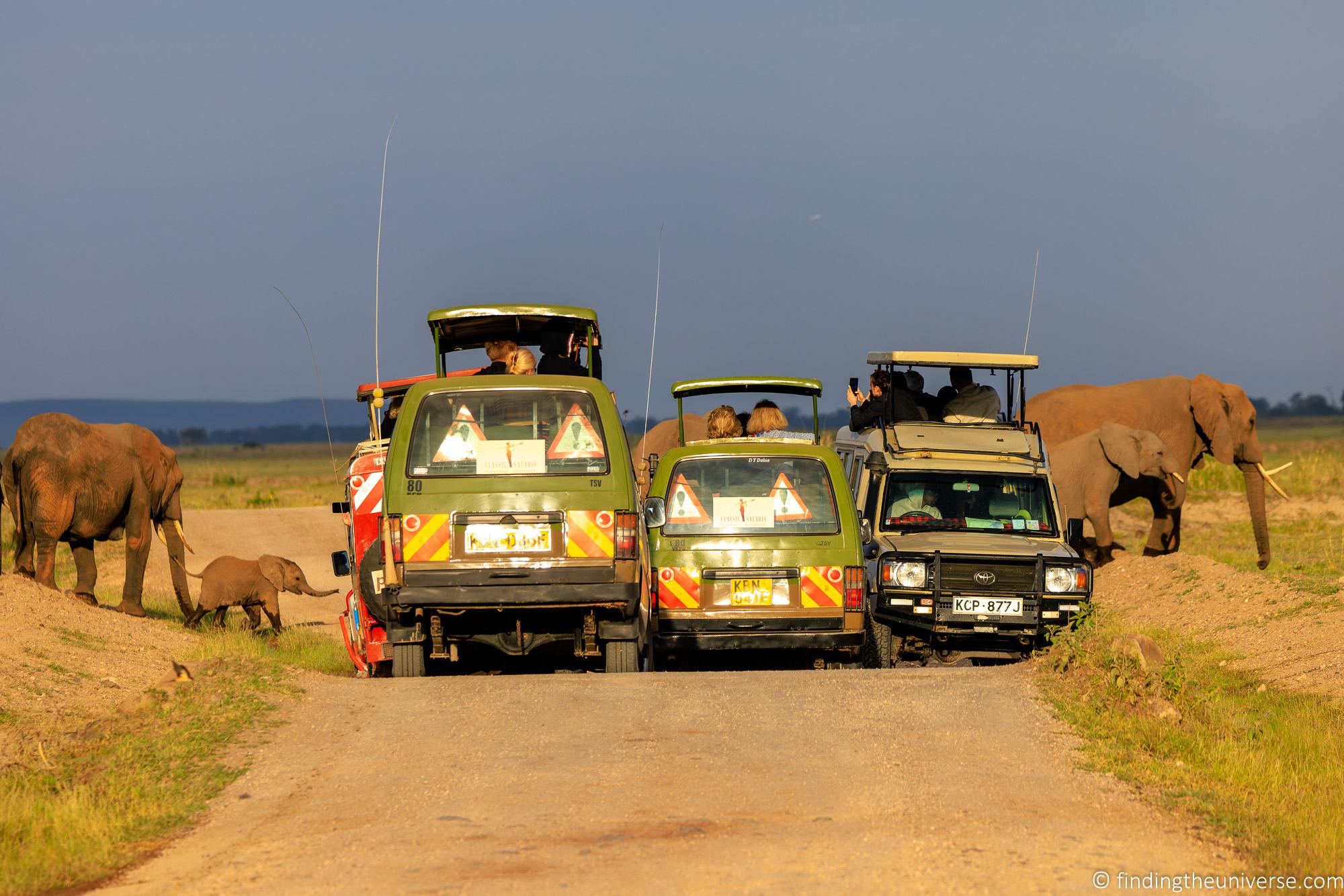
Consider the Composition
As with any kind of photography, composition is key. Composition refers to how you place the various elements in your shot to create the final image.
It can be easy to get caught up in the moment when you see something exciting, and just to start shooting in an effort to get something shot. This excitement is very understandable!
However, if you are able to calm yourself down a bit and spend a fraction of time properly composing your shot, you will likely get better results.
There are a range of general composition rules in this post that you can read about, so I won’t rehash that. The main things I’d suggest just keeping in mind are the following.
- What’s in shot . When framing your shot, glance around the whole frame to see what is and what isn’t in the shot. For example, it can be very easy to frame an animal’s head, but accidentally crop out parts of their body or a tail. Whilst this might be the composition you are after, it might also end up looking a bit odd. Sometimes, zooming out a fraction and ensuring the whole animal is in the frame might be a better composition
- Eye contact . There are many different wildlife poses you can capture, but one of my favourites is when the animal is looking directly into the camera. In this pose, it will appear to be directly staring at the viewer. This is not always easy as animals tend to look all over the place. In these scenarios, burst mode and patience can be your friends.
- Animal Placement . When shooting from a vehicle, especially from the pop-up roof area, we can often end up above the animal. However, often animals look better when shot from eye level. So repositioning yourself to shoot from an open window lower down in the vehicle might give you a better shot, depending on the distance to the subject.
- Background and skyline . When putting your shot together, don’t forget to consider the background. For example, a deer against a brown rock face or tree will not stand out as well as one against a skyline. It’s not always possible to reposition yourself, but if there is the opportunity to wait for a better composition, or move the vehicle to a different location, take it.
Here are a couple of shots to illustrate my points above.
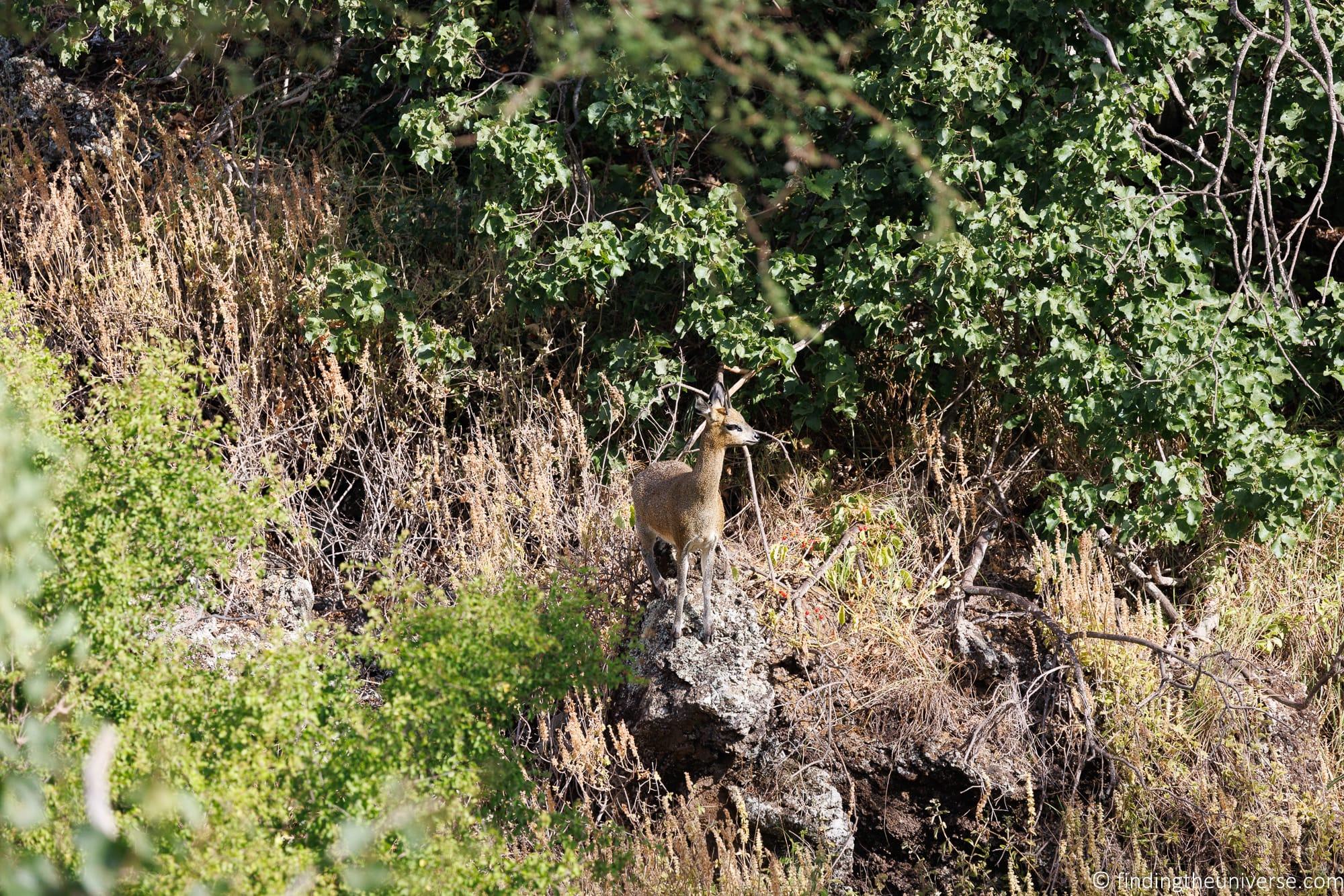
Don’t Forget the Landscapes
One of the main reasons people go on safari is to see the incredible wildlife of an area. However, it’s also very likely that you are going to be passing through some amazing natural landscapes.
Whilst it can be easy to get a bit single-minded about what we’re photographing, it’s important to step back and capture the landscapes as well as the wildlife.
If nothing else, this will serve as a reminder for you in the future as to where you were when you got the shots, and also the lovely scenery you witnessed. Capturing the wildlife with the landscape is also a good option, as it will give some depth and scale to your compositions.
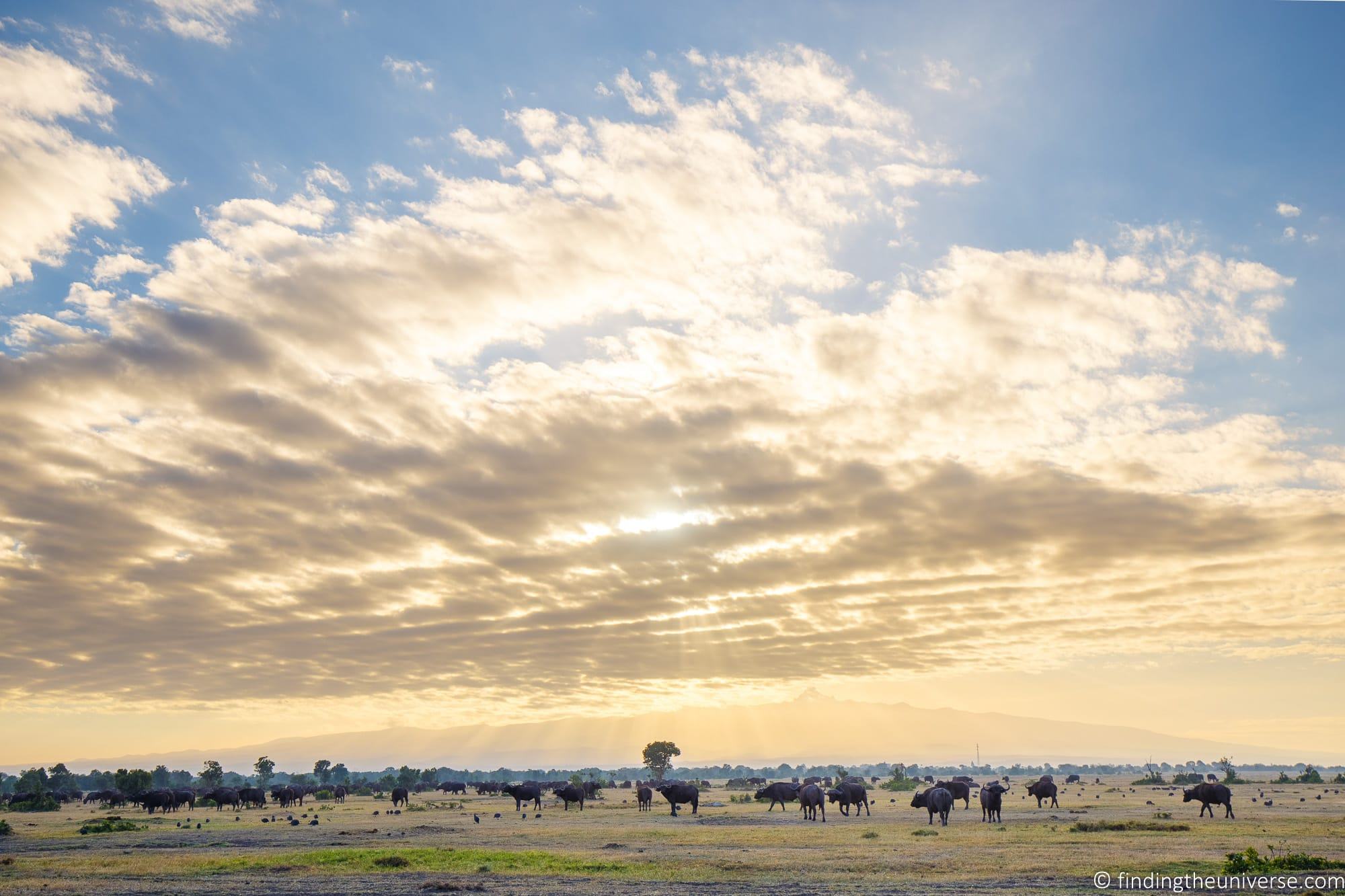
Pack Spare Memory Cards and Batteries
The chances are that you are going to be taking a lot of photos when on safari. If you are shooting with anything other than a smartphone, your camera will likely have a battery you can change and a memory card slot.
It is definitely worth bringing at least one spare battery for your camera, and ideally two. In addition, bringing plenty of memory is also a good idea.
You don’t want to be half way through a busy day and run out of battery or memory card space, and then potentially miss some great shots. Modern mirrorless cameras in particular can eat through batteries, so a spare or two is definitely a must in my opinion.
Consider bringing a USB Powered Battery Charger and Power Pack
Accommodation options on safari can vary greatly, from simple campsites to high end luxury safari lodges. One thing we have found is that not every accommodation, especially the more remote and basic ones, will have AC power outlets. Or at least not one in your room (there is usually at least one public shared power outlet somewhere in a lodge or campsite).
If they have wall outlets, they will likely be 220V-240V, so you will want to check that all your equipment supports this if you are coming from a country like the USA, Japan, or Canada which has 110V-120V power. Many people will also need a travel adaptor to adapt your plugs, depending on where you are coming from and your travel destination.
However, rather than full power outlets, many locations offer USB outlets. These don’t use so much electricity, and are often powered by solar panels.
What this means is that if your camera only has a standard wall outlet charger for its batteries, you might not be able to charge them. Note that some cameras do charge via USB, so do check if that is the case.
So we recommend making sure that you are able to charge your batteries using both the local AC power outlets and via USB so you can take advantage of either charging option. We also recommend considering packing a power pack.
We personally travel with a USB battery charger for our Canon camera batteries. This is better than our standard charger in some respects, as it can charge two batteries at once, and charges over standard USB. There are a number of different models available , the main thing is to find the one that matches your camera battery.
As well as the USB battery charger, we also travel with a USB power pack . We can use this to charge all our USB powered devices, including our phones and the USB camera battery charger. This is helpful when we have periods of time without power.
Ask About Your Safari Vehicle
Before you go on safari, it’s a good idea to check with your safari company about the type of vehicle you will be in. There are a number of different models that companies use in different locations around the world, with Toyota Land Cruisers being the 4X4 vehicle of choice for many companies. However, there are many different models of Land Cruisers used for safaris so knowing the specific model can be very helpful.
The same vehicle model’s features can also be different across companies depending on the specific conversion. Probably the most important thing for most people is the number of seats, luggage space, and the configuration of the top.
We highly recommend a vehicle with a pop top. This means the top of the vehicle will pop up, allowing you to stand up inside the vehicle and get a better view, as well as better photos.
For the majority of these vehicles, the top pops up and remains over your head, providing much needed shade. However, in some vehicles, the tops actually come off completely, so you won’t have any shade.
We highly recommend a vehicle where the top doesn’t come off completely, as otherwise you are going to be in the sun a lot.
It’s also a good idea to check on the height. In some of the vehicles we have found that even when standing up, the lip is a little high for Jess to get a good view. So if you are shorter (or very tall) you should definitely check about this if you really want to be able to stand up for game viewing.
Another thing to check is whether or not the vehicle has charging points (some have standard wall outlets whilst others might have USB outlets). Some of our vehicles have had this, some didn’t, but it is becoming more common.
If you are planning a very photography focused safari, you can also ask if the vehicle has any photography specific features. Some of the vehicles we’ve travelled in came with photography bean bags for our use for example, which was very helpful.
Other special features might include special camera mounts, tripod mounts, the ability to fully open or remove windows, and even the ability to remove a door or two. I wouldn’t expect most of these features unless you are paying extra for a special photography trip.
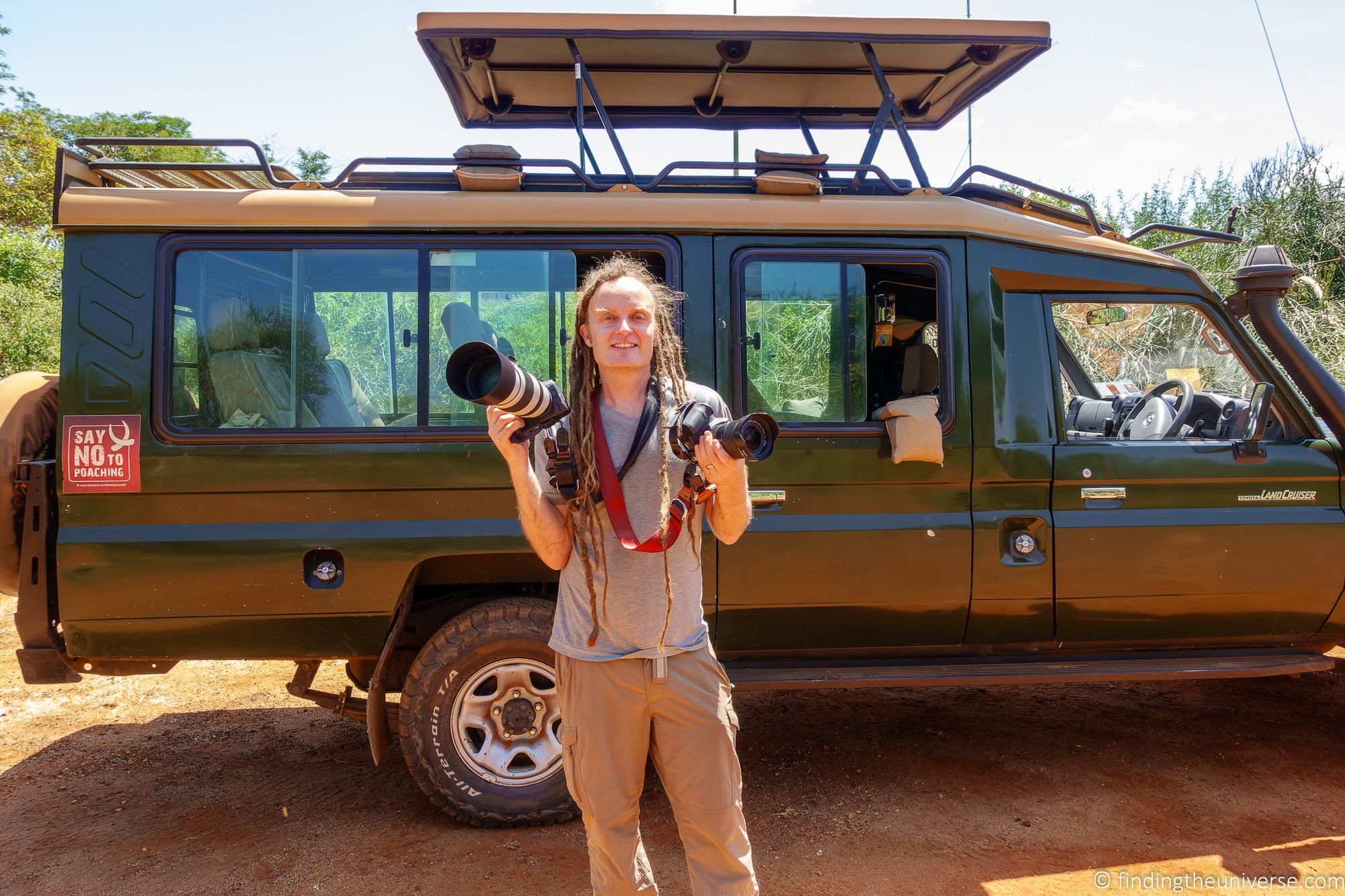
Consider Doing Boat and Walking Safaris
Whilst most safaris are done from a 4×4 vehicle, there are other options depending on where you are travelling.
For example, in some locations you might be able to do a walking safari or a boat-based safari. These will give you some variety as well as present the opportunity to see different wildlife.
For instance, if you are interested in birds and small creatures (e.g., dung beetles, lizards), then walking safaris are often going to be better for getting close to these animals. Boat safaris are going to obviously be the best way to get closer to aquatic wildlife.
Of course, this isn’t always going to be possible depending on where you travel, but we definitely recommend signing up for at least a couple of these experiences if you have the option.
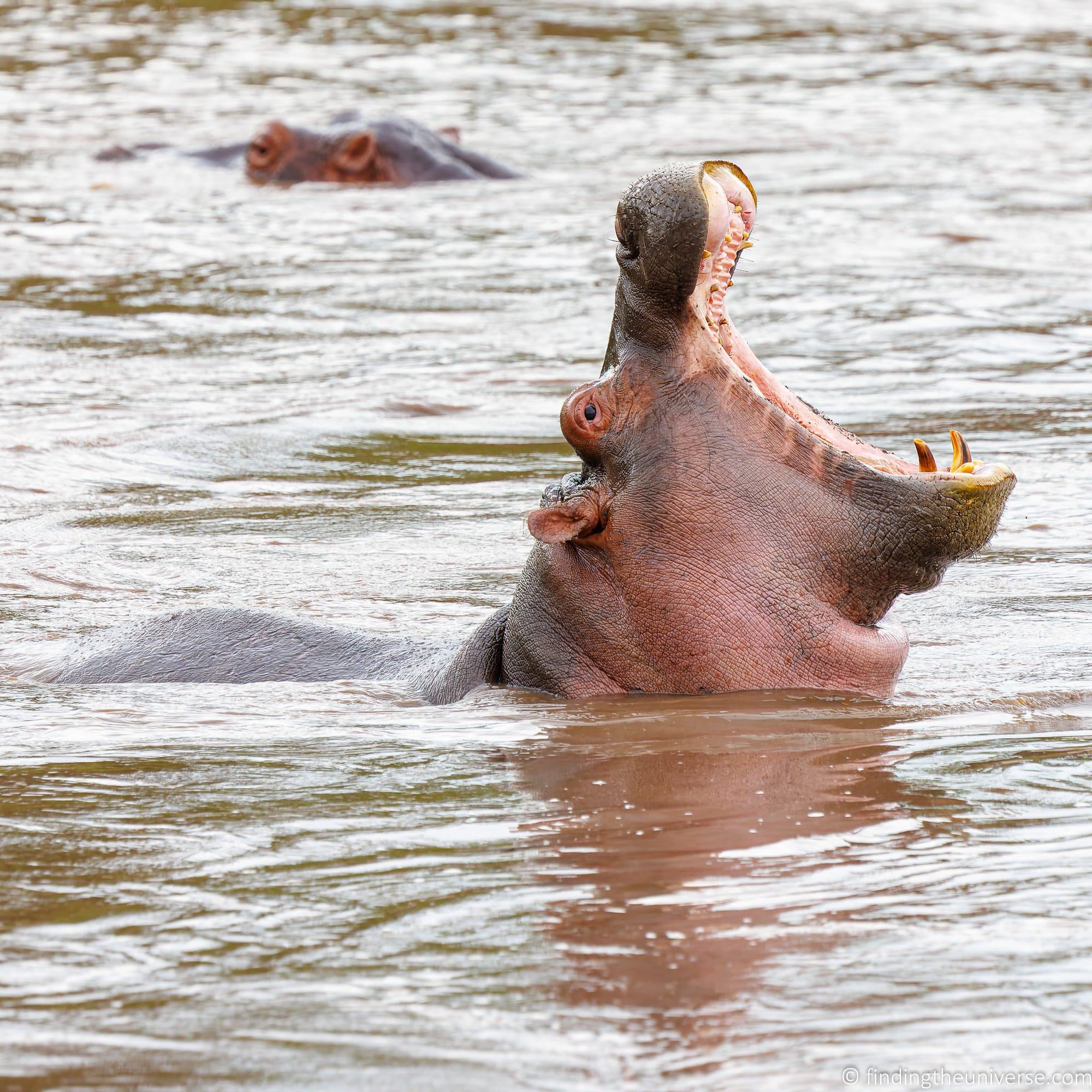
Shoot in RAW
If your camera supports it, and nearly all do these days, I highly recommend setting it up so it saves your image files in RAW format. Whilst this takes up more memory, and does require you to edit your photos, you will get a lot more latitude when it comes to editing your final image.
I go into a lot more detail in why to shoot in RAW in my guide to RAW in photography . For now, I recommend enabling it. Most cameras have the option to shoot in both RAW and JPG if you need a stepping stone, although this will take up more memory card space.
However, if you want to be able to share your photos instantly online during your trip, then you will probably want to also shoot in JPG/JPEG because you don’t need to edit them prior to uploading them.
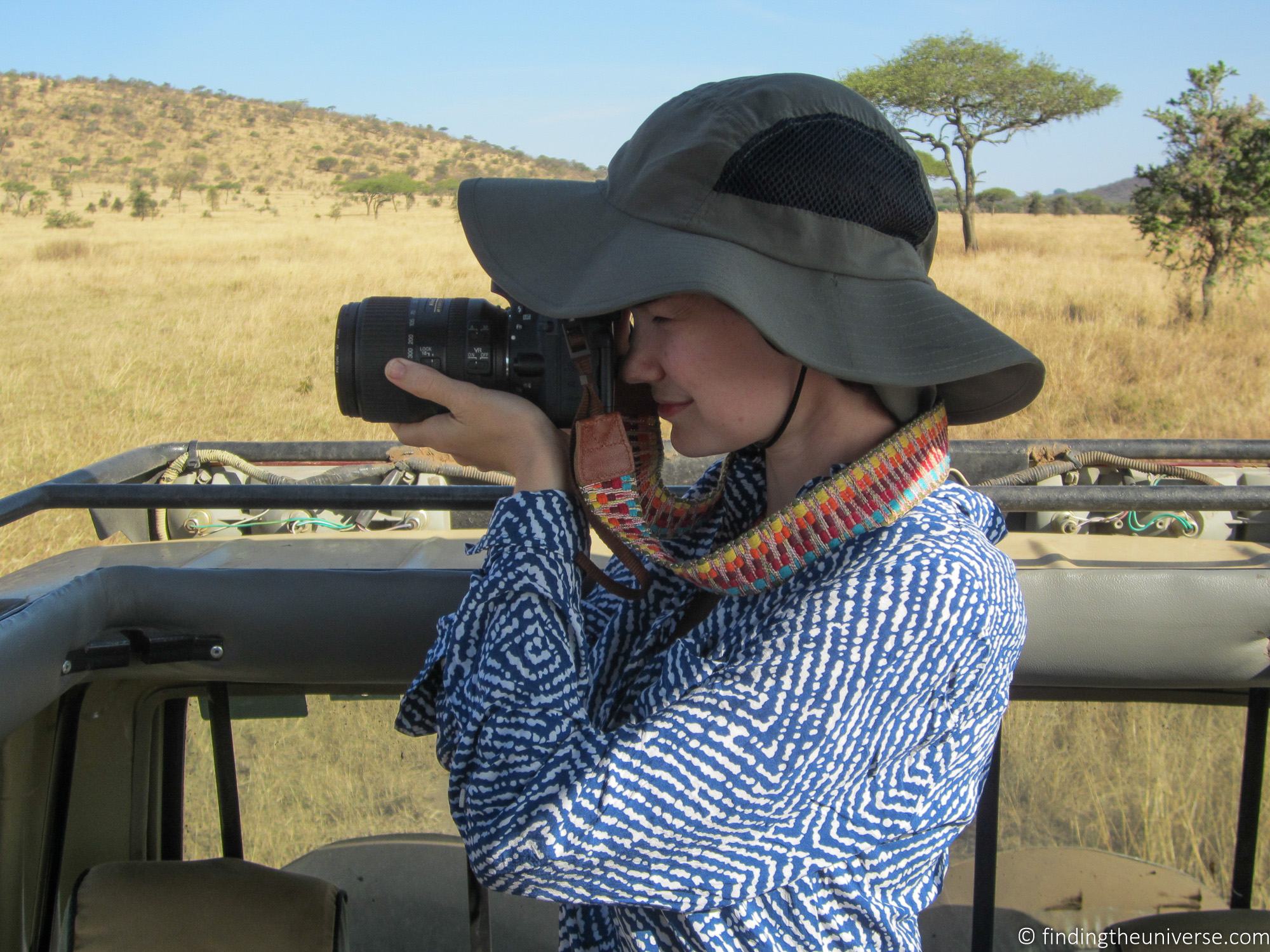
Learn to Edit Your Photos
Photography involves a number of skills. The first two are in the field when you’re getting the shot, and require you to know how to compose a great photo and how to use your camera.
The third skill is photo editing. Photo editing is where you can get the most from the images you have captured. This doesn’t have to take a long time, even minor edits can make a big difference to an image.
Judicious cropping, adjustment of shadows and highlights, tweaks to saturation—these can all add up to really improve an image.
Of course, you can go a lot further with photo editing software. But as a starting point, loading up one of our favourite photo editors and learning how to use it can really help you get the most from your shots.
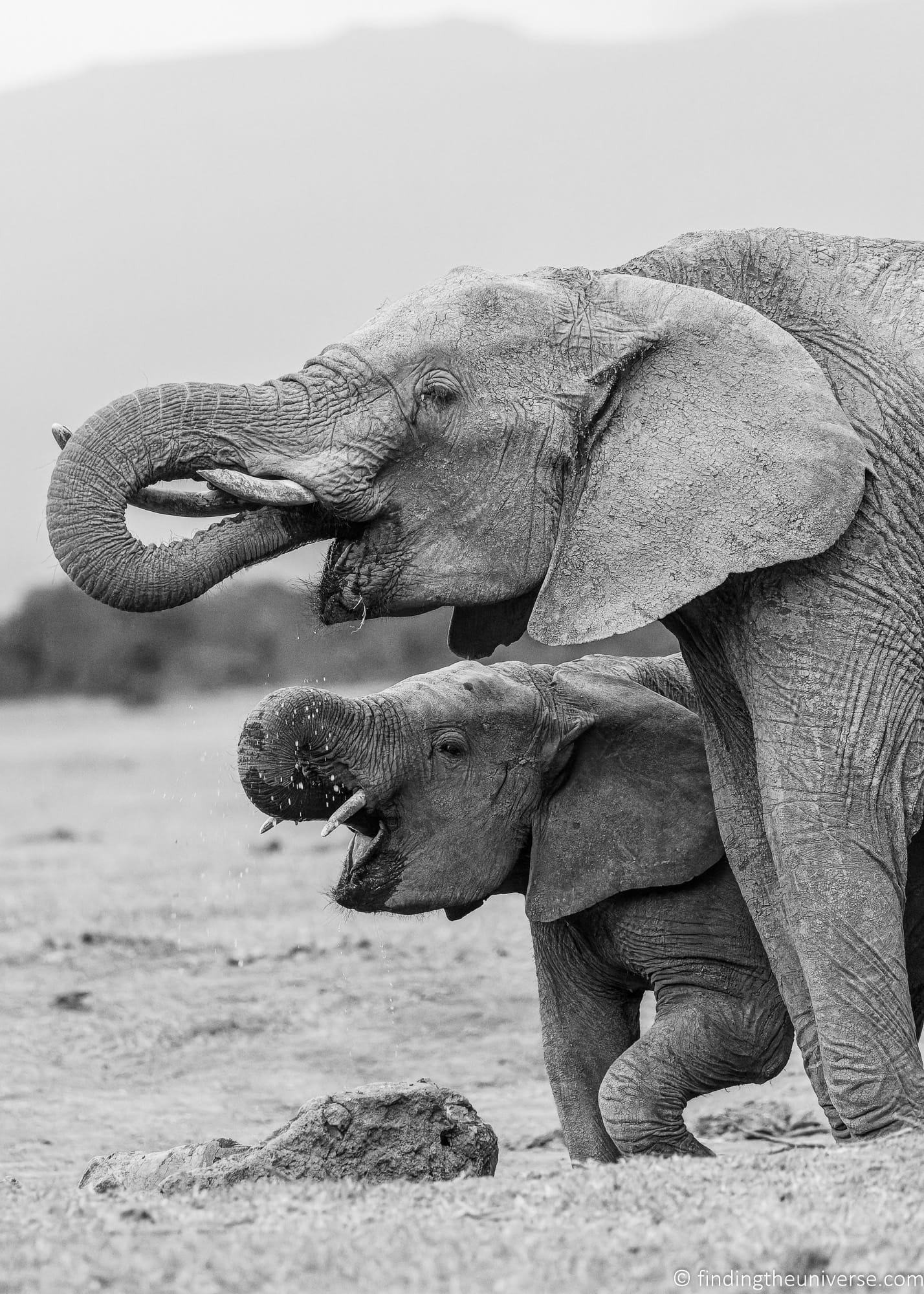
Keep Your Eyes Open
When you are on safari, the chances are that you will have a guide. Your guide will normally know what sort of wildlife you are likely to see in the areas you’re visiting, and they will of course be looking out for it as you drive or walk around.
However, the thing about wildlife is that you never know what you are going to see. And the more eyes that are looking for wildlife, the higher your chance that you will spot something. Your guide can’t look everywhere at once, and if they are driving, they are going to be at least a little distracted by operating the vehicle and keeping you safe.
In our most recent safari experience, we would often maximize what we could all see while on a game drive. So, generally our guide was seated in front in the driver’s seat, Jess would sit on the opposite side of vehicle from the driver, and I would stand at the back and scan for a different viewpoint. This way we were looking in many directions and had a better chance of spotting things. Although our guide was by far much better at spotting wildlife than we were, we still occasionally made some great spots that our driver had missed.
In my opinion, a safari should definitely not be a passive experience where you sit back and wait for something interesting to be pointed out to you. However, I have been surprised by the number of Land Cruises and Land Rovers full of bored-looking people who seemed to be spending more time on their phones or talking to one another than looking outside. They seem to simply wait for their driver to stop and point something out, take a photo, and then go back to their phones.
If you actively participate and spend your time searching for wildlife as well, you’re going to improve the chances of sightings and find more photo opportunities. You are also going to learn a lot more about the natural environment around you. And you are going to enjoy your trip a whole lot more!
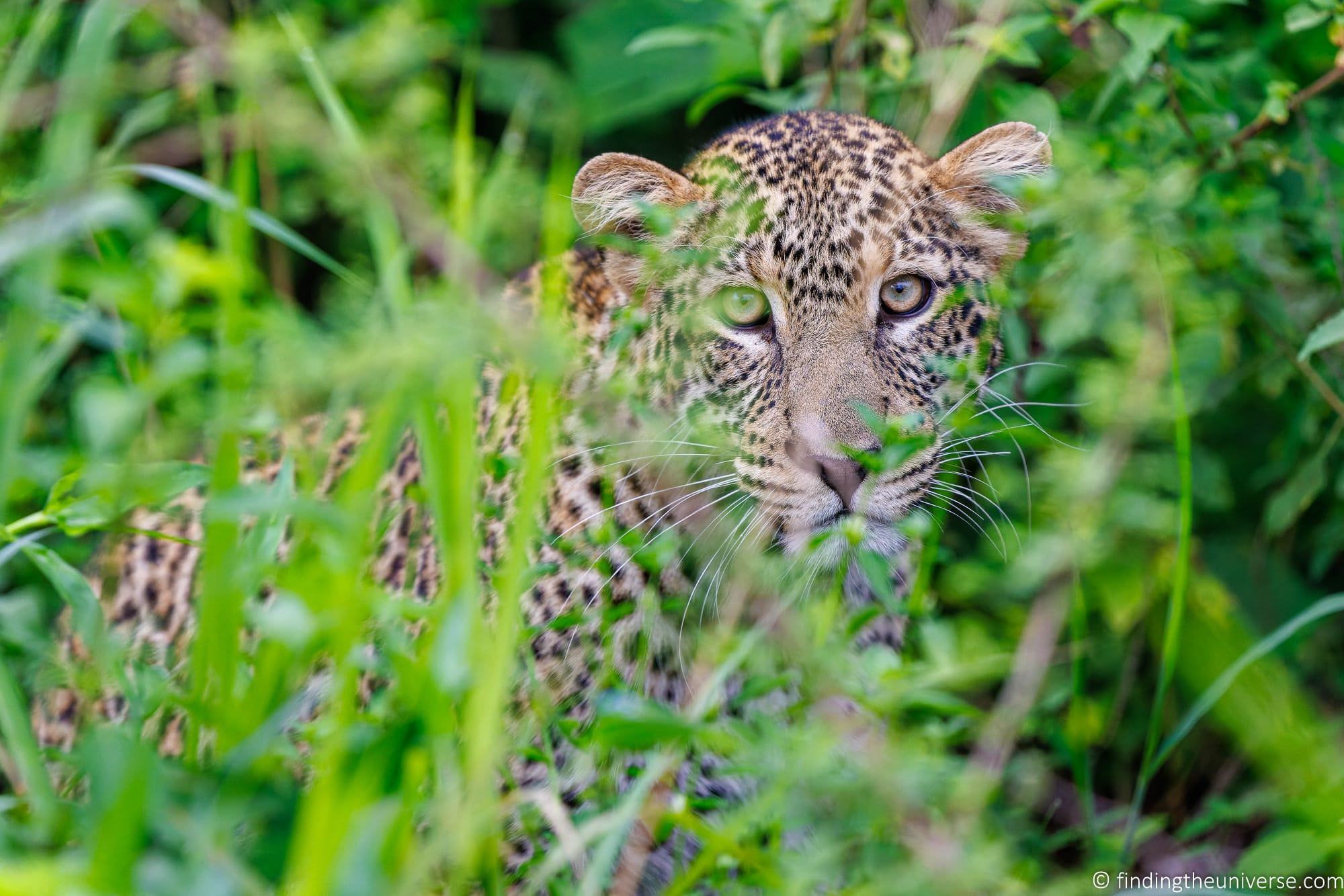
Enjoy Yourself!
This might seem a bit counter intuitive in a guide to getting great photos on safari, but it’s important to remember. When on safari, it can be easy to become caught up in the need to capture every moment with our cameras, and not to miss a shot.
Whilst of course I want you to get those amazing shots, don’t forget that you came on safari also to witness wildlife in its natural habitat. So don’t forget to just step back from the camera every now and again and just take it all in. A safari is an incredible experience and you definitely want to try and enjoy it rather than being stressed over getting every shot on your memory card.
On our recent trip, Jess generally only took photos when animals came close, otherwise, she was content just watching them, either with a pair of binoculars (I definitely recommend packing a good pair of binoculars) or her naked eyes. She said she got much more enjoyment just watching them than when she was trying hard to get a good photo as she had in prior trips.
We highly recommend just sitting back and letting some moments go by unrecorded. I find you can often learn a lot more about animals if you just sit and watch them sometimes. Not every moment needs to be photographed!
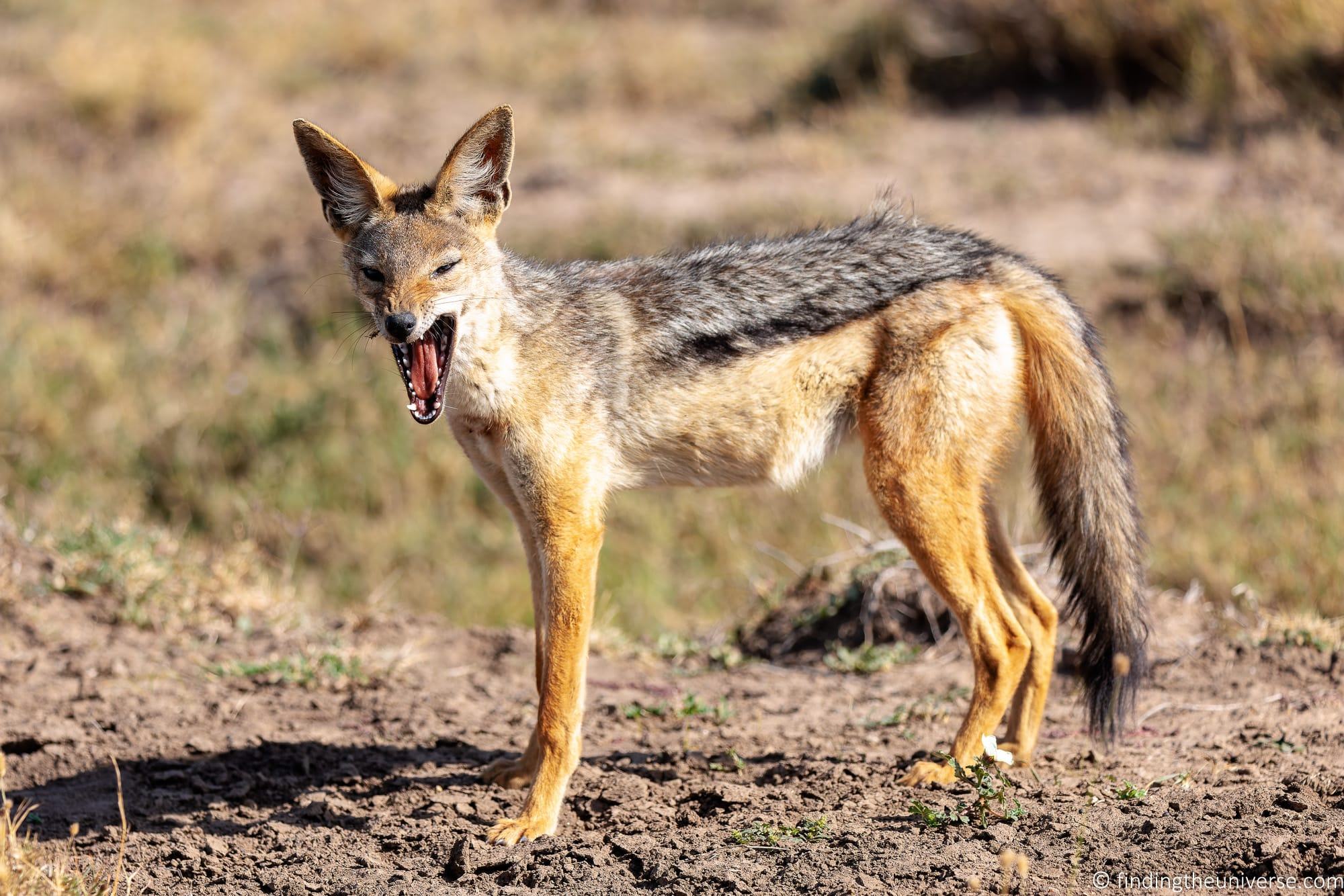
Further Reading
That’s it for my guide to getting better photos on safari! If you found this useful, you might enjoy some of my other photography content. Here are some articles to get you started.
- We have a guide to the best safari camera , to help you choose the right gear for you and your budget. We also have a guide to photography bean bags for safari you might consider checking out.
- We have a detailed overview of gorilla trekking in Uganda as well as chimpanzee trekking in Uganda , both of which are an incredible experience
- We have a detailed guide to what to pack for safari , to help ensure you bring the right gear for your trip
- I have a guide to my favourite photo editing applications , as well as the best alternatives to Lightroom
- Wildlife photography can often result in noisy images. See my guide to the best noise reduction software for some ideas on how to get the best out of your photos even when they might be a bit noisy
- We have a guide to how to use a compact camera , how to use a DSLR camera , and how to use a mirrorless camera . We also have a guide to how a DSLR works
- Knowing how to compose a great photo is a key photography skill. See our guide to composition in photography for lots of tips on this subject
- We have a guide to what depth of field is and when you would want to use it.
- We are big fans of getting the most out of your digital photo files, and do to that you will need to shoot in RAW. See our guide to RAW in photography to understand what RAW is, and why you should switch to RAW as soon as you can if your camera supports it.
- You’re going to need something to run your photo editing software on. See our guide to the best laptops for photo editing for some tips on what to look for.
- If you’re looking for more advice on specific tips for different scenarios, we also have you covered. See our guide to Northern Lights photography , long exposure photography , fireworks photography , tips for taking photos of stars , and cold weather photography .
- Color accuracy is important for photography – see our guide to monitor calibration to ensure your screen is set up correctly.
- If you’re looking for a great gift for a photography loving friend or family member (or yourself!), take a look at our photography gift guide ,
- If you’re in the market for a new camera, we have a detailed guide to the best travel cameras , as well as specific guides for the best cameras for hiking and backpacking , the best compact camera , best bridge camera , best mirrorless camera and best DSLR camera . We also have a guide to the best camera lenses .
- If you want a camera or lens, but the prices are a bit high, see our guide to where to buy used cameras and camera gear for some budget savings options.
- We have a guide to why you need a tripod , a guide to choosing a travel tripod , and a round-up of our favourite travel tripods
Looking to Improve Your Photography?
If you found this post helpful, and you want to improve your photography overall, you might want to check out my online travel photography course .
Since launching the course in 2016, I’ve already helped over 2,000 students learn how to take better photos. The course covers pretty much everything you need to know, from the basics of how a camera works, through to composition, light, and photo editing.
It also covers more advanced topics, including astrophotography, long exposure photography, flash photography, and HDR photography.
You get feedback from me as you progress, access to webinars, interviews and videos, as well as exclusive membership of a Facebook group where you can get feedback on your work and take part in regular challenges.
It’s available for an amazing one-off price for lifetime access, and I think you should check it out. Which you can do by clicking here .
And that’s it! I’d love to hear about your thoughts on wildlife photography on safari, and am happy to answer any questions you have. Just pop them in the comments below and I’ll get back to you as soon as I can.
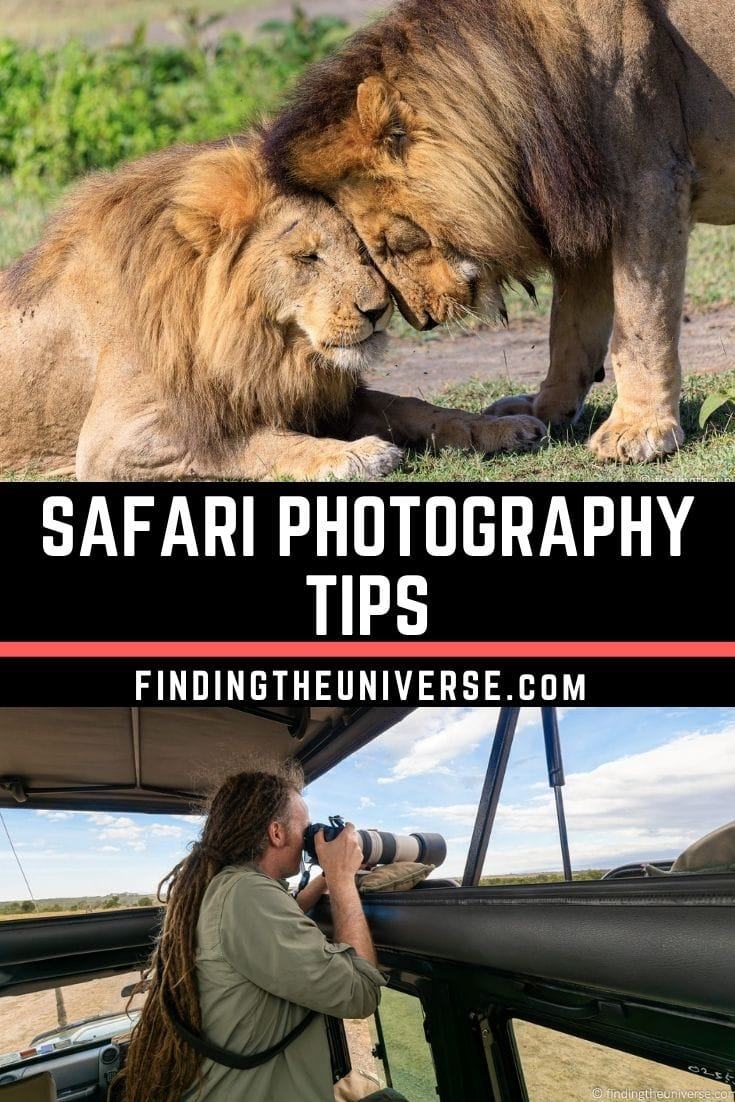
Enjoyed this post? Why not share it!
There are 4 comments on this post
Please scroll to the end to leave a comment
Towab Muhammad Yusuf says
2nd April 2022 at 12:27 pm
Zebras is looking awesome, so natural looking
Laurence Norah says
3rd April 2022 at 10:28 am
Thanks Towab!
D. Hernandez says
26th March 2022 at 1:36 am
Hello Laurence,
Thanks for these wonderful photography tips and advice! I am not much of a photographer but found these tips very useful and will be keeping this page bookmarked to read again before my safari. My wife and I have a 2-week trip planned to South Africa in in the fall and about a week of that will be spent on safari.
I was given a Canon EOS Rebel T7 DSLR camera (used but barely used) last year but without any lenses. So my question for you would be what lens would you recommend I invest in if I was to choose to take just one for this trip? I would also of course want to use it around home and for taking photos of family events and future trips, but the main focus for now is getting some decent wildlife photos on our safari in South Africa. Would like to purchase it soon so can start practicing (as you recommend) now!
Thanks for all your time & help! D
26th March 2022 at 9:42 am
I’m glad you found the post helpful and I am sure you will have an amazing trip! So if you are looking at just one lens then you will want a lens that can go from quite wide to quite zoomed in. A lens like this is known as a walk around lens. I would probably recommend either the Tamron 18-400 f/3.5-6.3 or the Tamron 16-300 f/3.5-6.3 . These would both give you the versatility you would want in terms of range, from wide to zoomed in. The 16-300 gives you a slightly lighter lens that can take slightly wider angle shots, whilst the 18-400 is a bit heavier but you get more reach.
It is worth noting that of course if you zoom in at 100% and peer at the images produced by these lenses they won’t compare to a high-end lens costing thousands of dollars. However I think that for standard size prints and general use they are a good option at a reasonable price point.
Let me know if you need any further input, I’m happy to help. Otherwise, have a fantastic trip!
Leave a Reply Cancel reply
Your email address will not be published. Required fields are marked *
Let me know when there's a reply to my comment (just replies to your comment, no other e-mails, we promise!)
Subscribe to our monthly Newsletter where we share our latest travel news and tips. This also makes you eligible to enter our monthly giveaways!
We only ask for your e-mail so we can verify you are human and if requested notify you of a reply. To do this, we store your data as outlined in our privacy policy . Your e-mail will not be published or used for any other reason other than those outlined above.
- Student Successes
- My Learning
How to Capture Stunning Safari Photography on Your Next Trip
You can also select your interests for free access to our premium training:
If you’re planning a safari trip in the near future, you’ll want to make sure your camera is packed and ready to go. Safari photography can be some of the most rewarding and beautiful photos you’ll ever take, but it takes a little bit of know-how to capture those perfect shots. Here are seven tips to help you get started.
Safari Photography: What to Expect on an African Safari
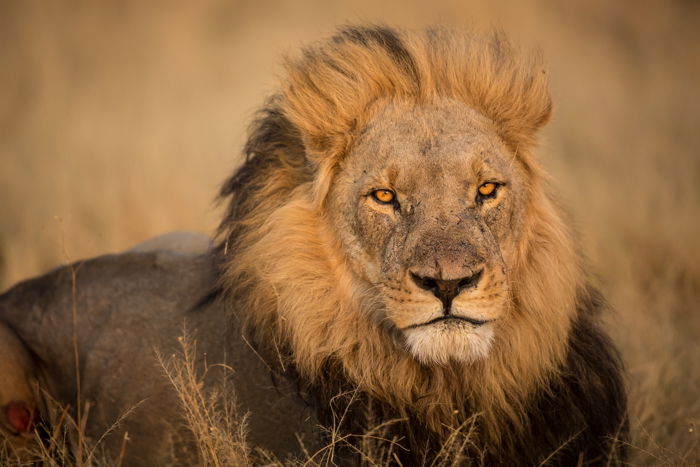
Equipment for Safari Photography
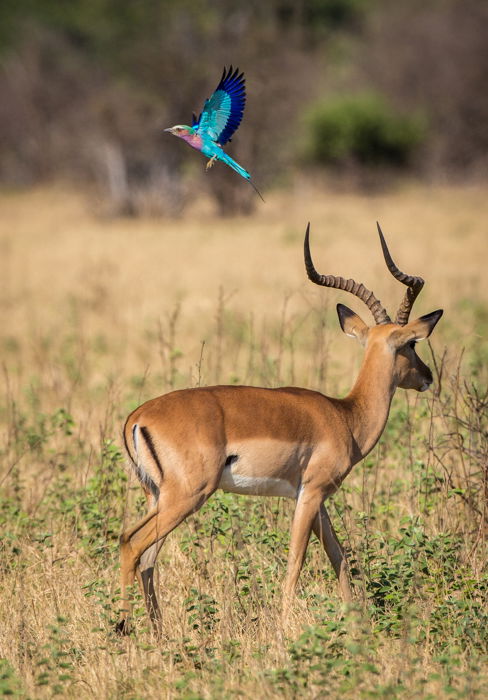
Heat and Light

Seasons and Weather
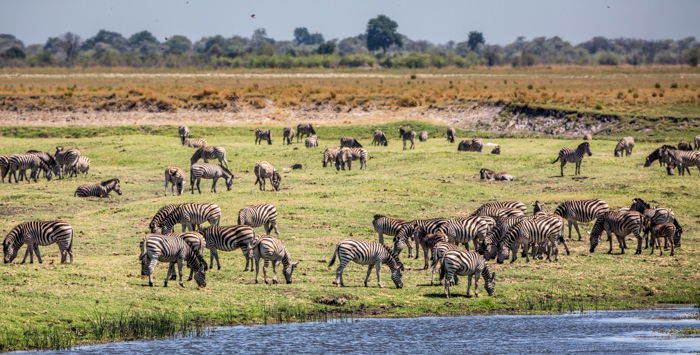
Landscapes and Perspectives
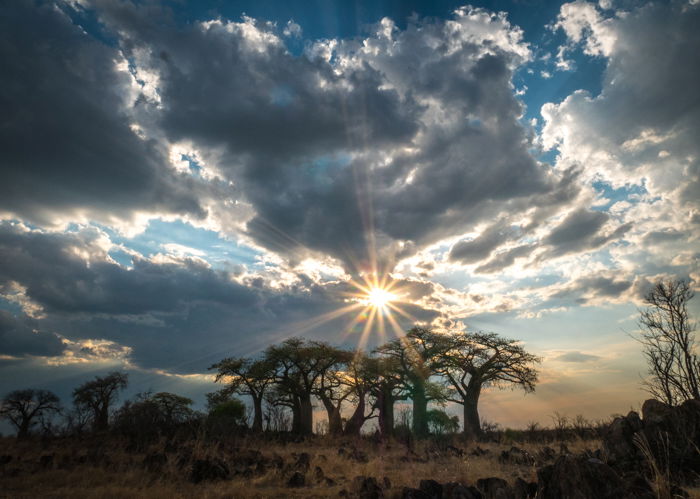
Finding Your Own Composition
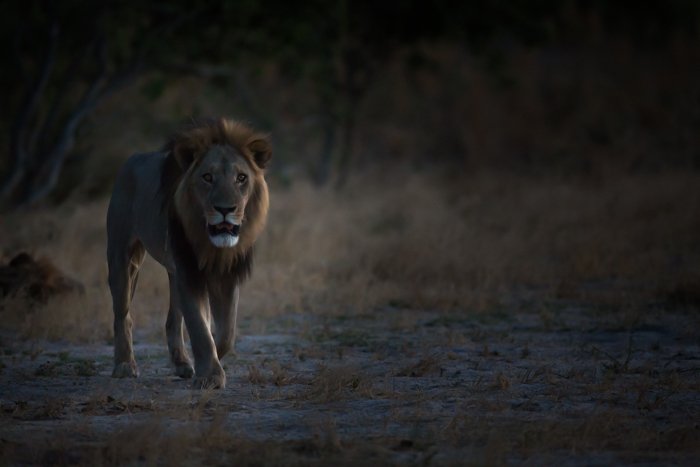
Popular Content
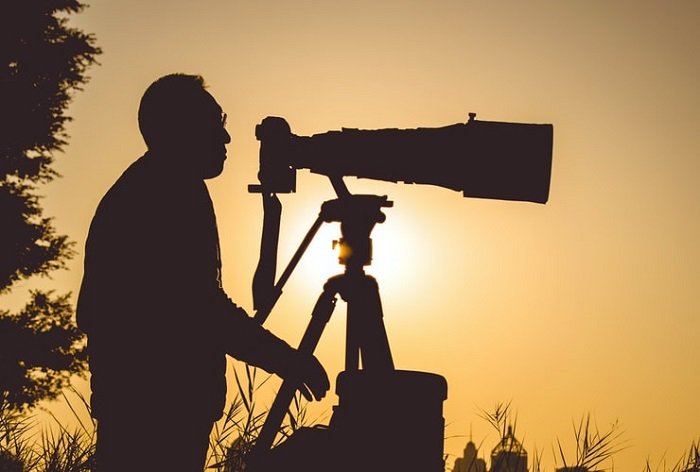
Safari Pets

Location & Hours
Suggest an edit
808 W Main St
Cabot, AR 72023
You Might Also Consider

17.1 miles away from Safari Pets
Total Pet Care At Petco
in Pet Stores, Pet Training, Pet Groomers

17.4 miles away from Safari Pets
Come in for a groom!
in Pet Groomers

Pet Supplies Plus Cabot
0.8 miles away from Safari Pets
Rick J. said "We, Sophie and I, love this store!! Shelton and his crew are the BEST!!! They always make sure that Sophie gets all of her favorite treats!!! Sophie loves PSP Cabot!! Rick and Sophie" read more
in Pet Stores
About the Business
Located at 808 W Main St in Cabot Ar, Safari Pets is the largest independently locally owned pet store in Arkansas. Our company is based upon the belief that our customers' needs are of the utmost importance. We carry a large selection of exotic animals and we offer a variety of products and services for your pet, specializing in small animals, birds, fish, reptiles, dogs and cats. We also offer complete professional grooming services for your dog or cat. We are open Monday through Saturday from 10am to 7pm and our grooming department is open from 8am to 3pm Monday through Saturday. Call us or come by today for all of your pet needs …
Ask the Community
Ask a question
Got a question about Safari Pets ? Ask the Yelp community!
Recommended Reviews
- 1 star rating Not good
- 2 star rating Could’ve been better
- 3 star rating OK
- 4 star rating Good
- 5 star rating Great
Select your rating
Overall rating
When this store opened we just like so many other in searcy we're excited! We couldn't wait to get stuff for our cat! We went in several times the staff was kind and asked if we needed help. It's always seemed clean.. I've seen cleaning carts out so I'm sure they are cleaned.. and I'm sure the staff (can't vouch for all of them) care about the animals. There was one young lady who was very friendly let my daughter pet different animals and she told her about them! Since then I haven't met another staff member that gave such an experience! And I didn't catch her name! But she was great! She even turned to help other customers looking at the animals after we left! We went in to get cat food as usual but this time my daughter saw the turtles.. which do poop every where so watch out (someone was there to clean it as we were there) but it hissed at her.. and the staff said they bite (didn't see any signs about the turtles biting) you'd think since they are free to roam the store there would be a sign warning that they do bite. She was able to pet the turtle but the second time walking past the aisles he/she was on the turkey hissed. This same day 03/02/2023 my daughter went over to the hamsters to look/pet them as she always does! This time she saw one pick it up and cried bc she wanted that one so badly! She was so excited to get a hamster! We bought the cage, bedding, food, etc. She named him Flufffy within 5 mins! Before leaving the cashier said if anything happens within 14 days being him back. I didn't think much of it.. well we got home set up the cage! Let him run in his exercise ball (which broke after a week).. he had water, food, plenty of bedding, an igloo! He was let out to run in his ball while we had it! Or we'd hold him! Exactly 12 days later we got up and around 11/12 my daughter went to his cage picked him up and said he's knocked out asleep.. he was actually dead. Nothing changed.. he ate the night before.. our home is set at 68-70 degrees. We kept him out of direct sunlight. Cleaned his cage as suggested! She held him the night before I saw him standing looking out his cage before we went to bed.. (normally he would bite on his cage.. this time he was not).. Idk if the hamster was sick before after reading the comments but there is no reason he should have passed away after 12 days. My daughter wasn't able to sleep bc this broke her heart that her first pet she picked for herself died.. :/ I haven't spoke to the store yet since he passed on Sunday! But today (Monday) I will be contacting the store to see what they say. I will update! Some of the stuff they sell you can find cheaper at the fish bowl (a local pet store down the road- we found a cat tent double the price at safari pets). Definitely check fish bowl out before coming here!
This store was heaven for me at first. I admired it so much and loved that they were a local business. Then I got to know the owners and the manager. They have zero respect for their employees. They care about themselves and their image over the wellbeing of their animals and employees. Awful
Wish i could give no star, they had a half decomposed fish in one of their tanks and when i told a worker they didn't care. There's always fish that are way too big for their tanks and one worker in particular is always rude and there's another one that manhandles the animals. Do better for the animals that are unfortunate enough to land there.

8 weeks ago paid $20.00 for our 10 & 12 lb fur babies nails trimmed. Today charged $30.00 and groomer needed me to hold the pups. Priced yourself out of a customer.
I have visited this place once and it was very hectic. They tried their best to help me but it took almost 20 mins. I have read so many other reviews and I can't say I'd recommend this place for anyone to visit. Take better care of your animals, employees and more importantly the customers that keep your business alive.
I called the store and asked about a product and told them I would be in to pick it up. When I got there I had to go and try to find it myself. Lots of times they are too busy to take care of customers properly. I have been in there a few times and that seems to be the case most of the time. Getting dogs nails clipped too expensive took my dog some place else. I only go there when I have too.

Purchased 5 fish from here. Told them it was for my new aquarium. Next day three of the five fish were dead. The other two don't look to well either. Called to see if they do water test and they said yes. Brought in two sample viles. After the test the guy said the readings looked normal. He asked, who I assume to be the manager what they should do. She said I didn't have enough water to do a complete test. I advised her that the same exact tank I got the fish from in the store, now have over 5 dead fish floating at the bottom! The same species I just purchased too! I was told that species is fragile and they do that all the time! She then said I needed to bring in the 3 dead fish and a receipt to get compensation! First of all my son was super upset and we buried them. Second I was just in the store the day before! Like I'm trying to cheat them out of $2 a fish to equal $6. That's just bad business and a crappy way to deal with it. I won't be returning. They could have let me know how much water to bring and just gave me new fish or anything but they did nothing. I don't want dirty water, sickly fish anyhow. If you do wanna buy here keep receipts for everything bc they won't trust you later.
I have previously worked here, about a year ago, and was used to them not caring that maggots where in pig cages, they wouldn't care about mold behind the fish tanks, they didn't care that they didn't have a breeders license and would breed rabbits, Guinea pigs, mice, rats, and crickets. Half of the time, the newborn pigs would be stored right next to pigs WITH RINGWORM. They wouldn't clean the cages out in the back store room, until they had maggots. Honestly, when Jason left safari pets, this place went even more downhill. Another thing I remember was them having a " lost " ball python for about 3 months running around the store. Middle of my shift one day, the python paid a visit to me in the middle of the fish department. They did not search for the missing snake. They had a loose snake in the store around children, and adults for MONTHS. I would never work here again, or buy any pets from this location! Also, WILDA IS THE WORST. She would harass employees, she would make another very far into pregnancy coworker clean the maggots and kitty litter, and honestly, she is the reason I quit. She and the owners are horrible people who do not care about anything besides money. They don't care about animals, or employees. They ban anyone who calls them out for the unsanitary mess that is this store. I don't care if I've been banned, I won't ever step in this store again, and I hope nobody ends up getting sick from one of the animals from this " pet shop " .

This is a great palce to take care of all your pets! The staff are all friendly and willing to help and can get you the answer you need. My family has been coming to this store for over 6 years and will keep coming back. Thanks

Good place for pet products and items. I always get my crickets for my bearded dragon there. Only thing is this new cricket counter. It's inaccurate by at least a dozen. But other than that 100% happy customer.
8 other reviews that are not currently recommended
People Also Viewed

Neighborhood Pet Shoppe

Chenal Valley Animal Hospital

Fairview Kennels

Grooming Tails

Chenal Pet Palace

Pretty Paws Grooming

Craig Boyd, DVM - Boyd Veterinary Clinic

Hounds Lounge Pet Resort and Spa

Doggie Do’s
Browse Nearby
Things to Do
Restaurants
Hardware Stores
Other Places Nearby
Find more Pet Groomers near Safari Pets
Find more Pet Stores near Safari Pets
People found Safari Pets by searching for…
Pet Stores Cabot
Related Cost Guides
Local Fish Stores
Pet Adoption
Pet Boarding
Pet Breeders
Pet Hospice
Pet Sitting
Pet Training
Animal Physical Therapy
Aquarium Services
Emergency Pet Hospital
Horse Boarding
Pet Groomers
Pet Photography
Veterinarians
- 12 More Cost Guides
Safari Cat: Breed Profile, Characteristics, and Care Guide
Temporary BuzzPetz About Us
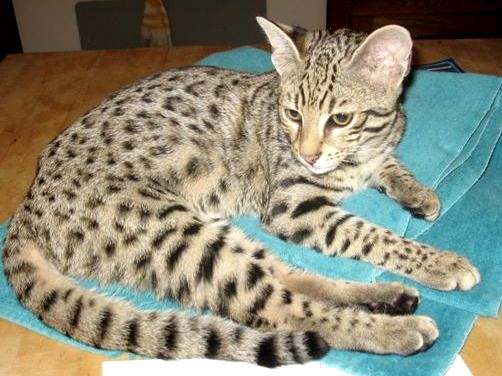
Meet the Safari cat, a hybrid between a domestic cat and a wild feline, Geoffroy’s cat. One of the rarest cat breeds in the world! This rare and exotic breed is not for the faint of heart but for those who are looking for a unique and adventurous companion.
Breed Overview
History of the safari cat.
The Safari cat was developed by Washington State University in the United States in the 1970s, before the Bengal cat . The original purpose of creating this hybrid was to study leukemia in cats, as Geoffroy’s cats are resistant to the disease. Eventually, the university shut down the study due to difficulties with breeding, leaving feline leukemia without a new treatment. However, some breeders and enthusiasts saw the potential of this cross as a new and exciting pet. Unfortunately, only an estimated 70 Safari cats exist today, making them one of the rarest breeds in the world .
I enjoy the cats so much. They’ve got their own personalities. They’re more individual than a lot of animals are. They’re all independent, and each is completely different than the one next to it Chuck Schramm ~ wsu veterinary grad student
Why are Safari cats so rare? Well, breeding them is not an easy task. Geoffroy’s cats have 36 chromosomes, while domestic cats have 38. This means that the offspring have 37 chromosomes, which results in a phenomenon called “hybrid vigor.” This means that the first-generation (F1) Safari cats are much larger than their parents, weighing up to 15 kilos. The subsequent generations are smaller, averaging around 11 kilos. Another challenge is that Safari cats have a longer gestation period than domestic cats, which makes it harder to predict when they will give birth.
What Do Safari Cats Look Like
Safari cats are stunning to look at. They have a short-haired coat with a spotted tabby pattern, resembling their wild ancestor. Their eyes are large and expressive, and their ears are pointed and tufted. They have a muscular, athletic body, long legs, and thick tails. Their size varies depending on the generation, but they are generally larger than most domestic cats. There is no official standard for Safari cats yet, nor are they recognized by any cat fancier association, as they are still a very new and experimental breed.
What Kind of Personality Do Safari Cats Have
Safari cats are not your typical lap cats. They are energetic, curious, intelligent, and playful. They love to explore their surroundings and interact with their humans. They are also affectionate and loyal, forming strong bonds with their owners. They can sometimes be mischievous and naughty, but they are also very smart and trainable. They can learn tricks, commands, and even how to walk on a leash.
Safari cats need a lot of stimulation and exercise to keep them happy and healthy. They enjoy interactive and challenging games that test their skills and instincts. Some may even like to swim and climb, so providing them with access to water and heights is a good idea. They also need plenty of toys and scratching posts to keep them entertained.
Caring For a Safari Cat
Safari cats are not low-maintenance pets. They require an enriched environment that meets their physical and mental needs. They need spacious, secure indoor spaces to run, jump, and play. They also need observation posts where they can watch the world from above. They benefit from food puzzles that make them work for their meals and stimulate their natural hunting behavior.
Safari cats may tolerate some solitude if their needs are met, but they prefer to have company and attention from their humans. They may be more vocal than the average cat due to their hybrid nature, so be prepared for some loud meows and chirps. They may also have health issues or special needs requiring regular veterinary check-ups and care.
Where to Buy a Safari Cat
If you are interested in buying a Safari cat, you should start by researching your local laws, as some places may prohibit or restrict the ownership of these hybrid animals. Keep in mind they are not normal domesticated cats!
You should also be prepared to pay a hefty price for a Safari cat kitten. Depending on the kitten’s generation, quality, and rarity, you may expect to pay anywhere from $4,000 to $8,000 or more.
There are a few breeders working with this breed, but they are few and far between. This remains an extremely rare breed; with time, you may see them become more domesticated and popular.
Safari cats are rare and exotic hybrid pets that offer a unique and adventurous experience for those who are looking for something different from the usual domestic cat breeds. They are beautiful, intelligent, playful, and affectionate animals that can make wonderful companions for the right owners. However, they are also challenging and demanding pets requiring time, space, stimulation, and care.
We hope you enjoyed this article about Safari cats and learned something new about this fascinating breed. If you have any questions or comments, feel free to leave them below. We would love to hear from you. And if you own a Safari cat or know someone who does, please share your photos and stories with us! We are always curious to see these amazing animals in action.
Thank you for reading, and have a wonderful day! 😊
More Cat Breeds
If you’re interested in learning about similar hybrid cat breeds, check out:
- California Spangled
How much is a safari cat?
A safari cat is a very rare and expensive breed, costing anywhere from $4,000 to $8,000 or more depending on the generation, quality and rarity of the kitten.
Are safari cats good pets?
Safari cats can be good pets for the right owners who are looking for a unique and adventurous companion. They are beautiful, intelligent, playful and affectionate animals that can make wonderful companions. However, they are also challenging and demanding pets that require a lot of time, space, stimulation and care.
What breeds make a safari cat?
A safari cat is a hybrid between a domestic cat and a wild feline, the Geoffroy’s cat. The Geoffroy’s cat is a small spotted cat native to South America that is resistant to leukemia. The domestic cat can be any breed, but usually a shorthaired one.
- https://archive.seattletimes.com/archive/?date=19901223&slug=1111078
Join our newsletter and stay updated on our latest articles, plus receive occasional tips and tricks straight to your inbox!
Buzzpetz Staff
Leave the first comment (cancel reply).
You must be logged in to post a comment.
More From BuzzPetz

Kenyan Sand Boa – Species Profile & Care Guide
Can dogs eat cheetos risk vs. reward.

Humane Society Worker Fired After Husband Breaks Dog’s Skull – Authorities Say

“Soccer Match Interupts Doggy Playtime” – According to One Good Boy
Can cats see colors, or are they color blind.

The 9 Best Cat Water Fountains of 2024
Already a member?
Not a member?
Register Here
- AI Generator
safari animal illustrations
Safari animal pattern, safari animal silhouette, safari animal collage, safari animal icon, safari animal icons, safari animal print, 122,847 safari animal stock photos & high-res pictures.
Browse 122,847 authentic safari animal stock photos, high-res images, and pictures, or explore additional safari animal illustrations or safari animal pattern stock images to find the right photo at the right size and resolution for your project.
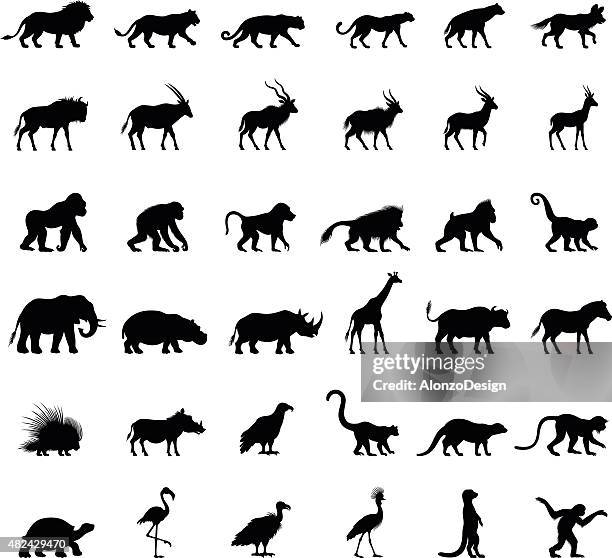
iOS 18 makes iPhone more personal, capable, and intelligent than ever
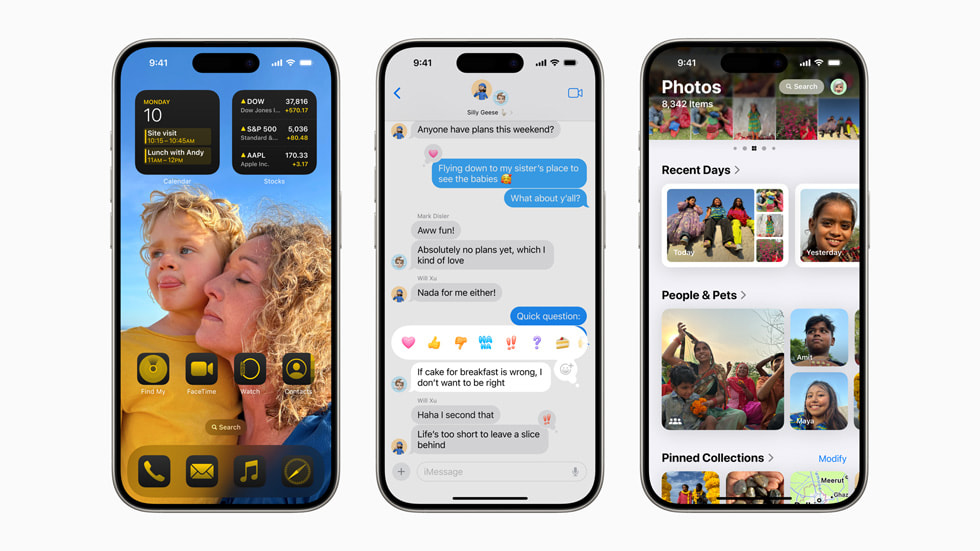
New Levels of Customization and Capability
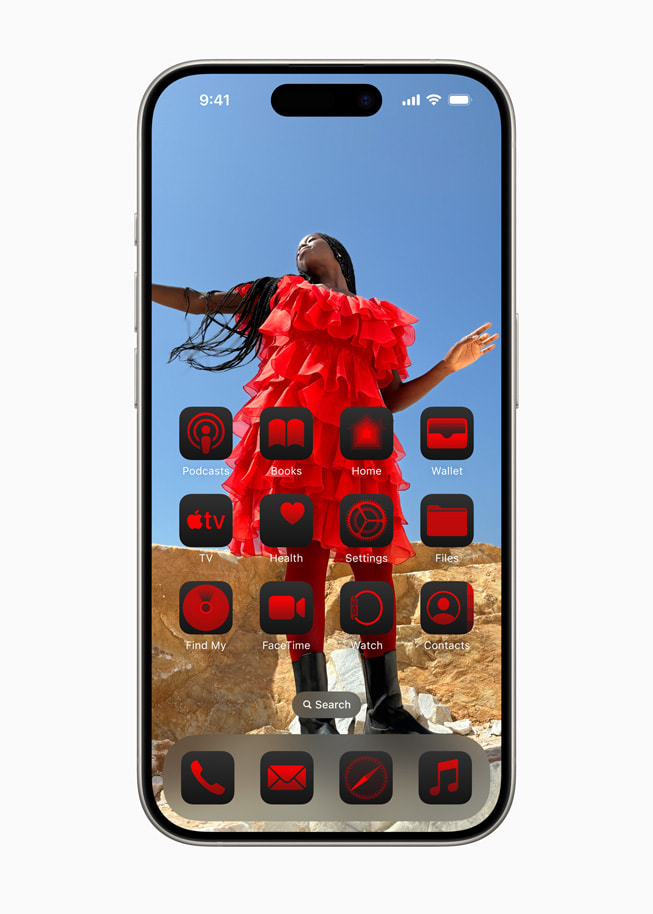
Photos Gets a Unified View, New Collections, and Customization
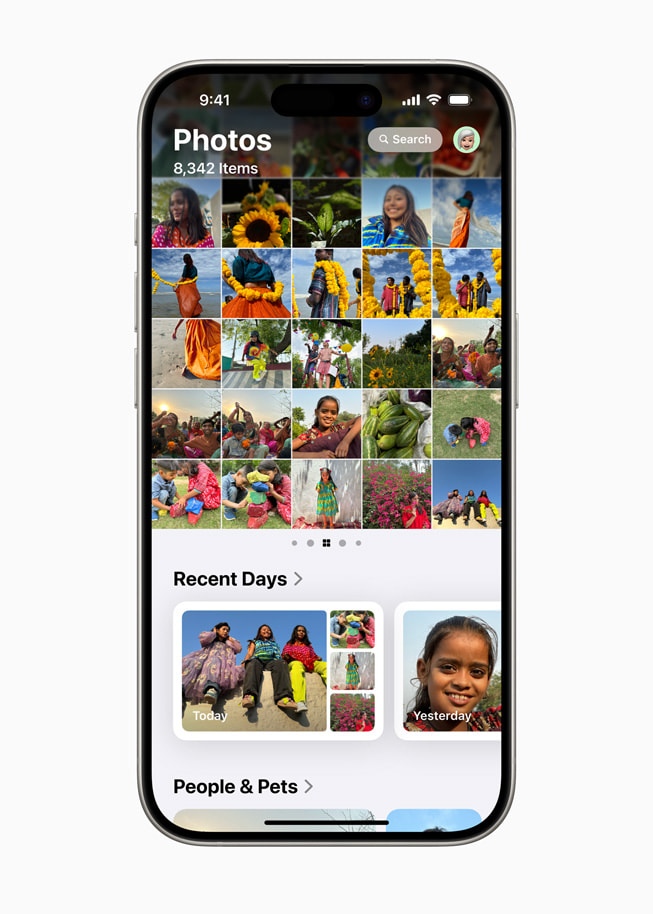
Powerful Ways to Stay Connected in Messages
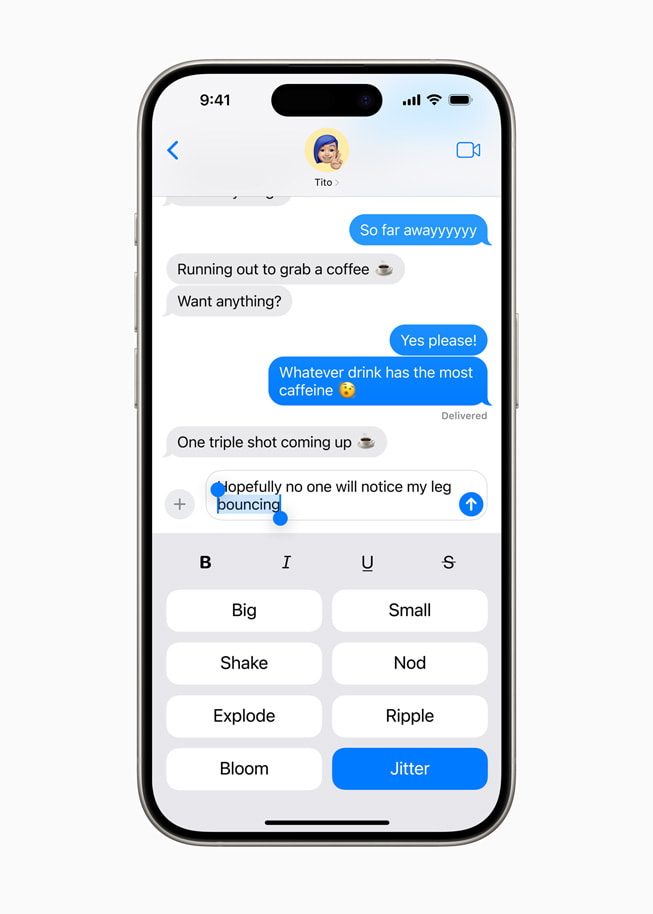
Enhancements to Mail

Big Updates to Safari
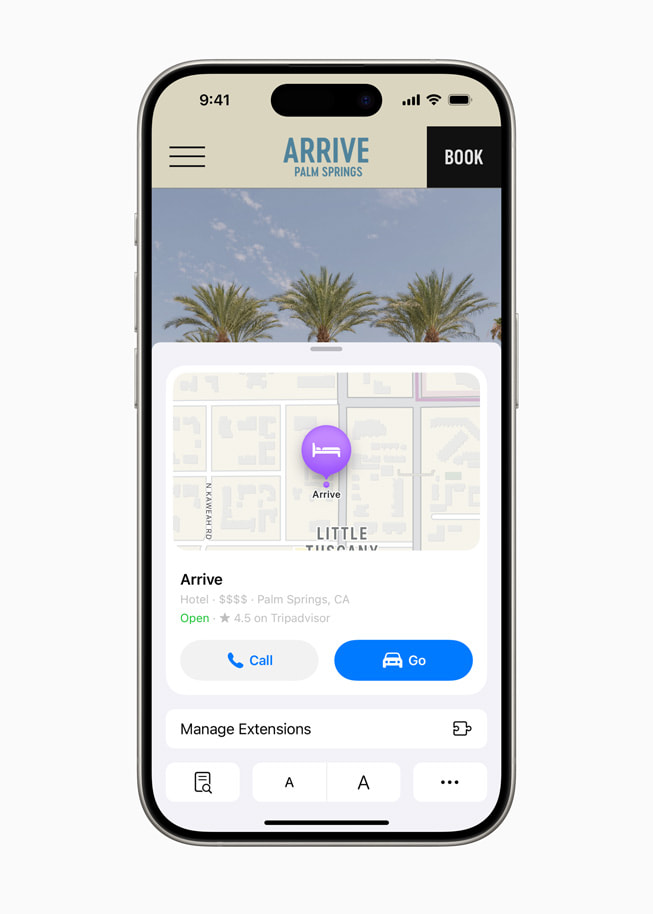
Introducing the Passwords App

New Privacy Features Designed to Empower Users
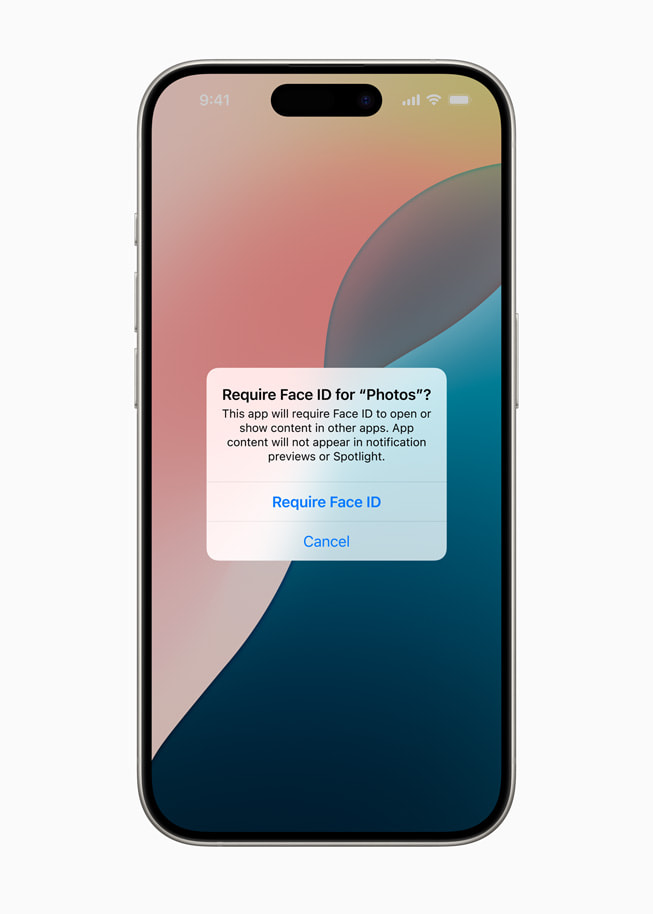
Apple Intelligence Transforms the iPhone Experience
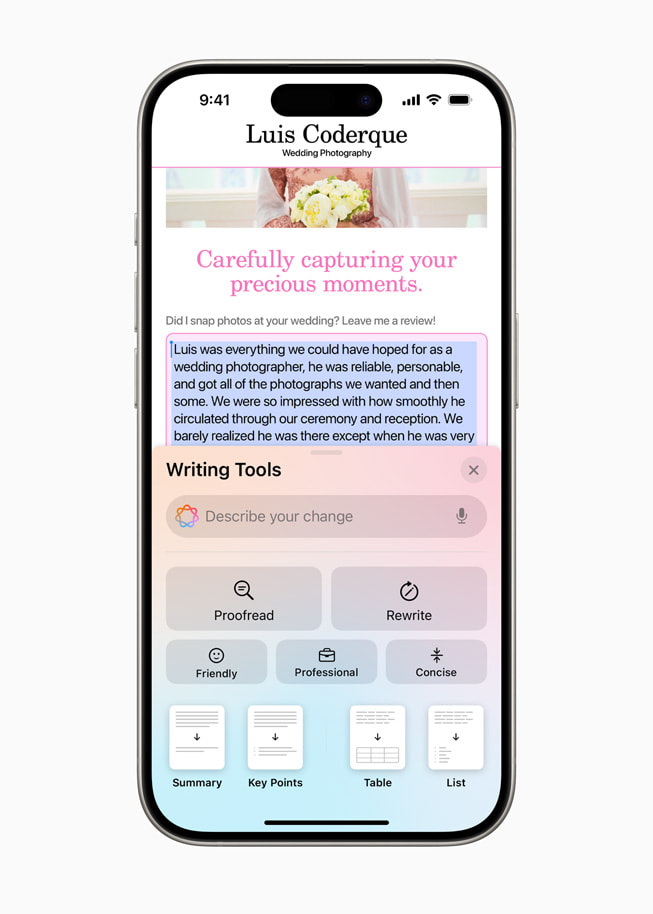
- In Apple Maps , users can browse thousands of hikes across national parks in the United States and easily create their own custom walking routes, which they can access offline. Maps users can also save their favourite national park hikes, custom walking routes, and locations to an all-new Places Library and add personal notes about each spot.
- Game Mode enhances the gaming experience with more consistent frame rates, especially during long play sessions, and makes wireless accessories like AirPods and game controllers incredibly responsive.
- Users get new ways to pay with Apple Pay , including the ability to redeem rewards and access instalments from their eligible credit or debit cards. 5 With Tap to Cash, users can send and receive Apple Cash by simply holding two iPhone devices together. 6 Tickets in Apple Wallet bring a richer experience for fans, putting key event information like stadium details, recommended Apple Music playlists, and more at their fingertips. 7
- SharePlay with Apple Music allows even more users to share control of music playing from HomePod, Apple TV, or any Bluetooth-enabled speaker, making listening together more fun and engaging.
- The AirPods experience gets even more personal, private, and convenient with Siri Interactions, allowing AirPods Pro (2nd generation) users to simply nod their head yes or gently shake their head no to respond to Siri announcements. For even clearer call quality, Voice Isolation comes to AirPods Pro, ensuring the caller’s voice is heard in loud or windy environments. AirPods updates also provide the best wireless audio latency Apple has ever delivered for mobile gaming, and add Personalized Spatial Audio for even more immersive gameplay.
- In the Notes app , formulas and equations entered while typing are solved instantly with Math Notes. New collapsible sections and highlighting make it easier to emphasize what’s important.
- In Journal , an all-new insights view helps users keep track of their journaling goals, and the ability to search and sort entries makes it easy to enjoy past memories. Time spent journaling can be saved as mindful minutes in the Health app, and users can log their state of mind right in Journal. A Journal widget is now available for users to quickly start an entry from the Home Screen or Lock Screen, audio recordings are automatically transcribed, and users can export and print journal entries.
- Calendar becomes even more helpful by showing both events and tasks from Reminders . Users can create, edit, and complete reminders right from Calendar, and the updated month view provides an overview of events and tasks at a glance.
- In the Health app , Medical ID has been redesigned to make it even easier for first responders to find the most important information in an emergency. The Health app can help users better understand their data during pregnancy by making adjustments and recommendations to reflect changes in their physical and mental health.
- Emergency SOS Live Video allows users to share context through streaming video and recorded media. In the middle of an emergency call, participating emergency dispatchers can send a request for a user to share live video or media from the user’s camera roll over a secure connection, making it easier and faster to get help.
- The Home app introduces guest access, providing users with easy ways to grant guests control of select smart home accessories, set schedules for when guests can access the home, and more. For an effortless home entry experience, hands-free unlock with home keys leverages Ultra Wideband technology to allow users to instantly open supported entry locks as soon as they are six feet away from their door. With convenient updates to the Energy category, the Home app makes it easier for eligible users to access, understand, and make more informed decisions about their home electricity use.
- Accessibility updates include Eye Tracking, a built-in option for navigating iPhone with just eyes; Music Haptics, a new way for users who are deaf or hard of hearing to experience music using the Taptic Engine in iPhone; and Vocal Shortcuts that enable users to perform tasks by making a custom sound.
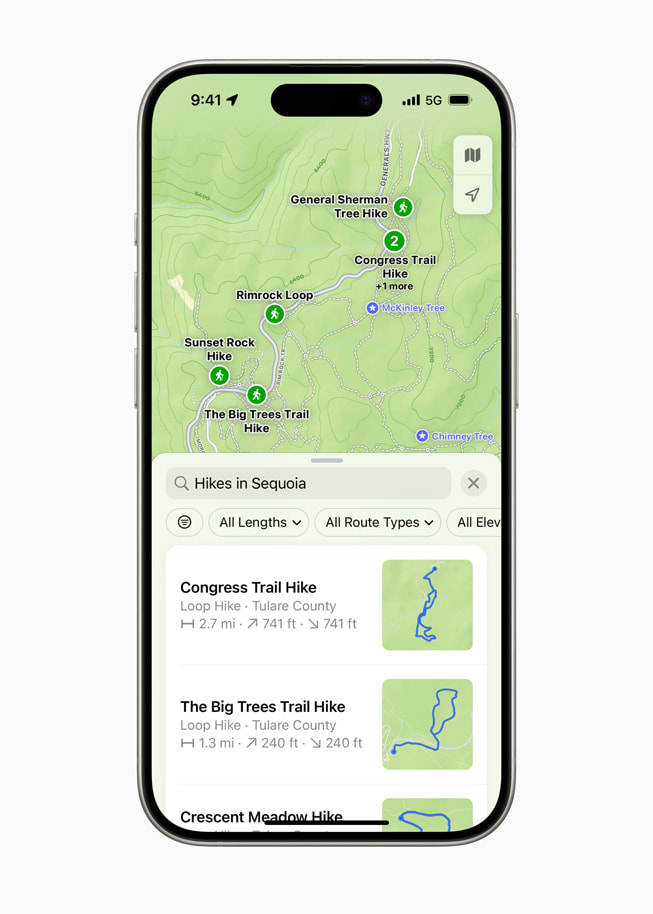
Text of this article
June 10, 2024
PRESS RELEASE
The release introduces all-new customization options, the biggest-ever redesign of Photos, powerful updates for staying connected, and Apple Intelligence, the personal intelligence system
TORONTO, ONTARIO Apple today previewed iOS 18 , a major release that features more customization options, the biggest redesign ever of the Photos app, new ways for users to manage their inbox in Mail, Messages over satellite, and so much more. Users will be able to arrange apps and widgets in any open space on the Home Screen, customize the buttons at the bottom of the Lock Screen, and quickly access more controls in Control Center. Photo libraries are automatically organized in a new single view in Photos, and helpful new collections keep favourites easily accessible. Mail simplifies the inbox by sorting email into categories using on-device intelligence, and all-new text effects come to iMessage. Powered by the same groundbreaking technology as existing iPhone satellite capabilities, users can now communicate over satellite in the Messages app when a cellular or Wi-Fi connection isn’t available. 1
iOS 18 also introduces Apple Intelligence , the personal intelligence system for iPhone, iPad, and Mac that combines the power of generative models with personal context to deliver intelligence that’s incredibly useful and relevant. 2 Built with privacy from the ground up, Apple Intelligence is deeply integrated into iOS 18, iPadOS 18, and macOS Sequoia. It harnesses the power of Apple silicon to understand and create language and images, take action across apps, and draw from personal context, to simplify and accelerate everyday tasks.
“We are thrilled to introduce iOS 18. It is a huge release with incredible features, including new levels of customization and capability, a redesigned Photos app, and powerful ways to stay connected with Messages. There are so many benefits for everyone,” said Craig Federighi, Apple’s senior vice president of Software Engineering. “This release also marks the beginning of a tremendously exciting new era of personal intelligence with Apple Intelligence delivering intuitive, powerful, and instantly useful experiences that will transform the iPhone experience, all with privacy at the core. We can’t wait for users to experience it.”
iPhone users have new ways to customize the Home Screen, Lock Screen, and Control Center. Users can now arrange apps and widgets in any open space on the Home Screen, including placing them right above the dock for easy access or perfectly framing a wallpaper. App icons and widgets can take on a new look with a dark or tinted effect, and users can make them appear larger to create the experience that is perfect for them.
Control Center has been redesigned to provide easier access to many of the things users do every day, and it gets new levels of customization and flexibility. The redesign delivers quick access to new groups of a user’s most-utilized controls, such as media playback, Home controls, and connectivity, as well as the ability to easily swipe between each. Users can now add controls from supported third-party apps into Control Center to quickly unlock a vehicle or jump right into capturing content for social media — all from one place. The new controls gallery displays the full set of available options, and users can customize how the controls are laid out, including adjusting them to the ideal size and creating entirely new groups.
For first time, users can now switch the controls at the bottom of the Lock Screen, including choosing from the options available in the controls gallery or removing them entirely. With the Action button available on iPhone 15 Pro and iPhone 15 Pro Max, users can quickly invoke controls available in the gallery.
Photos receives its biggest-ever redesign to help users easily find and relive special moments. A simplified, single view displays a familiar grid, and new collections help users browse by themes without having to organize content into albums. Plus, collections can be pinned to keep favourites easily accessible. A new customizable carousel view presents highlights that update each day and feature favourite people, pets, places, and more. Autoplaying content throughout the app brings libraries to life, so past moments can be enjoyed while browsing. Because each user’s photo library is unique, the app is customizable, so users can organize collections, pin collections to access frequently, and include what’s most important to them in the carousel view.
iMessage receives all-new text effects that bring conversations to life by amplifying any letter, word, phrase, or emoji with dynamic, animated appearances. Users can better express tone by adding formatting like bold, underline, italics, and strikethrough. Tapbacks expand to include any emoji or sticker, and now users can compose a message and schedule to send it at a later time.
When messaging contacts who do not have an Apple device, the Messages app now supports RCS for richer media and more reliable group messaging compared to SMS and MMS.
iOS 18 introduces Messages via satellite for the times when cellular and Wi-Fi connections aren’t available. Powered by the same groundbreaking technology as existing iPhone satellite capabilities, Messages via satellite automatically prompts users to connect to their nearest satellite right from the Messages app to send and receive texts, emoji, and Tapbacks over iMessage and SMS. 3 With Dynamic Island, users always know when they are connected to a satellite. Because iMessage was built to protect user privacy, iMessages sent via satellite are end-to-end encrypted.
Later this year, Mail will introduce new ways for users to manage their inbox and stay up to date. On-device categorization organizes and sorts incoming email into Primary for personal and time-sensitive emails, Transactions for confirmations and receipts, Updates for news and social notifications, and Promotions for marketing emails and coupons. Mail also features a new digest view that pulls together all of the relevant emails from a business, allowing users to quickly scan for what’s important in the moment.
Safari, the world’s fastest browser, 4 now offers an even easier way to discover information on the web with Highlights and a redesigned Reader experience. Using machine learning, Safari can surface key information about a webpage. For example, users can review a summary to get the gist of an article; quickly see the location of a restaurant, hotel, or landmark; or listen to an artist’s track right from an article about the song or album. Reader has been redesigned to offer even more ways to enjoy articles without distraction, with a summary and table of contents included for longer articles.
Building on the foundation of Keychain, which was first introduced more than 25 years ago, the new Passwords app makes it easy for users to access their passwords, passkeys, Wi-Fi passwords, and verification codes. The app also includes alerts for users regarding common weaknesses, such as passwords that are easily guessed or used multiple times and those that appear in known data leaks.
iOS 18 gives users even more control with tools to manage who can see their apps, how contacts are shared, and how their iPhone connects to accessories.
Locked and hidden apps offer users peace of mind that information they want to keep private, such as app notifications and content, will not inadvertently be seen by others. Users can now lock an app; and for additional privacy, they can hide an app, moving it to a locked, hidden apps folder. When an app is locked or hidden, content like messages or emails inside the app are hidden from search, notifications, and other places across the system.
iOS 18 puts users in control by letting them choose to share only specific contacts with an app. In addition, developers now have a way to seamlessly connect third-party accessories with iPhone without letting an app see all the other devices on a user’s network, keeping a user’s devices private and making pairing seamless.
Deeply integrated into iOS 18 and built with privacy from the ground up, Apple Intelligence unlocks new ways for users to enhance their writing and communicate more effectively. With brand-new systemwide Writing Tools built into iOS 18, users can rewrite, proofread, and summarize text nearly everywhere they write, including Mail, Notes, Pages, and third-party apps.
New image capabilities make communication and self-expression even more fun. With Image Playground, users can create playful images in seconds, choosing from three styles: Animation, Illustration, or Sketch. Image Playground is easy to use, built right into apps like Messages, and also available in a dedicated app.
Memories in Photos lets users create the stories they want to see just by typing a description. Apple Intelligence will pick out the best photos and videos based on the description, craft a storyline with chapters based on themes identified from the photos, and arrange them into a movie with its own narrative arc. In addition, a new Clean Up tool can identify and remove distracting objects in the background of a photo — without accidentally altering the subject.
With the power of Apple Intelligence, Siri takes a major step forward, becoming even more natural, contextually relevant, and personal. Users can type to Siri, and switch between text and voice to communicate with Siri in whatever way feels right for the moment.
With Private Cloud Compute, Apple sets a new standard for privacy in AI, with the ability to flex and scale computational capacity between on-device processing, and larger, server-based models that run on dedicated Apple silicon servers. When requests are routed to Private Cloud Compute, data is not stored or made accessible to Apple and is only used to fulfill the user’s requests, and independent experts can verify this privacy.
Additionally, access to ChatGPT is integrated into Siri and systemwide Writing Tools across Apple’s platforms, allowing users to access its expertise — as well as its image- and document-understanding capabilities — without needing to jump between tools.
Additional features in iOS 18 include:
Availability
The developer beta of iOS 18 is available through the Apple Developer Program at developer.apple.com starting today, and a public beta will be available through the Apple Beta Software Program next month at beta.apple.com . iOS 18 will be available this fall as a free software update for iPhone Xs and later. Apple Intelligence will be available in beta on iPhone 15 Pro, iPhone 15 Pro Max, and iPad and Mac with M1 and later, with Siri and device language set to U.S. English, as part of iOS 18, iPadOS 18, and macOS Sequoia this fall. For more information, visit apple.com/ios/ios-18-preview and apple.com/apple-intelligence . Features are subject to change. Some features are not available in all regions, all languages, or on all devices. For more information about availability, visit apple.com .
- Messages via satellite will be available in iOS 18 along with Apple’s existing satellite features in the U.S. on iPhone 14 and later.
- Users with an eligible iPhone, iPad, or Mac, and Siri and device language set to English (U.S.) can sign up this fall to access the Apple Intelligence beta.
- SMS availability will depend on carrier. Carrier fees may apply. Users should check with their carrier for details.
- Testing was conducted by Apple in May 2023. See apple.com/ca/safari for more information.
- The new Apple Pay features are available on cards from participating banks and card providers in certain markets. Subject to eligibility and approval.
- Apple Cash services are provided by Green Dot Bank, Member FDIC, and only available in the U.S. on eligible devices. Learn more about the terms and conditions . To send and receive money with an Apple Cash account, users must be 18 and a U.S. resident, or if under 18, part of an Apple Cash Family account. Tap to Cash transaction limits are subject to change, including lowering limits, at any time during the developer or public betas without notice.
- Ticket enhancements in Apple Wallet are available for events from participating ticket issuers.
Press Contacts
Cortney Hughes
(647) 943-4562
Josh Zeliger
joshua s [email protected]
(647) 537-7244
Images in this article

IMAGES
VIDEO
COMMENTS
1 - LION. Enjoying the enviable position at the top of the food chain with no predators, the lion rules the wide-open African plains. The largest and grandest of all cats, Lions live in small prides led by a single male. Without fear of other animals and no need to hide, they are the easiest cat to see on a game drive.
People and their pets are at the heart of everything we do. Visit Neighborhood Pet Shoppe today! Skip to content. See what's happening here at Neighborhood Pet Shoppe! ... Find Your Nearest Neighborhood Pet Shoppe or Safari Pets! Conway. 805 Harkrider Street, Conway, AR, 72032 (501) 450-6531; Visit Location. Searcy. 1540 E Race Ave, Searcy, AR ...
1/ African lion. The African Lion is the King of Beasts, the number one, Africa's top carnivore, and right at the top of most people's wishlists of animals on safari. These iconic predators are the second largest big cats in the world after tigers, and the only cats that live in groups, known as prides.
Elephants are a favorite of all safari-goers and can be found on just about any safari. However, if you're in search of big elephant populations, your best bet would be Botswana. Okavango Delta (Moremi, Chobe, Savuti, Khwai, and Linyanti), Botswana. Chobe National Park, Botswana. Masai Mara National Reserve, Kenya.
Iconic safari animals list. 1. Lion. A pair of lions - the ultimate African safari animals. Leaping in at first place is the lion, also known as the king of the jungle. Lions are the largest and most sociable of Africa's cats. At up to 225 kg, the lion ( Panthera leo) really is the king of all savanna animals (not jungle!).
40 Incredible African Safari Animals with Photos and Tips from Locals Did you know: The animal kingdom in Africa is an amazing place. The continent houses over one million species, including some of the tallest (The girraffe) and heaviest land animals (the Elephant) on earth! There's no telling how many more undiscovered creatures exist ...
Browse 123,027 authentic safari animals stock photos, high-res images, and pictures, or explore additional safari animals realistic or safari animals together stock images to find the right photo at the right size and resolution for your project.
Light and interactions enliven African safari photos. This cheetah and her 12 month old cub camouflaged perfectly. With only 7,500 cheetahs remaining in the wild, they are one of the rarest African safari animals. Not only are their coats gorgeous, but they also allow them to easily camouflage and surprise potential prey. Imagine encountering a ...
African Safari Animals in Photos. Our first time in Africa was in 2008 when we cycled from Cairo to Cape Town. Our trip took us from the north through Sub-Saharan Africa all the way to the southern tip of the Cape of Good Hope in South Africa. We saw a lot of wildlife on that six-month trip alone and since then, we've gone back four times.
Warthogs, commonly called Pumba by many safari guides, are among Africa's highly-watched safari animals. They reside in grasslands, savannas, and woodlands in sub-Saharan Africa, across western, eastern, central, and southern Africa. The Kruger National Park, South Africa, and Meru National Park, central Kenya, are famed for housing the ...
Browse 8,896 cute safari animals photos and images available, or start a new search to explore more photos and images. cheetah family - cute safari animals stock pictures, royalty-free photos & images. Cheetah Family.
29/ Try high key and low key. Playing with your exposure and going for a minimalistic look can add a new dimension to your safari photos. High key photography, emphasising bright whites and light colours, creates a clean feel, and can work well on overcast days when the sky is white.
15. Consider bringing a tripod and/or beanbag. Bringing a tripod and/or beanbag on safari is a crucial photography tip for the following reasons: Stability for Clear Shots: A tripod or beanbag provides stability, reducing camera shake and ensuring clear shots, especially when using longer lenses.
A fly-in safari, like the name suggests, means you're flying to and from your hotel to the areas of interest for tours. This is, as you can imagine, a more luxury style of trip. However, it's also much faster than driving. Guided. A guided safari is the type of safari that most people picture when they imagine going on safari.
For landscape shots, use a wide-angle lens. - If you don't think a tripod is practical, take a bean bag or a window-mounted tripod instead. - Blurred backgrounds can look great, particularly on close-up shots. - For zoom shots, keep the eyes of the creature in focus, which will result in a more engaging photo that embraces the ...
First, the camera's burst speed, which is the number of images per second your camera can take. For instance, a camera with a burst speed of 10fps (frames per second) can take up to 10 photos per second. Second, the speed that your camera can write to the memory card inside the camera as it takes pictures.
Safari Pets, Cabot, Arkansas. 6,516 likes · 68 talking about this · 632 were here. Full line pet store located in Cabot, Arkansas. We specialize in a variety of animals, including bir
These are, in my opinion, far better than the up-close portraits, and derivative shots from the start of the safari. Not every image needs to be a close up portrait. Remember to occasionally give some space to your subject and show them in their habitat. Grab inspiration from the work of others.
Specialties: Located at 808 W Main St in Cabot Ar, Safari Pets is the largest independently locally owned pet store in Arkansas. Our company is based upon the belief that our customers' needs are of the utmost importance. We carry a large selection of exotic animals and we offer a variety of products and services for your pet, specializing in small animals, birds, fish, reptiles, dogs and cats ...
Safari cats are not low-maintenance pets. They require an enriched environment that meets their physical and mental needs. They need spacious, secure indoor spaces to run, jump, and play. ... And if you own a Safari cat or know someone who does, please share your photos and stories with us! We are always curious to see these amazing animals in ...
Browse 122,751 authentic safari animal stock photos, high-res images, and pictures, or explore additional safari animal illustrations or safari animal pattern stock images to find the right photo at the right size and resolution for your project.
Page · Pet Store. 3108 SW 29th St, Topeka, KS 66614-2007, United States, Topeka, KS, United States, Kansas. (785) 273-7387. Rating · 3.7 (10 Reviews)
Safaripetcafe is best place for birthday celebrations. (3) Safari Pet Mart is another big achievement of safarivets where we are making sure to keep every thing regarding pet food and accessories and we are making sure that you find everything you need at safarivets . . . . #pets #cats #dogs #lions #petcare #pethospital #petshop #lahore # ...
iPhone 15 Pro shows photo collections labeled Recent Days and People & Pets in the Photos app. ... Big Updates to Safari. Safari, the world's fastest browser, 4 now offers an even easier way to discover information on the web with Highlights and a redesigned Reader experience. Using machine learning, Safari can surface key information ...